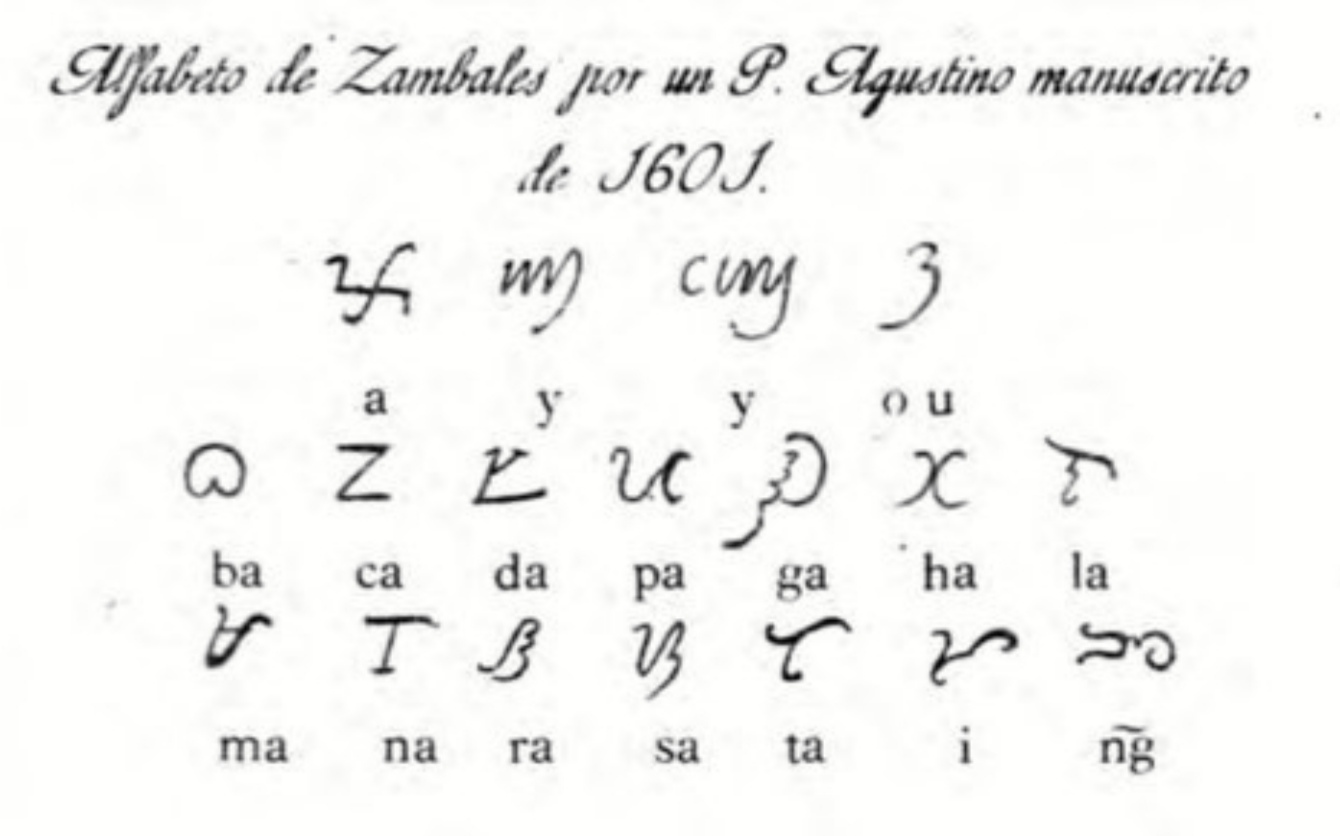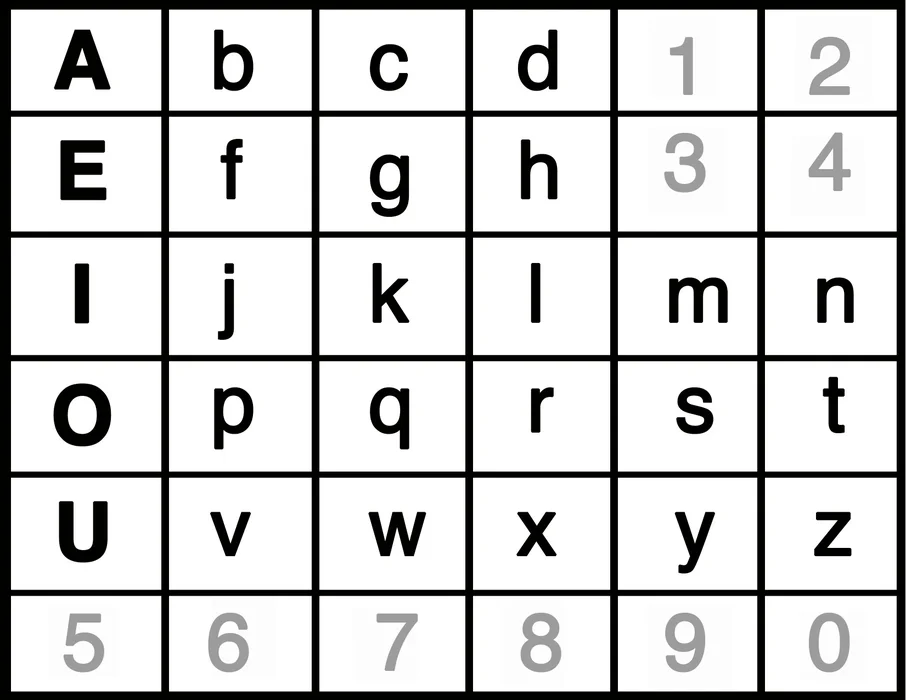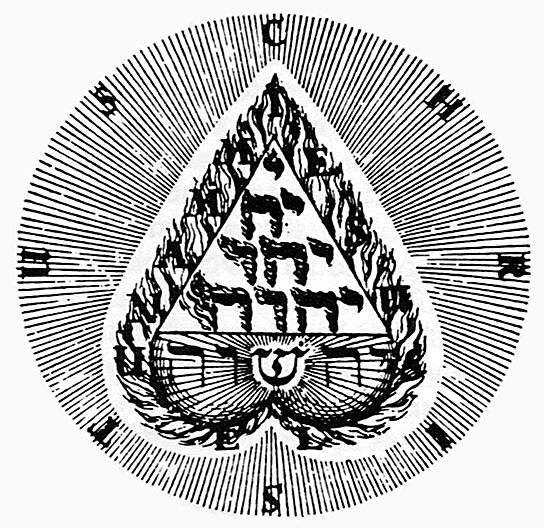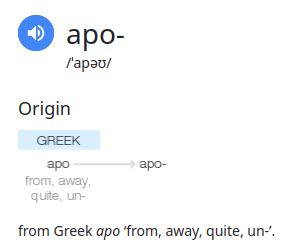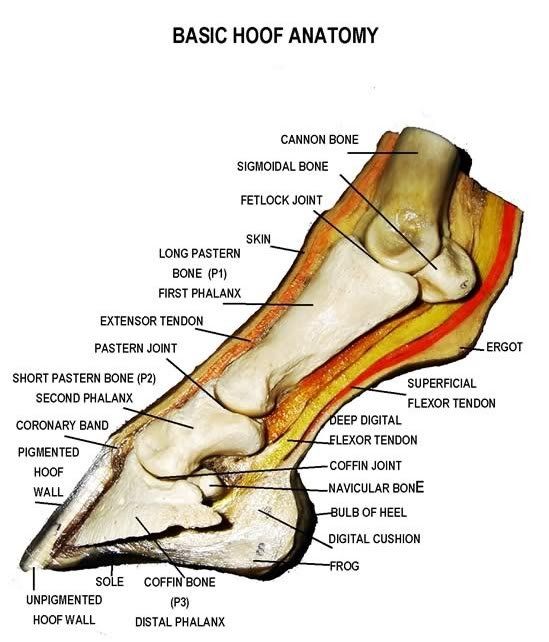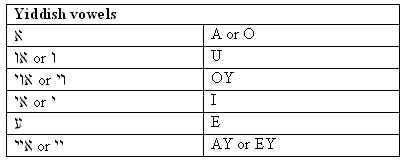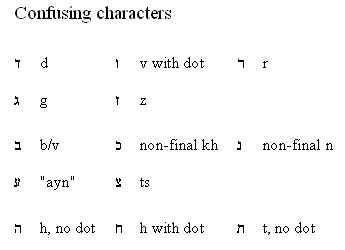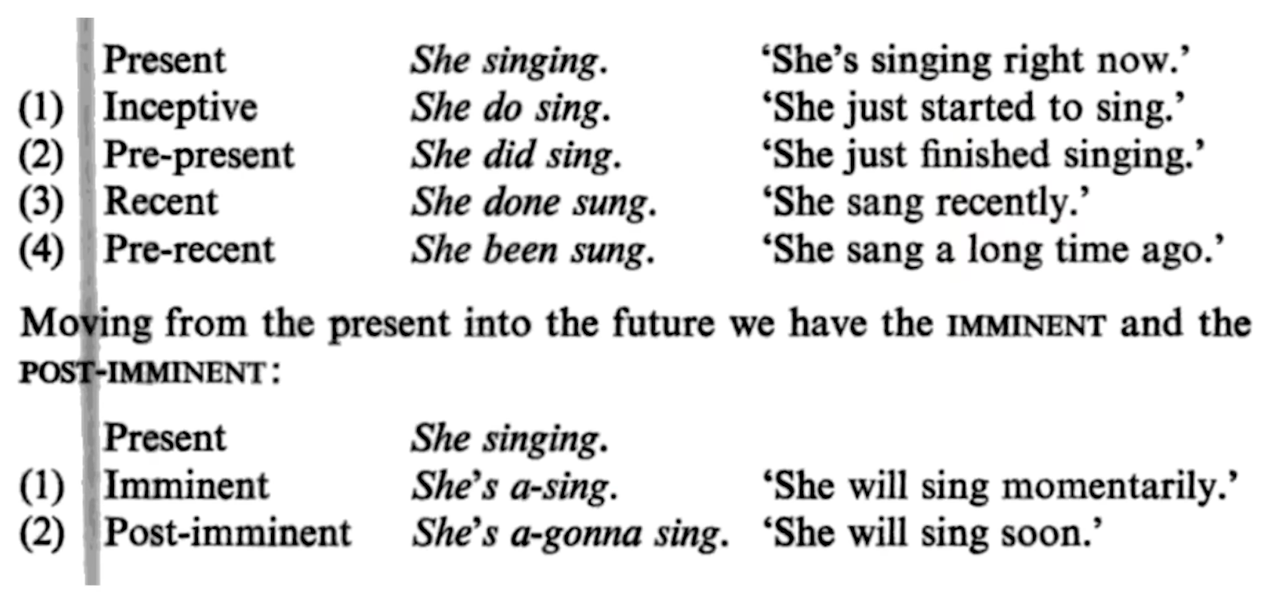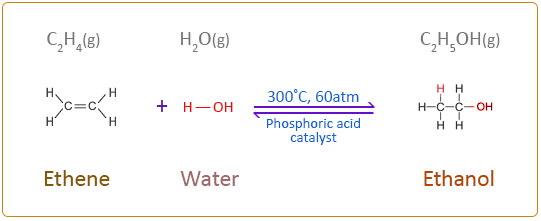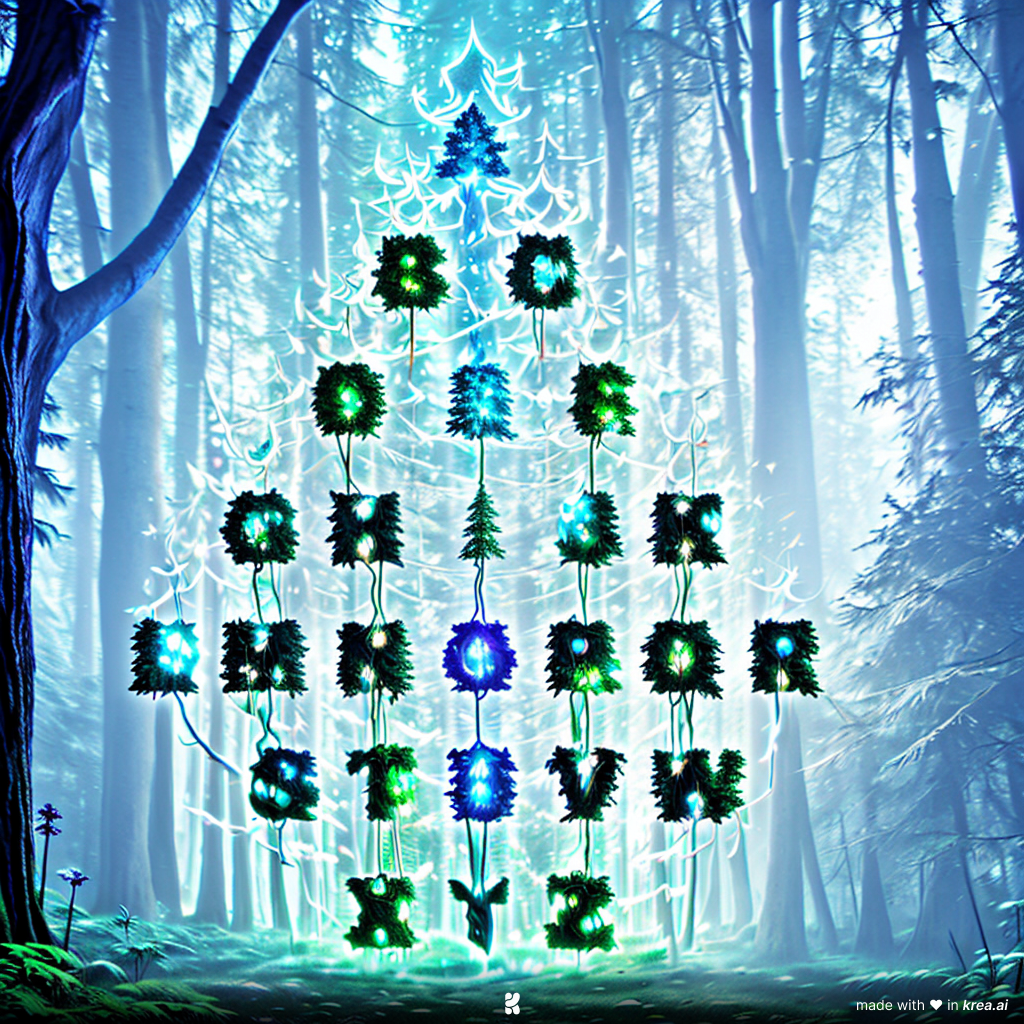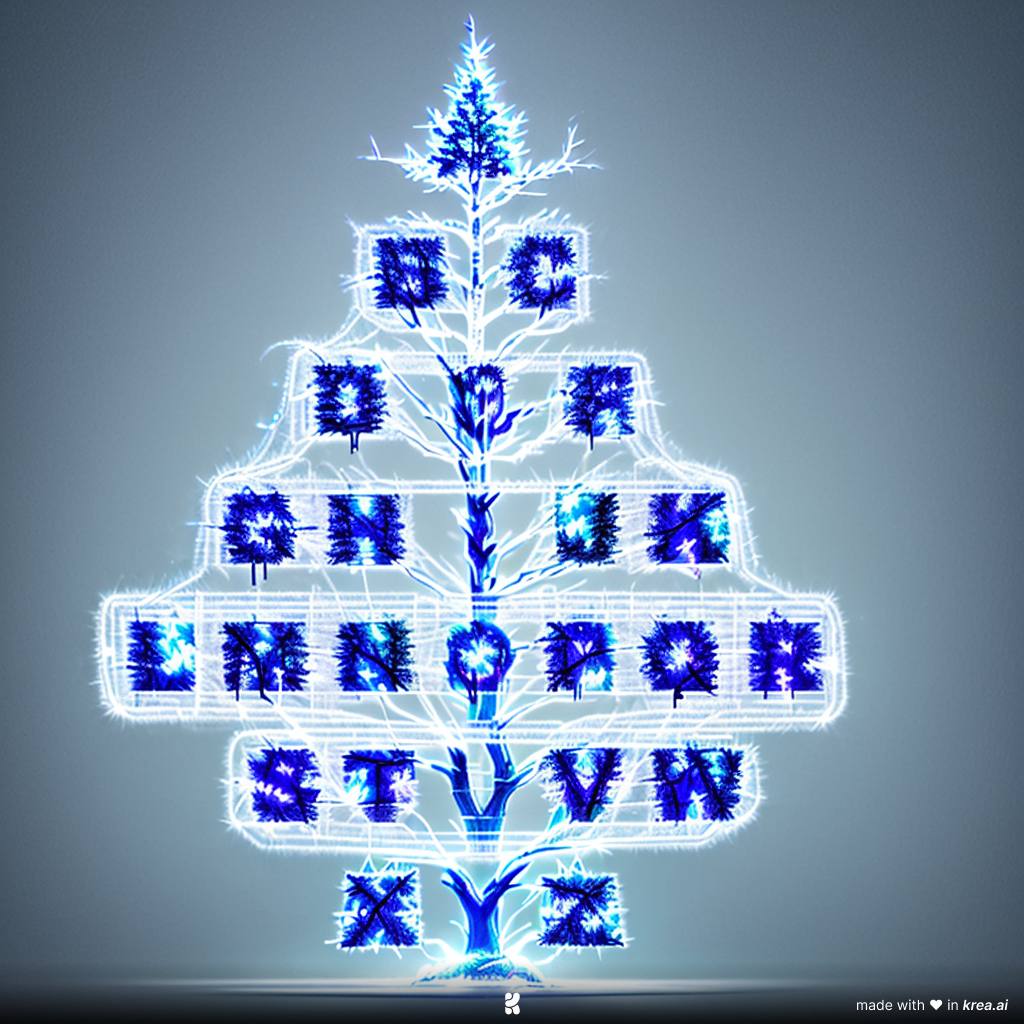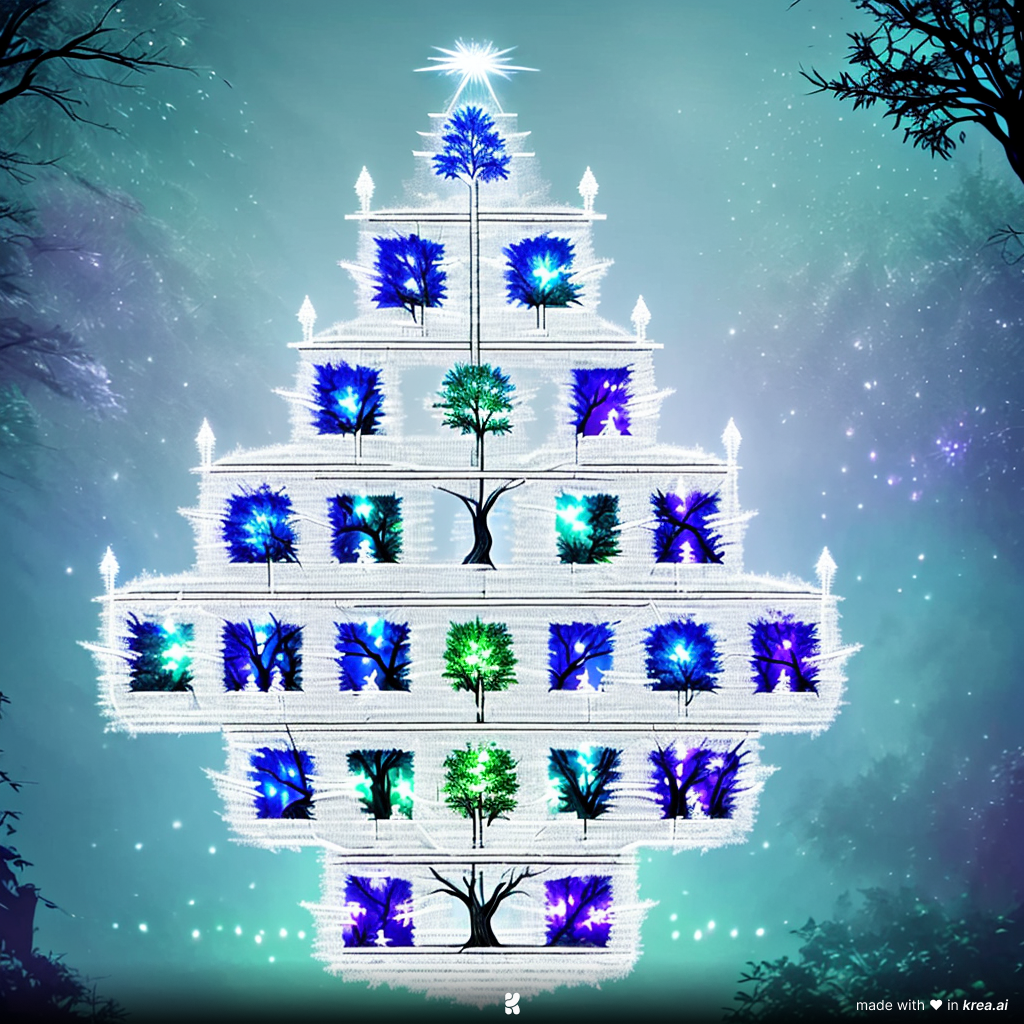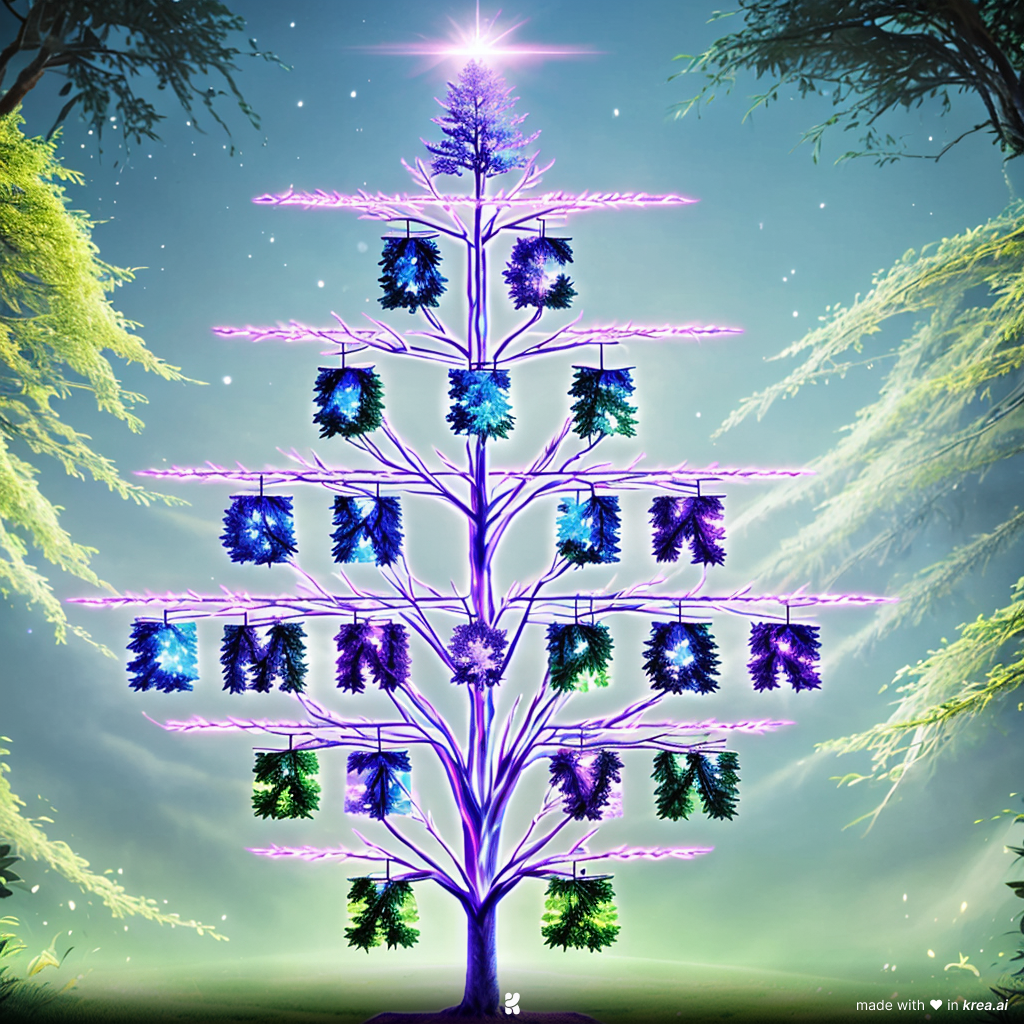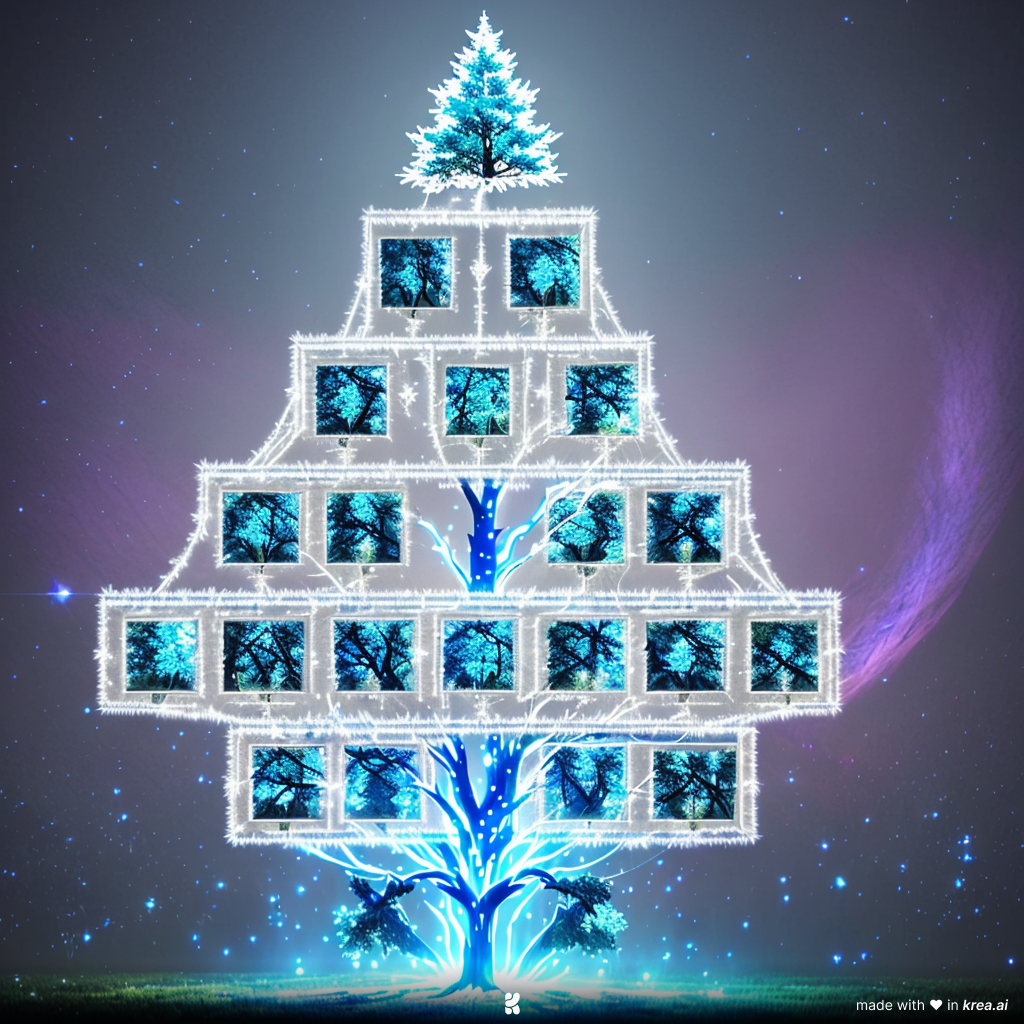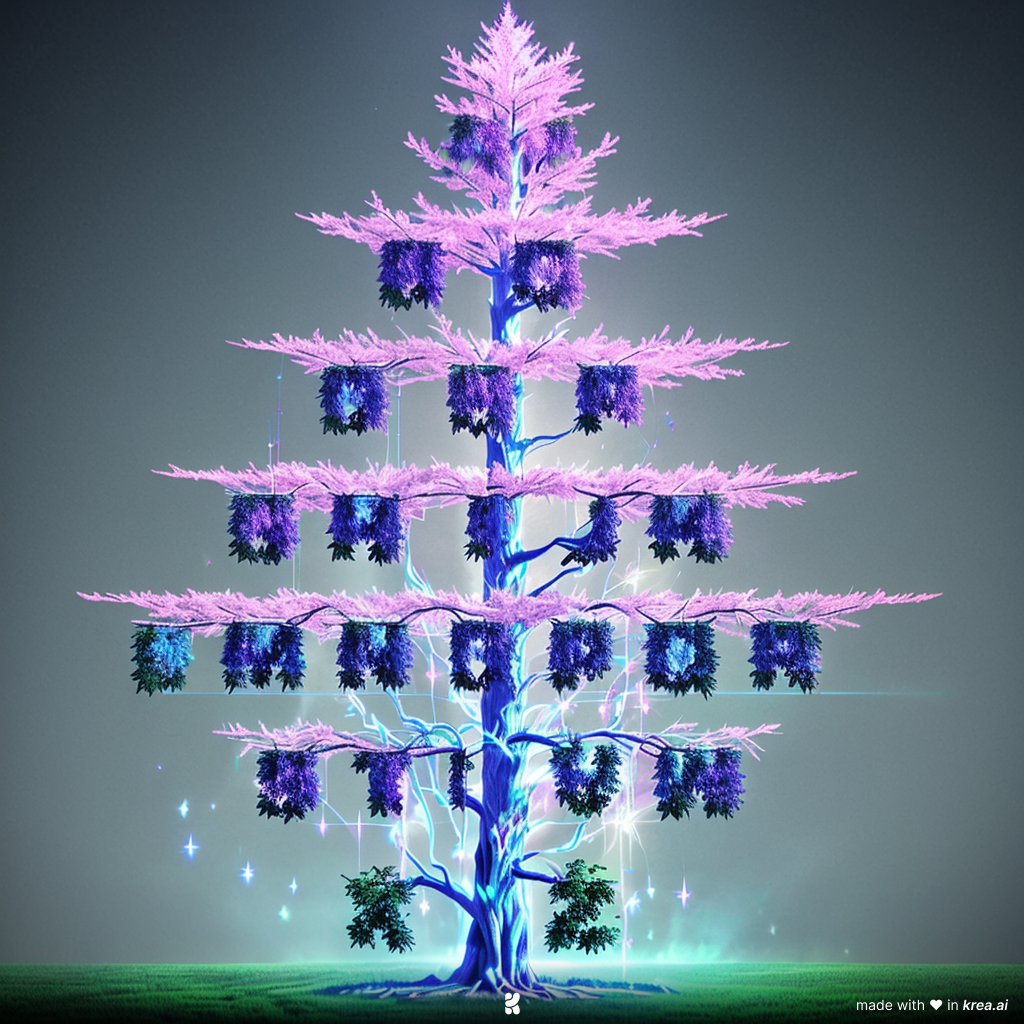It is volume 32 (31 30 29 28 27 26 25 24 23 22 21 20 19 18 17 16 15 14 13 12 11 10 9 8 7 6 5 4 3 2 1 0)
This is a part of a raw and uneven journal of digging into the writing systems from all over the world, so I recommend you to read the summary of this work instead.
Somewhere closer to the end of the previous
volume they said
<Y> sign, one of the most frequently occurring signs in Palaeolithic non-figurative art, has the meaning <To Give Birth>.
which made me think of Yule as of day of birth of those who were conceived on 1st of march. But then what celebration was that? I just don't know if this hypothesis stands, either way, I collect them all.
So, now we can arange that calendar we rotated to the primstav, to see the direction of the months:
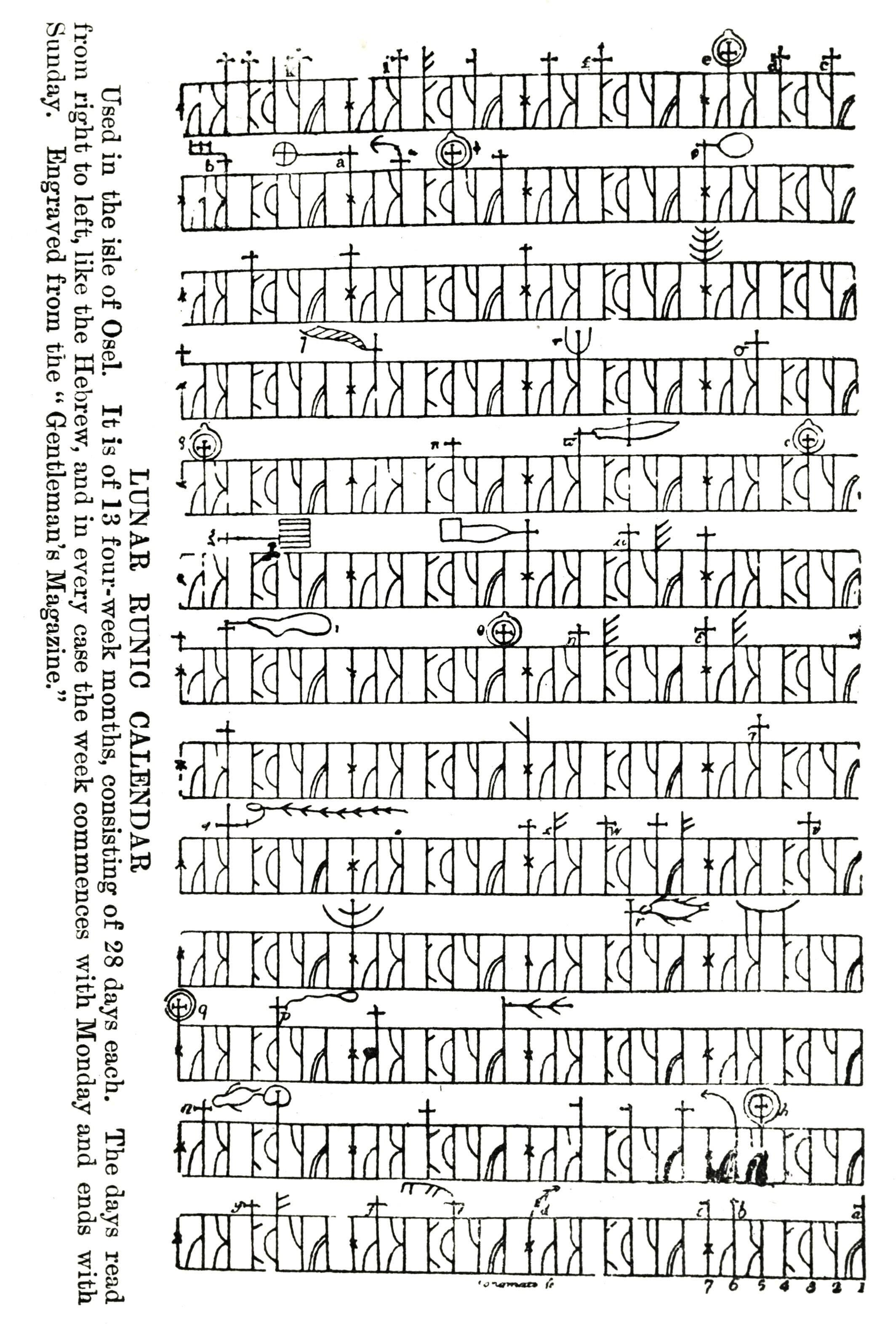
and I can immediately see first, sixth and seventh of january in the 1, 6, 7 of the bottom right corner,
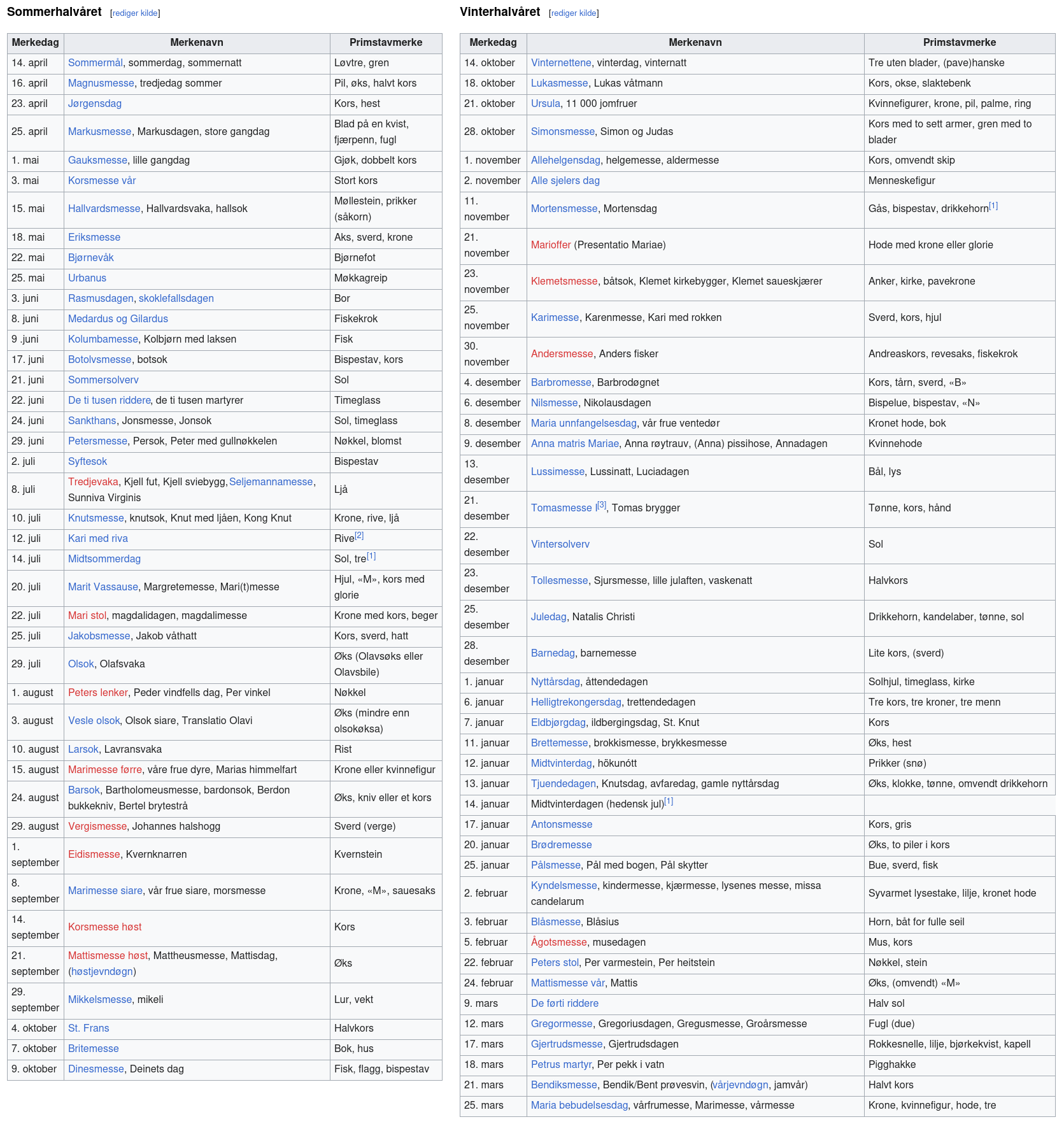
and it makes me want to rotate it like this:

And I can see, that in this one they celebrate Midtvindertagen Midtvinterdagen and Antonsmesse, 20th, but before 25th they also celebrate 24th, which is not in the table.
And then I can see how days of the January go into february as 29th, 30th, 31st, and after them you can see the 1st of Febrary and the festivities on the 2nd, 3rd and 5th (but then 7th and 9th and 15th too, which is not on the schedule) and then 21st instead of 22nd, but the final celebration is on 24th is on both the stav and the table. And I see that the february was of 28 days, because I can then count that the next holy day was 12th of march, they missed the 9th. Then 17th, then 21st, then 25th, in total accord to the table. So I think I found that the columns go in traditional manner from bottom up, and the only explanation I can have for the text not going in reverse boustrophedon is them being different columns. That originally months were written on different trees. And here comes the oghamic calendar, which also had 13 months:
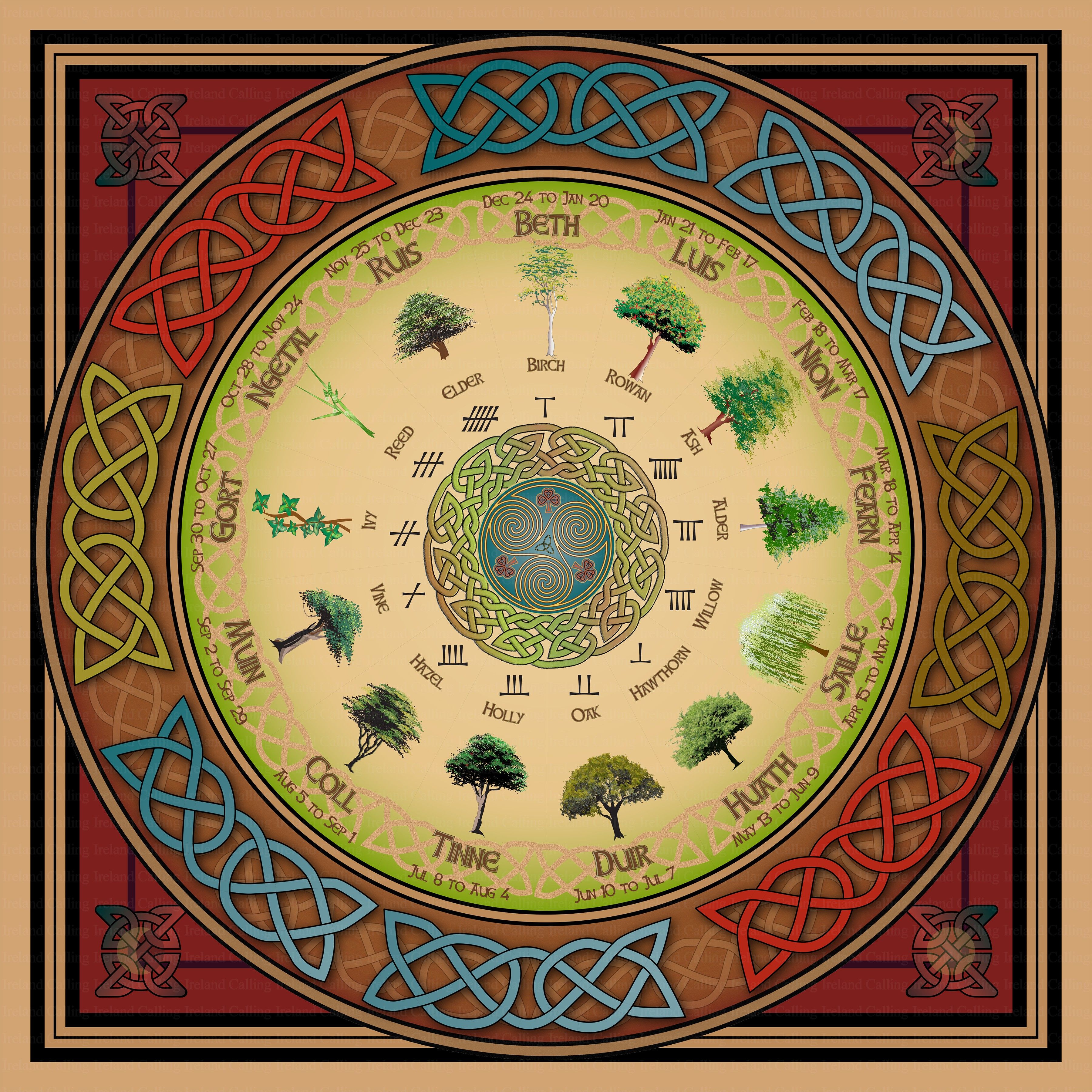
But then what does that calendar doing starting with the 1st of January? Was it the transitionary model? As if they accepted the beginning of the year on first of january, but kept their own number of months? Or does it prove that stav to be a forgery, or rather a later reconstruction with that obvious mistake?
Most definitely these astrologic year, linked to actual astronomic events is also accepted by the germans, because the sky is the same, and events are observable everywhere, so .. so I assume that they were the same thirteen months.
Were those the plants people cultivated because they had some use for them? Like reed was used for production of pens. Birch though is not likely to give either sap or bath brooms. Did they cut it in winter? Why would they? You are supposed to prepare wood beforehand. But what if they didn't collect not to be robbed? Winter is the time when you need wood for your oven. Nah, oven eats wood all the time, they cooked on it.
Elder (бузина) and Alder (ольха) are two great words making me think of them more than of others.
And what about Ruis and Luis? Ruis is the very Elder, and Luis is Rowan (бя рябина) and rowan and ryabina look cognatic to me, and make me recognize the similarity between w and b, as all letters are the same, and how 7 kletters could be enough to communicate in a way. if all linguals are the same B and all the linguals are the same T, with 5 vowels having consonant counterparts, we have 12 letters, which is rather reasonable to have, and what would be the counterparts? Or what if they had 4 vowels? 10 letters, but come on! What am I even doing here? guessing? something like this, intuition leads me. And I read today that combining anthropoology with extatic magick to reconstruct the old beliefs is what Blawatska brought to the table.
and on this note I stumbled across the father of all russian historic freaks
Классен пытался доказать, что славяне обрели свою государственность не позднее, чем финикийцы, греки или римляне[5] и находил славян на многих территориях и во многие эпохи. По его мнению, славяне обитали у Балтийского моря 4 тысячи лет назад, русы героически защищали Трою, жили в Аравии эпохи царя Соломона, в начале н. э. существовала «Великая Россия». Со славянами им отождествлялись почти все народы Геродотовой Скифии, начиная с самих скифов, а русские связывались с этрусками. Он писал, что уже 4 тысячи лет назад венеды обладали грамотой, и называл все рунические письмена славянскими. Санскрит Классен отождествлял со славянским языком, парсов относил к славянам. Донских казаков он производил от гетов, а геты, по его мнению, жили в Малой Азии[2].
Классен является автором очерка «Новые материалы для древнейшей истории славян вообще и славяно-руссов до Рождества Христова)» (1—3, М., 1854—1861) и автором единственного перевода на русский язык труда польского филолога-любителя Тадеуша Воланского «Описание памятников, объясняющих славяно-русскую историю», который был выпущен с примечаниями Классена в качестве приложения к «Новым материалам…». В них он излагает теорию существования дохристианской славянской письменности — «славянских рун». К «славянским рунам» Классен относил ряд древних письменностей, в частности, этрусский алфавит[5].
and I decided to mention him here, because Vinča writings may tell that he wasn't wrong, when he said that уже 4 тысячи лет назад венеды обладали грамотой but then how dare I link two geographically similar cultures merely by the similarity of their names? Especially since we have no idea how representatives of vinča culture called themselves. Maybe this can clarify: В человеческих останках культуры Винчи в четырёх исследованных образцах (Lipson et al., 2017) были выявлены Y-хромосомные гаплогруппы H2 и G2a2b2a1a. Также были обнаружены четыре разных линии мтДНК: K2a, H26, U2 и T2b[8]. Все мужские и женские линии соответствуют характерным для европейских неолитических земледельцев.
У представителей культуры Винчи из Гомолавы (Хртковци, община Рума) определены митохондриальные гаплогруппы H, HV, K1a4 и Y-хромосомная гаплогруппа G2a (субклады G2a2a1, G2a2a1a)[9].
either way, it would be not four, but seven thousand years ago. Yes, pretty intense.
So, let's look at vinča's writings:
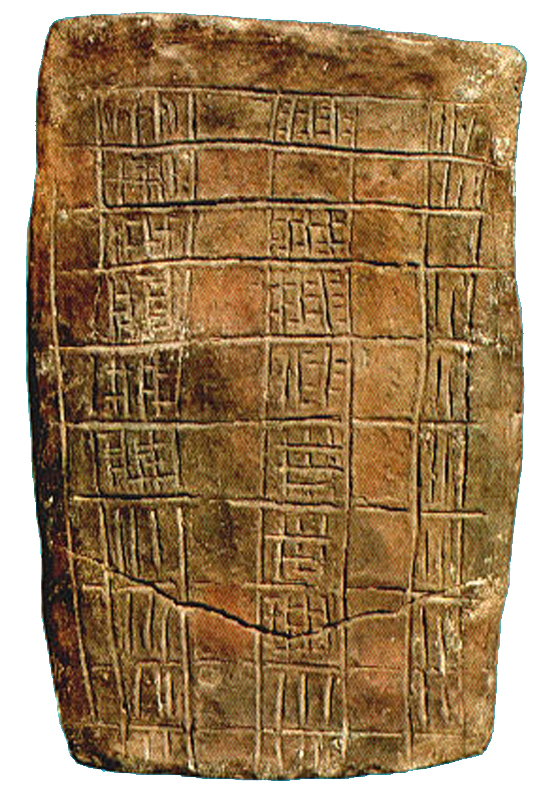
This is like what is this? Is it even writing or a knitting pattern?
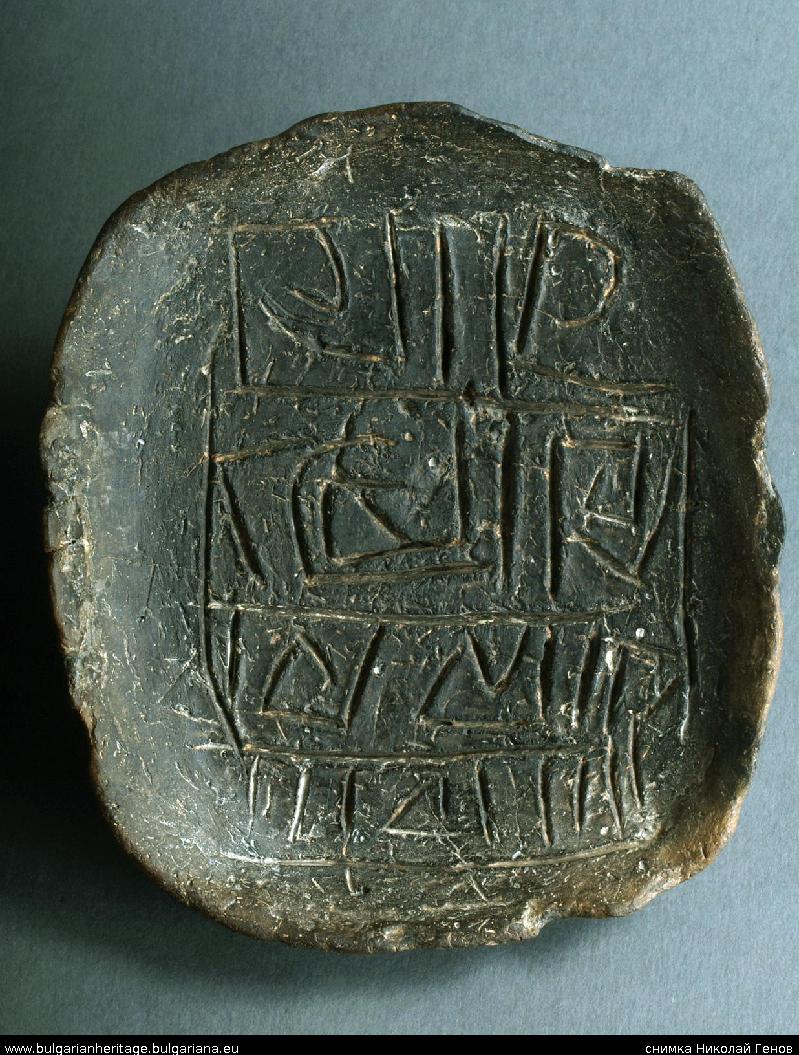
this one is more like writing, but still wtf is this..

and this one is definitely some writing, and it reminds me mesopotamian protocunieform:
but then we definitely see the differences. Vinča is much more european, even greek, looking. I think it is why the guy who excavated it first (8 metres is the depth) believed that he excavated some greek settlement. I'm speaking not only of D-like shapes, but even more so of the 𐤇-like shape.
Archaic tradition of church has preserved some idea about rotations whether they're clockwise or counterclockwise, I went to church to recognize their way, and I found that you have to enter the church to the left, because you're left when you need to connect. Otherwise church is not in the houses of wood or stone. But I think this is the part of the bible discovered recently. And I think church didn't oppose them, so I consider that saying (found where? look it up yourself бог не в домах из дерева и камня) to be change proceeding in religion.
Will islam change? If it follows christian footsteps of an abrahamic religion, it will. But if it was made differently, it doesn't necessarily do. What can civilization do to tame those religious faggots? Give them heaven on earth, depending on other people rather than on some imaginary entity.
Matter is divided into wood stone and meat. Could it be the model of the ancient people? that three by three by three. Solid matter that is. Three mothers are three matters.
I shall not expose the wild side of the myth, I will focus on their understanding of the alphbaet бает? арфа бает
B D
F Г
M Λ
W Y
Ba Da
Fe Ge
Mi Li
Wu Yu
Those B and T times vowels. The more vowels you can distinguish, the more shapes of those TWO you can get. Vowels could vowels combine with vowels? Yes, and that is language of gods, the vowel words eau, awe, ieue
but ieue or ieoe? was ע o or u? because it does look like у. I never thought of ע this way, or never enough
A B Г D
E V J Z/// ahrhgh
E V Z H Θ Θ looks like Ho, or oH, or ниво энво Hino H_in_O
Could Θ be borrowed from china? no, chinese do not have it. Could the shape say something else, some depiction of thtat sound like "chinese" hidden in such simple shape would be great.
A B Г D
E V Z H Θ
..why transliterate hebrew in this mixture of latin and greek letters?
Work wiht latin. Look at the modern alphabet without O-line
ABCD
EFGH
I J K L M N
U V W X Y Z
and I notice that there are 20 of them,
ABGD
EVJZ
IMNL
UWXC
and I think I reconstructed that. C is S, as in russian, as the lunar sigma.
Was it some Ɔ X C ?
No, I'm pulling the cat, not cool.
but that 4×4 thing is cool, let's dig it,
ABCD
EFGH
I J K L M N
U V W X Y Z
ABGD
EVJZ
IMNΛ
UWXC
Okay, so what letters did they add? F H
I will probably keep on adding new наблюдения into this journal, but i expect to stop keeping, as I many times claimed, one day I'll be true.
I wanted to say, that I decided to give up weed, because to achieve my other goal I have to give it my everything.
ABD
EVZ or EWГ? was Z 𐌆? and thus IVX were ZVX? the opposite of XYZ? but it's too much to take in the light of how great IVXLCD lays into ABC...D like literally AВ...CD
So, I was saying.. I love smoking weed, I love this feeling, but then at first I was asking "how is it to achieve success without smoking weed? may I get answer to this question? You probably may, but the same way you may learn to run with a weight pulled to your feet, but it would make it easier for you if you lay the wayed away.
ABD
Эвз is just a dialectal variant of reading the ΑΒΔ of the first line.
IML is much further, yet still understoo, but AIU are the early triad. Did Pythagoras use his tetraktis to measure music? To draw accords? Only three cords, and they pulled them in different order, and musical notation would be a ligne connecting the dots or making circle around the note, if it was repeated twice. I think I'm using the blawatska's method of combining anthropology with actual extatic revelationism (why would my trippin be worse than those of the ancients? Especially since I merge and delve inot the material they could be researching reading learning)
So far, I am high today, and only after I smoked I realized that it is like doing it weighed, literally stoned. I asked that question if I can do it like this before I smoked. And the answer is perfect, don't you find? I should give it all, this is how I do it. And yes, probably it is the answer to my question of how to make it. If I want my immortality, and I do, I should give it all. And what it means is also that I should give away everything which stops me from making it. And of course I shouyld dedicated should dedicate every moment of my life to achieving this goal.
So, knowing me, I know that these language observations will keep on coming, only 20 times less often
So, I will probably keep on this diary for some longer, probably to kill it as king at 33
I think if I ever publish it in the form of actual books, I shall add additional volumes to 21 and around it, or maybe I spread additional pieces through the volumes, adding small ones to large volumes and huge ones like tiny latiny to the shortest, such as 21, for example. And what about manuscripts? Only if I manage to decypher them all will I add them to the edition. The electronic edition is already here, in html format, and I think this is enough and sufficient for such enormously raw material. May only good pieces be present in the form of the book. May ai taught upon that raw corpus make more books like the one I managed to issue myself. It will probably find more of tidbits in my mess. I will be the editor, of course. If it makes sense to me, it makes sense. And naturally sometimes it may lead me into what I didn't see because it will use the information I copypasted but did not remembered.
ABD
EVZ
IML
OПR
УФS Uфq? uфþ
There's difference between þ and ϸ:
Thorn or þorn (Þ, þ) is a letter in the Old English, Old Norse, Old Swedish and modern Icelandic alphabets, as well as modern transliterations of the Gothic alphabet, Middle Scots, and some dialects of Middle English. It was also used in medieval Scandinavia, but it was later replaced with the digraph th, except in Iceland, where it survives. The letter originated from the rune ᚦ in the Elder Fuþark and was called thorn in the Anglo-Saxon and thorn or thurs in the Scandinavian rune poems. It is similar in appearance to the archaic Greek letter sho (ϸ), although the two are historically unrelated. The only language in which þ is currently in use is Icelandic.[1]
The letter ϸ (sometimes called sho or san) was a letter added to the Greek alphabet in order to write the Bactrian language.[1] It was similar in appearance to the Anglo-Saxon and Icelandic letter thorn (þ), which has typically been used to represent it in modern print, although both are historically quite unrelated. It probably represented a sound similar to English "sh" ([ʃ]). Its conventional transliteration in Latin is ⟨š⟩.[2]
Its original name and position in the Bactrian alphabet, if it had any, are unknown. Some authors have called it "san", on the basis of the hypothesis that it was a survival or reintroduction of the archaic Greek letter San.[3] This letter ϸ closely resembles, perhaps coincidentally, the letter ⟨𐊮⟩ of the Greek-based Carian alphabet which may have also stood for [ʃ]. The name "sho" was coined for the letter for purposes of modern computer encoding in 2002, on the basis of analogy with "rho" (ρ), the letter with which it seems to be graphically related.[1] Ϸ was added to Unicode in version 4.0 (2003), in an uppercase and lowercase character designed for modern typography.
And Carian alphabet is quite a treat:
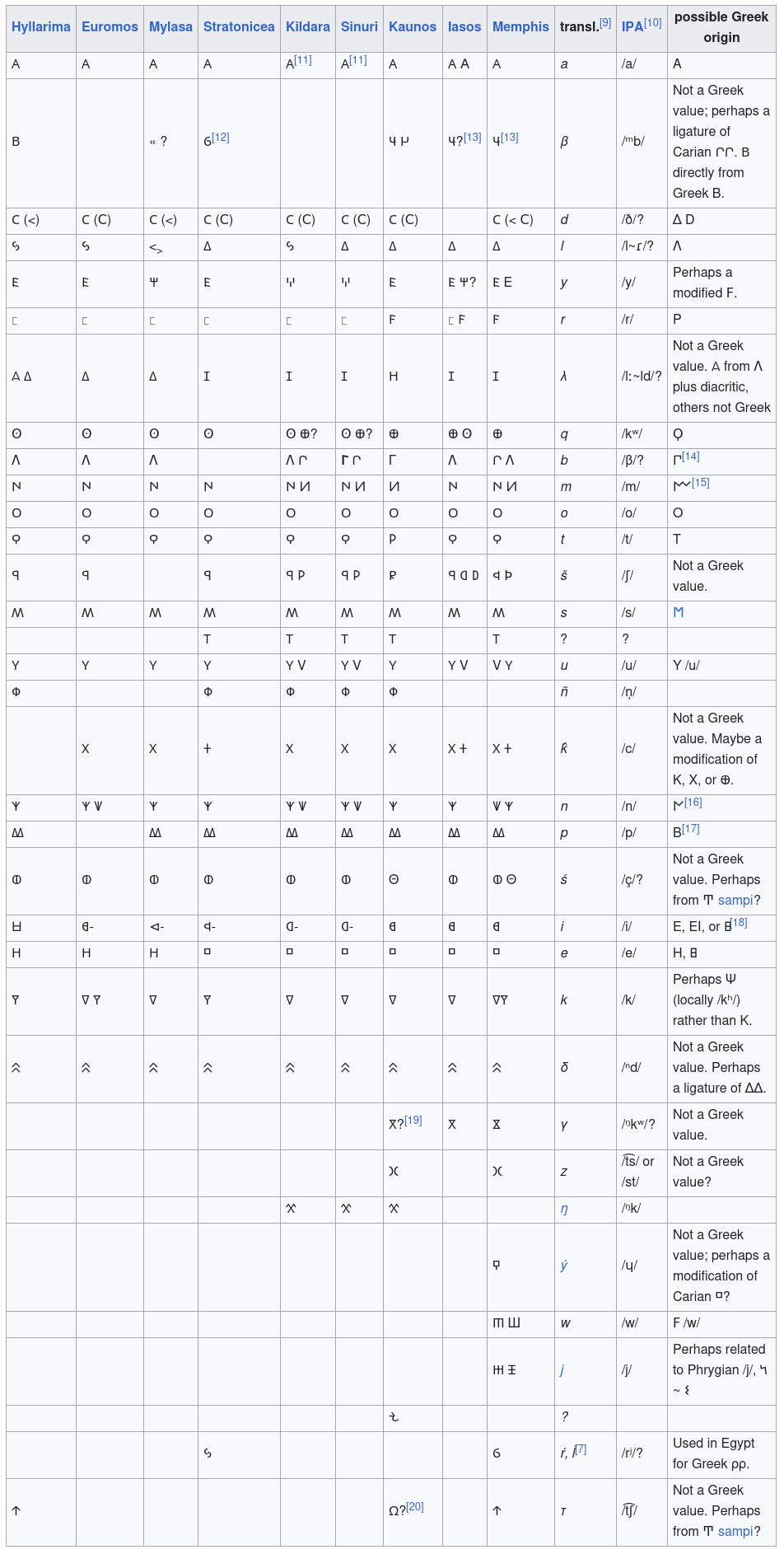
𐊠 𐊡 𐊢 𐊣 𐊤 𐊥 𐊦 𐊧 𐊨 𐊩 𐊪 𐊫 𐊬 𐊭 𐊮 𐊯 𐊰 𐊱 𐊲 𐊳 𐊴 𐊵 𐊶 𐊷 𐊸 𐊹 𐊺 𐊻 𐊼 𐊽 𐊾 𐊿 𐋀 𐋁 𐋂 𐋃 𐋄 𐋅 𐋆 𐋇 𐋈 𐋉 𐋊 𐋋 𐋌 𐋍 𐋎 𐋏 𐋐
But this is not the attitude to smoke weed with. Am I still smoking it? If I do it, do it good at least, these trips are not what I'd miss if I still keep on using it from time to time. Am I? I don't know, but once I'm high, let's smoke again and dig in. Look at that Carian thing! It's as if muses tell me no don't go
Integrity Patience Delegation doesn't tell to give up what you love. It may help me by instructing me to delegate the social funkction to somebody with social skill. Do I need social skill? No, because social interaction kills the creativity, and I need creativity. After all, why so ungrateful I know what I know and have what I have because I smoked weed, so let's smoke weed, there's nothing wrong with smoking it if you're an artist. I asked how to do it, and a) I was told that it doesn't help me to do it myself and b) it tells me that I have to delegate the functions this creativity booster may impair
(impair like the opposite of repair, which is morphologically is kind of weird, until I recognize that im is not in, but un, it's as if damages only one boot, keeping other with no pair? Nah, hardly it is so. I believe it is )
So I took on faith athat Integrity Patience Delegation is what it takes? Delegation part I should work on. And I should also improve the other parts. The other parts I've been working on for some time: I don't allow me to lie, and I have learnt that everything comes to one who can wait. First you have to delegate, that is how you wait properly.
is impediment is impending ?
depending is not depediment, but dependance dependence
Were different suffixed suffixes chosen and engrained by the use of the term? or do they have somewhat different meanings? Currently we don't may not distingue distinguish the difference, but morphologically naturally there is.. unless the order is changed when it was not word but sentence.
ence in Dependence reminds iment in impediment. What is the difference? en+ce ~ im+ent...
I don't know, but let's guess. is en~im? then ce~ent? this makes ent it, because ceIT is itEN.
and if they're switched? en~ent? ce~im? nah, this is worse, because I cannot explain ce~im pair.
im is I am, ce is this, m is inside, ce is outside. Is it? is both ence and ement in and out?
Dependence itself is what depends on both side.
Depending is depending in, inside.
Depended is what's on the outside, what he (the subject) depends on?
is s random as tzarist russians' 's? дас, нус, вотс, зафиксировано много где в золотом периодие русской литературы и вплоть до Чехова быть может.
ed ~ out
ing ~ in?
ed and ing are antonymous morphemes, and so are out and in. And it is only natural that they united.
did ~ do out? out is not here any more, in the past, thus.
was in used for future (I applied understanding of ed of the passive case and applied it to the past simple, and it fits just well)
doing is present and I knew it was in! I knew it from completely different route.
Suddenly I suspect I lick my own tongue so to say, mapping the way I actually understand it, when I imagined the routes, I think the shortest one is chosen simply by tension o fneurons.
I imagined routes of the language map I'm starting to assemble gradually comprehending the morphemes, but that chances are it will be very similar to the one we actually build in our language aquirement: on the subconscious level we feel the difference between similar words with different suffices even when we don't understand their particular meaning. Like на в димина is it the same as на в на диме? And only know can I see that it is the same morpheme. If it quacks as a duch..
Looking at the kurdish alphabet, they preserved the vocalism, arabs borrowed it from kurds, not the other way around! If not directly, the flow was that way and not the other, even if technically they just had common ancestor (they naturally did, but I'm speaking of what gave these shapes to both of them) then kurds have preserved the vowel part closer to the original version, because vowels matter.
What I'm saying is ه the ههه which is e in kurdish, but not a vowel in arabic and persian.

But I brought this here to demonstrate how much those vowels (kinda representing aeio, look like ioue. They're like all different. Is it like in the carian? different words for different concepts? But how I know that ع represente E and not З? after all they go the other way around. Is З consonantal pair of E)
A~Д (a~D, a~d (l;ke hands down it's the same letter))
E~З (in greek alphabet it is exactly how AД are the initial and final positions. Are they aбgд like four shapes of arabic laettes? letters? separate, initial, middle, final? were they just three when initial was the separate one? then did ع look like the first form of ععع? Isn't عع the swashed ع? But then what? do they write it from the bottom right corner? No, that is where it ends, they write right to left. It is like the lower end of g, so technically ع is з? or is з somehow e? both are зе or ез (the, est, it~is)
ИN? if the second line is it is, this one is probably I'm.
UR is the third (of three)
is ABþϸ Aз Вы Сей(те)?
сё и то.. разница в месте (и времени) се ближе to.. I, то ближе to.. U?
O is of Our? i~o? ии[i] ~ [u]uu
was a the base viowel and both u and i were dialectal flexions? твоя противостояло нечёткой падежизацией вариантов твоей~твою, условно говоря твоею.
Это бы объяснило the и~u thing.
our also unites u into o thing. were our opposing their? were ou we? almost.. nous and on[ñ]
n̆ň those are different 0306 is )-like and 030C is >-like
u~n? both meet with v~ν
is ou reconstructed form of us~we? is s in us dialectal fashion~craze~rage to distinguish words of their language from different words of the language of the opponent, when for dutch U was you and for englishmen it was we, or even I.. nah I is I V is five of us, or probably at first it was only two:
EFGH.. I can only see He, and exactly at the position оН is in. isn't g gij? What is E? je?
was f w the wij? but вы is there.. was it why Z of zeus stand instead of F of fairy? Thronos? Many, it is difficult, if it has the M-like misplacement, I will never figure it out. I need some 3d modelling by ai to see it more clearly. So far I think I should be happy with what I get, maybe with time I can see it better, hopefully in close proximity I can get access to ai tuned up for my own purposes, for my personal use.
Are vowels and labials both go for first person pronoun? I'm, I~me, but U~Вы, even tghough U~We
was that u we too?
Hey! I think earlier I said that E is not je, but это? э как ה the the. literally e.
E
I
U
?
A I U
A ~ one
I ~ me
U (you)
So is first person the third? No, it just tells that A is indeed added later, when the meaning was lost.
I U A was the first vowel order? ➘➚?
больно~больно(как же стока (как же столько))
TM is team! (trade mark, but тм(тм) and team(ты+Ah'm (scottish Ah(Я, I)))
Ма(of ма́ма) корень слова моя[мая́ (и как прикольно что в слове моя ударения на я)]
ma ~ my
mom ~ mine
ma ~ may ya? можешь (где жешь сделаешь. деешь. жжёшь? дашь. жи(в)ёшь (ставишь стоишь)
(по руссуким правиам я должен был сказать "(см. ставишь~стоишь (см смайл, найс. я подумал про сравни, которого сокращение никогда мне не нравилось. скр краше. но сакрал значит кресцовый, не кресто́м а кресцо́м))
ы wws by accident written as oɪ which tells that balls and sticks are all there were, and that is why glagolitic feels so ancient. And looking at runes, giveing the same ancient feeling (because by coulter we know that they are ancient. Hebrew doesn't look as hebrew, it's pretty much the same: always on paper, anthropology at this area is corrupted the most, it is more of a power game than some pushtu, but maybe less heavy than russian or american identity by the mere number of carriers. But then they're маленький да удаленький. So my task is to stop all wars. And in this wish I allow the moshiah to be me. As a wizard, allowing a spirit to enter? A good spirit is it not? It is a jewish good spirit. I used hebrew word messatya messaya is the russian word. or isn't it greek? It is englysh,. ) I realize that balls probably were double sticks. But 𓏭 𓏮 и s n (n still have that reverse leg of being и and N, boustrophedion equlaizes ᛚ and ᛐᛏ) И=N as A=Д as E=З as I=l as O=𐤕X𐤈
(X is T (if your fonts are firmly set in the settings, you may not see 𐤕 (phoenician tav) being x-like, apparently there are variants my seamonkey shows))
So alas, acrobat is better in this account. I should transfer this journal into more acropants pdfs.
𐤀 of the terracota tablet reminds me ᚨᚭᚬᚩᚮᚯᚰ but then ᛆ is 𐤀, so are they different takes of the same 𐤀?
Back to 𐤕, some texts have it like this:


but this is obviously a fake, or let's call it a replica: the letters are too bright, there's noway people didn't touch it with dirty hands, even if it wasn't laying in the dirt. Too new to be true.
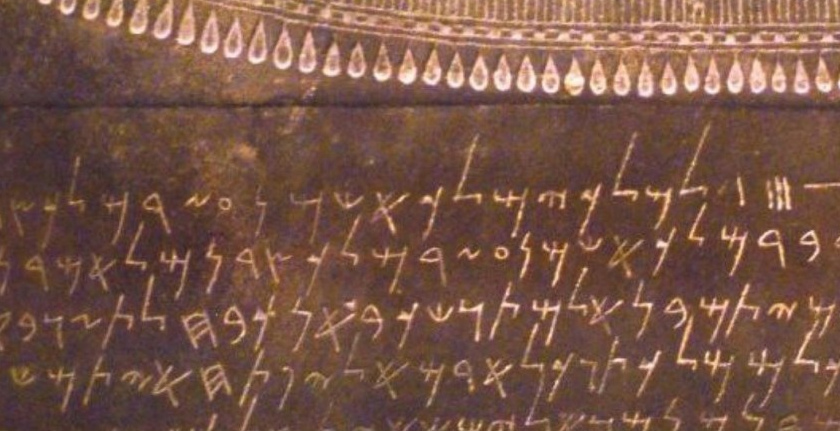
here you can see lameds in the highes letters, the shape is pretty much similar to modern L,
so just as is used from then till now, so L
was known in the ancient times, so K is those axe-like
shapes opposite to 𐤀, and actually I can see now, that both
of those texts, seemingly never found uncut on the internet,
they use the unicode sequence the way seamonkey shows it:
is used from then till now, so L
was known in the ancient times, so K is those axe-like
shapes opposite to 𐤀, and actually I can see now, that both
of those texts, seemingly never found uncut on the internet,
they use the unicode sequence the way seamonkey shows it:

and not the way firefox does:

Notice, how Z is known since then, even if it stands not where we users of latin alphabet place it.
It's as if G, which reminds me that Z~Z̆Ž
I am in a healthy contradiction: one part of me claims it doesn't trust anything jewish, the other side of me recognizes the emotional quality of that statement, and thus keeps the writing system in all it's variations, as a working hypothesis, as something which is likely to be true, but I expect it to fall flat at the same time. I think it is a healthy state of the researcher: he shouldn't know what the outcome is going to be, he can only hope to be successful, and yes, to be successful from time to time. Nobody is always right, but nobody is always wrong either.
It's funny that working with right-to-left writing system I naturally occasionally found myself preferring to start the text from the right side.
So what are the shapes existing since then? A Б Г g E y z K L N O q T or is that 𐤓 Р[R]? but only if it's P[p] does 𐤏𐤓𐤕 go abc-like. Then it's hard for me speak of that, I have different phoenician fonts on my hands, I don't know the difference between them if one is majuscule and the other is minuscule, or if it's sets of different nations combined under the same unicodic spell.
No M-like shape, are you serious? 𐤌 is how M used to look? it is very ᛘ-like, you know.
But they only have W-like 𐤔 instead, which is very ᛉ-like.
is Ma a variant of She?
if virus related to fire (жар)
.jpg)
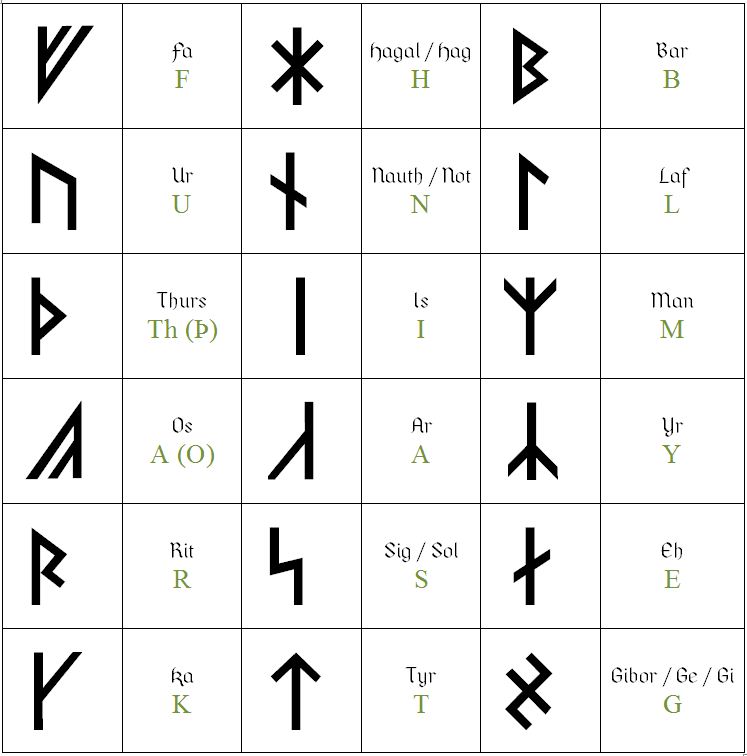
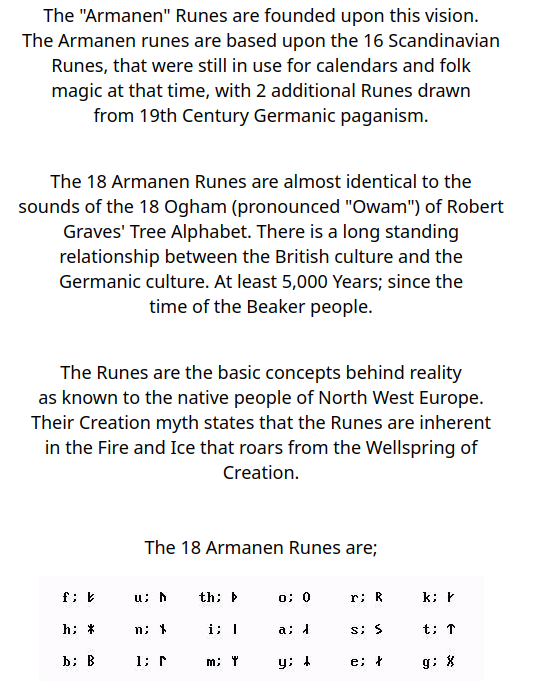 (mirror)
(mirror)
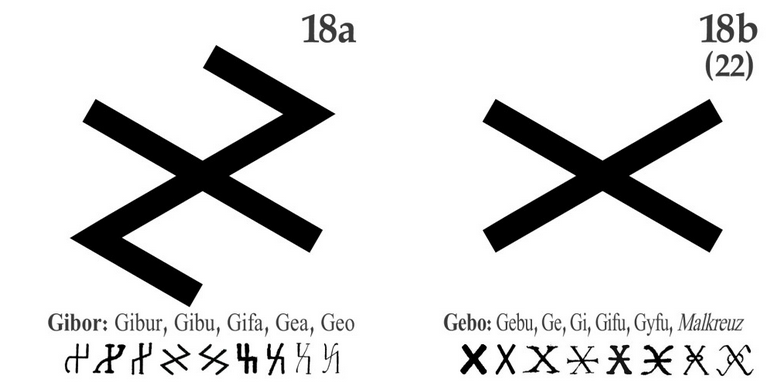 (mirror)
(mirror)
In Norse mythology, Ask and Embla (Old Norse: Askr ok Embla)—male and female respectively—were the first two humans, created by the gods. The pair are attested in both the Poetic Edda, compiled in the 13th century from earlier traditional sources, and the Prose Edda, composed in the 13th century. In both sources, three gods, one of whom is Odin, find Ask and Embla and bestow upon them various corporeal and spiritual gifts. A number of theories have been proposed to explain the two figures, and there are occasional references to them in popular culture.
Are you kidding me! Norsk mythology is telling the same story, but in different detail. But what stories does norsk mythology preserves? Adam and Eve, okay, but what about others? Exodus they probably do not include. But why would people be taugth jewish history? Because it is the history of their masters. But why would those "masters" (the owners of schools) destroy a relative culture? For heresy! Those who didn't agree with their "saint fathers" (jesus directly told not ot coll people fathers.) was considered heresy, and infamously destroyed. Such crazy people. And I brew in this information for years, and only now have I met that
Ask and Embla are like Ask and answer, with answer also being an emblem, as if during divination sticks would make shapes, which interpreter would read. I can imagine that. And also because embla reminds answer in that (according to dutch) answer is ant-word противо-слово? от-ветъ (ответ~ответь, отзнай, приветить~привидеть(издалика, например) вето ведо in-do, as thoughts are done inside, but then food digestion (also digestion, btw, and conception is another duobisemantic word, то вето, которое желудочно-кишечное имеет ж от желудка в переди: живёт жуёт жевать, где вать видеть, ведать, то полезно что в рот полезло, неполезное сблюёшь, злых духов считалось что не выгнал, если одержимый не блевал, и быть может на это намёк в exorcist movie, но я говорю, что духом считался и плохой запах, и ведь если съесть еду с дурным запахом (с дурным духом, "с душком") то можешь заболеть, что могло интерпретироваться как злыми духами мучение, и от пищевых отравлений рвота вполне себе пристойное средство. Понос организм обеспечивает зачастую, рефлекторно, но пей побольше воды, чтоб поддерживать этот очеистительный процесс, нет вы посмотрите о чём я говорю, ну давай этот коричневый участок разработаем подальше, раз взялись. понос пронесло кишечник понёс быстро-быстро-быстро содержимое из желудка прочь? очистительный процесс, эволюционное преимущество, сокращающее exposion time to eaten poisons. If we could immediately quickly fill the intestines with the liquid absorbing food residues into it's soup, taking most of it immediately away? Отёк тканей от воды может быть. Шесть литров выпитой воды может привести к летальному исходу (или около шести, что-то в таких пределах)
Water is considered one of the least toxic chemical compounds, with an LD50 exceeding 90 ml/kg in rats;[3] drinking six liters in three hours has caused the death of a human.[4]
but back on track:
Old Norse askr literally means "ash tree" (see Yggdrasil) but the etymology of embla is uncertain, and two possibilities of the meaning of embla are generally proposed. The first meaning, "elm tree", is problematic[clarification needed], and is reached by deriving *Elm-la from *Almilōn and subsequently to almr ("elm").[1] The second suggestion is "vine", which is reached through *Ambilō, which may be related to the Greek term ἄμπελος (ámpelos), itself meaning "vine, liana".[1] The latter etymology has resulted in a number of theories.
Linguist Gunlög Josefsson claims that the name Embla comes from the roots "eim" + "la" which would then mean "firemaker(ess)" or "smokebringer(ess)". She connects this to the ancient practice of creating fire through a fire plough which was considered a magical and holy way of fire making in folk belief in Scandinavia long into modern times. She identifies the emergence of fire through the plowing symbolically to the moment of orgasm and hence fertilization and reproductiveness.[2]
According to Benjamin Thorpe "Grimm says the word embla, emla, signifies a busy woman, from amr, ambr, aml, ambl, assiduous labour; the same relation as Meshia and Meshiane, the ancient Persian names of the first man and woman, who were also formed from trees."[3]
So why do jews claim people were made of clay? Technically it is probably correct, but in the much further perspecive. Or is it that we were different from trees since we were more simple than trees, thus are we from different branches of life? It depends on how you distinguish trees. Are hydras trees?
Either way, as science religions suck, so why bother with which one is closer to truth, if being closer to the source is more important in the anthromopoologic sense my work is working.
Meschiane is laymen philistines ordinary people in russian (мещане (and because men (мужчины) is a very similar word, I suspect men to be m-en, the abbreviation of meshiane, only it seems in persian it is not plural, but female suffix, or who knows maybe it is both, as suffix a in latin is both female and plural))
Ʌ B <
O M L
V
I had to choose from ɅOV and ɅIV (by reasons of graphical symmetry, and I chose ɅIV fore te the phonetic opposition. Ʌnd because M L was the first very different from B (V is how В sound in russian)
Ʌ Г
I
V L
graphic opposition tells me to go like that.. and what is in I live? 𓈖?
Ʌ Г
I M I saw it here as Om, reading I as O for whatever reason. As in jewish it is.
V L
(for whatever reason I started writing the previous passage chapter вклинившись между текстом выше and the following mark on masonmark)
passage and chapter ~ corridor and chamber
I met the masonmark from above elsewhere, if it is the same, the angle is different:
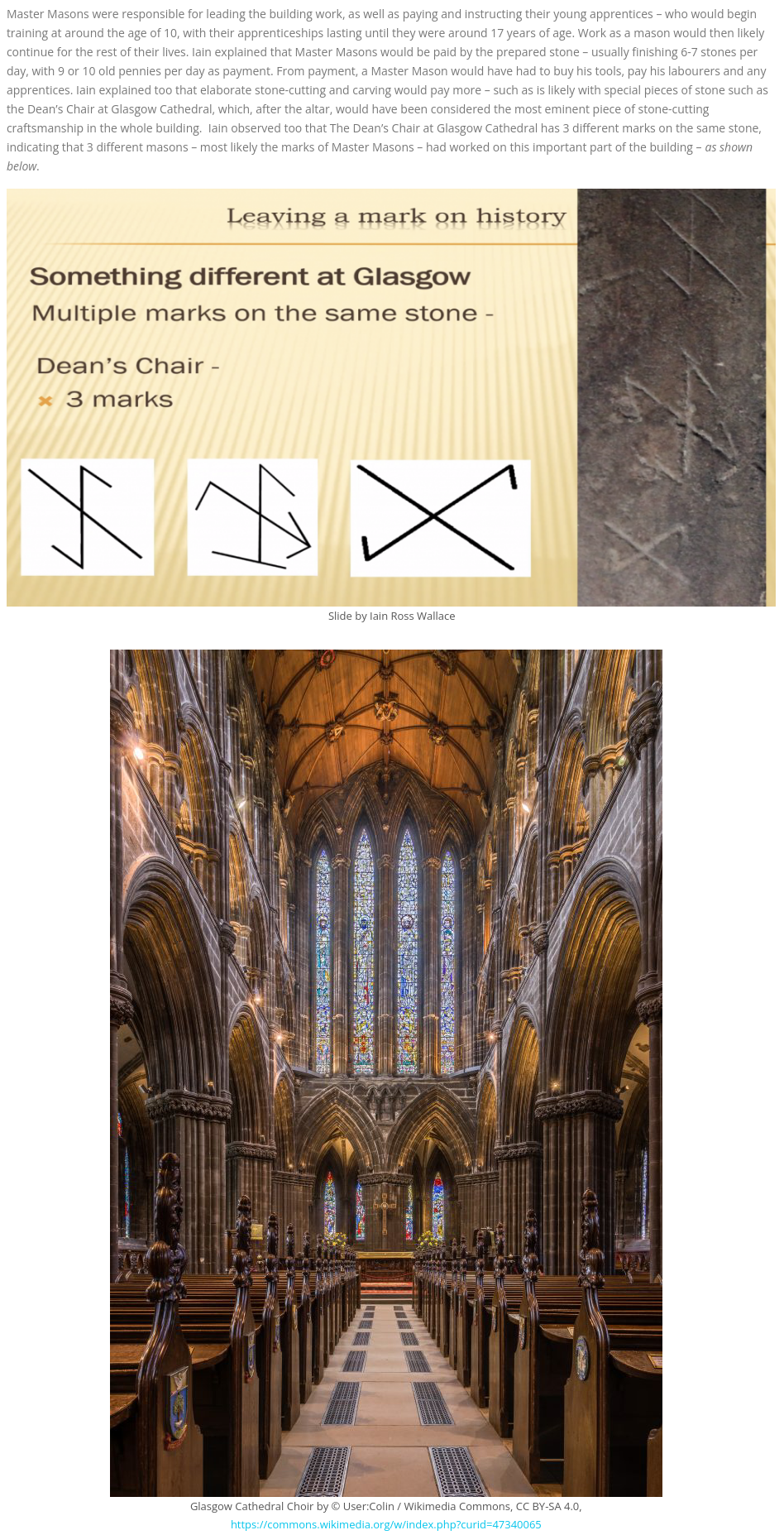
Why do I admire work of the church which wants to enslave humanity? Would god want that? Jewish god does want if, from the very start. And this is why Jesus broke their spell by telling to be sons in the house of the father. And jews shouldn't be mad: as they say, child is god for the first 5 years, but he is slave for other 5 or ten (I don't remember exactly, and it take it as a draft of how you treat them) and then he is equal. Son is not equal. Well, we're slaves today, we're yet to become equals. As in AKIRA human has potential to become anything.
До того, как люди познали единобожие, даже до того как многобожие познали, поклонялись предкам, т.е. людям, люди обожествлялись в древнем риме, быть может и египетский пантеон населён великими людьми, но этого не знаю. Тот был великим изобретателем письма до Ио? До Сешат? Все эти великие имена (слово имя в значении бог, как у евреев.. иудеи они думали лучше чтоли? нет созвучия с враль и вор, но иуда же предатель, что за приколы? страдание как ритуал?)
Т.е. люди были богами первый период своей истории, стали рабами во втором периоде этой истории, и обречены стать равными богам когда вырастут как цивилизация. Миллиарды богов, грозящие перерости в Триллионы, представь ещё один пантеон, где каждый из миллиардов прокачан технологиями до уровня божества, но каждый из миллиардов наблюдает за каждым при помощи анализаторов входящих и выходящих сигналов общей прозрачной сети и в меру возможностей наблюдает за независимыми движениями независимых сетей и индивидуумов (за такими больше присмотра, потому что с чего бы они окуклились отдельно. И если они планируют повредить общую сеть или общую экосферу? предотвращать. Каким образом?
Начиная переговоры. Просить изменить планы. Подкупать. А если человек соглашается и продолжает? Наблюдаем, принимаем в момент совершения правонарушения. Охрана? Автоматизированная, робототехника об этом и говорит, люди подобной опасной и скучной хернёй заниматься не будут (может лишь отдельные power-maniacs power-freaks, teenagers playing it as videogames, observed and corrected if their behaviour is thus problematic, but who decides? The billions of humans, or in some cases families around that person)
Верования древних примитивны во многих аспектах, с чего доверять им в том что касается богов.
Я им доверяю на предмет того, что говорит их религия, чему учит, чего хочет, что продвигает.
Рабство - это из их ритуального лексикона, их раб не отец, а рабовладелец. Масоны молодцы, что рабство отменили. Ужас, жах, жидовство в худшем виде. Сатанизм неискореним, но можно же его направлять в правильные русла. Каким образом? Быв Був Будучи одним из них.
?
Ʌ Г
I 𓈖 N or M are both more than VLГɅ, and with even simpler I it makes up ..N is the letter, N is next to Г and L, by articulation, phonetically. And N is how 𓈖 is transliterated.
What is L doing between W and V? Actually, only this and why no B are two questions I have, but watch BC.html to read more on the paradox of Г being related to Б, russians read г in чего as v, keeping the tradition eastern г-низация probably tried to pull upon us.
So, graphically 8-square is a very cool find, and it is quite possible to be the case
but google didn't return anything relevant neither for "323 143 422" nor for "314 142 432"
A Г Δ
I M N
W L V L can be there, because Ł[w] or maybe it was W M V and M was replaced again for the magic of the square? Or maybe L was in the LMN line, and WИV was the prototype of uvw? It is all speculation on speculation, which should be considered fraud in both banking sector and your stuff.
let's play like this with other sets
E F Г 9
ΛMN 9
иvw 9
and to my surprise I didn't have to change anything, the columns equal 9 without my stretch.
So was it because numeral system based on 9 is more recent than the semi-erased from history numeral system base 8? So now let's try and look up "321 "432 243 324" and "423 342 234"
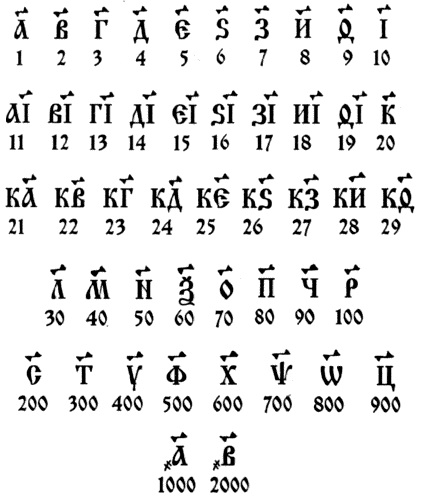
Russian I is И today, so that И, reflecting latin H via greek Η as if was designed to fix the lack of M aftert I?
Why didn't they worry about the lack of Ѳ after E?
Did they only see three lines? A I U? or A I O?
А B Г Д Е Ѕ З
И Ѳ І К Л М Н Ѯ
О П Ч Р С Т
У Ф Х Ѱ Ѡ Ц
сould be the set, with ц in the end, as z

The Palochka or Palotchka (Ӏ ӏ; italics: Ӏ ӏ) (Russian: палочка, tr. palochka, IPA: [ˈpaɫətɕkə], literally "a stick") is a letter in the Cyrillic script. The letter usually has only a capital form, which is also used in lowercase text. The capital form of the palochka often looks like the capital form of the Cyrillic letter soft-dotted I (І і), the capital form of the Latin letter I (I i), and the lowercase form of the Latin letter L (L l). The letter was introduced in the late 1930s.
are Ѡ and Ѽ the same letter? ѠꙌѾѠ҃Ѽ and their minuscule counterparts are all the same letter
In the first cardboard session of the red folder, I came to цвет и свет being cognaties if of claire and couleur.
комната камера капсула все cup in a way, коробка, коробушка, коробушечка, наслоение 子'ds
кибитка коморка каптёрка коммиблок
капсулка должна быть по размеру, только и всего, прямо к телу на расстоянии вытянутой руки.
子 [цы] and it looks like Ц ~ Ч ..Чадо, Child isn't C 🗘? I would draw C with arrows at both ends, which would tell rotation of the letter upsided down, which makes to h which follows it to get Ч.
h is upside down child? high? when you through him to the air? Why would you do it? I saw daddies do it. Because kids like it and there are not many things daddy can do, I would neglet a child, seeing my nefews once a week was tiresome. Thanks dad I don't have to carry that weight anymore.
so somehow ц and z meet as forms of the same 子 which is ko in japan,
с рука в иврите () and look at hand in chinese: 手 looks just like 3 to 2 if 子 is 2 and 子 being c and 手 being
in japanese 子 and 手 are ko and te which is even closer to cd of bcd so now we have to find b in 了, but 了 is ryo in japan (more Ё than R) and lэ in chinese, notice how they're R and L
了 is translated as completed in japanese (ryu is rule, I think they're cognates, I think we should mark all words similar in both meaning and phonetic sides, and only then we should prove or disprove their historic etymology. Here, I brought these arabic numerals and why they're called arabic in europe, very weird indeed. So those ٢ and ٣ look like Ч and Щ,
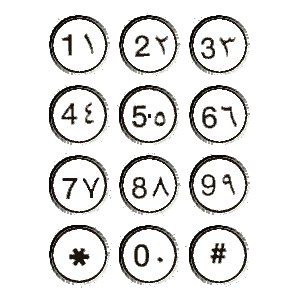
1 is aleph A
4 is ayn E O
5 is hey O E but they look the other way around.
2, 6, 7, 8 look alike
4 looks like 3, as if it is Σ only in this font Σ has 6 strokes.
6 like 7, 2 like 7, 9 like 9 Σ is for ΣΕΧ (ΧΞϚ´ (666))
Modern-day Arab telephone keypad with two forms of Arabic numerals:
Western Arabic numerals on the left and Eastern Arabic numerals on the right

In Chinese numerology, the number is considered to be lucky and is often displayed in shop windows and neon signs.[25][26] In China, 666 can mean "everything goes smoothly" (the number six has the same pronunciation as the character 溜, which means "smooth".[27]
溜 is slike and it sounds like Leo. as it is russian лехок лек легко
and I see カlike 刀 ([tao] knife) in 溜 which make me think of 田 being an o. and that the 厶like element encodes le, so I am looking russian words within chinese hieroglyphs. What can be more hilarious? ridiculous! Why do I allow me these freedomes? To expose them and to tell what is not appropriate science.
But that bestia part made me think of the demonized numbers to be important in the prechristian times.
pentagram gives number
and there is some other famous numerals, but then that region has truly plenty of numerals, as if they were the region where it all began. Is it why mathematicians are good in math in their own unique way
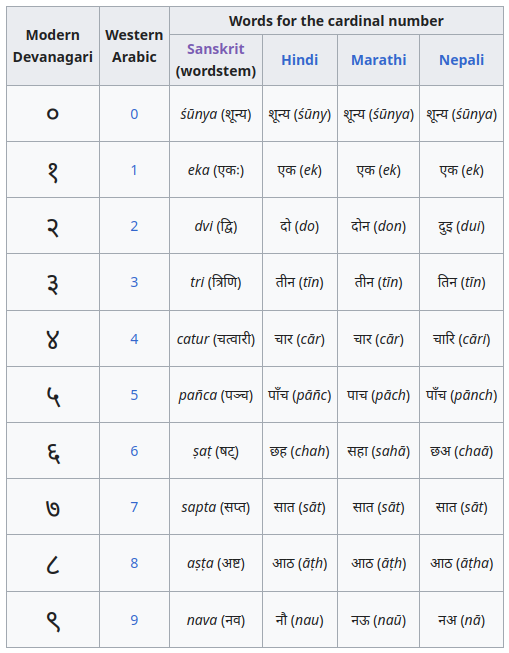
Back to the number of the beast, it gets more interesting:
The earliest extant record of a Protestant writer on this subject is that of Professor Andreas Helwig in 1612. In his work Antichristus Romanus he took fifteen titles in Hebrew, Greek, and Latin and computed their numerical equivalents using the principle of Isopsephy in those languages, arriving at the number 666 mentioned in the Book of Revelation. Out of all these titles, he preferred to single out Vicarius Filii Dei, for the reason that it met "all the conditions which [Cardinal] Bellarmine[13] had thus far demanded."[14]
Helwig's criteria was as follows:[14]
must yield the required number
must agree with the papal order
must not be a vile name applied by enemies, but acceptable to Antichrist himself
must be one of which he can boast.[14]
Helwig suggested that the supposed title was an expansion of the historical title Vicarius Christi, rather than an official title used by the Popes themselves. Additionally, he said nothing about the title appearing on tiaras or mitres. Helwig's interpretation did not become a common one until about the time of the French Revolution.[15]
Catholic apologist Patrick Madrid answers the Protestant claims by claiming that "Vicarius Filii Dei" has never been an official Papal title. He also argues that even if it were a Papal title, that would not be sufficient to associate the Pope with the number of the Beast, as, for example, the name of Ellen Gould White can also be similarly manipulated to get the same number (ELLen GoVLD VVhIte 50+50+5+50+500+5+5+1=666). He answers the claims that "Vicarius Filii Dei" is not written on Papal Tiara by stating that merely looking at any of the more than 20 papal tiaras still in existence—including those in use in 1866 during the reign of Pope Pius IX when Uriah Smith made his claim—plainly shows that not even one of them has any such inscription, nor is there any evidence that any of the earlier papal tiaras destroyed by invading French troops in 1798 had any such inscription either.[10]
Adventists Samuele Bacchiocchi responded to those claims, by pointing out that "interpreting 666 on the basis of the numerical values of the letters of names can give absurd results". He also notes the Donation of Constantine was considered as true to the point "this forged document was used by 10 popes over a period of six centuries to assert, not only their ecclesiastical supremacy over all the churches, but also their political sovereignty over what became known the Papal States, which included most of Italy." He also states the title "Vicarius Filii Dei" was considered as an official title of the pope.[25]
Vicarius Filii Dei (Latin: Vicar or Representative of the Son of God) is a phrase first used in the forged medieval Donation of Constantine to refer to Saint Peter, who is regarded as the first Pope by the Catholic Church.[1]
беседа is a very alphabetic word
Octal numerral system makes sense not only in the way it adds up to 365 (how they used that numeral system as calendar is still beyond me, but it is less than percent chance of that being a coincidence (even if there were three numbers I would hold on to, I hardly know two of this order, and the other one is what it adds up to in decimal (mal because 666) and then 13 or 12 would also catch my attention with their calendaral properties, but then they're the three, 666 has nothing to do with the calendar, and because number could be anywhere from 1 to whatever, 365 is less than one percent a chance that it is not by design. Because such design exists, it was chosen. And because it is not the most consistent one, jumping from 5 to 2 or from 4 to 2. And because IVXLCD adding up to 365 is much more great, jump from 4 to 2 is even more beautiful, isn't it a computer simulation? That means we can cheat. If it is true, maybe the krishnait legend of teleportation (at which I laughed because how such a powerful magician who could teleport a whole guy couldn't teleport the bone pieces to their original locations and had to teleport a guy to new york to his doctor, I called bs, and the friend got offended (it's easier to fool people than to prove them that they were fooled))))
Octal system makes sense in the sense of the periodic table, that tells that whoever invented numerals knew chemistry, let me demonstrate:
1 -
2 =
3 ≡
4 ≣ | _ |
|
_
5 | _
_ |
_
6 | _
| _ |
_
7 = | =
| actually 7 doesn't make sense in the context.. and what the context is that?
_
8 | = |
| _ |
9 doesn't make sense in this context, which also agrees that whoever made those forms worked in octal
what is the context? this is the context:
If this is true, H is 1, He is 2, let's compare and see if any of it makes sense.
1 H
2 He
3 Li
4 Be
5 B
6 C
7 N
8 O
9 F
10 Ne actually, first two orbitals close at 10 electrons. With 8 electrons at the external layer.
What makes sense is if H is K. but K is 18th. or is it not exactly sanskrit, but instead of K it starts with H, Didnt' they know Helium and Lithium and Berilium when they knew Hydrogen, Boron, Carbon? that BC sequence does raise suspicion, and F at that position makes the suspicion stronger..
And I started with shapes of digits, hardly 4 5 6 take 4 5 and 6 lines to build. and 8 is the maximum of that system, but I speculated about 8 consisting of two 4's and indeed 4 can be seen as first bubble. even though this very glyph only three sticks take. I was mesmerized by this. Electronic clock's font caught my imagination as a child.
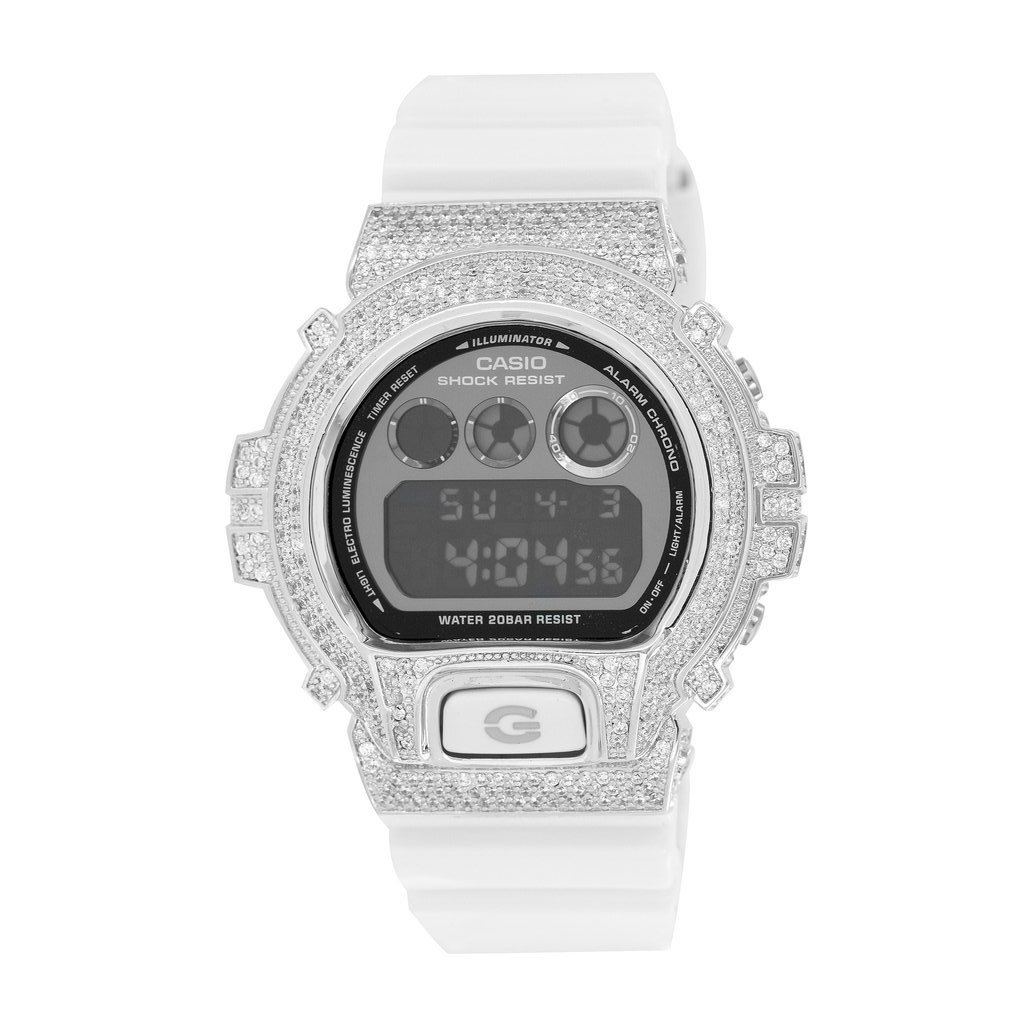
I sorta advertise them, and I do so before they paid me for it, because I enjoyed their old game about a bear with a hammer very much, and I did it for free, so I thank them in this other shape which maybe costs more than it would cost me to buy that game, even if for that I would have to go to moscow or vladivostok to buy them from those who smuggled it in spite of soviet lows.
So, those clock show 456 having 45 and 6 digits in them (digits like in fingers, strokes, separate elements of the screen) 3 has 5 but only because 三 is swashed in europe, those barbarians, have zero understanding of a stroke. I wonder if in chinese clock they show 3 as 三
And no, I didn't find such digital clock, but I found something else in that quest:

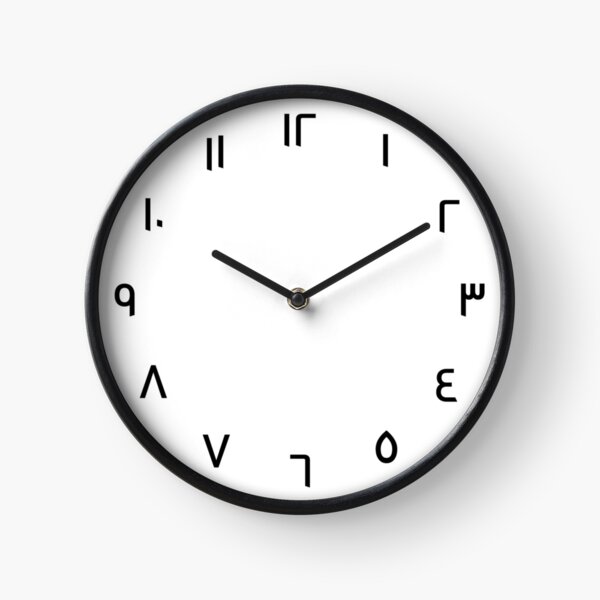
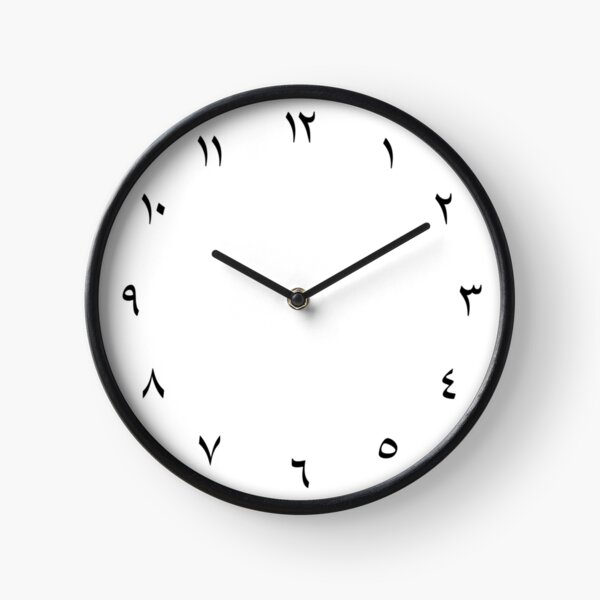
it shows different representations of the arabic numerals, that 2 can reflect 6 and that indeed their four is our 3. I wonder how could it happen, but their bubble is not 4, but 5, and their 6 looks like our 7, and 9 is pretty much the same. Were we the same culture when we invented 1 and 9 and some digits inbetween? 3 and 7, 4 or 5 as 0?
Ч~Г is their 2 and our 4, is it why russians added Б to В? to make Ч the Г 4th?
Г would make sense as 4 if it was г or
1 being .
2 being -
3 being -.
4 being г
but then isn't it a stretch? It is guessing, divination in a way, pondering with our mind or our souls, I feel dumber when I try to think of that as ancient people could think, my understanding of the subject is so much better than the understanding of that subject inside of the model of the ancient people in my mind
and looking at chinese clock I found, we have both modern and traditional numerals.

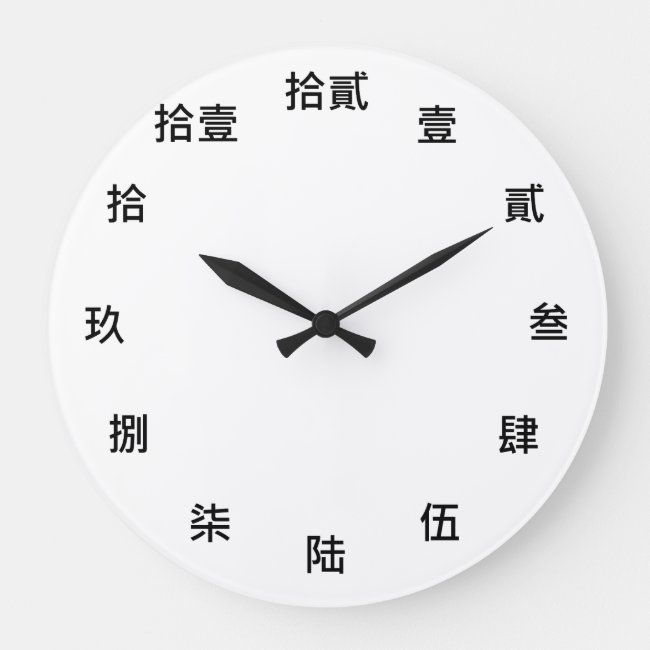
Even though we can see some similarity between forms of 5 to 10, forms of 1 to 4 seem to be completely unrelated
So simplification of kanji is known on many planes, one of which as manyogana containing elements of katakana, thus katakana is probably the simplified hieroglyphs, chinese hieroglyphs characters were simplified more than once, so thus my guess that european alphabets derive from chinese characters is not so off the wall, but then what if katakana was phonetic element ot those chinese characters, wild guess I know, but then hentaigana tells me to go fuck myself:
to my surprise, I miss hiragana'no glyph for wu
but then I have glyphs for all these:
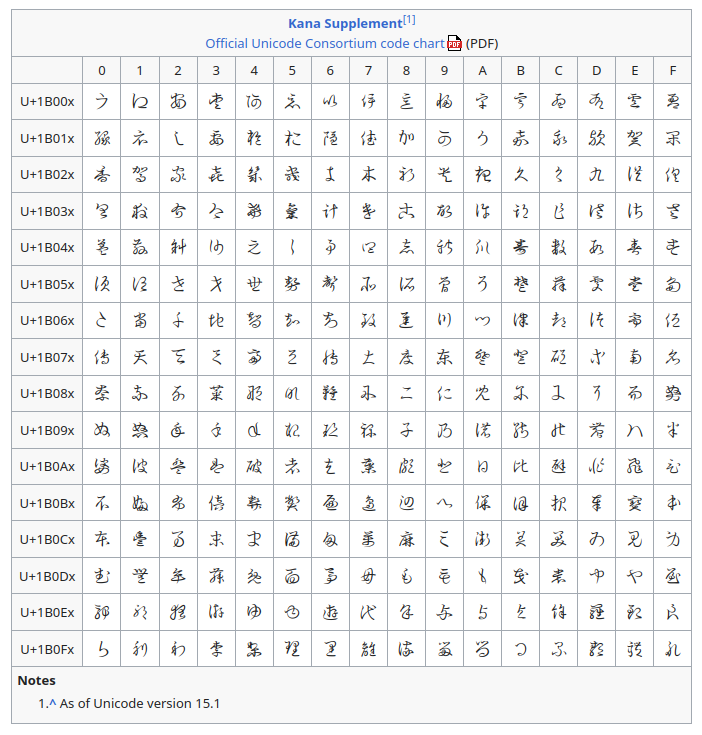
well, sorta, wiki page shows them, but even the same browser doesn't show it if I copypaste them
but click those images, it leads to more marvels, there the elements of the second table are arranged along the first one (but that is so long, that it would be tiresome for me to copypaste it and even online converters failed to convert that page
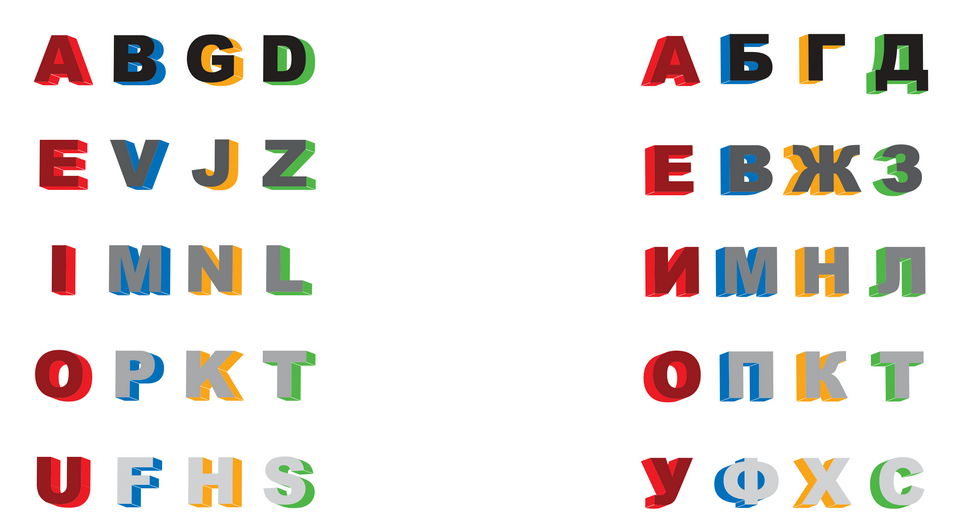
meditating on this image it came to me that most of the letters are different in those positions, but few are universal, and those are M K T (they are always read in english and russian the same, some vowels may be throun into, speaking that we mostly agree on what is the 12345 of the vowels, V is 5, yes, interestibng, but U and Υ and У are three ways to write teh same thing, but we would mistake u for и, and because it is post-t vowel, it is relatively modern, and no wonder, we separated as nations even before bible, and only those few universal letters indicate the similarity of traditions indicating their unity at some turn of our history, when we were scattered and reassambled into different nations)
A E O are the most universal of vowels, even though every nation sing their vowels differently, we share most common understanding of their function and we draw them the same. Unlike germans, they deviate:
It is natural that A E O
in ogham aoe are 1 2 4, as if double o is e, not u, interesting, unless u was и then that и is of e, some extreme, different in different nations, so we separated before we got 5 vowels instead of 3, even before we got 4 vowels before 5. When we separated (english and russian) we god got god gold the brighter the better. You thought we spoke of god? we spoke of gold. Sinagogue is the house where business is made. So money lenders and money changers were there by the right of their god, bu by the law, by the tradition Jesus didn't understand. He lived outside, he brought foreign beliefs, christianity is judaism for goyim, thus they separated the purity of the old law from the influence of heresies, for foreign traditions would naturally be taken for as such.
If C is Ist degree, F (the fa) is fourth (IV)
wise ~ why's (whies, he knows all his why's) whining why
Noel is no eL, no elohim, no ale, no бухале, no elf?
A
B C
D E F
G H I J K
L M N O P Q R (I painted R grey too, because it comes together with L. After no eL comes no JK.
Десять и тысяча больше похожи друг на друга чем цифры обычно сходны:
no proof ~ not a proof (as if a negates t)
A B D
E F Г
O П Т ?
U W V would be the great continuation (two vertical repeats followed by two horizontal repeats)
四 manages to repead different other forms of 4:
The three Fates created the first five vowels of the alphabet and the letters B and T. It screams of a syllabary of
A Ba Ta
E Be Te
I Bi Ti
O Bo To
U Bu Tu and it is 15, the legendary 15 of Then Hermes reduced these sounds to characters, showing wedge shapes because cranes fly in wedge formation and then carried the system from Greece to Egypt*. This was the Pelasgian alphabet, which Cadmus had later brought to Boeotia, then Evander of Arcadia, a Pelasgian, introduced into Italy, where his mother, Carmenta, formed the familiar fifteen characters of the Latin alphabet. and if that previous part, It is said that Palamedes, son of Nauplius invented the remaining eleven consonants. is the later event, then 15+11 is 26, but if it's not 7+11=18, which is also cool.
But that syllabary of 15 screams to be the origin of the alphabet, because of a=1 bi=2 tri=3.. bi, tri, is it i bi ti? But then I know my fantasy is so strong, I could see 345 in 𐤄 𐤅 𐤆 (←) so I should be careful, but this is definitely a hypothesis worth researching.
And then it would demand a numeral system of 15 repeating elements. 9 would be understood and 9 is the same but with three vowels, some
ссора → спора (the word discord becomes the word dispute by rotating one c clockwise)
(не в ссоре, а в споре)

Christopher Josiffe keeps on delivering: Yoruba cowrie shells
he spoke about them in the context of origin of writing, and I looked them up:
Cowrie-shell divination refers to several distinct forms of divination using cowrie shells that are part of the rituals and religious beliefs of certain religions. Though best-documented in West Africa as well as in Afro-American religions, such as Santería, Candomblé, and Umbanda,[1][2][3] cowrie-shell divination has also been recorded in India, East Africa, and other regions.[4]
Several forms of cowrie-shell divination are distributed broadly throughout West Africa.
While there are many variants using from eight to 21 cowrie shells, West African-derived forms most commonly use 16 cowrie shells on a prepared table or on a mat on the ground, interpreting the patterns that result which are known as Odu. Before casting the shells, the priest/priestess invokes and salutes the Orishas, and puts questions to them. The Orishas answer the questions by influencing the way the shells fall on the table.
Ẹẹ́rìndínlógún (from the Yoruba owó mẹ́rìndínlógún "sixteen cowries", literally "four taken from 20") is a cowrie-shell divination method practiced in the Yoruba religion.
The number 16 holds important significance in Yoruba mythology as it was the purported number of original divinities that established life on earth. In merindinlogun divination, the shells are thrown and the number of shells that fall with the opening facing up is associated with a certain odu. This system of divination is used when consulting the Orishas.
gut ~ гад ~ god (the inner сущность)
(when you beg your incestine to shit off the poison or food poisoning, you'll understand)
nadaES ~[naða]
B C D [b g d] беседе
V G Z [v ʒ z] voice? voice as the recognized word makes [g ~ j ~ i] g as the first vowel?
P Q T []
F H S [] voice
is bes in beseda cognate of voice?
басят? бузят? бесятся?
what if it starts with book (a book, but book, and is that a universal? in french it's to. and if it's be do, then do is indeed two, duDU) B C D [b k d] but they say C used to be G. But take it with a grain of salt.
ба га да (богато)
ве же зе
ми ни ли but other lines don't make a coherent text, which I would expect humans to do.
по ко то (unless it is an intentionally meaningless purely phonetic structure)
фу ху су And when they invented it the language was completely different, (and which one?!)
But the legend says of only two consonants: B and T
BA DA
VE ZE
MI NI
PO TO
FU SU
something of the kind. 10 in number would make sense as the basis of a numeral system. But which one?
At this point it is one assumption upon another one. I am a sick individual and it is a crazy thing.
Ʌ They (the a?)
I Me (I ~ Me/Mы)
V Y (Вы ~ You)
идея того, что началось всё от местоимений, что гласные первые это местоимения первого, второго и третьего лица, интересная, но тогда переставить строки местами имеет смысл
I Me/We/Мы Nos/Нас
Vi/Вы You/Your Zie?
A/Это He/She They
в русском не рудимент ли этой структуры в Э Ю Я (Это You Я, E V A это слово даёт порядок iua, which is supposed by the IUA order of the few lines above)
Во всём хочу до самой сути, до самой жути, самого жуття (жития)
быть = жить? жить значит движится как жижа. быть просто put.
суть = бюы быть
Т is demanded m by my poetic suschnost
vbst, it is wondervul division of bt into something like abcd
vbst of Во Быть Суть Т of the previous lines, so thus chaotic random sequence could be given to b me by my so subconsciousness.
(m of my and b of by and so fo co show how mind gives next word before the fir previous is written down done)
My research is more anti-prechristian than anti-christian: I excavate layers of the culture which brought us alphabets, and this culture is even pre-hellenic. And this culture has similar elements with chrisitanity, such as обожение (divinization (apotheosis, deification)) (theosis, deification)

but then of course most modern Christian denominations do not interpret the doctrine as implying an overcoming of a fundamental ontological difference between God and humanity but then it tells that some of them still do, and in that they are closer to the heathen mystical practice of becoming the god. Walking the god's ways. Being a hand of god. Believing that. The question is not whether it is true or not. After all gods certainly exist in our heads, so why wouldn't our ego give way to that ganghlia (ganghlion is the singular, but if I want to keep foreign grammar, I should also apply their cases to that ending, but I cannot, so nevyobyvacsf
Technically belief is a form of schizophrenia, which is classical follie a deux considering how the founders of the religion had visions and heard commands. By modern standards you know what we'd say. But then mild form of it happens everytime we meet someone: we create a partition on our brains for them, and there we keep on growing the copy of that person's singularity personality, but we are not likely to grow it so big that it can take over, and why would we give him, but god, that is something different. Actually, according to Magich History Theory Practice divinization is the essence of magick
And see what those niggers above did:
Theosis is the word. Theostasis? sis as happy middle between is and суть?
If ЭЮЯ is EVA, then ADM is the first half of the protoalphabet
in the contexrt of ABEIOTU I come up with
ADMEUA is it the ring? Is it why я was аз? was it a-z? was it i-a?
ADEMIUA? ADEMIOU?
I excavate root of the alphabet, something much more simpler structurally, it should be laying in plain site sight as abacadaba
ABCDBA
AVETBO? AVETBA? ABCDBA! The western and eastern sequences in one spell.
ABCDBA = ABCD + CDBA
CDBA is судьба
ABCD обещать
a беседа? а as a baroque вензеля
Абсуди
её жизу (жизнь~жизу напоминает ν~v)
и коли ман
о прост о п рост (упростил? решил проблему её жизы)
уф ах це чаше ещё
да, с обоих сторон, ты сама тоже чаще скачи
Её Жз это потрясающе, эта великая мудрость правило съёма
И КооЛ МаН
Оп РсТ (up растёт)
Уф ХоЧу еЩё
Обсуди Беседа ис зы уорд ин зыс контекст, соу б из зы фёст лэтта
её жизу
и колом на
И МаКаЛ (слишком graphic? was that the )
ⱆ писю ту
Изначально это было советом съёма, продолжение рода величайгший секрет.
кто бы мог подумать, что русский явит эти секреты, самый оболганный народ, in the centre of it all, naturally we knew alphabet since some 500 BC, at least the most wise of russians. If it was in use in europe for centuries before that, and widely used. Naturally merchants and travellers would bring those secret teachings. So what if all of what they say is not true? They base their speculation upon archaeology. The archaeology infamous for forgeries? The methods of dating wide audience is offered only to take on faith, for I lurk around that field and still only have superficial
О ПиСя Ты
UVW XYZ (365 excusez)
o bae
BeCeDa is it only in russian, or there are cognates elsewhere? беседер is completely different word, it is a work for ai, I am not even a polygloth.
Chomsky is such a fraud, he uses the most tiresome voice so you're discouraged to argue him, for you don't want to hear him speak more.
Devil Does evil, and if you do good, you do well. богат от слова бог (от бога, как дар от бога, позволяющий больше зарабатывать производя лучший продукт)
Elevate is of lift they're doublets LVT read differently, naturally it could and would be the case.
Be GooD? Be Do? Be Duh?
Be Fly Get High I Make Lv Not Wr
Be Fly Get HIgh Make Lv Not Wr
the pangrams of mine are top-notch, but what's the use of them? Poetry is a service to muses? I didn't feel like I serve to them, or that they serve to me, I felt that they helped me because they liked this activity. And thus service is a lower understanding, like причинно-следственная скукота. Всё краше.
Here, some chart of first associations
A
Be
C (if you saw it or if you not)
Die
E
Fa~F Four~For
Go Get Give Good
Hi High Ho Hot Horse Carries
I
Je
Key Know Knit Knot
Love Lie Lust Lost Leave Live Life Like Long Linger
Me My Mine Mama
Not No Need Next
On Off Of Out Our
Pay Play (Pay~Buy)
Rock Roll Round Road Ring
See Sea C Set/Get So Si Say Speak Spell Spark Spend Send Stay
To Two Too Take Took Thank Think
Ты probably was the pronound before they invented ϒou und Zie. They as plural form of Thee?
Such R-ness of ciRcle-related lexics raises question of a writing system more closely related to tifinagh in early history of europe:

This particular order is obviously relative to latin alphabet and such, but wha..
it definitely had some complicated history from the moment of separation from it:
it may tell of labiality or R, as if it was a farting sound, as if очко is маленькое око,
которое однокоренно слову около (у кола? (и у хуя и место укола))
future ~ ſuture
Ought?
Would
Could
Should
They clame claim there are also Bould Gould Mould Vould Hould Nould, I know neighte neither none
Owe
Will
Can
Shall
Would
Could
Should follow directly B C D of paleohispanic syllabary, so thus could be the mold, or mould.
Mould is brittish spelling of mold. Some silly sophistication, I assume, because why would it be amongst those modal monsters.
Would and Could are about past, Should is about future. And I can see who how Would can be about the present. I would do it, is I would do it now.
Could Would Should are aligned on time line like this, but is it isn't even eastern order.
It is justr a an english curiosity. And I collect curiosities, for the structural elements are amongst them.
And naturally every large language grow from the protolanguage influenced by the structures I study.
Is academia of accadia? is it a before CDM odr order?
рот и рог raise the question of whether Т is double, and thus female form of Г (ro is for round, ⵔo)
samite (парча)
semite (пархат)
(I doubt these are not a coincidencely similar)
Результат — интеграл усилий. А потому платить по мере усилия в процессе работы несправедливо, потому что это не учитывает усилий, приложенных для достижения более высокого навыка, и позволяющего добиться лучшего результата.
А потому справедливая оплата труда должна рассчитываться из результата, а не усилий и себестоимости: более крутые вещи должны стоить доложе
дороже доложи (до~more? до~to! to~too? too~more and I see in that pair тm being тm)
ложи́~клади́ (клад положен)
k as a click later abnolished?
but existence of that k makes me hear kl as click (compare with lick) of a tongue, as horse цокает
click~lick, both are made with nog tongue lingua lick saliva со линга (с конца выделения тоже слюной называли? слюни~сопли? нос пля? люня рот? лютня? пуля:?
At first I was like oh wow, they don't care about the phonettic matter at all,
but then I was like oh, okay, I can see what they see, d~c is that deep, and if длать~кhand длань~

but then כף is a tablespoon, not hand, which is yad, and thus could be the perfect d, considering how berbers name the letter ⴷ, literally yad( יָד) And because hand usually picks thing from below, I can see how they drew hand as ⴷ[d]
And and but are like a and b (and it makes me love the and.. but.. construction very much)
are those short words alphabetic. Let's assign and to be the semantic part of a, and but to be such of b,
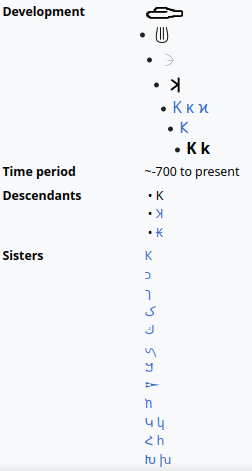
That is very nice of them to colloect these sister shapes, but I was hoping to find them there
them ~ there
him ~ here
Now I must keep that kn as lingual click somewhere,
and the meanings of other components of kn-words,
for they probably reveal the meaning behind other morphemes
as I did, copypasting that chapter into abcdefghijklmnopqrstuvwxyz and seeing what I could take of it.
and the further question:
показывал ~ показал что значит ыва? было. показал is short and feels more like "just now" in comparios
comparison to показывал, which feels like something having been happening in some further past
бывал~был
бивал~бил so the suffix is not ыва but ва, which is probably the same wa of was.
пивал~пил
but бывать и быть оба в неастоящем времени, so wa ва is probably вообще, but no-ва is in a moment
т настоящее время
л прошедшее время
(будущее в русском при помощи приставки образуется. можно использовать суффикс прошедшего времени с приставкой будущего? получится перфект тегнс:
бьёт настоящвремя
убьёт будущвремя
убить может быть императивом, который нередко формой будущего времени выражается
убил ~ bad will? сравни с угодил!
укусил ~ will of кусь? will~был? will~вёл! велел! but then that extra л is д in english, or т, or n
усмирил ~ смирны will (will stay smirny)
был и быть напоминают will & wit
бил = 'бил (краткая форма слова убил? ведь у такой частый суффикс, и теперь я узрел, что он когната суффикса 've в английском перфекте.
вёл = краткая форма слова увёл? или вёл это тот самый will и есть, и тогда могут быть особые
сбил ~ избил? потому что другим 's является is
спал и проспал отличаются наличием приставки у формы подобной перфекту
русское слово кнут: щёлкает, и начинается с kn
но не knot, но кнут плетёный же, так что скорей всего когната слова knot. Возможно верёвки плели в первую очередь чтоб скотину щелкать? Как я этимологизировал knot? haha, I didn't, I just linked t to to. And if knot is knut, then it explains kn, but not t. To, to send the animal in the needed direction by whipping it from the other side, or, rather, not whipping, hitting it with a whip. once maybe
БВ СТ is acturally how B T go on placing fricative form of Б after Б and fricative form of T before T, thus keeping B and T Beginning and enT
Be G и on
Was G N the division of D tht the T?
BeGиН is the first two (or three if the H is N, as it is in the beginning of the line) lines
END is ENT if it is also alphabetic, and then ..I don't remember what. Maybe that T is the last letter, which is symbolic. As in russian КоНеЦ: alphabetic, from the second half and on,
но слово начало в эти игры не играет. почин~begin, but почин also looks more like почил. починил.
БВ СТ also reminds BCD and БВГД
If I had ai able to find all manuscripts beginning with 𓃀, we could find some abecedary.
Or we could ask it find all texts without logographs or with the least ammount of those.
Победить ~ попятить (ахилесова пята ~ бяда)
ABC is all there was, and maybe even B and T was all there was. But let's begin with BCD as three points of articulation:
Thus палка~битка (маленькая бита, да и ка в палка является уменьшительно-ласкательным суффиксом) булка~палка? но ведь нас не смущает выражение палка колбасы.
будка ~ палка? бить~будить? когда будят бьют? будка означает собаку, собака будит лаем при появлении воров? будка~barker? it is a very raw approach, but I suspect it to be the most powerful approach of them all. Recomprehending all the lexical corpus in the sense of just two consonants. Uъ!
Apollo is an alphabetic name, but because his priests are caught reforming alphabet, they couldn't be in the beginning of it. Their ancestors could be, hence the alphabetic name. But it depends on who you call ancestors. My guess is A P L were the new flashy letters, П & Л? L & П, they;'re not too far apart. Could that be A P L O? A P O L L O are four new letters? Were they using eiu gamut before Apollo? Apollo is famous for being a masterful musician, and all a p o and l sound good, unlike some щ or ц
уфхц is directly voiceless fricative abcd, so russian was not brought from greece: greek order is ΥΦΧΨΩ which is further from abcd, though αβγδ is closert to the abgd the abcd used to be.
γδ are two ways (even and excentric) to write the same loop g is both g and д
And the bd symmetry tells us that they were бg and that is why handwriting is cursive, as if it curses.
ive is more archaic form of suffix ing? suggestive is suggesting, passive is passing, massive is massing
APOL? APPLE! ALMA? ALPA?
APPLEon Napoleon? Snake Myth In Bible? Brits?
で (in) deFR [de]
(it links of and во, but I thought оf is от. of is the opposite of во, just as от is the opposite of до)
он ~ in (він)
она ~ на
sex matters in sex: він is in (in her)
вона is на (на нём)
ё is in female pronoun in english and in male pronoun of russian (на нём, но на ней, но есть и другие местоимения: её, но его)
в in вин is вав, because in russian this word is он (but в looks like B and not V, btu then it is what russian v lool looks like
is ב the ו? they are one avoe above the other, they ew well may be
Looking at how в looks like кулак, but it's probably 𓃀
Suddenly I realized that they used skin of larger humans to do their close, so skin of legs was not only pants, but boots probably the first.
if B and T are all there were in the beginning, the бg and seeing that bad goes down and good goes up in this representation is written counterclockwise, because luck doesn't play a role here, that it is a struggle, and good overcomes, which is great (life is complex, and good is always overcomes somewhere, and that is where attention should be aimed at) It also predicts the return process inevitable in the future, so maybe some measures should be taken to leave a pillow at that spot to soften the impact of the future decline in that area. And when you can see that the darkest hour is before the sunrise: when they all aligned at the bad moment, they're going to turn good almost at once. And that will be the golden time. Isn't it just a speculation? Surely it is.
if B and T are all there were in the beginngin, mother and father were both Bother. оба родителя
Tittet (sister)
Bto-ttet
Ti-ttet
interesting, why would brother have labial b and sister had all linguals? sis is tit is a good find from today's red folder's улов haul
hold is hauled
I suspedft suspect the manner I acqur cqu c acquired, to jump from left to right, is what keeps this html from lagging: the div's are short, I don't pull the same div all the page through.
Челябинск Челубейск *(Челом бьёт? Человеков убивает? Человек? (другеи жевотныи челом царю бить не умеют)*)
talk ~ tatt ~ chat!
шоканутый (шуганутый)
шокануть (шугануть)
aloof ~ sall off
A B C
A B D
Bi Di (be and die)
Be De (sheep and devil)
Ba Da (Ma and Da)
Bo Do (My and Thy)
Bu Do (boo and do)
It was my first associations just after I got high first for four day.
Good morning, sunshine, I didn't touch you for those very four days, I practiced for 10.5 pages in the fidfths the firs... argh fifth the third the last of the rhythm of big city. You can examine it and fine df fine find it rather shallow.
I'm s s s a human, I am supposed to behave like this. I am supposed o to misp e have (haive? hive!)
My poor po rp pronouncian pronuns pronunciation show s in text, hypertrophized enormously.
's in english verbs are probably 'ся in russian.
You pronounce pronouns (and I didn't expect it to be the exact homonyms)
You verbalize verbs
You ma a name m m names.
My subconsciousneess seems to tell itself I as I offered it to.
But can I go autoamatic in that subconscious manner?
jлубщцрукщжыубю
I like луб and рук but what is the other chaos. Maybe that , chaos, noise.
I repeated уб
let's try anotherr line:
iels./уцушщьтавдэывлуждоузы
yells seems to be appearing in the beginning of both lines. many e у's but no уб's
This time I aske d my mind not to intervene by pushing it, and as a result nio mind , not a single word like рук... maybe I typed in wrong layout?
Both times I jumped from lating for yell ttioo russian layout, caps was in my reach, but both times I typed in the sayme manner. around yell.
ke,owhero;se,. is лубщцрукщжыубю written in lantin layout, but I like луб рук more.
шуды is iels ю\
///// is in english layout, russians have to push shit at their \
so iels./ is шудыю. шудрою, very funny. судиёю is another reading, and I suspect jews to be considered shudras in india, also because they consider all foreigners leessss than shudras, so I read
eweiomnfdl'sdke;loeps is уцушщьтавдэывлуждоузы in latin layout. And it is obvious that both chaotic atutomatic layouts are chaotic. So рук is nice, as if subconsicious managed to express enough message, to tell, hands thake over, I am not doint ghtat. And maybe it is good, it is a peaceful mode, I like it, well try to deliver the godd attitude too. godd is good.
well =we'll (I can easily see a spell understood by both readings)
we;ll ~ валим, делаем. в~д? what a word world wout would that be.
валим ~ будем, эту мысль я хотл записать ан е ту.
Но раз мысль была осмывсленней в первый раз, давай тот уровень абстаракции попробуем, который от наз ждли в начаел, не тот котороый я изменил.
валдыулвбдыцэду much better
влдцюубчшшаолудф and once again two lines is too beaucoup
dklw.e,xiiajkela and once again the other layout dalso doesn't make sense.
And валдыулвбдыцэду id is fgkldrkf,lde'lr
also makes sense: fag, kill der kopf, ldeotr but is that cahaos reinterpreted by me or are they annoyance of the subconsciousnesss? I fetl bad above navel. saaAss if new placenta wants tgo grow, but actually I must drink. !!!!!
And I am terribly sorry. I will make automatic writing no more. Please forgeive me and let's communicate more or rather less, if taht what you wanted to say. I can see that you woulnd't want synapses between unrelated areas. So I pulled my body on a п-like wall I built, onlty that п has no corners, so it is more n than n. for both sidea sr are round. So I layed on that wall of about a metre high and pulled my sides apart tenderly by rolling by backl over (for my connection felt in the belly, not the back, so I pulled it in the belly,. and now my bact tell mes to to goo tooooo (and iI layed with my belly on that wall, and I mostly felt something not natsty actually, it was quite nice in the lower part of the back, around the seating part, buit I thought of it as of my reproductive organs.
Wom Sometimes I
woman ~ самка (w ~ ш ~ Σ ~ Ϲ) so because it would be weird to connect an and ка into some ing, I suspect an in man to be plural suffixs, and the ka ~ c[k] ~ с[s]
but sumki samki is plural, not samka.
Самка таскала сумку, а белый рыцарь её защищал (щитом, и если надго, мечом. потому и герб был на щите, чтоб знал на кого полез, но можно и мечом)
мужик ~ мечник
муж ~ меч
муж ~ мощь
man ~ might
ght ~ n? no:
laughter ~ launer? laude.. but not exactly, lauder is to praise. laud is english word of latin probably origin.
lachenNL rireFR смеятьсяRU
ch, not un, ch is much close
female is nowhere near purse or .. but puss is not far from purse. bag, hag. Man, самки сумки. сучки. течки. случки.
chainmail. I think I thought of that females were chainmail, or maybe not in these wording. Wait a sec..
the direct quote from vol.25:
So did I get dumber or what. Honestly I s.. drank few shots of cognac to cure myself. I think I should keep on d.. smoking, for drinking is too hard on my. on me.
nio, not Hennesy
Go to do something. Drunk. Not drunk, but yes I did put alcohol into my tea.
The next morning:
There's a hole in the soul that was filled with dope, and we're feeling fine!
(thinking of how I must smoke for otherwise I allow me to drink alcohol, how my brother has to drink alcohol to substitute heroin addiction, as I smoked salvia those 18 months I didn't smoke weed to help my brother overcome his addiction (we made a bet that weed is not a drug, because it doesn't have addiction, so his pride, I guess, made him not to be the worst faggot in the family he probably thought I was and here I am a krasavchik and I started finishing the concrete box they sell as apartments.
box ~ boocks? my guess is boocs show rolls, so.. did those rolls lay in boxes? )
Look how vowels make the picture with hole in the deepest point, and soul is not far, soul is deep. Yes, a rabbithole for sure as they say today after a writer, we know some woords originating in authors, robots Karel Čapek himself did not coin the word. He wrote a short letter in reference to an etymology in the Oxford English Dictionary in which he named his brother, the painter and writer Josef Čapek, as its actual originator.[6] and rabbithole rabbit + hole. Extended senses reference Alice's Adventures in Wonderland, where Alice travels down a rabbit hole into a bizarre world.
while there's, a, the and that are neutral as a middle point, as a æ
And æ does look like those halves of ࿊ and doesn't expect reincarnations, it goes clockwise to go out counterclockwise: you go up the kill hill to go down the hill. wwe it eat only to be eaten?
see от слова ctqxf сейчс сейчас (что ты видишь, сейчас (помнишь прошлое) видеть можно и будущее, представлять, воображать, соображать, образ будущего)
образ будущего, 654 000 results
образ прошлого, 24 900 results
образ настоящего, 60 300 results
So probably this is how predictive model of gpt works: by predicting what word comes next they build the model of reality we humans use, so they are technically human. by culture, as negros are considered humans evern when theuy have very littel of what we consider whoman culture.
is human and woman different readings of the same whoman into heman and шиман
(different readings of h? w is female reading ш is female reading. Гребень! Гребень как индигатив женщиныюю
Ш I think I found new way to mark typos: make some meore obvious typo atfter that.
Ш (she, shi, шить.. я помню русское шить похоже что происходит от китайского или японского ши, нить или шить ли)
线[Xiàn(ще̃)]CH нитка (thread)
线=線 (one is modern, the other is traditional. Japanese only know 線)
線[せん(сен)]JA нитка (thread)
With time, by some cosmic irony, chinese will look as if it derives from japanese, which I think is true.
So, back to that line, That Was Filled With Dope. Dope is deep, Filled is to the top. With is of that top feeling, wile while alone is down. See how vowels colour the langhuage!
gh is dirty to russian and to european in general year.
fine is higher thatn deep? higher than feel? deep as a feeling, why are they so high in vowels? So at least sometimes this roule doesn't work, but it can be used as.. or does it always work? feel fine, be high
deep.. does it have low p? is a deep person is an advantage, thus it is good to be deep. deep pond is better than shallow лужа puddle (can you believe it, I never knew this workd. I think higher. I don't think of shit, it is good, but funny that shit is also fo of high i (was it a sacreligious word? was it shoot? shoot makes sense. холостой и боевой (как обезьяны кидались говном до создания культуры?!!!)))
до создани языка не было кульутры выше той что у зверья
I think it's normal to readuce shit to shut. Означало это слово прохудившийся мешок? Т.о. shut (заткни) означало shit (сыпется (зерно сыпется, мешок сыпет))
заткнул, закту заткнут, заткну, затыкаю тоже shut
Суффиксы прилипшие местоимения и прочие слова. Префиксы тоже. От простогог к сложному.
и этот префикс за неизменный гооврит что shut это зат (зад is shit (как магазин продающий мясо называется мясо (в совке так называлось всё хлеб, молоко, соки-воды по they-live-ian они-живут-ски)))
молоко и мясо всегда в отдельных магазинах продавались.
кошегно
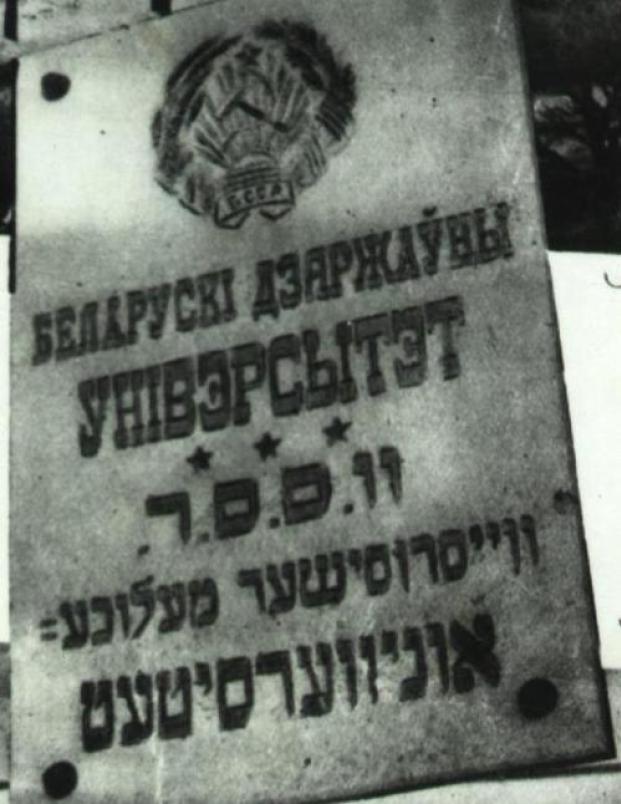
(Belarus is a special case, modern condition of it may say that it was the centre of soviet experiment, but milk and meat was sold separately in all the soviet union, maybe except some village shops, but then why would they sell milk in villages, they had only one shop, so I didn't live in soviet village, so cannot remember how it was there, if they sold milk and meat there or not. I suspect you couldn't buy meat in village shop in soviet times. But I am biased and maybe I will explore this question asking some old village peopl)
The final word is universitet, the first word is ווייסרוסישער (weiss russishar, it's yiddish, mostly deutsch)
white and wise are the same (or similar) word on many levels (in different languages)
in english wise and german weis Weiß (Weiße) for one.
In german wise is weise, so whether there is one or two s's tells if that is white or wise. s double t!!!
א in the beginnign of universitet is telling that ו is vowel. Yiddish being closer to the live tradition has more realistic take on vowels:
and where I found it had more:
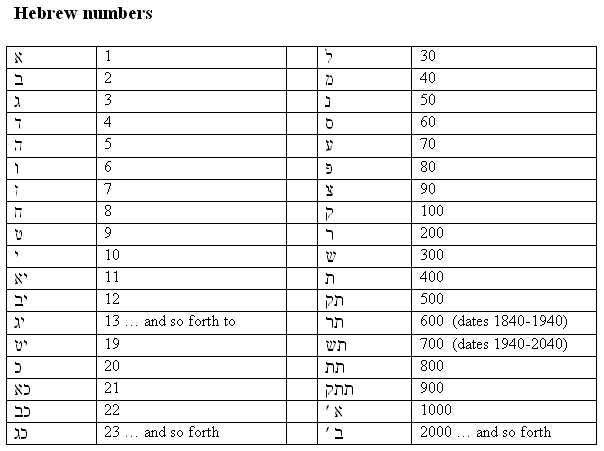
so sofits were not used for numerals, they show how they could make bigger numbers with less letters.
four being the maximal singular numeral in hundreds (hundreds show combinatorial approach) reminds me of 4 being the V in the protoroman numeral system, of IVXLCD adding up to 365
was it taken as the year goes in spiral by 5 degrees higher each time? that would explain the leap luft
(люфт зазор в русском языке, но воздух и ветер в немецком,
откуда видимо позаимствовали из контекста неверно переведя,
вот тебе и пример семантического шифта, дрифта, люфта)

Belarus is maximum wtf:
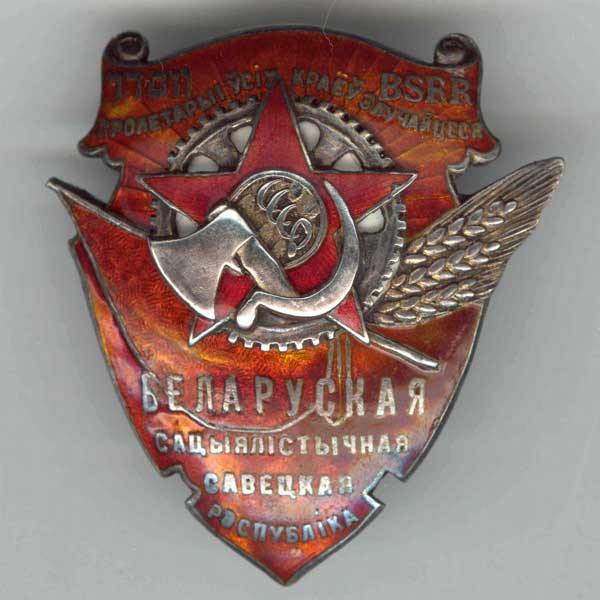
BSRR is Białoruskiej Socjalistycznej Republiki Radzieckiej (belorussian socialist republic soviet republic)
на еврейском вайсруссландише социалистише ратнрепублике (ратн как ратный подвиг? это еврейское словцо?)
в Беларуси в 1920-30-е годы (вплоть до 1936) было четыре (!) государственных языка. В освобожденном от польской оккупации Минске 31 июля 1920 г. принимается Декларация о провозглашении независимости Советской Социалистической Республики Белоруссия (с декабря 1922 г. - БССР). В Декларации регламентировалось равноправие четырех государственных языков в БССР - белорусского, русского, польского и еврейского (идиш).
Хотя на гербе четыре языка, в качестве государственных использовались лишь два, на которых все и печаталось - идиш и белорусский.
в Белорусской СССР до 1937 года, наравне с белорусским, государственным языком был идиш
and I didn't find shi for шить or нить, which is very strange. I think I mentioned it to be the case, but it was what, was it?
those two words robot and rabbithole are so similar! is it soem rob time?
what other words are so recent we still remember who invwented them?
Did I mention that arrow could be derived from a fallen branch of a fir or some other tree, mostly they all growwith branches at that angle or at least they all grow in an angle looking this way.
And I knewq I was right: - конец сломанной ветки (в месте перемещения), как правило, направлен в сторону противоположную движению
I knew it because of how ↑ looks, how ᛏ and especially ᛦ look. Both are the opposite of ᛘ and ᛉ
But if ᛘ and ᛉ show a man's body. I think some prominent figure in runology, I think von List, identified runes with body's postures, I think I even mirror it in this thing, but this thing became so big, I cannot tell what is what when I do not work with it at the moment or at all.
Удивительно что искусственная кожа и курение вошли в женскую моду одновременно.
Курение словно было psy-op of leather makers.
Fake leather doesn't worsen in rain, but it fears fire much more than natural leather.
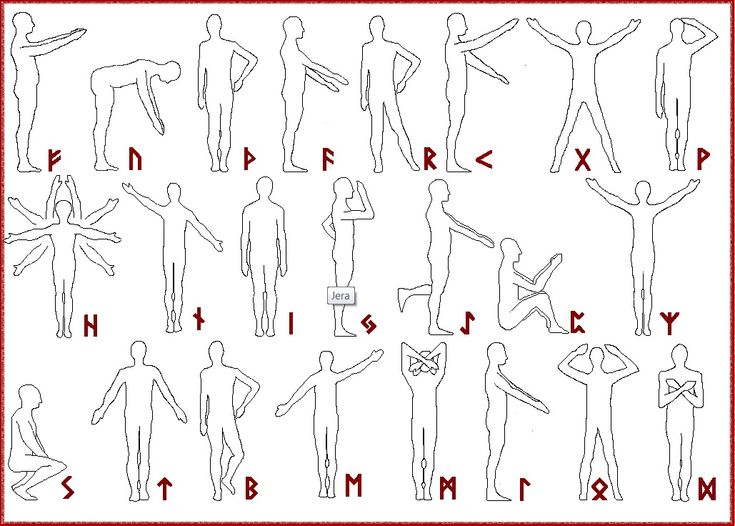

and then some other point of view:
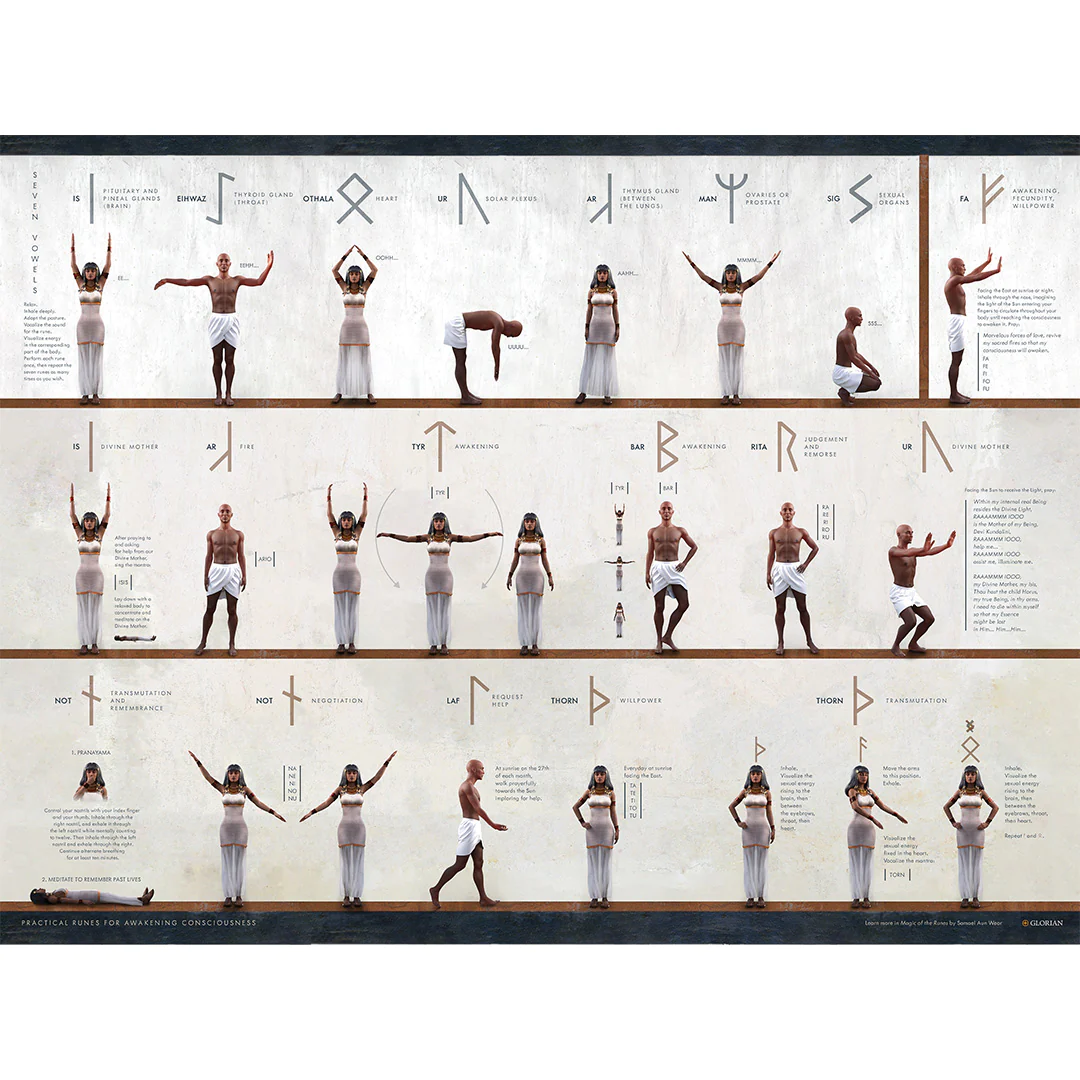
I don't know why they're in egyptian costumes, and they sell this image so I cannot bother to pay them even eight bucks, because I don't pay to those who give them in better availability. This one I can barely read, I need some good ai to read it, it's beyond my ..connect your ?mouth? with your index finger and your thumb, but the rest is beyond me. The larger letters I can read. Good enough, others don't give that at all, and the shapes, the three images all agree or disagree about how runes are shown with the body. Whethere (WereThere?) there were several traditions (see gesture language of the deaf)
Interesting, all three agree on ᛋ, which makes it clear, that S is not only aSs but Sit as well. Stay. St
I give equal hommage of hyperlink to all of them. The image providers they are.
Interesting how the third image gives different poses for the same runes. And they have 15 runes and in very peculiar order.
ieoua they go. I know this order. They definitely know something, and egyptian costumes could be a decoy. и blende сф camouflage
M and S follow the vowels.
Three aettir they know. What is the F in there? It is separated by a vertical bar. Is in in the other aet?
Some more images to close it for today
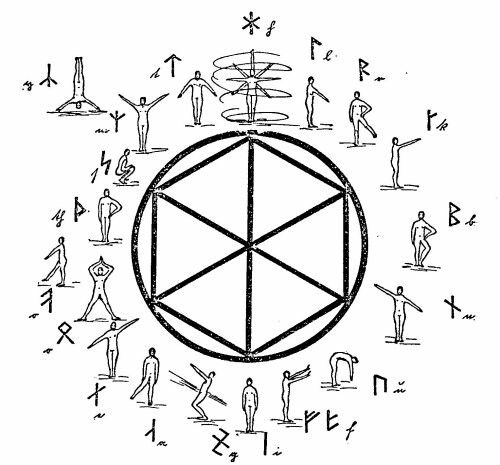
and hand gestures next to them the ones above and below are of von List, which you can see by that Z
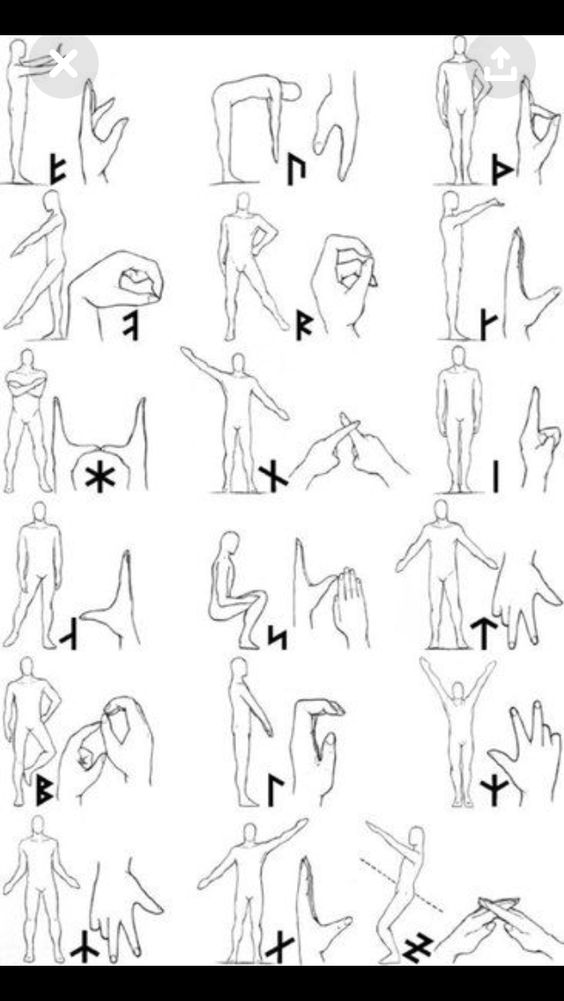
and more hand gestures:

This image mostly agrees with the one above it, but only mostly, some gestures are different,
so whether there are different traditions, or they all make this stuff up, but because most of shapes agree, see the ᛚ, for example, I suspect a tradition in this. even multiple of or a complex one.
Looking for those shapes I found something else:

If it is legit I have no idea, but it has some new ideas. Two aettirs of icelandic runes, some shapes unknown to me, So what I recognize as ᛍ reminds me of Ⱄ and the idea of some connection between norsk runes and glagolitic script should have come to me sooner, copnsdisdering the geographic proximity and that Ⰰ often doesn't have such long sleeves and then it looks pretty much like ᚐ the ᛆ
Ⰰ ᛆ (ᛦ? ᛣ? (A~Я~R?))
ᛒ Ⰲ
ᚦ Ⰴ If these two are true, then glagolitic text was in lines and runes went in columns from top to bottom, but I think runes went from bottom up. Then they were looking the other way. Or maybe not, Now I can see that I should look at runes otherwise: the belly of ᚦ is the belly of Ⰴ (you should you use sc square not square but ru round font to see that the belly of Ⰴ is upwards, thus.. runes going from bottom up would look like glagolitic going from right to left, which is not supposed to be so, glagolitic is known to onl ygo left to right.
eh, complicated, but good idea to compare the two. But the other further attempt only rarely delivered, such as Ⱁ trminf reminding ᚮ, not they're not the same system the
ᚠᚡᚢᚣᚤᚥᚦᚧᚨᚩᚪᚫᚬᚭᚮᚯᚰᚱᚲᚳᚴᚵᚶᚷᚸᚹᚺᚻᚼᚽᚾᚿᛀᛁᛂᛃᛄᛅᛆᛇᛈᛉᛊᛋᛌᛍᛎᛏᛐᛑᛒᛓᛔᛕᛖᛗᛘᛙᛚᛛᛜᛝᛞᛟᛠᛡᛢᛣᛤᛥᛦᛧᛨᛩᛪ᛫᛬᛭ᛮᛯᛰᛱᛲᛳᛴᛵᛶᛷᛸ
and
ⰀⰁⰂⰃⰄⰅⰆⰇⰈⰉⰊⰋⰌⰍⰎⰏⰐⰑⰒⰓⰔⰕⰖⰗⰘⰙⰚⰛⰜⰝⰞⰟⰠⰡⰢⰣⰤⰥⰦⰧⰨⰩⰪⰫⰬⰭⰮ
ᛦ finishes what they call younger futhark, but not in what they call older futhark
But how dare I use as a scientific source something that containse dwarf runes!
Some powerful information on runic magic in russian:
http://web.archive.org/web/20150609003924/http://www.sait-o-runah.ru/katalog-run-runa-fexu/
The girl writes well and she seems to know what she is talking about.
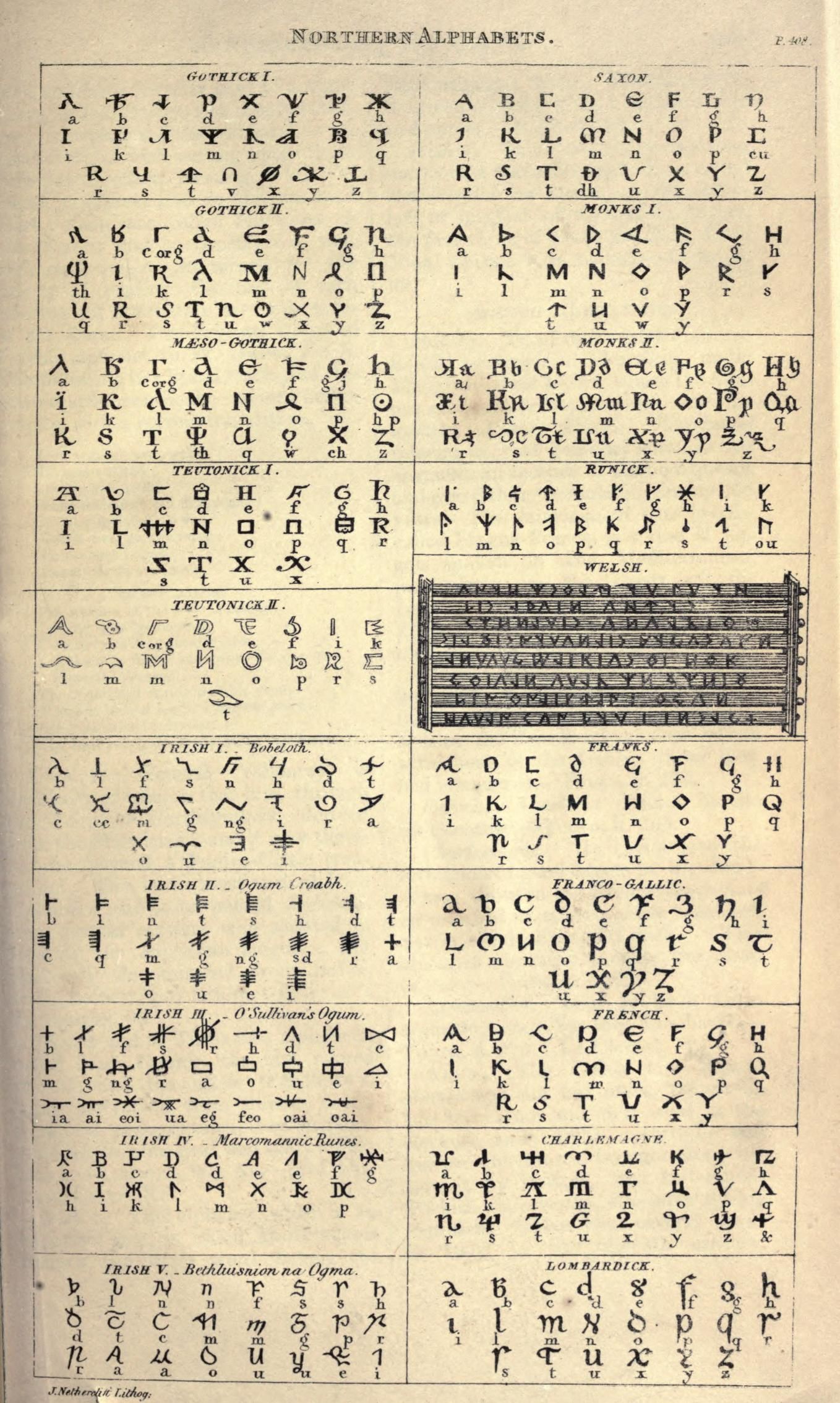
classical and mediaeval : Fosbroke, Thomas Dudley, 1770-1842
and some words it uses are quite legit, because they deliver some valid finds:
The Irish language (Gaelic) is also called Gaoileag, Gaoidhleag and Goidhealg. Its alphabet of 18 letters is Aibghitir, Aibidil, Aibchitir or Abchitir. Older alphabets had the letters in a different order, and those were called Beith-Luis-Nion (for b l n), Bobeloth (for b l) and Bobelloth.
I know this rabbithole must have its limit, but it feels like this rabbithole is never gonna end.
fun ~ fucking (probably fun is as much an euphemism of fuck as funk is)
I just woke up with a vision of a card game being played with letters instead of cards. Which makes me wonder if the 2 3 4 5 6 7 8 9 10 J D K A were the letters. And if those 13 the dirty dozen of some previous epoch.
Cognatism of the basal lexics of Latin and Russian make me ask if slavic languages are actually roman.
All those mini, tibi, and especially grammatic coherence of est and sunt (есть и суть) and even ego is io which is not far from Ѧ the Я
(yes, language families are false concept, because languages are not branches but clouds, but it doesn't mean I cannot theorize within that false concept, because it is naturally only partially false)
well, those two are pure ideas of an early morning, to keep them coming I have to get high.
360 has 24 divisors: 1 2 3 4 5 6 8 9 10 12 15 18 20 24 30 36 40 45 60 72 90 120 180 360
I wonder if it is somehow linked to 24 hours
100 has 9 divisors: 1 2 4 5 10 20 25 50 100 (and this time I wonder a little less, but is it?)
60 has 12 divisors: 1 2 3 4 5 6 10 12 15 20 30 60
The video from which I took this numbers speculates that 60 is 12 knuckles times 5 fingers.
рідкий ~ жидкий (another example of R being Ж)
рідина ~ жидкость (не родина! потрясающий язык)
A K D J remind me of the eastern abecedaries. And where are labials? daMe? Page?
What language? Try latin:
In fasciculis chartarum hodiernis sunt quattuor familiae: corda (♥), rhombuli (♦), spicula (♠), trifolia (♣), et in quaque familia rex, regina, eques, decas (10), enneas (9), ogdas (8), heptas (7), senio (6), pentas (5), quaternio (4), trias (3), dyas (2), monas.[4] Rex valet numerum 13, regina 12, eques 11 et monas sive 1 sive 14.
In today's decks of cards there are four families: hearts (♥), diamonds (♦), spades (♠), clubs (♣), and in each family a king, queen, knight, deuces (10), queens (9), diamonds ( 8), heptas (7), senio (6), pentas (5), quaternio (4), trias (3), dyas (2), monas.[4] The king is worth the number 13, the queen 12, the knight 11 and the knights either 1 or 14.
Rex Regina, are the same initial, how would they mark it on cards. Cards were without letters. Were cards letters? Roi Queen? Queen Rex S T
we were talking.. latin numerals are cognatic of to russian numerals
light~light
светлый~слабый (слабый окрас полупрозрачен и потому светл)
слб сила бога
га в бога есть сувфикс жья
слн сила нага?
слон силён русский язык ..слово сильно произошло оттуда где видели слонов. Мамонтов! Мы видели мамонтов. Скорей всего про них рассказывали детям отцы из уст в уста про древние дела, раз люди охотились на мамонтов пока всех не сожрали.
словом слабым (лёъкие наказания, light is of word and not of fury, word not ford, wise not nice vice)
силой сильным (or nice not vice (it is about ν~v))
ᚠᚡᚢᚣᚤᚥᚦᚧᚨᚩᚪᚫᚬᚭᚮᚯᚰᚱᚲᚳᚴᚵᚶᚷᚸᚹᚺᚻᚼᚽᚾᚿᛀᛁᛂᛃᛄᛅᛆᛇᛈᛉᛊᛋᛌᛍᛎᛏᛐᛑᛒᛓᛔᛕᛖᛗᛘᛙᛚᛛᛜᛝᛞᛟᛠᛡᛢᛣᛤᛥᛦᛧᛨᛩᛪ᛫᛬᛭ᛮᛯᛰᛱᛲᛳᛴᛵᛶᛷᛸ
where black runes are those which are attributed to both elder and younger futhark, and they're 15
and here what I noticed the other day: б is displayed differently in makedonian fonts:

and we russians write it exactly like that in our cursive school copybooks
Makedonian dispute tells me that Northern Makedonia is the true Makedonia. Also because the movie secret book is filmed by their cool guy. And because Greek History is taught across the world instead of Makedonian history, so I take it for imperial propaganda, but considering Alexander of Macedon, I would expect it to be the other way around. Or was Alexander just a puppet of disciples of 30 tyrants.
Did he conquer those territories because he was backed up by greece? So that greeks could establish their culture on those territories? To teach those retards how to build everything? Or were they just taught that? Nah, I don't nah, maybe it just me was taught so bad.
Or both are makedonia, it's just that historic territory belongs to different states now. And being of slavic (for the lack of better word. Rusins could be good, if moscovies didn't usurp it. But then I doubt some czechs would like such rebranding. So wouldn't it be better to forget the concept of language families together with the theory of the language tree and the concept of language from historic perspective, for like liquids our clouds mix with time, and in sufficient ammount of time they're all complex branches(?!) of the same flow of culture, with elements of the languages, and of elements should we speak.
a flashback from 30th volume:
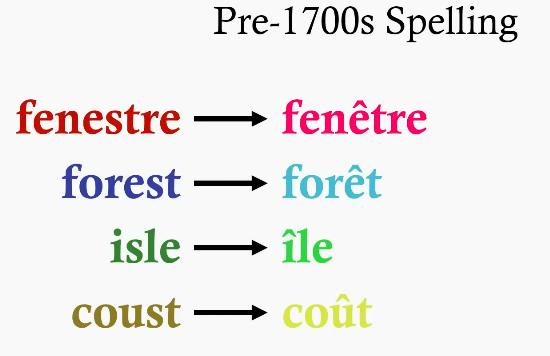 I don't think if I noticed
there that that ^ is s.
I don't think if I noticed
there that that ^ is s.
в этой пр in that fart-like pr and ссать-like st
Imagine cards of different letters:
A B C D E F G H I J K L M N O P Q R S T U V W X Y Z
Α Β Γ Δ Ε Ζ Η Θ Ι Κ Λ Μ Ν Ξ Ο Π Ρ Σ Τ Υ Φ Χ Ψ Ω (interesting how I mistyped extra before х's)
А Б В Г Д Е Ё Ж З И Й К Л М Н О П Р С Т У Ф Х Ц Ч Ш Щ Ъ Ы Ь Э Ю Я
Let's find unique simbols immediately giving up the nationality:
Б Д Ё Ж З И Й Л У Ц Ч Ш Щ Ъ Ы Ь Э Ю Я to my surprise russian has many unique simbols, but let's remove those who remind greek:
Б Ж Ц Ч Ш Щ Ъ Ы Ь Э Ю Я and we got 12 (Д ~ Δ, Ё~E, З~ʒ, И~H, Л~Λ, У~y)
Γ Δ Θ Λ Ξ Σ Φ Ψ Ω even leaving letters common with russian, we only get 9
D F G J Q R S U V also 9, interesting. Because if we unite Ш&Щ and ЪЫЬ into single characters, 9
Б Ж Ц Ч Ш Ь Э Ю Я
Could these be 2 to 10 of the playing cards?
Б Ж Ц Ч Ш Ь Э Ю Я
Γ Δ Θ Λ Ξ Σ Φ Ψ Ω
D F G J Q R S U V
what is the fourth "suit"? (national costume? suits do stand for different kingdoms, thus four kings, four аса! бога в норманском, значит меж игральными картамми и рунами есть связь. 9 как 18 песен одина, 9 рун по три у каждой норны (и их перевёрнутые представления))
Давай найдём эти прямы и перевёрнутые пары:
ᛆ
ᚿ
ᚠ
ᚮ
ᛘ
ᛦ
ᛁ
ᛂ
ᚴ
ᚵ
As you can see, only three pairs I can easily find, and two pairs can be the pure and dotted variants.
And what to do with the other ᛒᚦᚼᛚᚱᛋᛏᚢ I have little idea. But then I recall that ᛏ is ᛐ, and it let's me go not for ᛑ, but for ᛚ as the reverse form. But isn't it not reverse form? Because ᛒ is ᛒ even when it looks the other way, as in Bureus's codex.
Is ᚱ pair to ᚢ? I need to read that site link to which I gave yesterday to know the meaning runes are often attributed. That lady obviously made some research.
Well then we only have ᛒᚦᚼᛋ left, and obviously they pair up as ᛒᚦ, and ᚼᛋ are together because they are the only two left, and also ᛋ is named similar to sun, sol is one of the names, as far as I remember, and ᚼ looks like sun, but then is ᛋ strike of the same light? Could be the dark side of the sun, a ray of wrath.
So were runes yin-yang principle repeated nine times? Nighn or Eight if we'd work with 16 of younger futhark (or even with 15 containing one unpaired rune. And I think Bureus did work in reflections, let's base it upon him:
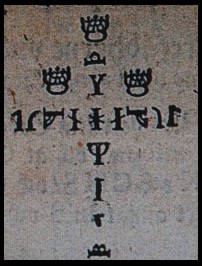

But he mirrors only four pairs, even though in other table of his ᛌ the ᛋ mirrors ᛧ the ᛦ...
<Y> sign, one of the most frequently occurring signs in Palaeolithic non-figurative art, has the meaning <To Give Birth>.
which made me think of Yule as of day of birth of those who were conceived on 1st of march. But then what celebration was that? I just don't know if this hypothesis stands, either way, I collect them all.
So, now we can arange that calendar we rotated to the primstav, to see the direction of the months:

and I can immediately see first, sixth and seventh of january in the 1, 6, 7 of the bottom right corner,

and it makes me want to rotate it like this:

And I can see, that in this one they celebrate Midtvindertagen Midtvinterdagen and Antonsmesse, 20th, but before 25th they also celebrate 24th, which is not in the table.
And then I can see how days of the January go into february as 29th, 30th, 31st, and after them you can see the 1st of Febrary and the festivities on the 2nd, 3rd and 5th (but then 7th and 9th and 15th too, which is not on the schedule) and then 21st instead of 22nd, but the final celebration is on 24th is on both the stav and the table. And I see that the february was of 28 days, because I can then count that the next holy day was 12th of march, they missed the 9th. Then 17th, then 21st, then 25th, in total accord to the table. So I think I found that the columns go in traditional manner from bottom up, and the only explanation I can have for the text not going in reverse boustrophedon is them being different columns. That originally months were written on different trees. And here comes the oghamic calendar, which also had 13 months:

But then what does that calendar doing starting with the 1st of January? Was it the transitionary model? As if they accepted the beginning of the year on first of january, but kept their own number of months? Or does it prove that stav to be a forgery, or rather a later reconstruction with that obvious mistake?
Most definitely these astrologic year, linked to actual astronomic events is also accepted by the germans, because the sky is the same, and events are observable everywhere, so .. so I assume that they were the same thirteen months.
Were those the plants people cultivated because they had some use for them? Like reed was used for production of pens. Birch though is not likely to give either sap or bath brooms. Did they cut it in winter? Why would they? You are supposed to prepare wood beforehand. But what if they didn't collect not to be robbed? Winter is the time when you need wood for your oven. Nah, oven eats wood all the time, they cooked on it.
Elder (бузина) and Alder (ольха) are two great words making me think of them more than of others.
And what about Ruis and Luis? Ruis is the very Elder, and Luis is Rowan (бя рябина) and rowan and ryabina look cognatic to me, and make me recognize the similarity between w and b, as all letters are the same, and how 7 kletters could be enough to communicate in a way. if all linguals are the same B and all the linguals are the same T, with 5 vowels having consonant counterparts, we have 12 letters, which is rather reasonable to have, and what would be the counterparts? Or what if they had 4 vowels? 10 letters, but come on! What am I even doing here? guessing? something like this, intuition leads me. And I read today that combining anthropoology with extatic magick to reconstruct the old beliefs is what Blawatska brought to the table.
and on this note I stumbled across the father of all russian historic freaks
Классен пытался доказать, что славяне обрели свою государственность не позднее, чем финикийцы, греки или римляне[5] и находил славян на многих территориях и во многие эпохи. По его мнению, славяне обитали у Балтийского моря 4 тысячи лет назад, русы героически защищали Трою, жили в Аравии эпохи царя Соломона, в начале н. э. существовала «Великая Россия». Со славянами им отождествлялись почти все народы Геродотовой Скифии, начиная с самих скифов, а русские связывались с этрусками. Он писал, что уже 4 тысячи лет назад венеды обладали грамотой, и называл все рунические письмена славянскими. Санскрит Классен отождествлял со славянским языком, парсов относил к славянам. Донских казаков он производил от гетов, а геты, по его мнению, жили в Малой Азии[2].
Классен является автором очерка «Новые материалы для древнейшей истории славян вообще и славяно-руссов до Рождества Христова)» (1—3, М., 1854—1861) и автором единственного перевода на русский язык труда польского филолога-любителя Тадеуша Воланского «Описание памятников, объясняющих славяно-русскую историю», который был выпущен с примечаниями Классена в качестве приложения к «Новым материалам…». В них он излагает теорию существования дохристианской славянской письменности — «славянских рун». К «славянским рунам» Классен относил ряд древних письменностей, в частности, этрусский алфавит[5].
and I decided to mention him here, because Vinča writings may tell that he wasn't wrong, when he said that уже 4 тысячи лет назад венеды обладали грамотой but then how dare I link two geographically similar cultures merely by the similarity of their names? Especially since we have no idea how representatives of vinča culture called themselves. Maybe this can clarify: В человеческих останках культуры Винчи в четырёх исследованных образцах (Lipson et al., 2017) были выявлены Y-хромосомные гаплогруппы H2 и G2a2b2a1a. Также были обнаружены четыре разных линии мтДНК: K2a, H26, U2 и T2b[8]. Все мужские и женские линии соответствуют характерным для европейских неолитических земледельцев.
У представителей культуры Винчи из Гомолавы (Хртковци, община Рума) определены митохондриальные гаплогруппы H, HV, K1a4 и Y-хромосомная гаплогруппа G2a (субклады G2a2a1, G2a2a1a)[9].
either way, it would be not four, but seven thousand years ago. Yes, pretty intense.
So, let's look at vinča's writings:

This is like what is this? Is it even writing or a knitting pattern?

this one is more like writing, but still wtf is this..

and this one is definitely some writing, and it reminds me mesopotamian protocunieform:
but then we definitely see the differences. Vinča is much more european, even greek, looking. I think it is why the guy who excavated it first (8 metres is the depth) believed that he excavated some greek settlement. I'm speaking not only of D-like shapes, but even more so of the 𐤇-like shape.
Archaic tradition of church has preserved some idea about rotations whether they're clockwise or counterclockwise, I went to church to recognize their way, and I found that you have to enter the church to the left, because you're left when you need to connect. Otherwise church is not in the houses of wood or stone. But I think this is the part of the bible discovered recently. And I think church didn't oppose them, so I consider that saying (found where? look it up yourself бог не в домах из дерева и камня) to be change proceeding in religion.
Will islam change? If it follows christian footsteps of an abrahamic religion, it will. But if it was made differently, it doesn't necessarily do. What can civilization do to tame those religious faggots? Give them heaven on earth, depending on other people rather than on some imaginary entity.
Matter is divided into wood stone and meat. Could it be the model of the ancient people? that three by three by three. Solid matter that is. Three mothers are three matters.
I shall not expose the wild side of the myth, I will focus on their understanding of the alphbaet бает? арфа бает
B D
F Г
M Λ
W Y
Ba Da
Fe Ge
Mi Li
Wu Yu
Those B and T times vowels. The more vowels you can distinguish, the more shapes of those TWO you can get. Vowels could vowels combine with vowels? Yes, and that is language of gods, the vowel words eau, awe, ieue
but ieue or ieoe? was ע o or u? because it does look like у. I never thought of ע this way, or never enough
A B Г D
E V J Z/// ahrhgh
E V Z H Θ Θ looks like Ho, or oH, or ниво энво Hino H_in_O
Could Θ be borrowed from china? no, chinese do not have it. Could the shape say something else, some depiction of thtat sound like "chinese" hidden in such simple shape would be great.
A B Г D
E V Z H Θ
..why transliterate hebrew in this mixture of latin and greek letters?
Work wiht latin. Look at the modern alphabet without O-line
ABCD
EFGH
I J K L M N
U V W X Y Z
and I notice that there are 20 of them,
ABGD
EVJZ
IMNL
UWXC
and I think I reconstructed that. C is S, as in russian, as the lunar sigma.
Was it some Ɔ X C ?
No, I'm pulling the cat, not cool.
but that 4×4 thing is cool, let's dig it,
ABCD
EFGH
I J K L M N
U V W X Y Z
ABGD
EVJZ
IMNΛ
UWXC
Okay, so what letters did they add? F H
I will probably keep on adding new наблюдения into this journal, but i expect to stop keeping, as I many times claimed, one day I'll be true.
I wanted to say, that I decided to give up weed, because to achieve my other goal I have to give it my everything.
ABD
EVZ or EWГ? was Z 𐌆? and thus IVX were ZVX? the opposite of XYZ? but it's too much to take in the light of how great IVXLCD lays into ABC...D like literally AВ...CD
So, I was saying.. I love smoking weed, I love this feeling, but then at first I was asking "how is it to achieve success without smoking weed? may I get answer to this question? You probably may, but the same way you may learn to run with a weight pulled to your feet, but it would make it easier for you if you lay the wayed away.
ABD
Эвз is just a dialectal variant of reading the ΑΒΔ of the first line.
IML is much further, yet still understoo, but AIU are the early triad. Did Pythagoras use his tetraktis to measure music? To draw accords? Only three cords, and they pulled them in different order, and musical notation would be a ligne connecting the dots or making circle around the note, if it was repeated twice. I think I'm using the blawatska's method of combining anthropology with actual extatic revelationism (why would my trippin be worse than those of the ancients? Especially since I merge and delve inot the material they could be researching reading learning)
So far, I am high today, and only after I smoked I realized that it is like doing it weighed, literally stoned. I asked that question if I can do it like this before I smoked. And the answer is perfect, don't you find? I should give it all, this is how I do it. And yes, probably it is the answer to my question of how to make it. If I want my immortality, and I do, I should give it all. And what it means is also that I should give away everything which stops me from making it. And of course I shouyld dedicated should dedicate every moment of my life to achieving this goal.
So, knowing me, I know that these language observations will keep on coming, only 20 times less often
So, I will probably keep on this diary for some longer, probably to kill it as king at 33
I think if I ever publish it in the form of actual books, I shall add additional volumes to 21 and around it, or maybe I spread additional pieces through the volumes, adding small ones to large volumes and huge ones like tiny latiny to the shortest, such as 21, for example. And what about manuscripts? Only if I manage to decypher them all will I add them to the edition. The electronic edition is already here, in html format, and I think this is enough and sufficient for such enormously raw material. May only good pieces be present in the form of the book. May ai taught upon that raw corpus make more books like the one I managed to issue myself. It will probably find more of tidbits in my mess. I will be the editor, of course. If it makes sense to me, it makes sense. And naturally sometimes it may lead me into what I didn't see because it will use the information I copypasted but did not remembered.
ABD
EVZ
IML
OПR
УФS Uфq? uфþ
There's difference between þ and ϸ:
Thorn or þorn (Þ, þ) is a letter in the Old English, Old Norse, Old Swedish and modern Icelandic alphabets, as well as modern transliterations of the Gothic alphabet, Middle Scots, and some dialects of Middle English. It was also used in medieval Scandinavia, but it was later replaced with the digraph th, except in Iceland, where it survives. The letter originated from the rune ᚦ in the Elder Fuþark and was called thorn in the Anglo-Saxon and thorn or thurs in the Scandinavian rune poems. It is similar in appearance to the archaic Greek letter sho (ϸ), although the two are historically unrelated. The only language in which þ is currently in use is Icelandic.[1]
The letter ϸ (sometimes called sho or san) was a letter added to the Greek alphabet in order to write the Bactrian language.[1] It was similar in appearance to the Anglo-Saxon and Icelandic letter thorn (þ), which has typically been used to represent it in modern print, although both are historically quite unrelated. It probably represented a sound similar to English "sh" ([ʃ]). Its conventional transliteration in Latin is ⟨š⟩.[2]
Its original name and position in the Bactrian alphabet, if it had any, are unknown. Some authors have called it "san", on the basis of the hypothesis that it was a survival or reintroduction of the archaic Greek letter San.[3] This letter ϸ closely resembles, perhaps coincidentally, the letter ⟨𐊮⟩ of the Greek-based Carian alphabet which may have also stood for [ʃ]. The name "sho" was coined for the letter for purposes of modern computer encoding in 2002, on the basis of analogy with "rho" (ρ), the letter with which it seems to be graphically related.[1] Ϸ was added to Unicode in version 4.0 (2003), in an uppercase and lowercase character designed for modern typography.
And Carian alphabet is quite a treat:

𐊠 𐊡 𐊢 𐊣 𐊤 𐊥 𐊦 𐊧 𐊨 𐊩 𐊪 𐊫 𐊬 𐊭 𐊮 𐊯 𐊰 𐊱 𐊲 𐊳 𐊴 𐊵 𐊶 𐊷 𐊸 𐊹 𐊺 𐊻 𐊼 𐊽 𐊾 𐊿 𐋀 𐋁 𐋂 𐋃 𐋄 𐋅 𐋆 𐋇 𐋈 𐋉 𐋊 𐋋 𐋌 𐋍 𐋎 𐋏 𐋐
𐊡𐋊𐋋𐋌𐋍 are graphic
variants, as are 𐊤𐋈𐋐, 𐋎𐊦𐋏, 𐊺𐋏, 𐊼𐊽, 𐋂𐋃, 𐋁𐋀,
and possibly 𐋇𐊶.
The Carian alphabets are a number of regional scripts used to write the Carian language of western Anatolia. They consisted of some 30 alphabetic letters, with several geographic variants in Caria and a homogeneous variant attested from the Nile delta, where Carian mercenaries fought for the Egyptian pharaohs. They were written left-to-right in Caria (apart from the Carian–Lydian city of Tralleis) and right-to-left in Egypt.
Carian was deciphered primarily through Egyptian–Carian bilingual tomb inscriptions, starting with John Ray in 1981; previously only a few sound values and the alphabetic nature of the script had been demonstrated. The readings of Ray and subsequent scholars were largely confirmed with a Carian–Greek bilingual inscription discovered in Kaunos in 1996, which for the first time verified personal names, but the identification of many letters remains provisional and debated, and a few are wholly unknown.
The Carian alphabet resembles the Greek alphabet, but the exact Greek variant from which it could have originated, has not yet been identified. The main reason for this is that some of the Greek letters have different sound values in Carian.[5] Two hypotheses have been suggested to explain this. The first is that the Greek letters were randomly attributed to phonetic values; though some letters retained their Greek value. The second proposed by Adiego (2007), is "that the Carian alphabet underwent a strong process of cursivisation, dramatically changing the form of many letters. At a certain point this graphic system underwent a change to 'capital' letters, for which the Greek capital letters were used as models - but now only from a formal point of view, disregarding their phonetic values (...).".[4]
Notice that the table above is not necessarily the actual
abecedaric order. Though it is powerful chunk of information
hidden from me before this moment. Those signs are
transliterated differently because when it was in use they
didn't forget what those symbols actually were, so they
translated them into their languages differently. But then
what is the alphabetic order? Probably as periodic table,
abecedary orders appeared later than texts were in use. In
this sense is ugaritic abecedary a forgery? Too good in the symmetires it is to be fake.
Why would faker know them or why would he be that lucky?The Carian alphabets are a number of regional scripts used to write the Carian language of western Anatolia. They consisted of some 30 alphabetic letters, with several geographic variants in Caria and a homogeneous variant attested from the Nile delta, where Carian mercenaries fought for the Egyptian pharaohs. They were written left-to-right in Caria (apart from the Carian–Lydian city of Tralleis) and right-to-left in Egypt.
Carian was deciphered primarily through Egyptian–Carian bilingual tomb inscriptions, starting with John Ray in 1981; previously only a few sound values and the alphabetic nature of the script had been demonstrated. The readings of Ray and subsequent scholars were largely confirmed with a Carian–Greek bilingual inscription discovered in Kaunos in 1996, which for the first time verified personal names, but the identification of many letters remains provisional and debated, and a few are wholly unknown.
The Carian alphabet resembles the Greek alphabet, but the exact Greek variant from which it could have originated, has not yet been identified. The main reason for this is that some of the Greek letters have different sound values in Carian.[5] Two hypotheses have been suggested to explain this. The first is that the Greek letters were randomly attributed to phonetic values; though some letters retained their Greek value. The second proposed by Adiego (2007), is "that the Carian alphabet underwent a strong process of cursivisation, dramatically changing the form of many letters. At a certain point this graphic system underwent a change to 'capital' letters, for which the Greek capital letters were used as models - but now only from a formal point of view, disregarding their phonetic values (...).".[4]
But this is not the attitude to smoke weed with. Am I still smoking it? If I do it, do it good at least, these trips are not what I'd miss if I still keep on using it from time to time. Am I? I don't know, but once I'm high, let's smoke again and dig in. Look at that Carian thing! It's as if muses tell me no don't go
Integrity Patience Delegation doesn't tell to give up what you love. It may help me by instructing me to delegate the social funkction to somebody with social skill. Do I need social skill? No, because social interaction kills the creativity, and I need creativity. After all, why so ungrateful I know what I know and have what I have because I smoked weed, so let's smoke weed, there's nothing wrong with smoking it if you're an artist. I asked how to do it, and a) I was told that it doesn't help me to do it myself and b) it tells me that I have to delegate the functions this creativity booster may impair
(impair like the opposite of repair, which is morphologically is kind of weird, until I recognize that im is not in, but un, it's as if damages only one boot, keeping other with no pair? Nah, hardly it is so. I believe it is )
So I took on faith athat Integrity Patience Delegation is what it takes? Delegation part I should work on. And I should also improve the other parts. The other parts I've been working on for some time: I don't allow me to lie, and I have learnt that everything comes to one who can wait. First you have to delegate, that is how you wait properly.
is impediment is impending ?
depending is not depediment, but dependance dependence
Were different suffixed suffixes chosen and engrained by the use of the term? or do they have somewhat different meanings? Currently we don't may not distingue distinguish the difference, but morphologically naturally there is.. unless the order is changed when it was not word but sentence.
ence in Dependence reminds iment in impediment. What is the difference? en+ce ~ im+ent...
I don't know, but let's guess. is en~im? then ce~ent? this makes ent it, because ceIT is itEN.
and if they're switched? en~ent? ce~im? nah, this is worse, because I cannot explain ce~im pair.
im is I am, ce is this, m is inside, ce is outside. Is it? is both ence and ement in and out?
Dependence itself is what depends on both side.
Depending is depending in, inside.
Depended is what's on the outside, what he (the subject) depends on?
is s random as tzarist russians' 's? дас, нус, вотс, зафиксировано много где в золотом периодие русской литературы и вплоть до Чехова быть может.
ed ~ out
ing ~ in?
ed and ing are antonymous morphemes, and so are out and in. And it is only natural that they united.
did ~ do out? out is not here any more, in the past, thus.
was in used for future (I applied understanding of ed of the passive case and applied it to the past simple, and it fits just well)
doing is present and I knew it was in! I knew it from completely different route.
Suddenly I suspect I lick my own tongue so to say, mapping the way I actually understand it, when I imagined the routes, I think the shortest one is chosen simply by tension o fneurons.
I imagined routes of the language map I'm starting to assemble gradually comprehending the morphemes, but that chances are it will be very similar to the one we actually build in our language aquirement: on the subconscious level we feel the difference between similar words with different suffices even when we don't understand their particular meaning. Like на в димина is it the same as на в на диме? And only know can I see that it is the same morpheme. If it quacks as a duch..
Looking at the kurdish alphabet, they preserved the vocalism, arabs borrowed it from kurds, not the other way around! If not directly, the flow was that way and not the other, even if technically they just had common ancestor (they naturally did, but I'm speaking of what gave these shapes to both of them) then kurds have preserved the vowel part closer to the original version, because vowels matter.
What I'm saying is ه the ههه which is e in kurdish, but not a vowel in arabic and persian.

But I brought this here to demonstrate how much those vowels (kinda representing aeio, look like ioue. They're like all different. Is it like in the carian? different words for different concepts? But how I know that ع represente E and not З? after all they go the other way around. Is З consonantal pair of E)
A~Д (a~D, a~d (l;ke hands down it's the same letter))
E~З (in greek alphabet it is exactly how AД are the initial and final positions. Are they aбgд like four shapes of arabic laettes? letters? separate, initial, middle, final? were they just three when initial was the separate one? then did ع look like the first form of ععع? Isn't عع the swashed ع? But then what? do they write it from the bottom right corner? No, that is where it ends, they write right to left. It is like the lower end of g, so technically ع is з? or is з somehow e? both are зе or ез (the, est, it~is)
ИN? if the second line is it is, this one is probably I'm.
UR is the third (of three)
is ABþϸ Aз Вы Сей(те)?
сё и то.. разница в месте (и времени) се ближе to.. I, то ближе to.. U?
O is of Our? i~o? ии[i] ~ [u]uu
was a the base viowel and both u and i were dialectal flexions? твоя противостояло нечёткой падежизацией вариантов твоей~твою, условно говоря твоею.
Это бы объяснило the и~u thing.
our also unites u into o thing. were our opposing their? were ou we? almost.. nous and on[ñ]
n̆ň those are different 0306 is )-like and 030C is >-like
u~n? both meet with v~ν
is ou reconstructed form of us~we? is s in us dialectal fashion~craze~rage to distinguish words of their language from different words of the language of the opponent, when for dutch U was you and for englishmen it was we, or even I.. nah I is I V is five of us, or probably at first it was only two:
u~ɪɪ (u~ɪɪ(ii))
𓏭 and 𓏮 were used as plural suffyd [и (can you believe
it!)]
I wonder what 𓏯 and 𓏰 were. I think they were "singular" like english prefix a. I think I saw 𓏤 used for this.
In ancient egyptian, as you can see I take those systems as
one system. By seeing common traces in both the systems I thus
discover what was the protosystem of the both.I wonder what 𓏯 and 𓏰 were. I think they were "singular" like english prefix a. I think I saw 𓏤 used for this.
EFGH.. I can only see He, and exactly at the position оН is in. isn't g gij? What is E? je?
was f w the wij? but вы is there.. was it why Z of zeus stand instead of F of fairy? Thronos? Many, it is difficult, if it has the M-like misplacement, I will never figure it out. I need some 3d modelling by ai to see it more clearly. So far I think I should be happy with what I get, maybe with time I can see it better, hopefully in close proximity I can get access to ai tuned up for my own purposes, for my personal use.
Are vowels and labials both go for first person pronoun? I'm, I~me, but U~Вы, even tghough U~We
was that u we too?
Hey! I think earlier I said that E is not je, but это? э как ה the the. literally e.
E
I
U
?
A I U
A ~ one
I ~ me
U (you)
So is first person the third? No, it just tells that A is indeed added later, when the meaning was lost.
I U A was the first vowel order? ➘➚?
больно~больно(как же стока (как же столько))
TM is team! (trade mark, but тм(тм) and team(ты+Ah'm (scottish Ah(Я, I)))
Ма(of ма́ма) корень слова моя[мая́ (и как прикольно что в слове моя ударения на я)]
ma ~ my
mom ~ mine
ma ~ may ya? можешь (где жешь сделаешь. деешь. жжёшь? дашь. жи(в)ёшь (ставишь стоишь)
(по руссуким правиам я должен был сказать "(см. ставишь~стоишь (см смайл, найс. я подумал про сравни, которого сокращение никогда мне не нравилось. скр краше. но сакрал значит кресцовый, не кресто́м а кресцо́м))
ы wws by accident written as oɪ which tells that balls and sticks are all there were, and that is why glagolitic feels so ancient. And looking at runes, giveing the same ancient feeling (because by coulter we know that they are ancient. Hebrew doesn't look as hebrew, it's pretty much the same: always on paper, anthropology at this area is corrupted the most, it is more of a power game than some pushtu, but maybe less heavy than russian or american identity by the mere number of carriers. But then they're маленький да удаленький. So my task is to stop all wars. And in this wish I allow the moshiah to be me. As a wizard, allowing a spirit to enter? A good spirit is it not? It is a jewish good spirit. I used hebrew word messatya messaya is the russian word. or isn't it greek? It is englysh,. ) I realize that balls probably were double sticks. But 𓏭 𓏮 и s n (n still have that reverse leg of being и and N, boustrophedion equlaizes ᛚ and ᛐᛏ) И=N as A=Д as E=З as I=l as O=𐤕X𐤈
(X is T (if your fonts are firmly set in the settings, you may not see 𐤕 (phoenician tav) being x-like, apparently there are variants my seamonkey shows))
So alas, acrobat is better in this account. I should transfer this journal into more acropants pdfs.
here is how 𐤕 to look in that
pdf:


and here I have a mandella effect, because I remember it looking like X everywhere, and in my own firefox fontface too! like in this one:
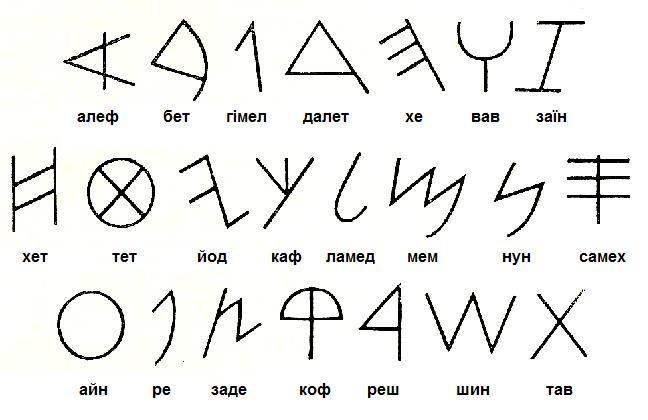
and this one reminds roman cursive by bet and dalet being so similar (only here they're upside down, but what if we had to rotate the text to read it in columns? but no, not likely:

but then can I trust these images? This one screams "new" to me by it's cracks being not eaten at corners of the cracks. Was it glewed together when it was broken before it was ancient? Was it broken soon after they found it, so they could glew it back together? I doubt both scenarios: the first is not likely, because they corner of it at the left bottom part of the two. If it wasn't new, it would be plastered back as if it was new. But this is a reconstruction, thus they charished not to add anything. Was forgery of such documents an offense? they would just keep it broken. Was breaking of such documents an offense? How would they check? By accidents, mostly, but something not to keep those damaged documents. All specullations, man, come on. Should I exclude the swearings not to infect those who read it with it (the hapid to сквернословить не красит никого. Даже в агрессивных выпадах литературный язык явялется преимуществом. Можно красиво материться в стихах, у видящих в матершинных заворотах красоту хорошие матершинные стихи вызывают трепет)
В общем, если её склеили современные реставраторы, то как она
не по обтесалась в месте слома. Если она вклеена в стену
давно, то как никакая новая метла не вымела её из стены в
музей или где подобный храм раньше хранили. Художественная
ценность этого произведения тоже невысока. Но это может
говорить в пользу древности. Но есть какой-то современный
touch в этой бездарной ебанине. Но я забываю, что это
еврейская надпись, а вспомни шагала)))and here I have a mandella effect, because I remember it looking like X everywhere, and in my own firefox fontface too! like in this one:

and this one reminds roman cursive by bet and dalet being so similar (only here they're upside down, but what if we had to rotate the text to read it in columns? but no, not likely:

but then can I trust these images? This one screams "new" to me by it's cracks being not eaten at corners of the cracks. Was it glewed together when it was broken before it was ancient? Was it broken soon after they found it, so they could glew it back together? I doubt both scenarios: the first is not likely, because they corner of it at the left bottom part of the two. If it wasn't new, it would be plastered back as if it was new. But this is a reconstruction, thus they charished not to add anything. Was forgery of such documents an offense? they would just keep it broken. Was breaking of such documents an offense? How would they check? By accidents, mostly, but something not to keep those damaged documents. All specullations, man, come on. Should I exclude the swearings not to infect those who read it with it (the hapid to сквернословить не красит никого. Даже в агрессивных выпадах литературный язык явялется преимуществом. Можно красиво материться в стихах, у видящих в матершинных заворотах красоту хорошие матершинные стихи вызывают трепет)
And zayin is of old-italic shape, so I
guess if that table, right above that terracota depiction
with text, preserved some north-western form of phoenician.
𐤀 of the terracota tablet reminds me ᚨᚭᚬᚩᚮᚯᚰ but then ᛆ is 𐤀, so are they different takes of the same 𐤀?
or are they of different egymology?
cotobaJA ~ словаRU
cлова складают, слога~слова? слого старый способ сказать
слово? мы с тех пор тащим прочтение г как в? вернее, запись в
как г. Как давно это могло быть. дАвай повернём г на 225
градусов. vрадусоv? а еслина 315? cradusov. Похоже что г это
поворот буквы v на 135 градусов. Или я брежу, одно из двух, но
раде того одного из двух приходится два раза подымать вопросы,
один приводит к чему-то, другой вроде этого. Но, обрати
внимание, что и этот не совсем пустой. Вырастает-то оно из
чего-то очень прикольного, хоть и лингвистически дикого:
объединение русского с японским по причине географической
близости народов (и русь будучи под ордой граничила с японией
и в древности (и сейчас граничит, но и в древности, и кто
знает что было до орды, какие империи, да и миграция отдельных
семей скорей всего была всегда. Если тебе угрожают смертью на
родине, то где искать убежища как не там, где тебя хотя бы не
знают и властям твоей страны не подчиняются, т.е. там хотя бы
шанс есть, даже если иностранцев не любят: соседей не любят
тоже, а потому иностранец, который не любит соседей, это
актив, их терпели потому что использовали, у них были
особенные навыки, особые знания, знание языка соседей,
например))cotobaJA ~ словаRU
Back to 𐤕, some texts have it like this:

but this is obviously a fake, or let's call it a replica: the letters are too bright, there's noway people didn't touch it with dirty hands, even if it wasn't laying in the dirt. Too new to be true.
Here's a better example:

here you can see lameds in the highes letters, the shape is pretty much similar to modern L,
so just as
and not the way firefox does:
Notice, how Z is known since then, even if it stands not where we users of latin alphabet place it.
It's as if G, which reminds me that Z~Z̆Ž
I am in a healthy contradiction: one part of me claims it doesn't trust anything jewish, the other side of me recognizes the emotional quality of that statement, and thus keeps the writing system in all it's variations, as a working hypothesis, as something which is likely to be true, but I expect it to fall flat at the same time. I think it is a healthy state of the researcher: he shouldn't know what the outcome is going to be, he can only hope to be successful, and yes, to be successful from time to time. Nobody is always right, but nobody is always wrong either.
It's funny that working with right-to-left writing system I naturally occasionally found myself preferring to start the text from the right side.
So what are the shapes existing since then? A Б Г g E y z K L N O q T or is that 𐤓 Р[R]? but only if it's P[p] does 𐤏𐤓𐤕 go abc-like. Then it's hard for me speak of that, I have different phoenician fonts on my hands, I don't know the difference between them if one is majuscule and the other is minuscule, or if it's sets of different nations combined under the same unicodic spell.
No M-like shape, are you serious? 𐤌 is how M used to look? it is very ᛘ-like, you know.
But they only have W-like 𐤔 instead, which is very ᛉ-like.
is Ma a variant of She?
if virus related to fire (жар)
Russia в ирландии вроде читается как руша, и в этом смысле
у нас говорящая “фамилия”: рушим мы и вправду хорошо:
наполеона разрушили, гитлера разрушили (про наполеона мне
рассказывали, что банкиры его наняли дабы утилизировал
пассионарную молодёжь, грежущую ещё одной революцией. В
германии антисемитская молодёжь взбунтовалась, в россии
просемитская, дабы разбить две проблемы друг о друга
отвлекли дебилов на перемалывание друг друга. Сегодня
похоже что красножопую молодёжь с одной стороны и
коричневых, прикинь, nutsы, lead what you cannot stop they
say.
Но что если разрушить не только собственную экономику и культуру (можно предположить, что основные акторы рассматривали эту культуру как субстрат (в лингвистическом смысле наверное так и было, другое дело что суперстрат двухпроцентной концентрации, newедомое но не невиданное доселе преступление.
Так, что если нарушить пассивное подчинения планам закулисы, а разрушить весь миропорядок, показав альтернативный способ управления. Макро-либертариан аппроч прочь is away, bad word, now you see why nations use different words? Because they read basics differently. BACECC (X=CC)
CC are different? one is k and the other is s, the open to palatalization is palatalized of the two.
KS? and I saw armanen G in ᛋᛋ:
Но что если разрушить не только собственную экономику и культуру (можно предположить, что основные акторы рассматривали эту культуру как субстрат (в лингвистическом смысле наверное так и было, другое дело что суперстрат двухпроцентной концентрации, newедомое но не невиданное доселе преступление.
Так, что если нарушить пассивное подчинения планам закулисы, а разрушить весь миропорядок, показав альтернативный способ управления. Макро-либертариан аппроч прочь is away, bad word, now you see why nations use different words? Because they read basics differently. BACECC (X=CC)
CC are different? one is k and the other is s, the open to palatalization is palatalized of the two.
KS? and I saw armanen G in ᛋᛋ:
.jpg)
 (mirror)
(mirror) (mirror)
(mirror)In Norse mythology, Ask and Embla (Old Norse: Askr ok Embla)—male and female respectively—were the first two humans, created by the gods. The pair are attested in both the Poetic Edda, compiled in the 13th century from earlier traditional sources, and the Prose Edda, composed in the 13th century. In both sources, three gods, one of whom is Odin, find Ask and Embla and bestow upon them various corporeal and spiritual gifts. A number of theories have been proposed to explain the two figures, and there are occasional references to them in popular culture.
Are you kidding me! Norsk mythology is telling the same story, but in different detail. But what stories does norsk mythology preserves? Adam and Eve, okay, but what about others? Exodus they probably do not include. But why would people be taugth jewish history? Because it is the history of their masters. But why would those "masters" (the owners of schools) destroy a relative culture? For heresy! Those who didn't agree with their "saint fathers" (jesus directly told not ot coll people fathers.) was considered heresy, and infamously destroyed. Such crazy people. And I brew in this information for years, and only now have I met that
Ask and Embla are like Ask and answer, with answer also being an emblem, as if during divination sticks would make shapes, which interpreter would read. I can imagine that. And also because embla reminds answer in that (according to dutch) answer is ant-word противо-слово? от-ветъ (ответ~ответь, отзнай, приветить~привидеть(издалика, например) вето ведо in-do, as thoughts are done inside, but then food digestion (also digestion, btw, and conception is another duobisemantic word, то вето, которое желудочно-кишечное имеет ж от желудка в переди: живёт жуёт жевать, где вать видеть, ведать, то полезно что в рот полезло, неполезное сблюёшь, злых духов считалось что не выгнал, если одержимый не блевал, и быть может на это намёк в exorcist movie, но я говорю, что духом считался и плохой запах, и ведь если съесть еду с дурным запахом (с дурным духом, "с душком") то можешь заболеть, что могло интерпретироваться как злыми духами мучение, и от пищевых отравлений рвота вполне себе пристойное средство. Понос организм обеспечивает зачастую, рефлекторно, но пей побольше воды, чтоб поддерживать этот очеистительный процесс, нет вы посмотрите о чём я говорю, ну давай этот коричневый участок разработаем подальше, раз взялись. понос пронесло кишечник понёс быстро-быстро-быстро содержимое из желудка прочь? очистительный процесс, эволюционное преимущество, сокращающее exposion time to eaten poisons. If we could immediately quickly fill the intestines with the liquid absorbing food residues into it's soup, taking most of it immediately away? Отёк тканей от воды может быть. Шесть литров выпитой воды может привести к летальному исходу (или около шести, что-то в таких пределах)
Water is considered one of the least toxic chemical compounds, with an LD50 exceeding 90 ml/kg in rats;[3] drinking six liters in three hours has caused the death of a human.[4]
but back on track:
Old Norse askr literally means "ash tree" (see Yggdrasil) but the etymology of embla is uncertain, and two possibilities of the meaning of embla are generally proposed. The first meaning, "elm tree", is problematic[clarification needed], and is reached by deriving *Elm-la from *Almilōn and subsequently to almr ("elm").[1] The second suggestion is "vine", which is reached through *Ambilō, which may be related to the Greek term ἄμπελος (ámpelos), itself meaning "vine, liana".[1] The latter etymology has resulted in a number of theories.
Linguist Gunlög Josefsson claims that the name Embla comes from the roots "eim" + "la" which would then mean "firemaker(ess)" or "smokebringer(ess)". She connects this to the ancient practice of creating fire through a fire plough which was considered a magical and holy way of fire making in folk belief in Scandinavia long into modern times. She identifies the emergence of fire through the plowing symbolically to the moment of orgasm and hence fertilization and reproductiveness.[2]
According to Benjamin Thorpe "Grimm says the word embla, emla, signifies a busy woman, from amr, ambr, aml, ambl, assiduous labour; the same relation as Meshia and Meshiane, the ancient Persian names of the first man and woman, who were also formed from trees."[3]
So why do jews claim people were made of clay? Technically it is probably correct, but in the much further perspecive. Or is it that we were different from trees since we were more simple than trees, thus are we from different branches of life? It depends on how you distinguish trees. Are hydras trees?
Either way, as science religions suck, so why bother with which one is closer to truth, if being closer to the source is more important in the anthromopoologic sense my work is working.
Meschiane is laymen philistines ordinary people in russian (мещане (and because men (мужчины) is a very similar word, I suspect men to be m-en, the abbreviation of meshiane, only it seems in persian it is not plural, but female suffix, or who knows maybe it is both, as suffix a in latin is both female and plural))
Ʌ B <
O M L
V
I had to choose from ɅOV and ɅIV (by reasons of graphical symmetry, and I chose ɅIV fore te the phonetic opposition. Ʌnd because M L was the first very different from B (V is how В sound in russian)
Ʌ Г
I
V L
graphic opposition tells me to go like that.. and what is in I live? 𓈖?
Ʌ Г
I M I saw it here as Om, reading I as O for whatever reason. As in jewish it is.
V L
א גד
ו מ
and I can see that hebrew doesn't have V if I take ו already. so.. ב ה ז ח ט י כ ל נ ס ע פ צ ק ר ש ת?
א ד
י מ
ע ל
And this group does not make much graphic symmetry, and in general it doesn't maek sense.
ו מ
and I can see that hebrew doesn't have V if I take ו already. so.. ב ה ז ח ט י כ ל נ ס ע פ צ ק ר ש ת?
א ד
י מ
ע ל
And this group does not make much graphic symmetry, and in general it doesn't maek sense.
(for whatever reason I started writing the previous passage chapter вклинившись между текстом выше and the following mark on masonmark)
passage and chapter ~ corridor and chamber
I met the masonmark from above elsewhere, if it is the same, the angle is different:

Why do I admire work of the church which wants to enslave humanity? Would god want that? Jewish god does want if, from the very start. And this is why Jesus broke their spell by telling to be sons in the house of the father. And jews shouldn't be mad: as they say, child is god for the first 5 years, but he is slave for other 5 or ten (I don't remember exactly, and it take it as a draft of how you treat them) and then he is equal. Son is not equal. Well, we're slaves today, we're yet to become equals. As in AKIRA human has potential to become anything.
До того, как люди познали единобожие, даже до того как многобожие познали, поклонялись предкам, т.е. людям, люди обожествлялись в древнем риме, быть может и египетский пантеон населён великими людьми, но этого не знаю. Тот был великим изобретателем письма до Ио? До Сешат? Все эти великие имена (слово имя в значении бог, как у евреев.. иудеи они думали лучше чтоли? нет созвучия с враль и вор, но иуда же предатель, что за приколы? страдание как ритуал?)
Т.е. люди были богами первый период своей истории, стали рабами во втором периоде этой истории, и обречены стать равными богам когда вырастут как цивилизация. Миллиарды богов, грозящие перерости в Триллионы, представь ещё один пантеон, где каждый из миллиардов прокачан технологиями до уровня божества, но каждый из миллиардов наблюдает за каждым при помощи анализаторов входящих и выходящих сигналов общей прозрачной сети и в меру возможностей наблюдает за независимыми движениями независимых сетей и индивидуумов (за такими больше присмотра, потому что с чего бы они окуклились отдельно. И если они планируют повредить общую сеть или общую экосферу? предотвращать. Каким образом?
Начиная переговоры. Просить изменить планы. Подкупать. А если человек соглашается и продолжает? Наблюдаем, принимаем в момент совершения правонарушения. Охрана? Автоматизированная, робототехника об этом и говорит, люди подобной опасной и скучной хернёй заниматься не будут (может лишь отдельные power-maniacs power-freaks, teenagers playing it as videogames, observed and corrected if their behaviour is thus problematic, but who decides? The billions of humans, or in some cases families around that person)
Верования древних примитивны во многих аспектах, с чего доверять им в том что касается богов.
Я им доверяю на предмет того, что говорит их религия, чему учит, чего хочет, что продвигает.
Рабство - это из их ритуального лексикона, их раб не отец, а рабовладелец. Масоны молодцы, что рабство отменили. Ужас, жах, жидовство в худшем виде. Сатанизм неискореним, но можно же его направлять в правильные русла. Каким образом? Быв Був Будучи одним из них.
?
Ʌ Г
I 𓈖 N or M are both more than VLГɅ, and with even simpler I it makes up ..N is the letter, N is next to Г and L, by articulation, phonetically. And N is how 𓈖 is transliterated.
Ʌ Г
I N
V L
I N
V L
Thus it has four strokes per line
but columns don't keep this count, being 5 and 7
Naturally, magic square demands another column.
but columns don't keep this count, being 5 and 7
Naturally, magic square demands another column.
A Г Δ
I N M
V L W
but isn't it too much of a stretch? It is, but let's play along until something better comes along..
we have 8 per line, but columns are 6 7 and 11
Can I manipulate them to get it more magical?
A Г Δ
I M N
W L V
And first I placed W for U, as double V, makes more sense then W being double U,
and then I naturally moved M where it stands today, and o miracle! 8×8 in 3×3
I N M
V L W
but isn't it too much of a stretch? It is, but let's play along until something better comes along..
we have 8 per line, but columns are 6 7 and 11
Can I manipulate them to get it more magical?
A Г Δ
I M N
W L V
And first I placed W for U, as double V, makes more sense then W being double U,
and then I naturally moved M where it stands today, and o miracle! 8×8 in 3×3
What is L doing between W and V? Actually, only this and why no B are two questions I have, but watch BC.html to read more on the paradox of Г being related to Б, russians read г in чего as v, keeping the tradition eastern г-низация probably tried to pull upon us.
So, graphically 8-square is a very cool find, and it is quite possible to be the case
A Г Δ
I M N
W L V
Let's look up for "3 2 3"+"1 4 3"+"4 2 2" I M N
W L V
(and it adds up to 888 (so does "3 1 4" +
"2 4 2" + "3 3 2"))
but google didn't return anything relevant neither for "323 143 422" nor for "314 142 432"
if we don't count the random stuff like the
centre of the 1737 line:

yes, it can find them even in different order

yes, it can find them even in different order
A Г Δ
I M N
W L V L can be there, because Ł[w] or maybe it was W M V and M was replaced again for the magic of the square? Or maybe L was in the LMN line, and WИV was the prototype of uvw? It is all speculation on speculation, which should be considered fraud in both banking sector and your stuff.
let's play like this with other sets
E F Г 9
ΛMN 9
иvw 9
and to my surprise I didn't have to change anything, the columns equal 9 without my stretch.
So was it because numeral system based on 9 is more recent than the semi-erased from history numeral system base 8? So now let's try and look up "321 "432 243 324" and "423 342 234"
Some even more random stuff:

and even its html's body doesn't contain that sequence, but those numbers it does contain in what seems to be some spy's cyphre
And why am I here? I am just on a journety, expanding the horizons. Sometimes random can be fascinating.
Like w in the form of is in the next piece:

I wonder if Georgieboy got Golden Antelope moment, that indeed was their pinnacle. One of.
Positive and negative numbers are sometimes called signed numbers.
enough or random stufff for todaym, let's dig itno something we actually care about:

and where I took it has some more:
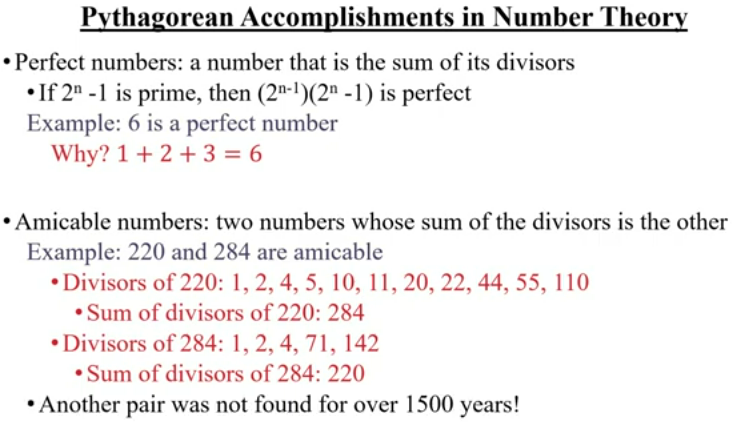

and that channel is a vault of treasure, especially because he made some videos on ancient math, this one was uploaded only 20 hours ago.


and even its html's body doesn't contain that sequence, but those numbers it does contain in what seems to be some spy's cyphre
And why am I here? I am just on a journety, expanding the horizons. Sometimes random can be fascinating.
Like w in the form of is in the next piece:

I wonder if Georgieboy got Golden Antelope moment, that indeed was their pinnacle. One of.
Positive and negative numbers are sometimes called signed numbers.
enough or random stufff for todaym, let's dig itno something we actually care about:
"Cегодня лицезрею?" - вопрос в будущем
времени в форме времени
настоящего.
улицезрею было бы точно в будущем, но не дополнительное ли слово [u]у ~ λ('ll, ł)
Interesting, avestan word for man reminds Masha, mother, which reminds me of icelandig word for man, also reminding mother: maður (mother is móður and móðir)
According to the Zoroastrian cosmogony, Mashya and Mashyana were the first man and woman whose procreation gave rise to the human race.
The names are from Avestan, nominally transliterated as mašyā and mašyānē, but like other Avestan words also, spellings (and hence transliterations) vary from manuscript to manuscript. Mašyā may thus also appear as maṣ̌iiā or maš́iiā or mašiiāi (and variants).
Originally and etymologically, Mašyā means "mortal being" as Old Persian martya, Persian mard and even Sanskrit martya also mean "mortal" and therefore "man". The root in Avesta and Sanskrit for death is mar, mr, "to die". The causative mâr means "to kill". Its derivatives merethyu/mrtyu means "death"; mareta and maretan means "mortal", and then "man, human being" mashya. For more on the etymology of the aša and arta variants of these terms, see Avestan phonology.
According to the creation myth as described in the Bundahishn, Ohrmuzd's sixth creation is the primeval beast Gayomart, who was neither male nor female. Ahriman, the Spirit of Evil that dwelt in the Absolute Darkness, sought to destroy all that Ohrmuzd had created, and sent the demoness Jeh to kill Gayomard. In this she was successful, but Mah, the moon, captured his seed before the animal died, from which all animal life then grew. From Gayomard's corpse grew a tree, the seeds of which were the origin of all plant life, and from the branches of which grew Mashya and Mashyana. They promised to aid Ohrmuzd in his battle with Ahriman, and gave birth to fifteen sets of twins which scattered around the Earth and became the races of mankind.
Indo-European connections to Ask and Embla have been proposed. In Norse mythology, Ask and Embla were the first man and woman, created from trees and given various gifts of life by three gods. According to Benjamin Thorpe "Grimm says the word embla, emla, signifies a busy woman, from amr, ambr, aml, ambl, assidous labour; the same relation as Meshia and Meshiane, the ancient Persian names of the first man and woman, who were also formed from trees."[1]
улицезрею было бы точно в будущем, но не дополнительное ли слово [u]у ~ λ('ll, ł)
Interesting, avestan word for man reminds Masha, mother, which reminds me of icelandig word for man, also reminding mother: maður (mother is móður and móðir)
According to the Zoroastrian cosmogony, Mashya and Mashyana were the first man and woman whose procreation gave rise to the human race.
The names are from Avestan, nominally transliterated as mašyā and mašyānē, but like other Avestan words also, spellings (and hence transliterations) vary from manuscript to manuscript. Mašyā may thus also appear as maṣ̌iiā or maš́iiā or mašiiāi (and variants).
Originally and etymologically, Mašyā means "mortal being" as Old Persian martya, Persian mard and even Sanskrit martya also mean "mortal" and therefore "man". The root in Avesta and Sanskrit for death is mar, mr, "to die". The causative mâr means "to kill". Its derivatives merethyu/mrtyu means "death"; mareta and maretan means "mortal", and then "man, human being" mashya. For more on the etymology of the aša and arta variants of these terms, see Avestan phonology.
According to the creation myth as described in the Bundahishn, Ohrmuzd's sixth creation is the primeval beast Gayomart, who was neither male nor female. Ahriman, the Spirit of Evil that dwelt in the Absolute Darkness, sought to destroy all that Ohrmuzd had created, and sent the demoness Jeh to kill Gayomard. In this she was successful, but Mah, the moon, captured his seed before the animal died, from which all animal life then grew. From Gayomard's corpse grew a tree, the seeds of which were the origin of all plant life, and from the branches of which grew Mashya and Mashyana. They promised to aid Ohrmuzd in his battle with Ahriman, and gave birth to fifteen sets of twins which scattered around the Earth and became the races of mankind.
Indo-European connections to Ask and Embla have been proposed. In Norse mythology, Ask and Embla were the first man and woman, created from trees and given various gifts of life by three gods. According to Benjamin Thorpe "Grimm says the word embla, emla, signifies a busy woman, from amr, ambr, aml, ambl, assidous labour; the same relation as Meshia and Meshiane, the ancient Persian names of the first man and woman, who were also formed from trees."[1]

and where I took it has some more:


and that channel is a vault of treasure, especially because he made some videos on ancient math, this one was uploaded only 20 hours ago.

it seems, today is the day of great random
It is striking to note that myths from many of the ancient world’s cultures ascribe a divine or supernatural origin to the art of writing. Thus, Nisaba, the Sumerian goddess, was patroness of scribes and writing, as was the Babylonian Nabu. According to another Sumerian myth, Inanna and Enki: the Transfer of the Arts of Civilization from Eridu to Erech (translated by Kramer, 1972, pp.64-65), it is the god Enki who gave the arts of woodworking, metalworking and writing, (together with many other skills necessary for civilization) to the goddess Inanna, and thence to humankind. The Egyptian Thoth was said to be the inventor of writing, and the Egyptian word for ‘writing’ (m.d.w-n.t.r) may be translated as “the speech of the gods”. According to the Norse tradition, Odin hung on the world tree Yggdrasil for nine days, and by this ordeal was granted the secret of the runes, which he then gave to humankind. The Irish deity Ogma is associated with the invention of writing, the Ogham alphabet being named after him. The mythical Chinese god-king Fu Xi is credited with the invention of writing, as is Brahma, who, in the Hindu tradition, is said to have given the secret of writing to humankind.
(mirror)
I think the image above is a castle with many doors, I think it is a map, I think they see it when they paint it, working on the same image, they can meditate accordingly, drawing the same picture (the only way it is symmetrical is they were taught to draw exactly the same image. That image is thus important, but they destroy it, because the process matters.
And the quoted text is from a .doc file I found open on my laptop, it is here because it will influence other editions of the booklet (let as in letter? book as in буква?)
Language of god s is not singing, but writing? not oral, but written speech?
Or both? He didn't say they cannot be both.
He just said that writing is translated as language of gods.
В русском же "письмо" намекает на звериный язык.
А ведь зверей обожествляли!
It is striking to note that myths from many of the ancient world’s cultures ascribe a divine or supernatural origin to the art of writing. Thus, Nisaba, the Sumerian goddess, was patroness of scribes and writing, as was the Babylonian Nabu. According to another Sumerian myth, Inanna and Enki: the Transfer of the Arts of Civilization from Eridu to Erech (translated by Kramer, 1972, pp.64-65), it is the god Enki who gave the arts of woodworking, metalworking and writing, (together with many other skills necessary for civilization) to the goddess Inanna, and thence to humankind. The Egyptian Thoth was said to be the inventor of writing, and the Egyptian word for ‘writing’ (m.d.w-n.t.r) may be translated as “the speech of the gods”. According to the Norse tradition, Odin hung on the world tree Yggdrasil for nine days, and by this ordeal was granted the secret of the runes, which he then gave to humankind. The Irish deity Ogma is associated with the invention of writing, the Ogham alphabet being named after him. The mythical Chinese god-king Fu Xi is credited with the invention of writing, as is Brahma, who, in the Hindu tradition, is said to have given the secret of writing to humankind.
(mirror)
I think the image above is a castle with many doors, I think it is a map, I think they see it when they paint it, working on the same image, they can meditate accordingly, drawing the same picture (the only way it is symmetrical is they were taught to draw exactly the same image. That image is thus important, but they destroy it, because the process matters.
And the quoted text is from a .doc file I found open on my laptop, it is here because it will influence other editions of the booklet (let as in letter? book as in буква?)
Language of god s is not singing, but writing? not oral, but written speech?
Or both? He didn't say they cannot be both.
He just said that writing is translated as language of gods.
В русском же "письмо" намекает на звериный язык.
А ведь зверей обожествляли!
beasts are those who be,
as communist is who communes
(unites? usurps (is it because usurp is more advanced english than unite, retards are commies?))
as communist is who communes
(unites? usurps (is it because usurp is more advanced english than unite, retards are commies?))
Когда по направлению помёта видишь куда зверь
побежал, стрелка неизбежно станет знаком.
(даже когда нет аснега, а древним с чего бы жить в снегах, лишь беглецы от нигеров хитрили живя в глуши. им приходилось мудрить, и таким образом нигеры выпестовали белых? выживали лишь умные, а после скрещивались. За ум, за очарование в целом)
Я не стал искать помёт зверей, зачем портить хорошую книгу непотребством, Если птичка на стекло насрала поймёшь же что сверху. А если у зверька понос, то тем более реактивная струя будет в форме ↞ показывая направление в котором скорей всего имеет смысл искать зверя. А если он шёл и серил, как скотина любит? то лишь линию движения, но не направление видишь. А если одна куча? то просто знаешь точку где он был, и по примятости травы сможешь решить где эта линия скорее всего проходила. Итого мы видим три точно разных знака: . – ← в то время как я читал о других трёх: ..or are they the same three?: Using a database of images spanning the European Upper Palaeolithic, we suggest how three of the most frequently occurring signs—the line <|>, the dot <•>, and the <Y> but no, Y isn't even ↓, but then it was close, but then I probably stretch, but even if I'm wrong about ↞like rejectamenta (why would you want to hunt a sick animal) those marks also count:
(даже когда нет аснега, а древним с чего бы жить в снегах, лишь беглецы от нигеров хитрили живя в глуши. им приходилось мудрить, и таким образом нигеры выпестовали белых? выживали лишь умные, а после скрещивались. За ум, за очарование в целом)
Я не стал искать помёт зверей, зачем портить хорошую книгу непотребством, Если птичка на стекло насрала поймёшь же что сверху. А если у зверька понос, то тем более реактивная струя будет в форме ↞ показывая направление в котором скорей всего имеет смысл искать зверя. А если он шёл и серил, как скотина любит? то лишь линию движения, но не направление видишь. А если одна куча? то просто знаешь точку где он был, и по примятости травы сможешь решить где эта линия скорее всего проходила. Итого мы видим три точно разных знака: . – ← в то время как я читал о других трёх: ..or are they the same three?: Using a database of images spanning the European Upper Palaeolithic, we suggest how three of the most frequently occurring signs—the line <|>, the dot <•>, and the <Y> but no, Y isn't even ↓, but then it was close, but then I probably stretch, but even if I'm wrong about ↞like rejectamenta (why would you want to hunt a sick animal) those marks also count:
Осенью, например, в
дни охоты на рябчиков с пищиком, полезно примечать
места, где на дорогах и тропах попадается их свежий
помет.
but then Y could also depict what I saw as
↞, so those three still could derive from пометы of the
beasts, those very . showing a dot or spot, | showing a
line or road, Y showing the direction, thus vector.
(or were they possible to conceptualize dot, line and plane from something else? even though mark has two meaning, and because писа́ть~пи́сать
C: see ~ посмотри (где по приставка, а смо~само~самъ) штрих ещё одно слово содержащее три.
And what am I doing here (isn't and collection of russian conjugations а и да? and~айда?)
иду = да
айда есть да в ответ на нет
and could easily be n (in dutch it is en (in is aan, op, bij, te, and even uit (out))) but they neeed to make people write а and дa too (now I know this is the weakest, the wickedest, some of the wildest takes in this book, but then what, why not)
weird, that tarot have the card for devil, but not for god. Is it why it's satanic? demonic? witchy
numerology was naturally intwined into tarot (and probably righteously so, because nobody seem to challenge it at large) so I can use tarot as a classboard to learn beliefs of the witches even if technically it is not that ancient, neither is ouija, but how did it get such vowel name? оуия it is. And thus it gives away another sequence of vowels. UIA, VIɅ
what is viy? вий, что это? что-то страшное. В Украине что-то значит более, надо учить украинский. Если заменить английский украинским, то изучение его займёт всего год, и по завершении курса ученики сумеют говорить (в отличие того как сейчас дело обстоит) и тогда им будет проще учить польский, немецкий, голландский, английский. Представь страну полиглотов. Европа страна полиглотов, и смотри какие они крутые. Географически так получилось, что все языки европы рядом живут. Но венгерский наверное только эстонцы знают иногда.
Be GooD
CSee GooD
Doo GooD
Ef Gh? И кто мне обещал, что past-abcd lines are read as abcd is?
I'm NL Nobody promised, but it would be cool. But likely it is not
Opf Que aRe SeT or I have seen it already. So far I only saw some grammatic
Dharma (/ˈdɑːrmə/;[7] Sanskrit: धर्म, romanized: Dharma, pronounced [dʱɐrmɐ] ⓘ; Pali: Dhamma) is a key concept with multiple meanings in the Indian religions of Hinduism, Buddhism, Jainism, and Sikhism, among others.[8] Although no single-word translation exists for dharma in English (or other European languages),[9] the term is commonly understood as referring to "order and custom" that sustain life, "virtue", or "religious and moral duties".[10][11]
yes, I believe that ध र्म are D B, or rather З Б, being those BT of the greek myth, being MS of the jewish myth known from sefer yetzirah: म is literally Ma, and look how ध reminds ש and isn't र् which is that swasy above म, historically vowel? But no, the stroke below र may be, but र is not
𑀥𑀁𑀫 is dharma written in brahmi script, and here it is clear that 𑀥 is D and 𑀫 is M (and ᛘ)
From Sanskrit धर्म (dharma), from Proto-Indo-European *dʰer-mos. Cognate to Pali dhamma, Sauraseni Prakrit 𑀥𑀫𑁆𑀫 (dhamma).
Shauraseni Prakrit (Sanskrit: शौरसेनी प्राकृत, Śaurasenī Prākṛta) was a Middle Indo-Aryan language and a Dramatic Prakrit. Shauraseni was the chief language used in drama in medieval northern India. Most of the material in this language originates from the 3rd to 10th centuries, and represented a regional language variety with minor modifications to the same linguistic substratum as other Dramatic Prakrit varieties.[1] It may be based on the spoken vernacular around the 2nd century BC in the ancient state of Surasena.
Among the Prakrits, Shauraseni is said to be the one most closely related to Classical Sanskrit in that it "is derived from the Old Indian Indo-Aryan dialect of the Madhyadeśa on which Classical Sanskrit was mainly based."[2]: 3–4 Its descendants include the languages of the Hindi Belt, the Central Zone of modern Indo-Aryan or Hindi languages.[3]
Prakrit (/ˈprɑːkrɪt/; Sanskrit: प्राकृत, Sanskrit: prākṛta; Telugu: prākrutam; Kannada: pagada ; Tamil: pāgadam; Shauraseni: 𑀧𑀸𑀉𑀤, pāuda; Jain Prakrit: pāua) is a group of vernacular Middle Indo-Aryan languages that were used in the Indian subcontinent from around the 3rd century BCE to the 8th century CE.[2][3] The term Prakrit is usually applied to the middle period of Middle Indo-Aryan languages, excluding earlier inscriptions and Pali.[4]
Prākṛta literally means "natural"[dubious – discuss] as opposed to saṃskṛta, which literally means "constructed" or "refined".[4] Prakrits were considered the regional spoken (informal) languages of people, and Sanskrit was considered the standardized (formal) language used for literary, official and religious purposes across Indian kingdoms of the subcontinent. Literary registers of Prakrits were also used contemporaneously (predominantly by śramaṇa traditions) alongside Classical Sanskrit of higher social classes.[5]
c. 1500 – 600 BCE (Vedic Sanskrit);
700 BCE – 1350 CE (Classical Sanskrit)
The most archaic of these is the Vedic Sanskrit found in the Rigveda, a collection of 1,028 hymns composed between 1500 BCE and 1200 BCE by Indo-Aryan tribes migrating east from what are today Afghanistan across northern Pakistan and into northwestern India.
The Rigveda hymns were composed and preserved by oral tradition. They were memorized and verbally transmitted with "unparalleled fidelity" across generations for many centuries.[28][82] According to Barbara West, it was probably first written down about the 3rd-century BCE.[83][84] The manuscripts were made from birch bark or palm leaves, which decompose and therefore were routinely copied over the generations to help preserve the text.
There are, for example, 30 manuscripts of Rigveda at the Bhandarkar Oriental Research Institute, collected in the 19th century by Georg Bühler, Franz Kielhorn and others, originating from different parts of India, including Kashmir, Gujarat, the then Rajaputana, Central Provinces etc. They were transferred to Deccan College, Pune, in the late 19th century. They are in the Sharada and Devanagari scripts, written on birch bark and paper. The oldest of the Pune collection is dated to 1464. The 30 manuscripts of Rigveda preserved at the Bhandarkar Oriental Research Institute, Pune were added to UNESCO's Memory of the World Register in 2007.[85]
It's a pleasure to tell the truth. People lie when they're affraid: врёт~срёт(от сраха (прикинь, не только худо, но и страх происходят от неприличных слов))
хуй похоже инский, плохой, в русском языке
пизда хороший. давай сравним.
Язык из матриархальной культуры? Где мама - очевидно лучше чем папа.
до изобретения богов, семья и люди вокруг твой пантеон. Кого-то обзывают именем персонажа культуры, таким образом "архетипы" реализуются в людях. Древние типы? Я не читал, только слышал термин, необразованный, но получая образование я бы этой книги не получил где я живу, в общем, самообразование единственное образование имеющее значение. В остальном людей надрессировали сдавать тесты, без гарантии дать таким образом человеку понимание. Но я же понял как работает станок, когда чертёж его внутренностей рисовал. Помню, меня это не увлекло совершенно, у меня были совсем другие цели поступления. Оболваненый школой я понятия не имел для чего поступаю тупо карабкаясь по служебной лестнице. Но начал бухать даже раньше чем начал курить шмаль. Это было чудовищно, я сумасшедший в состоянии алкогольного опьянения. И кто не сумасшедший в таком состоянии? Тот кто не превышает рекомендованных дозировок. Тот, кого научили пить алкоголь.
AEIOU and EIOUA coexist in a ring with those five letters.
IEOUA being the common modern form tells me that E~I (i is dotted e (see both letters handwritten))
and looking for examples, I played big:
William Shakespeare's handwriting is known from six surviving signatures, all of which appear on legal documents. It is believed by many scholars that the three pages of the handwritten manuscript of the play Sir Thomas More are also in William Shakespeare's handwriting.[1][2][3] This is based on many studies by a number of scholars that considered handwriting, spelling, vocabulary, literary aspects, and more.[4]
how could that be that not a single play in his hand is found? Was it staged orally?
here, maybe they found something:

and that wikipage had an abecedary, but i is missing
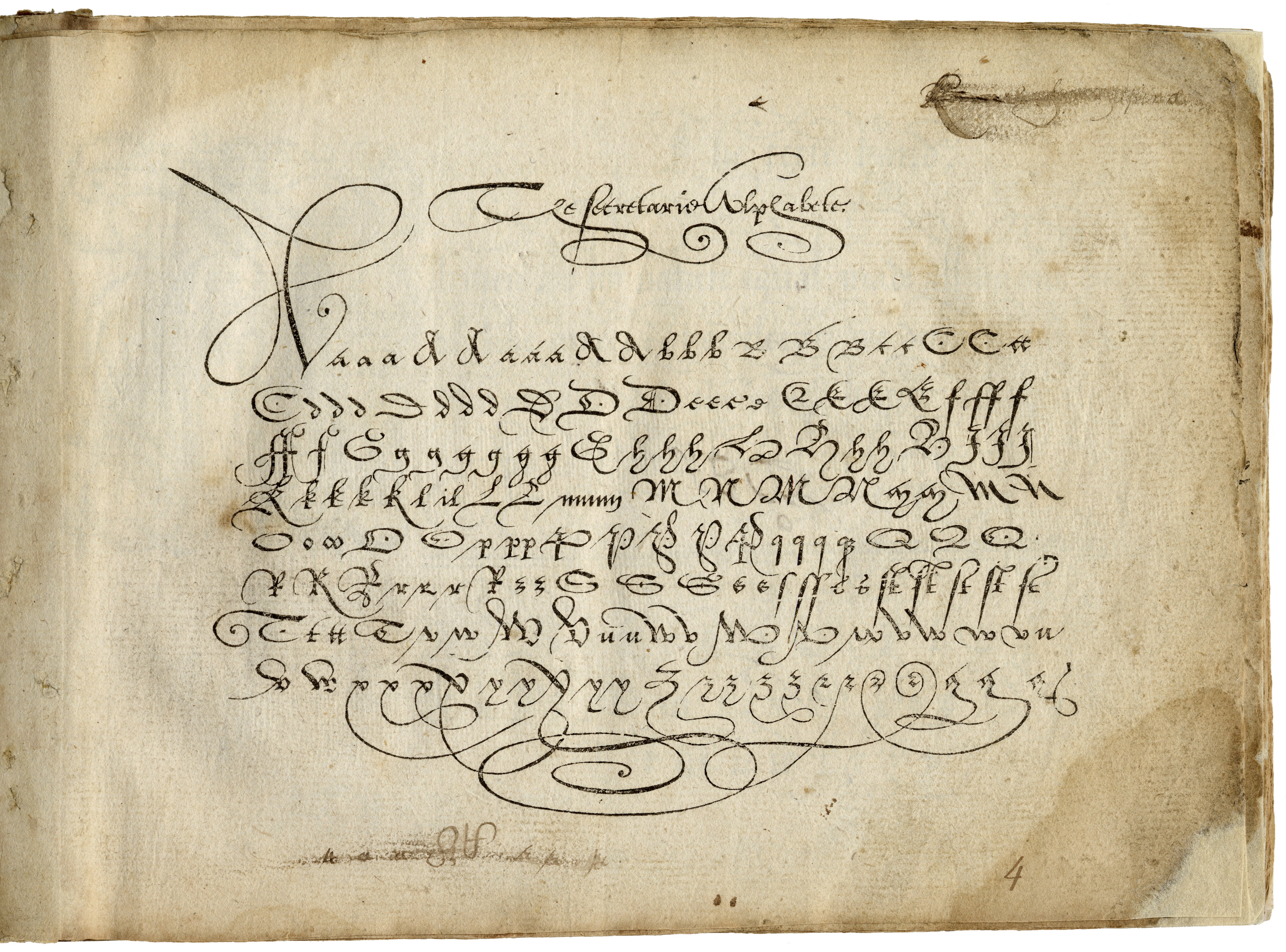
and e is not what I had in mind:
..and it seems nobody draws i with belly under dot, as if it was ė, but I did, I took pleasure in it, as a kid.
but looking at other people's hand I can see that e to i is like Б to Г. no, like Б to Г̇ or like Б to Г̣
Wtf is the minuscule b, no wonder I couldn't read the text above it. And it recollects bc.html, I copy that image to bc.html, whatever it is, it is fascinating. Let's notice what is unusual by lines:
The first line tells that it is not english, not only by alphabete instead of alphabet (notice the unusual h)
also because
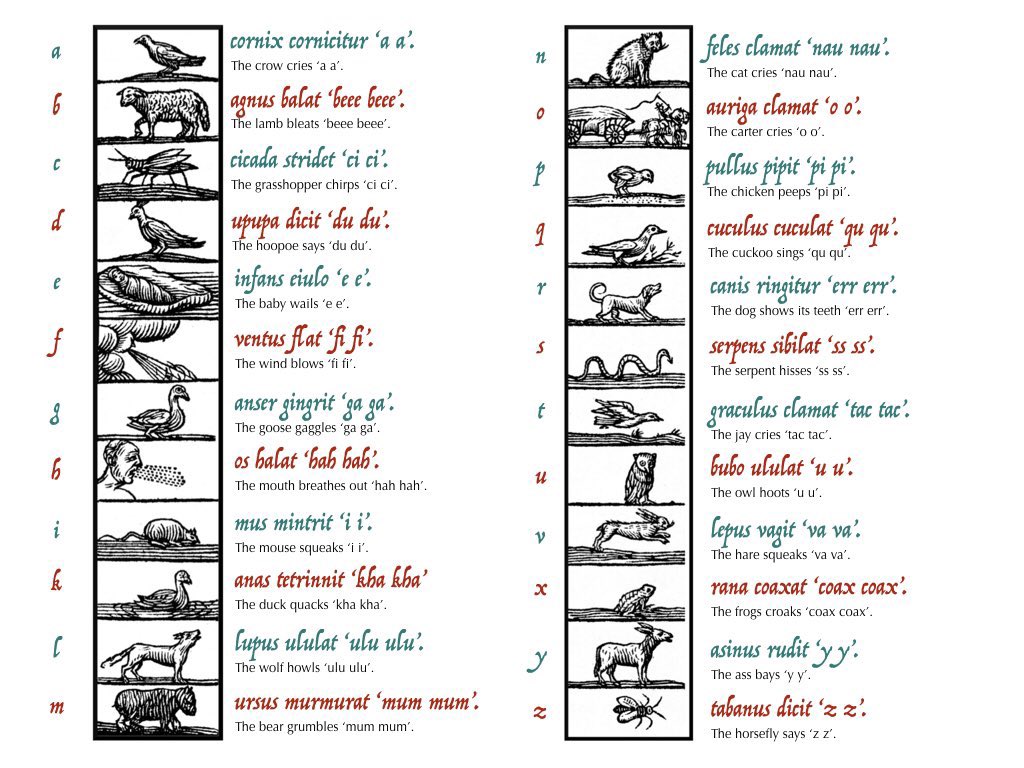
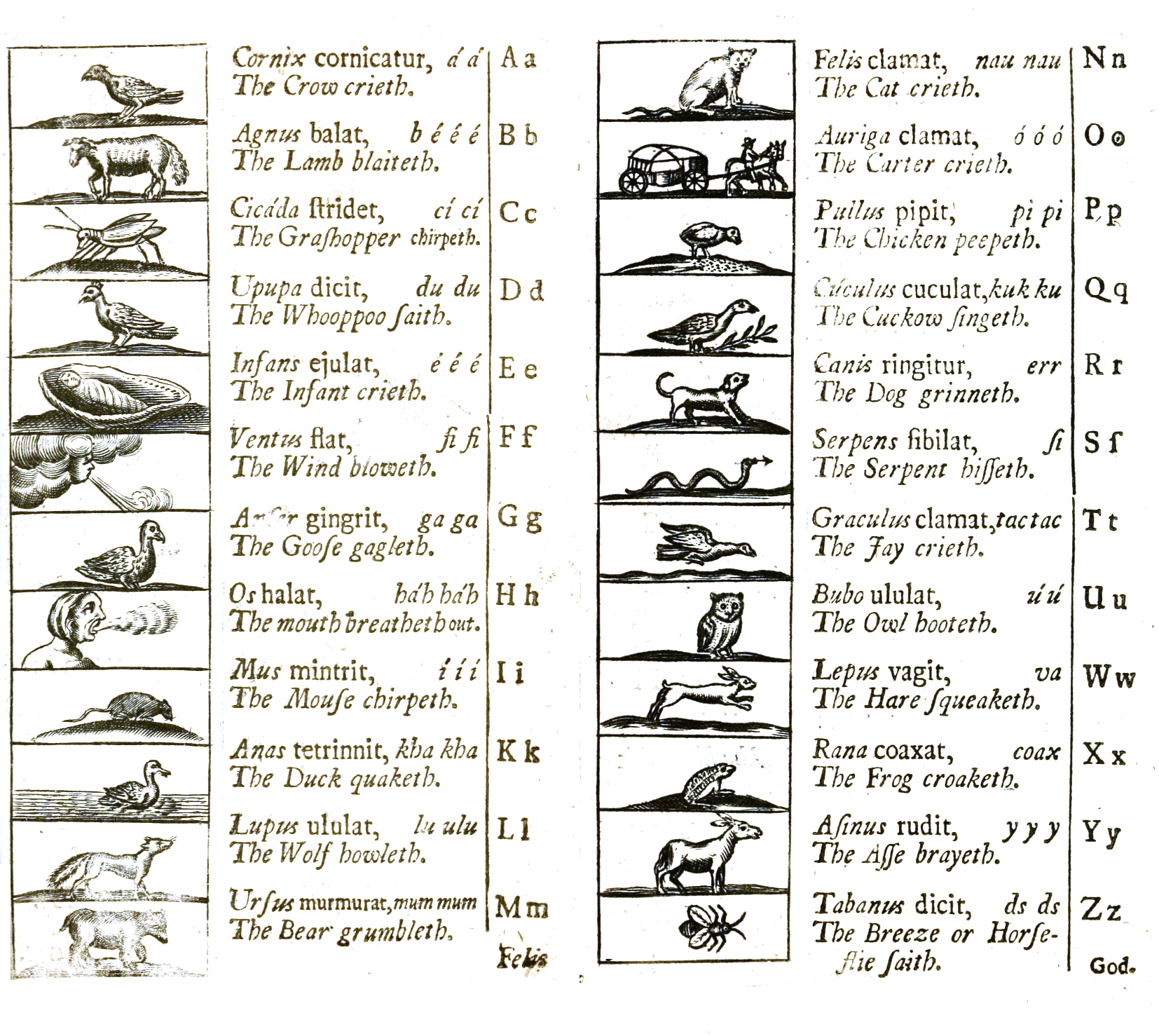
I was speaking of i looking like ė, and here Felis in older version is Feles in the newer looking edit.
And I took that e~i thing from eioua being ieoua, and because ᛂ is literally ᛁ with dot.
And because ᚠ~ᛘ and ᚵ~ᚴ~ᛚ~ᚿ and dots may tell where which letter appeared. If that table was accurate, G is from K, a voiced form of K is later, it's natural. And isn't it why G is also dʒ? Why? what's the meaning? Because C is that K, K is staved C, C is staveless K, thus ᚲ is staveless ᚦ. and it exposes ᚦ as Г more than Д, though ᚦ reminds not only D, but also Д (think of runes going from the bottom corner with ᚦ being rotated and thus looking like Д.

And here is example of lines without going no reverse boustrophedon.
But the line on the bottom of the text is upside down. And it seems to be in different set of letters from the main body of the text, and of the same set of letters as the left-most vertical line, and thern three lines at the top of the stone act weirdly: two of them go in linew we modern people do, but the third one flips to reverse boustrophedon. And of those three lines, two and a half go in the fontface of the main part, and then it ends with plenty of ᛟ, which is only used in the counter lines, and plenty of ᛌ's not used elsewhere, and it ends with ᛇ also not seen elsewhere. It all screams "fake" into me, but then I say it to calm down, I don't know what is the reason behind those discrapancies discrepancies (my english part knew that word and it knew it right, it fits here perfectly, while russian part didn't know what it meant)
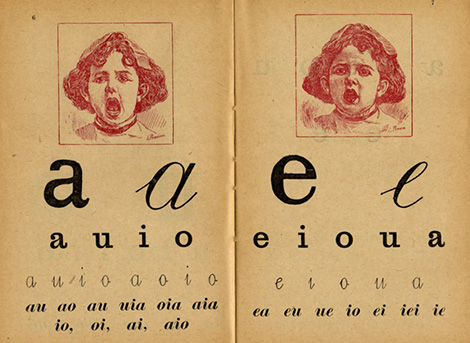
eioua, I told you, boey
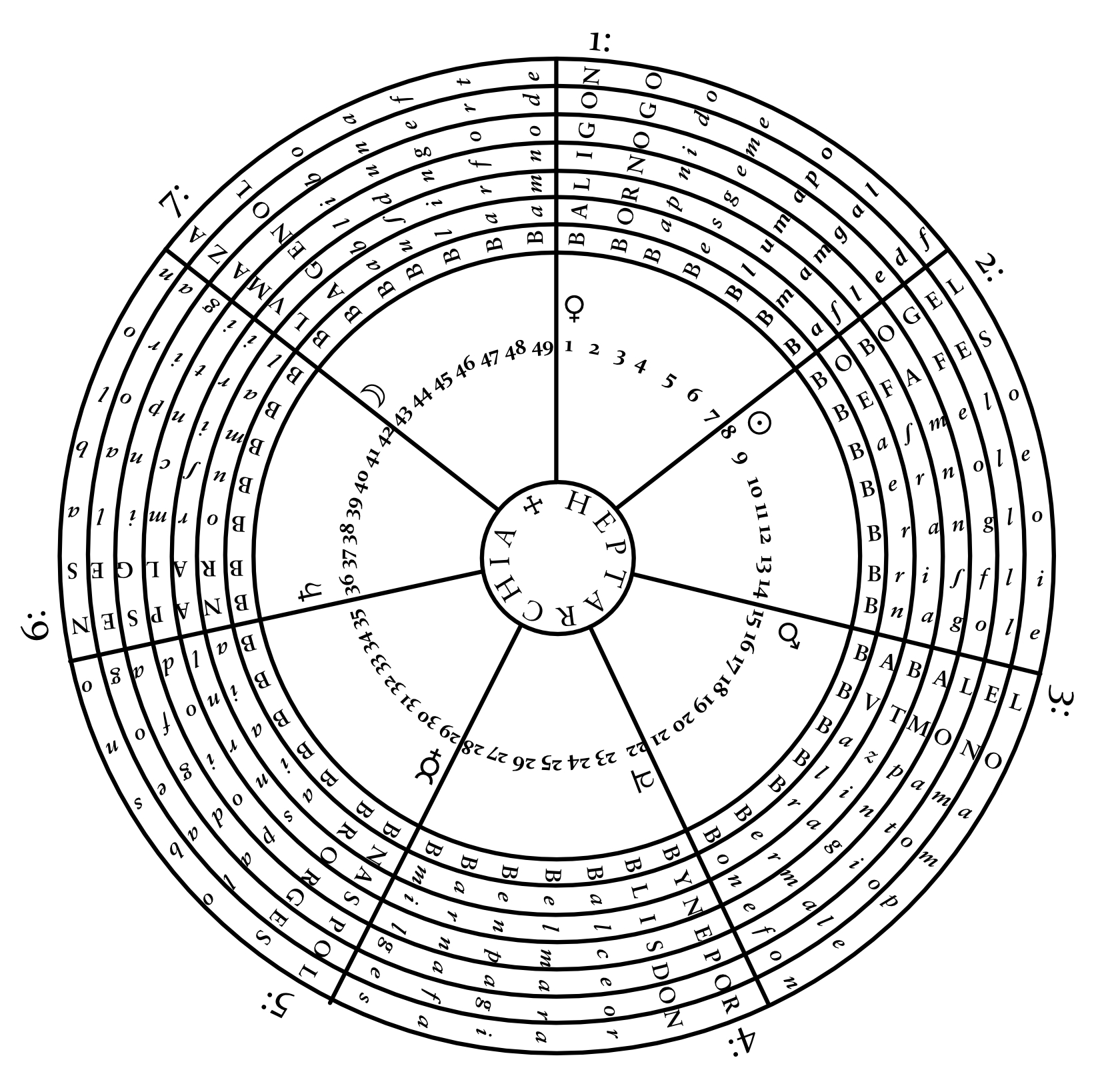 (mirror)
(mirror)
Tabula Angelorum Bonorum 49
I brought it here to show how B is the first letter, like ultimately, like so many times, like why
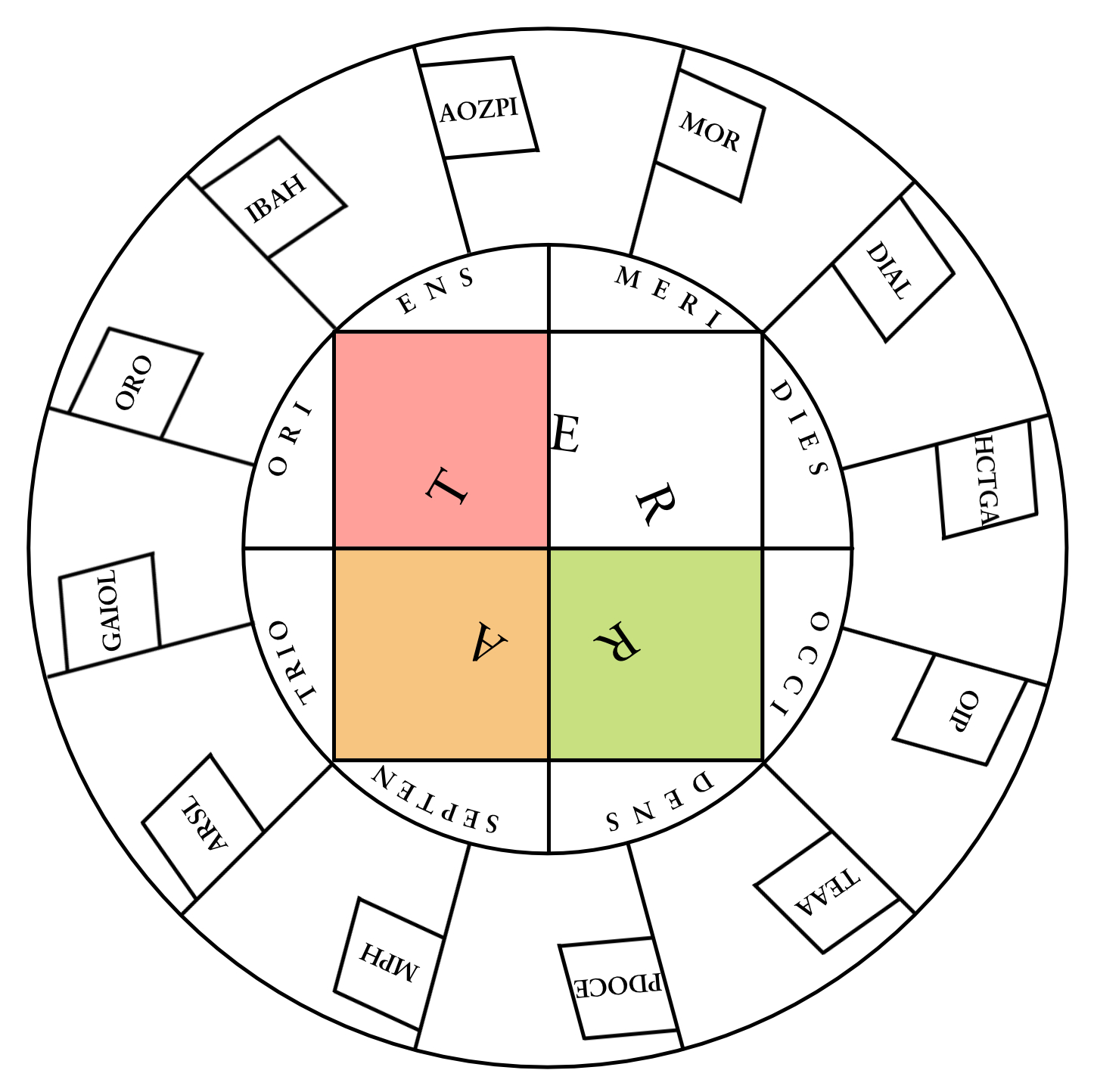
Duodecim gestata Vexillis
That book starts with O IEOVA ZEBAOTH, which is obviously O Jahweh Savaof, and it shows it's not Jahweh, not JHVH, but IEOUA, as I read after or before I rationalized it myself (I know I found it after I consciously figured that order, but chances are I read it and knew it subconsciously at first)
and g.t. recognizes IEOVA as Jehovah, so it is not some obscure secret name, it seems to be regular latin.
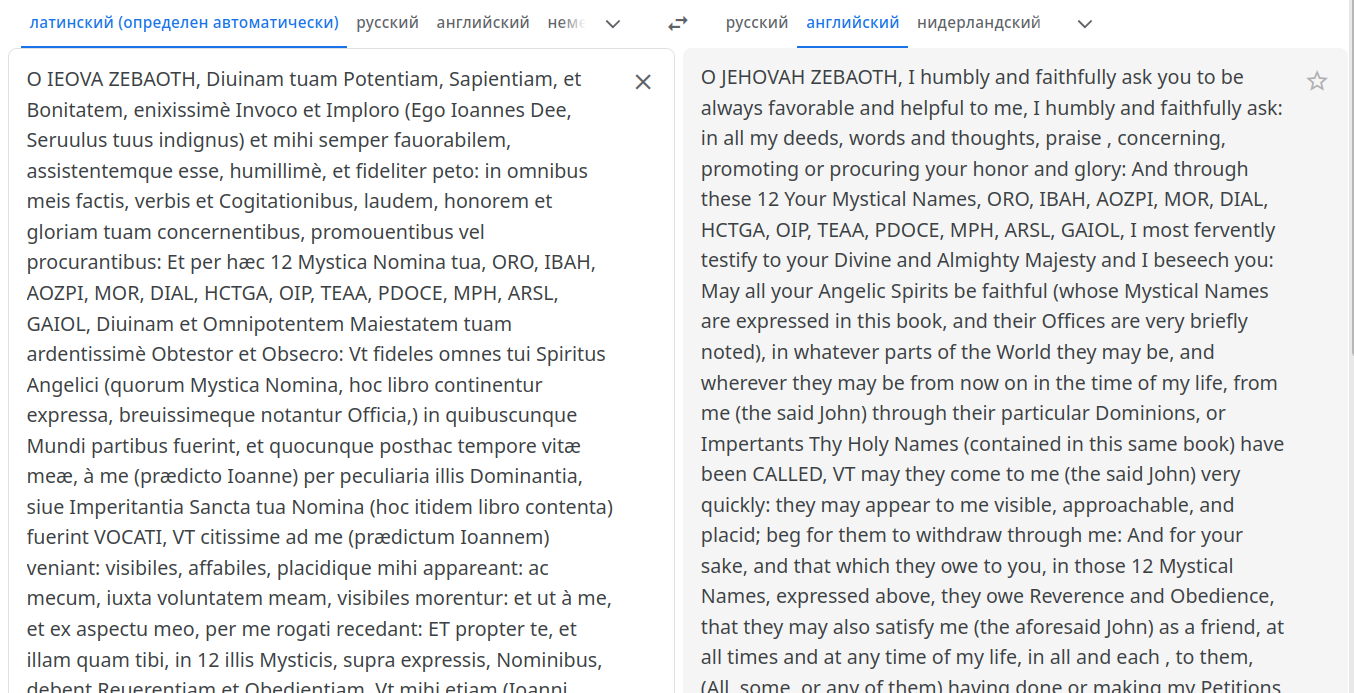
And I can read latin now! What an impressive technology. It seems some other guys are going to deliver what I was working for. Well, my approach is thoroughly different, and thus it is of value. I keep on doing what I am doing and at some corner I will come out first.
But I brought that duodecim gestata vexillis here because of two words catching my attention:
Meridies et Septentrio, because from the context I recognize them as north and south, and on the basis of південь~south and північ~north (even though now I can see that полдень is noon and not summer, and полночь is midnight and not winter. But why do I guess if those other words are west and east or morning and evening, let's ask g.t:
Meridies et Septentrio is South and North, but they remind me March and September. And march opens hot season, september begins the winter, thus north. Interesting theory, but let's not jump to conclusions
Oriens et Occidens are East and West. And they don't remind any months to me, but then they are etymologically speak about what sun is doing, while South and North are understood by the calculation

So, interesting shapes are:
a with a stave(ᚪ?)
b like k
c like г
D and d like Ↄ and ט
e as к and e as ט and reverse e
E as C with 2 in it, as if e is the second form of C (is i third then?)
E as Cz, and E as something different
double f as П, and what is that whirl at F and G
between g and h what is it? is it G or is it H?
some weirdest forms of H, which why would I recognize?
I as J, no big surprises here, only where is the minuscule fform? it's around l in il, but what?
only it is dashed. Why would it be dashed?
Some forms of M look like Ж, and is it related to ᛘ~ᛉ и Мать~Жена?
Some N also have a weird form, or is it M? M's and N's are mixed together, the couple of small ones after that, are they m or n or ŋ?
double o as ∞ is very sweet.
And then some O reminding D very much, even the dot, even the double column.
Some P's are very weird, one reminds handwritten ף, other looks like 4e,
Q's are normal (so are F's, does it tell that they're newer? look at the table above and its Q as Oſ)
R shows its direct relation to k, and one of its shapes is extremely off the wall,
some s remind з or ξ, some s remind σ, some s remind t!!!
some W's looking very much like M make me think of woman having that very W which is M
M of имею, м of моё
W от awe and owe and own, M от my and mine (ne in mine is probably の in 私の (is 禾 m, is ム(or 厶) い? ))
厶 Radical 28Radical 28 meaning "private" is 1 of 23 Kangxi radicals (214 radicals total) composed of two strokes.
In that previous typo I probably wanted to tell than not ing but ed, but my suc subconscious mind told that do is that ed.
do ~ ago (for go ~ иду (и энд а пробабли ар negating prefix un in (u ~ и (is un a form of in, which is a from af i, which is probably ã))))
X and Y look very similar, I would only recognize them from the context.
some z's are like s's with swashes and some z's are like wut
does the upper swash of a tell that it is something wider than o?
I can see how future and будущее are cognates, and in it I can see how ᚠ and ᛓ are the same, but I need more examples of english f being russian б (see how the belly of the б can be a swash)
And before I was speaking of ᚠ ~ ᛘ, so now I see ᚠ~ᛒ, the double wave up. but then the ᚴ~ᚿ thing tells that it doesn't matter if it goes up or down (one way it goes up, flipping into reverse boustrophedon it goes down, and visa versa)
is (cossack)казак косарь(scytheman)? (in hebrew a similar word חָזָק is strong)
(scythe)коса cuts and why did they call braid коса as well?
scythe and sickle share the sc part, в русском это понимается как с(off) к(to, but also k of cut and kill, somehow russians understand it when then place a finger to the temple to say kh to show the act of killing, конец is an euphemism of dead, мёртв) and кончать is an euphemism of kill, убить)
scythe is probably a cognate of коса, and scythians too. Is science of scythians?
which makes me question if scythians are cossacks
Now that is some place I should visit~! When the war is over maybe I will.
P T ?
graphically I can justify it as having less in ammount, less in size, less as loss (of leaves for example)
B more abundant than D (two lips and one tongue)
P is less abundant than D? voiced is bigger sound than voiceless, and T is both voiceless and tongue's.
so both graphically and otherwise they make sense, especially as
BD
ПТ
(voice is bubble for it's full of life as a leaf, voiceless is dry as a stick)
is wish to make the counterpart of BD staveless variant of them placed Ζ up front in greek to be З reflecting B? is c the opposite of d? c is great final letter, and t~s thing is noticed in many contexts.
Correcting s into c, I noticed that c can be seen as the upside down e
and if a and e are rotation of the same shape, then s and φ-like handwritten ש is the same shape as s:
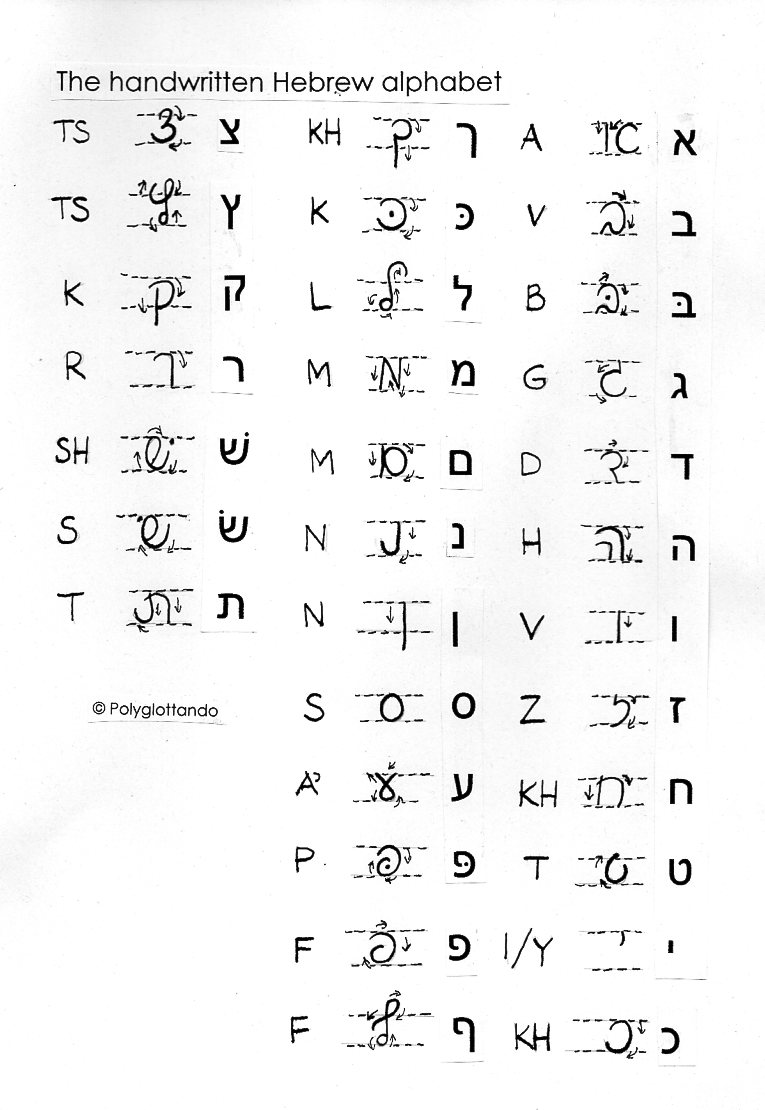
That ש looks like e, but they write the other way around. Look at ג, which is very much c, if you reverse it. And so is כ.
The same shape appeared twice in hebrew alphabet. Handwritten ג thus also exposess expocess?
it owned it and it gave it to us?
k in the printed one (reverse it left ot right)
it thus reminds ᚳ and h
And shows that ᚳ and h are c, as ᚳ~ᚴ~ᚲ
by fact.
Just as god is cognate of гад, so бог is cognate of bug:
B D
F Г
Μ Λ
П Т
W V
bd
pq
it is, and both q and d are g or, basically, c
> Ain is the highest and first of the viels. It is literally translated as 'nothing', or simply 'no'; it is absolute emptiness, the opposite of existence, complete absence.
> Ain Soph is the middle of the three viels, and it proceeds from Ain by necessity. It is literally translated as 'no limit'. If there is nothing then there are no boundaries or limitations; this is the limitless foundation - the eternal in its purest sense.
> Ain Soph Aur is the lower viel, situated closest to the Tree of Life, and it proceeds from Ain Soph as a necessity. It means 'limitless or eternal light'. Without any limitations, all things happen by virtue of the fact that there is no reason why they shouldn't.
In the light of this tradition, why do jesuits promote the big bang fallacy? Were quabbalists the good guys all along?
Well, I don't know about the good part, but even broken clock shows right time from time to time, and here they're likely to be correct.
And yes, some intellect is poured into that school of thought, so probably it is correct more than once or twice.
Is kabbalah of kaaba? (interesting, I find k more disrespectful than c (and q seems more respectable))
So C K Q are all the same in the context (as C S Ч are in the other
Наверное на веру? Верим в это? И оттого расхождение (наверное звучит как наверняка и означает может быть (но наверняка значит лишь 100% тогда как на верняка, на верняках, если несколько))
х[h] as plural suffix? точно, посмотрев все падежные окончания можно нарыбачить кучу суффиксов.
Братан наколол себе уэльского дракона с британским флагом на крыле, и я это интерпретировал как то, что дракон Георгия выжил, и наколол себе флаг хозяина на крыле.
Святой георгий на русском гербе означает, что мы за щитом Великобритании. И с кем она союзничала, с тем и мы. Русский король сотрудничал с немецким перед революцией? А великобритания захъватила нас обратно при помощи репволюции
The Church of Saint George in Lod (Lydda), Israel, contains a sarcophagus traditionally believed to contain St. George's remains.
The city also finds reference in an Islamic hadith as the location of the battlefield where the false messiah (al-Masih ad-Dajjal) will be slain before the Day of Judgment.
So does that depiction shows the future event? That st. George will be resurrected to slay the beast?
ве́тер ветра́ (и именительный и винительный)
ве́тра ветро́в
ве́тру ветра́м
ве́тром ветра́ми
о ве́тре о ветра́х
Таким образом ударение меняет время, т.е. время изгибает ритм.
Таким образом ударение меняет число, т.е. число избегает в изменяет ритм.
измеряет~изменяет (это можно в учебник физики в раздел квантовой физики внести)
но это лишь в этом контексте может быть, давай другие посмотрим:
сначала ритимически похожее на ветер
ко́зырь козыря́
ко́зыря козыре́й
ко́зырю козыря́м
ко́зырем козыря́ми
о ко́зыре о козыря́х
чуть иное ритмически слово
де́рево дере́вья (до сих пор именительный и винительный совпаадают)
де́рева дере́вьев
де́реву дере́вьям
де́ревом дере́вьями
о де́реве о дере́вьях
в этой ритмике ударение всё также сносится правее, но не на два слога, а на один.
ме́л ме́лы (но блин, это слово всегда в единственном числе
ме́ла
ме́лу
ко́л ко́лья (именительный и винительный совпадают)
ко́ла ко́льев
ко́лу ко́льям
ко́лом ко́льями
о ко́ле о ко́льях
Т.о. если в слове два слога, то при множественном числе ударение смещается с 1ого на третий,
если в слове три слога, то при множественном числе ударение смещается с 1ого на второй.
а если один, то на нём и остаётся? проверим. А при четырёх слогах?
полоте́нце полоте́нца (именительный и винительный похоже что совпадают почти всегда)
полоте́нца полоте́нец
полоте́нцу полоте́нцам
полоте́нцем полоте́нцами
о полоте́нце о полоте́нцах
если четыре то тоже не меняется ударение?
революция: при пяти не меняется? Но я уже зашёл на территорию женского рода, насколько помню, здесь другие окончания, может и система ударений другая? зацени:
блю́дце блю́дца (но я нечаянно взялся за средний крод, но им and вин совпрадают)
блю́дца блю́дец
блю́дцу блю́дцам
блю́дцем блю́дцами
о блю́дце о блю́дцах
исправляюсь
таре́лка таре́лки
таре́лки таре́лок
таре́лке таре́лкам
таре́лку таре́лкуи только в единственном числе винительный падеж отличается от
таре́лкой таре́лками
о таре́лке о таре́лках
но и в русском мужском роду то правило не всегда выполняется:
баго́р багры́ (им энд вин совп.)
багра́ багро́в
багру́ багр́м багра́м 50грамм
багро́м багра́ми
о багре́ о багра́х
т.е. ударение изначального слова значит больше?
му́сор мусора́
му́сора мусоро́в
му́сору мусора́м
му́сора мусоро́в а здесь винительный с родительным совпадает!
му́сором мусора́ми
о му́соре о мусора́х
мусор или мусора в зависимости от значения, но в одном из значений слово мусор всегда в единсвенном числе (и это пример неисчесляемого в русском языке (но, в отличие от английского, много на мач и мэни не разлагается))
при этом ударение ведёт себя так же, как в козырь и ветер, но обнаружилась аномалия, я понятия не имел, что винительный принимает форму то именительного то родительного падежа, раньше я просто (да и все остальные) лишь знали, что какие-то падежные окончания совпадают. И (даже если специалистом это всё ведомо и классифицировано, проще переоткрыть эти закономерности, чем в их некаталогизированном многословии эти классификации искать) давайте выясним что влияет на поведение ударения и окончаний винительного падежа
Предполагаю, что винительный падеж матерный, а матерят лично или родителей.
в местоимениях винительный падеж отличается от всех, давай в местоимениях посмотрим
я ты вы мы
меня тебя вас нас
мне тебе вам нам
меня тебя вас нас
мной тобой вами нами
обо мне о тебе о вас о нас
(a не совсем последовательно их расположил, но множественное число отличается от единсвенного, суффиксы множественного числа совпадают, но погоди..)
но родители вас звучит не по русски, значит это неверное употребление суффикса стало нормализовано, но не перестало от этого быть неверным? ведь надо мои твои ваши наши, но это отдельная песня, это фрактал или просто кроличья нора внутри кроличьей норы)
давай рассмотрим местоимения множественного числа мои твои ваши наши их.. я забыл третье лицо, но там суффиксы совсем другие будут. множественное число распадается на рода, и тоже на три (три по три (по три? и плюс четвёртое, множественного числа (хоть я и про средний род сначала забыл, он она они только видел, но даже в английском he she it they)))
он она оно они
его её его их see! here is no other variant other than the possessive pronouns!
ему ей ему им
его её его их но смотри, здесь винительный падеж этими притяжательными является
им ею им ими
о нём о ней о нём о них
ею иногда обращается в ей
(и очевидно, что средний род это выпердыш (ц and щ demanded the place of ш) мужского, т.е. мужской род, который в именительном кажется женским (полотенце, блюдце) но в остальных падежах ведёт себя как мужской)
fuck, this subject overwhelms, so no wonder I could never grock it.
Roman numerals are real predecessor of modern decimal mal, why mal? decan? octal же decal, а, потому что кал. те, кто заведовал языком, обосрали термины нового поколения, вот же обезьяны.
Я отменяю k-stolbets, kak ya romane otmenale bukvu k, voobsche dazhe chtob zvuka takogo ne bylo. Is it ht e birth of G?
did they invent god after the predecessor of the alphabet was invented?
isn't K Kronos? in greek it definitely is.
Cronos, Qronos, even Xronos, naturally it is time itself, quite an abstract concept.
Gronos? no, this is on the opposite side of the k, h is the old g, g is the new h. And before hronos, it was just abc? a b d? bd?
bd
pq
So, the same form? two forms, ☯
So alphabet bust must have appeared where they had known ☯
OR, ☯ appeared where they used aбgдe (chinks recognized that symbol as "o, tai chi" and me russian never knew that name, though I knew tai chi as a gymnastic slowmove)
Large magic wand (combination of wood and crystal (I wonder if chinese recognizes it, or hexagrams))
Hexagrams, I was so close to decypher it with them.
Pythagoreans were ghost writers of Pythagoras
(were they his ghost writers after his death? They probably were, that is what culd does: not many people know who wrote bible, it is as if attributed to god himself. But then scholars know the actual authors of bible (but then they argue that Moses couldn't write the Exodus. Naturally he did not, unless he predicted the events written in that book. They walked 40 years, because he thought he will see the transcendent vision of the "promised land")
земля обетованная звучит как земля обитаемая (и тогда бы в предыдущем контексте она была обжитая духами, чтоб люди строили там, где духи град воздвигли. Зачем бы?
Но обещанная в этом контексте значит реально предсказанная (и тем типа доказывающая, что и всё остальное было не пиздёж)
Do words феи и музы (фея[feja]~[muza]муза) show how far the same protosound can deviate?
Because technically fairies are muses are fairies.
Очевидным вдруг сделалось мне, что сынки всех тех жёстких типов, что у власти, затюканы своими же жёсткими батьками (а те, кто сохранили стержень, не сломались, не прогнулись, (став не стержнем а скобой (скрепой?) в коленно-локтевой, как сынки что при батьках остались) либо съебали из этой копро-тусы, на запад конечно, не к корейским же братушкам) и неспособны быть такими жёсткими, всё проебут, причём очень повезёт если не самым бездарным способом. Надежда на принцев, что уехали и их вся корруптомолодь знает, и они умудрились сохранить хорошие отношения с ключевыми фигурами этого аристотостада. Но это какая-то сильно дикая фантазия, крутые если съебались, то явно у них другие планы нежели царствовать над этим всем.
Наверное придётся иучать изв изучать ритуальный каннибализм, ибо колдуны знали какие железы кушать чтоб пёрло. Может быть у животных съедали самые вкусные части. В той стране, где куру-куру зафиксировали, там точно сохранились верования каннибалов, наверняка и антропология про этой теме следовательно проведена.
(следовательно там было для красного словца, от слова исследование типа, но грамматически не следует, хоть и более чем вероятно)
I think I should издать три (хотел сказать две) версии книги:
в том виде как написано, экстатический текст со всей глоссолалией
в отредактированном варианте (как буклет (буклет слово плигодное дла детского изика, блосула не отень (т, а не с, потому что нефрикативная, хоть и транслитерируется как тщ, если тянуть, то очеслышно переход чщ, ч почти щелчок, как и ц, и быть может ч и ц когнатные морфонемы к африканским щелчкам, но это лишь educated guess, sorta educated, I know about clicks only that they exist)))
и в третьих упрощённый текст, для иностранных читателей: где "более чем" заменяют на "очень"
потенциально и четвёртый вариант мерещится, в детском изике
15 runes of Bureus (he took it them from somebody, as an anthropologist. Because some villages used runes up to 19th century, and vicious revival of the norsk culture in the 20th century was по горячим следам от осознания того, что их культура не используется больше)
15 runes of Bureus reflect 15 runes of Carmenta, so (unless he fabricated them after her image, leaving one behind intentionally, which is an incredibly audacious supposition, and it doesn't change much: 16 runes are closer to the 15 than to 26, and that could be the butthurt of rome, christian and otherwise, that germans have kept a more basic script (by preventing masses to know about it, probably, otherwise why wouldn't they write books with it) and thus campaigns against it are caused by semitic rascality) those are probably the same system, and because
So, some structure could there be. We know of 3 aettir, and 15 can be divided only in 3 and 5, so 3 by 5, which reminds ogham.
I read into my own work, written maybe 4 years ago, in 2019, it's late november of 2023, and I do not recognize what I knew then
And I compared ᛆᛒᚦ with ᛄᛓᚦ of fbthark, those ᛄᛓ are forem of ᛆᛒ but if ᚦ is third in both.
but I checked and indeed,
ᛄ A letter of the Runic alphabet, present in the Elder Fuþark (ᛃ), the Anglo-Saxon Fuþorc (ᛄ, called ġēr), and the Younger Fuþark (ᛅ, called ár in Old Norse), representing /j/ in the Anglo-Saxon Fuþorc, and associated with the year or the harvest.
but I took it from wiki, anybody could write it, it is not wikipedia, it's wiktionary, so no links to sources, but I think they are also moderated better, I don't know why, but I have the feeling, that trolls attack those laconic pages less, and them being laconic may keep them under more thorough check, but it's mostly an assumption.
> associated with the year or the harvest..
> called ġēr
> called ár
isn't it year. isn't ᛃ год? gg? gд? half of the year is closer to the sun than the other. Doesn't ᛃ show tilted yearth? Does word year links the change of seasons to earth and not sun? Sun is the same s-n, samenNL
samen ~ совместно (yes, probably cognates, maybe constructed in russian of russian elements by dutch specialists to sound home, intentionally or accidentally, or the mis similarity of those words is accidental per se)
What is the easiest way to draw a tree? ϒ but no, this is grass, tree is T (it has storeys, you can seet on it
T is for Tree)
Other way to draw a tree is ᛘ or ᛉ, but san (both three and mountain in japanese-chinese (japanese still use old chinese readings of hieroglyphs, and which form of chinese (which chinese language) brought chinese to Japan))
M is for Mountain ᛘ is probably mountain road. two mountains are at its side, and such form is closer to chinese shape: 山
Chinese roots of runes tell that runes are older than other alphabets. But what if M (alphabetic shape, not runic shape) was egyptian way to draw mountain: 𓈋
𓈋
Representing two hills framing a wadi. Compare the Chinese character 丘. The hieroglyph was generally colored yellow or pink with dark spots to represent desert and rock, and sometimes its base was colored black or green to represent cultivated land. Archaic forms (and occasionally Old Kingdom and later forms) show the outer sides sloping instead of vertical. The phonogrammatic value of ḏw is derived by the rebus principle from its use as a logogram for ḏw (“mountain”).
Dw (ḏw)
Biliteral phonogram for ḏw.
Logogram for ḏw (“mountain”).
Determinative in mntj (“the two mountain ranges”).
Determinative for names of foreign countries, by confusion with (𓈉).
Representing the sun rising or setting between two mountains. This sign first appeared during the 5th Dynasty.
Logogram for ꜣḫt (“place of sunrise or sunset”).
btw, wadi (plural wadis or wadies)
A valley, gully or stream bed in northern Africa and southwest Asia that remains dry except during the rainy season.
Synonyms: nahal, wash
G-D Gospod-Deus? God-Devil? It would be rother chonese, but oi thot of jewish
Gnostically? Yes. I am insane. It is intense.
Did jews brought culture to europe from japan? Mere phonetic similarity is not accepted to be a proof of anything. Modern consensus is such, but then isn't breaking the consensus what a researcher should be doing?
Sometimes I recognize that I am a fool. Which rises question: how do I know that my science is good?
керований is transliterated as [keˈrɔʋɐnei̯] thus russian ы (украинское и) can be transliterated as e
ъеьэюя.. are they all forms of some omega? emega? юсы.
юс большой, юс малый и их йотированные форм? и действительно ётированы лишь два из четырёх, and both stand in the end. What are ъ and ь? Probably some reduced vowels, I need to check ancient russian manuscripts to tell. Bolgarian manuscripts, the words which cognates contain ъ and ь today, no matter in which language, in all forms and shapes. The only way to really know.
Friday fry! Saturday сатурналия. Sunday is about sun. And again we go more sophisticated, to Moon, Mars, Mercury, Jupiter, Venus, and this disparity I think I researched before, but i'll leave it to historians of astronomy. In this draft I raise question much more than I give answers to them, because everything new and unverified by further research is more of a question than of an answer.

Saturday.. english preserved the planet. The planet of Saturn. This is the god of the Jews. But how did they know? How long have they seen?

They say we saw it first only in the 1980s:
So is it some queer coincidence that jews selebrate saturday and that they have hexagram associated with them and hexagon is on saturn? Or do they secretly have astronomic technology not known to others? Or did they preserve some cult based upon some concepts of previous civilization?

these tables are rather fascinating, I wonder if they're true or not, I'm clueless and just guess yes

Is Bad general term uniting Mad and Dead?
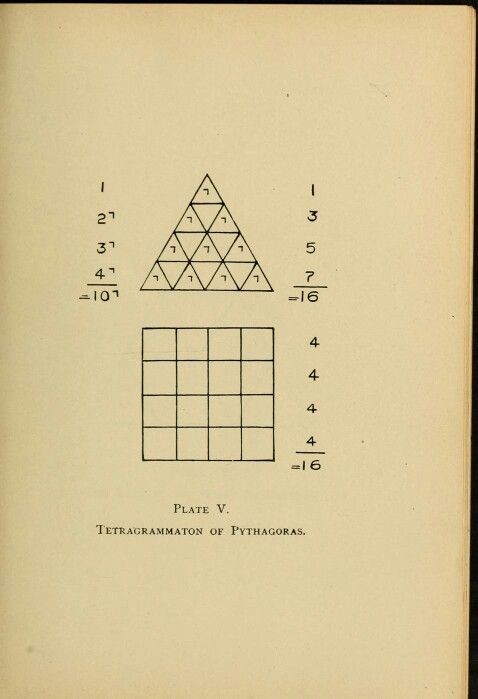
if this image is true, 16 played some important role in Pythagorean school of thought.
And in this light runes of youngef futhark could be connected to that tradition
and once again, some roman cursive
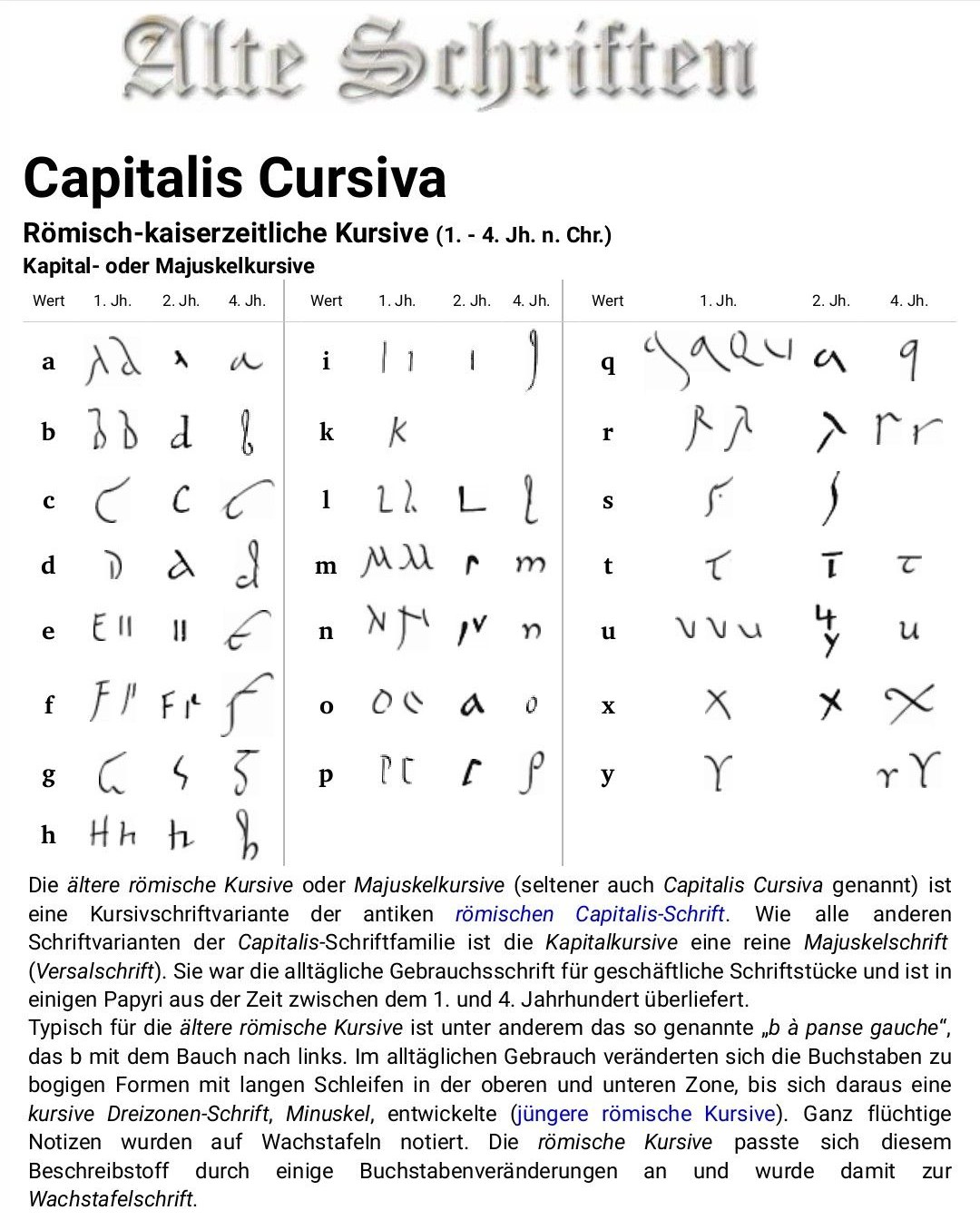
you've got it right this is another random collection,

J . Bücking, Anweisung zur geheimen Correspondenz systematisch entworfen c. 1804. Massachusetts Institute of Technology, Libraries, Institute Archives and Special Collections
.png)
Original author unknown, cited in Abraham Rees, Cyclopædia (1778) David Loberg Code

This music cipher was supposedly proposed by Michael Haydn (brother of Franz Josef Haydn). It appears in an appendix to a biography about Haydn by Werigand Rettensteiner published in 1808. David Loberg Code
A e O e U I? and I could only find that aoeui is how dvorak goes
but then I understand, that
A͡E = Ä
O͡E = Ö
U͡ I = Ü
and I also learned that this symbol of legato is called in english slur
швидко ~ ф (fast?_)_ ~ swift
swift ~ quick: K asn s and S are two different ways rt to read C
ш is another way to read the same с
So if k~ш~s are the same thing, read with different accents, I guess.. I can find the protoshape?
K is staved C
q is staved C too
S is what? C with swash, Çç literally tells that S is C with that ,
ABC is thus all other lines. Aeiou are all arbitrary, you can sing vowels as high or low as you wish and you can depict them with any mof many.
В is read as V in russian
V is read as F in german
F is vow voiced in hebrew
F is read as W in hebrew
e f just opened as "et vow" get high! (I'm already high for the sackoned time today, it's 22:12 and I translate from my mind, which probably works on this stuff overtime, and as you may see, gives some fruit)
abe dius deus was opened as the first line
e f has no sense to be "et vow" in this case. abe deus et.. feir feya
faRie~феЯ (naturally ie is уменьшительно-ласкательный суффикс, ласкательный меня в детстве всегад выносило что wut)
et fag? fagh? fgh
ab gd eve gh? goddess~gh? dess~c~г~ч~h? dess~ц принц? принцец? принцесса, ss is female, puSSies is a derogatory term in military.
LMN was opened as LioN (io~me)
i and o are vowels around LMN (especially in italian and irish)
not Lemon, lion, LIMN? ILMNO? el Muno? lal lune
llune ~ юн? was lune only used for young moon? hardly so, but as raw and naked guess, let it be grey
see, so far I only guess, but recognize it as sophisticated poetry, the ultimate pangram, pangram having letters in alphabetic order (pangrams allow to repeat letters, as both initial letter and letter in use with others.
ABe G-D (was that - why many abrahamists write like that?)
EVe ..exactly, I must use kikk d kiddi alfabet
(what iuf abe was how it went. literally.. as in saom e paleohis.. alpine

and if venetic reads г as ɪ, they have aie as the opening sequence, as some writings systems do
(maybe I should add s instead of whole word)
And then F is their first labial, following the vowel sequence. AIE VDHT and T finishes the first line. And on goes I.. again? could it be й? no, vowel, but why K? why k is always there? Why do hindu have them first? L so much ᛚ, so shapes existed long ago, L and ᛚ and Λ show the same symbol. Camunic variations of L show that rotation can be either way. up and down left and right, mirrored.
left and right orientation of ࿊ are same symbol.
if that thing about ࿊ is true, RUИ~Nof and
but then is vertical sense of L distinguish it from ᚲ and makes it leg?
I thought B is leg? B is foot. boot.
обувают лишь стопу.
V[U] makes company to Г and L
and it makes perfect sense. BGD are the three bases of paleohispanic.
VГL are those three. Is there hidden one? J[й]
and isn't j~l? see those shapes.
and doesn't it demand Ʌ[a] or Λ[l] or 𐤂[g]?
So all three are ^, v is also ^ in ᚢ and see u in this one, taking both shapes.
Просто прелестная мама у меня
Но я должен добиться признания,
чтоб все её жертвы ради меня не были зря
Вернее, они уже по факту не зря, но хочется чтоб и она это знала.
Для того, чтоб окружающие признали мои заслуги, эти заслуги должны получить признание.
(но к чему я это говорю? для возможноно читателя, чтоб в стол совсем уж тоже не писал)
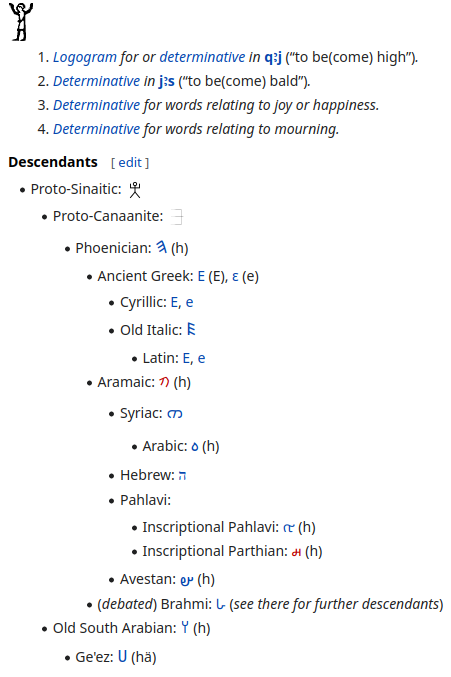
but the meanings 2 and 4 don't seem to be correct. Why would it mean bold? To censor getting high. Why would it be translated as to mourn, if they got high? Definitely some misconceptions in egyptology I came to figure out, and naturally I will have to use ai knowing those writings systems.
I don't know if this may tell that dice indeed was used in ancient times for something other than recreation, because even though Lincoln sounds american, it is from an old english church:
.jpg)
"And Aaron shall cast lots over the two goats, one lot for the LORD and the other lot for Azazel." Lincoln Cathedral
The main difference between jewish and christian faiths is
that jewish faith allows sin, it just invents way to
circumvent the sequences, even if originally they invened
way to get rid of them.
In sefer habahir there's answer to the question I asked:
LMN is Loves Me Not (I was looking for jисус кристос loves me, but N was right there)
Only Pater Que Rests Sitting in the Tree? Were they having trees so tall that clowds clous clouds rested in their crones ск krones thrones crowns
Were diamonds in crowns used to fool people that sun itself lives in that thing?
Were tree so high it produced clouds? By breathing? By evaporating what it drank from earth.
We have to model world with much larger trees.
Only if today clouds are formed above forests. It's hard for me to imagine desert with clouds.
Clouds are natural habitat of forests. Of green in general. But forests are mythier. mightier, multilevel.
(clouds and forests are symbiont, one is the natural habitat of the other)
Be is blessing.
Abe is father, and literally anti-be (instead of be, and a as a negating prefix)
B is the first letter, because it is blessing.
is K the way to say bless you in hindi? आशीर्वाद [aasheervaad] blessing benediction felicity benison
अभिमंत्रित करना [abhimantrit karana] bless invoke
प्रदान करना [pradaan karana] provide endow bestow confer supply bless
गौरवान्वित करना [gauravaanvit karana] glorify dignify crown bless
वरदान देना [varadaan dena] bless
only now have I finally learnt that [] are both typed by pinky (in qwerty) before this moment I didn't know it either consciously or subconsciously, so I always had trouple with them
and I like that karana thing, it fits my needs as a candidate to compare it with the writing system (and I especially like na syllable, because of -n being final in japanese, but then I know some writing systems in the region, and I assure you it is a reformed take, originally it is wu, but they began pronouncing final syllable as n, so they don't teach wu anymore, but they still teach ha, but it is because it is still ha most of the time, but once that changes, somre reform of interpretation of the writings system will take place, until they deviate to alphabetic set. So I saw by my imagination.
Benison is a cool word. And together with Benediction it tells that Bene is what Basically is B
And GooD is in there by the will of angles? Runic culture gave birth to alphabet, imagine their shock.
But first it was roman. Truly? Are all roman abecedaria fraudulent? I should research the unusual abecedaries. I bet the unusual ones keep some keys, unless they're mere mistakes. Some abeceday beginning with B can not be a mistake. But then will it be preserved, if later generations will tend to add A up front. See, front is also convenient for adding the letters. So is AIEFGH of venetic the actually a primal order?
保佑[Bǎoyòu] is bless in chinese. And probably thus bopomofo is the way they start their abc, the way they name their abc, and regardless of the graphemes, the order can have a deep history (history instead of story is probably a jewish way to say istoria, so all russians use that ה, which is (if we trust phoenician order) e, not и, thus eсторее [estoree (ещё старее (когда кто-то обвиняет, а другой защищается, рассказывая предысторию))]
I will not be much surprised is if Thot is originally Sun. But here I feel physical discomfort around my shoulders and navel, because Jah is Sun. Rah!
But then I think orphics taught that all gods are incarnation of the same force, so they taught what later socrates taught? monotheism? But can I trust GRSMead? I read his book, but only because it is small and I must keep on reading, but why? Internet is much better medium of new information than books you have to read for hours to find something useful, even if, some books are empty, just movies, or worse.
All words are the same ABC in different forms? But then ABC is three letters, and I think
Suddenly it came to me that gangstwer mentality of russians is fed by their media products: when good guys were shown weak, and their songs sucked, but bad guys were always shown cool. I think the same shit is transmitted into american heads,
But then suyat sequence supports that karna sequence, but what does it matter, if karna is do and not bless? karna~karma (incarnate has that very karna as its root? see, if the languages are similar stories of one reveal stories in the other more often than russian and japanese or english and japanese, and those distant languages do deliver, so imagine the flow of revelation even wider, my fingers can type in only this much)
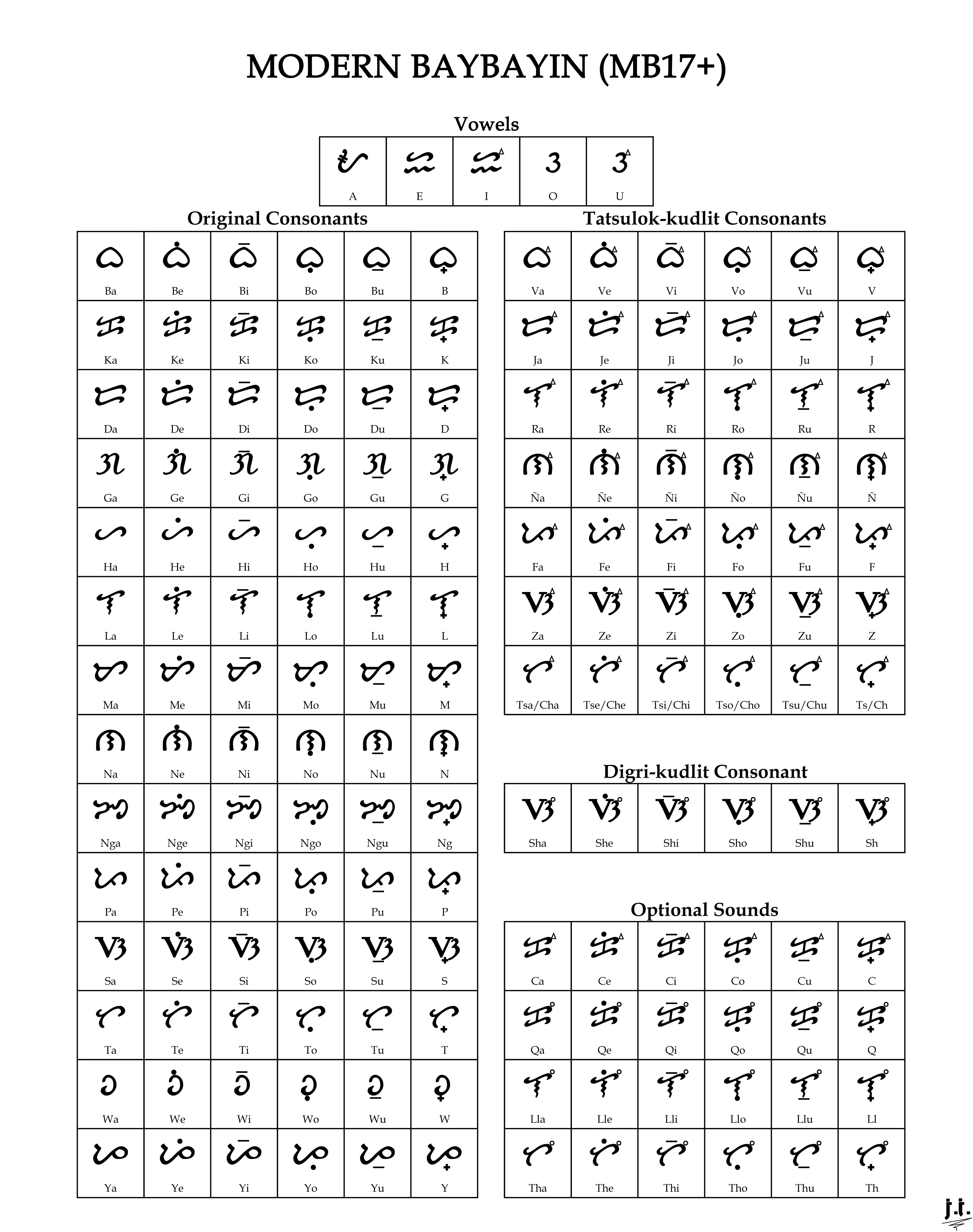
They say it existed in philippines before christians came, but is the sequence genuine or influenced by europeans. If we see that R is not existant, and we take L as that r in carna, we recognize L~r just as in camunic ᛚ rotated wherever the way, while it stayed vertical. But technically no sideway ᛚ can be seen in their set of letters, so technically you could twist too, as we naturally do, but it was not shown in that table several pages ago, so I guess they didn't have it, as we twist our letters, but we don't lay them on back, but upside down.. russian g and д are both d. Yes, we still do that. And d~D too
Dg is interesting letter.. isn't it that arrow-like ᛚ? like ᛚ~ᛐ~t~d, so abt oпт is almost all. Если всё заберёшь скидку сделаю! Technically опт is not all, but lot, but then ..what? It could be a synonym of all in the past. But it is only a speculation. Yes, it is.
That baybayin in abakada order,
Either way, that kaganga is the first time I know how this sequence is called. I wonder if kana is from it, I guess it is.
I think in the case of kaganga I don't image that I imagine the sequence makingh the name, because I do not imagine the sequences, I am good at noticing them. And though naturally some chaotically born sequence of the kind were possible, maybe some knowers kept the knowledge and monitored cultures to avoid those blasphemous ocasions. As to take blasphemy as order could be taken for plasphemy, but then isn't it what it was? no galshemy would be the world.

Indigenous Philippine shrines and sacred grounds are places regarded as holy within the indigenous Philippine folk religions. These places usually serve as grounds for communication with the spirit world, especially to the deities and ancestral spirits. In some cases, they also function as safeguards for the caskets of ancestors, as well as statues or other objects depicting divine entities.
Ancient Filipinos and Filipinos who continue to adhere to the indigenous Philippine folk religions generally do not have so-called "temples" of worship under the context known to foreign cultures.[2][3][4] However, they do have sacred shrines, which are also called as spirit houses.[2] They can range in size from small roofed platforms, to structures similar to a small house (but with no walls), to shrines that look similar to pagodas, especially in the south where early mosques were also modeled in the same way.[5] These shrines were known in various indigenous terms, which depend on the ethnic group association.[note 1] They can also be used as places to store taotao and caskets of ancestors. Among Bicolanos, taotao were also kept inside sacred caves called moog.
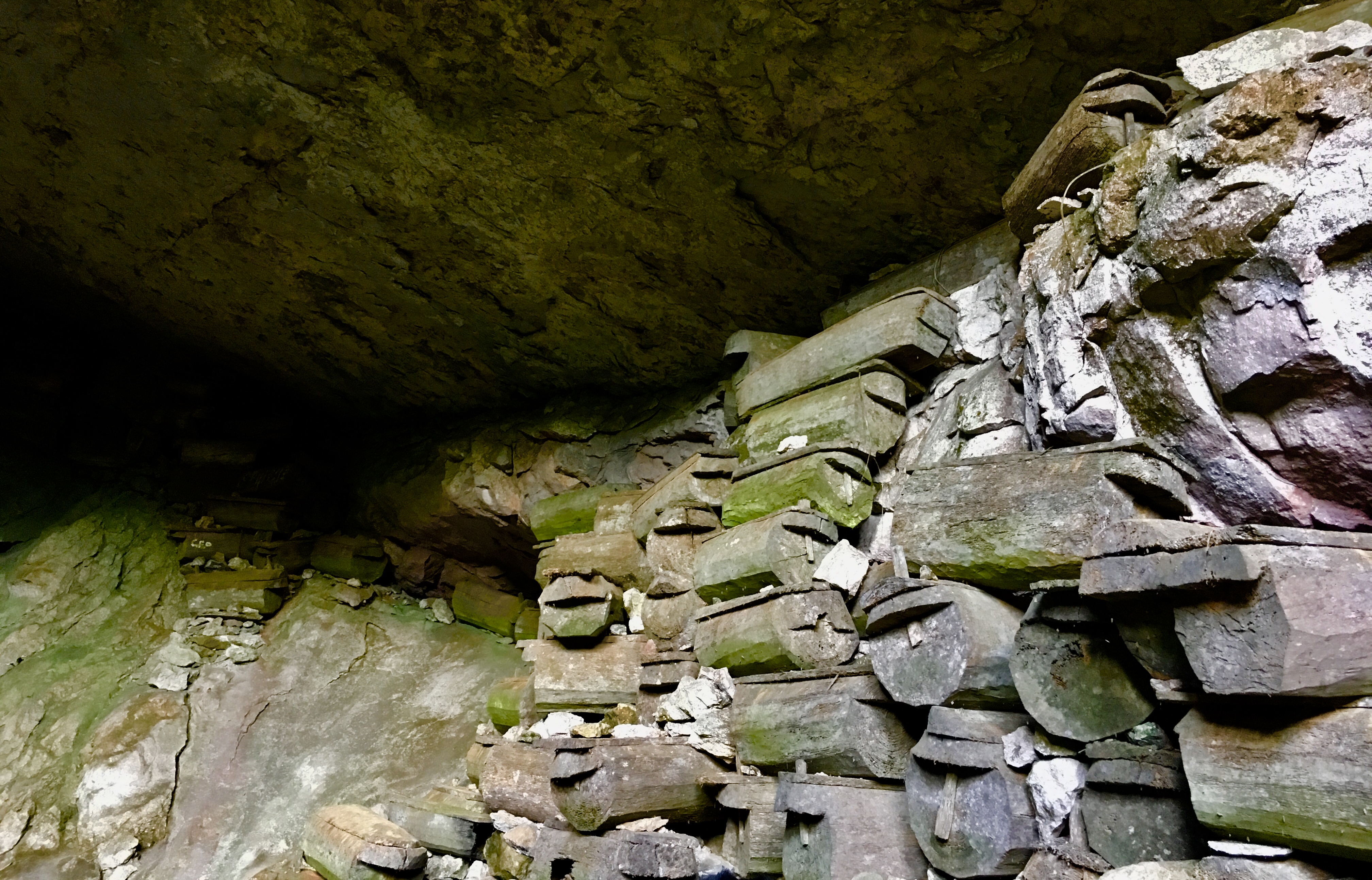
A Kankanaey burial cave in Sagada with coffins stacked-up to form a sky burial within a cave.
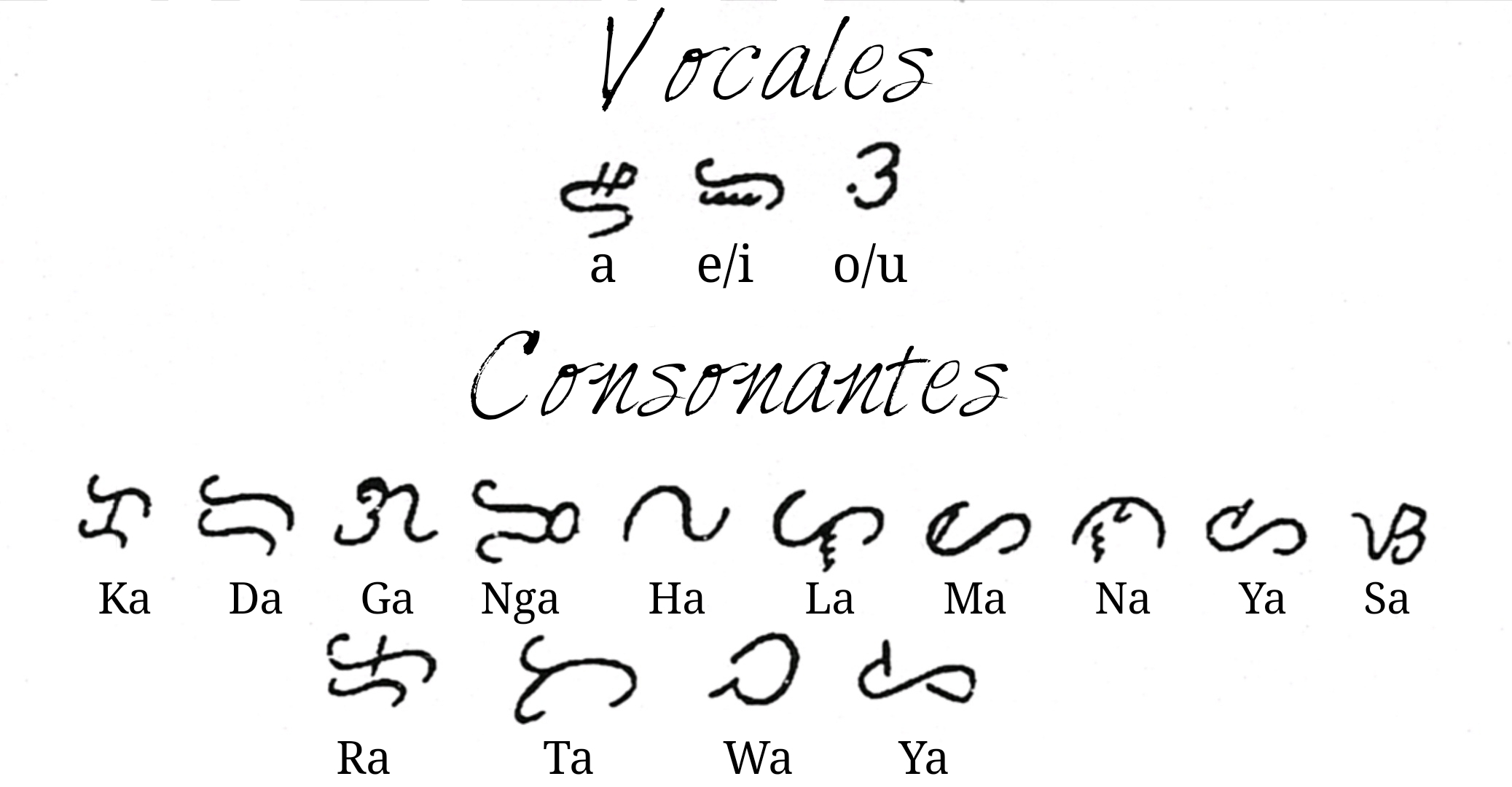
And some other opinion on both order and some glyphs:
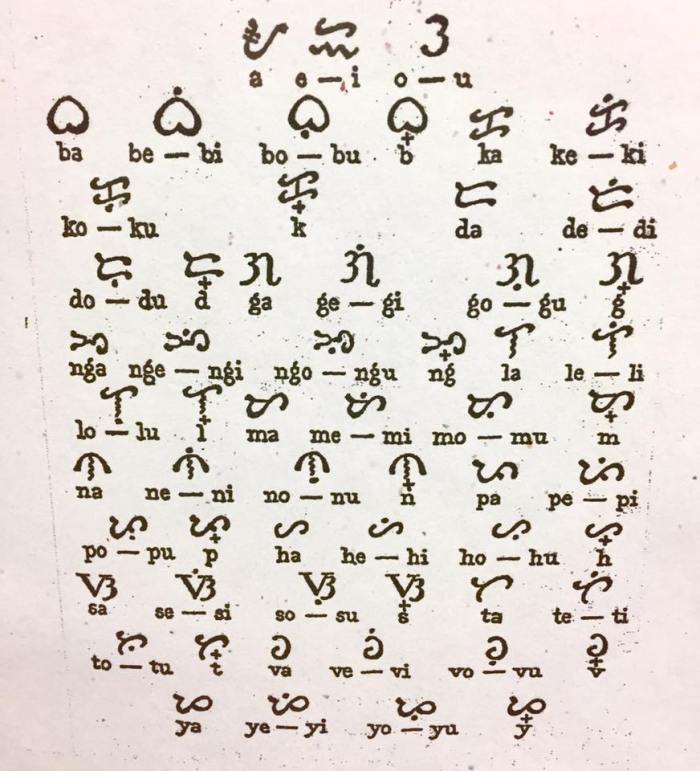
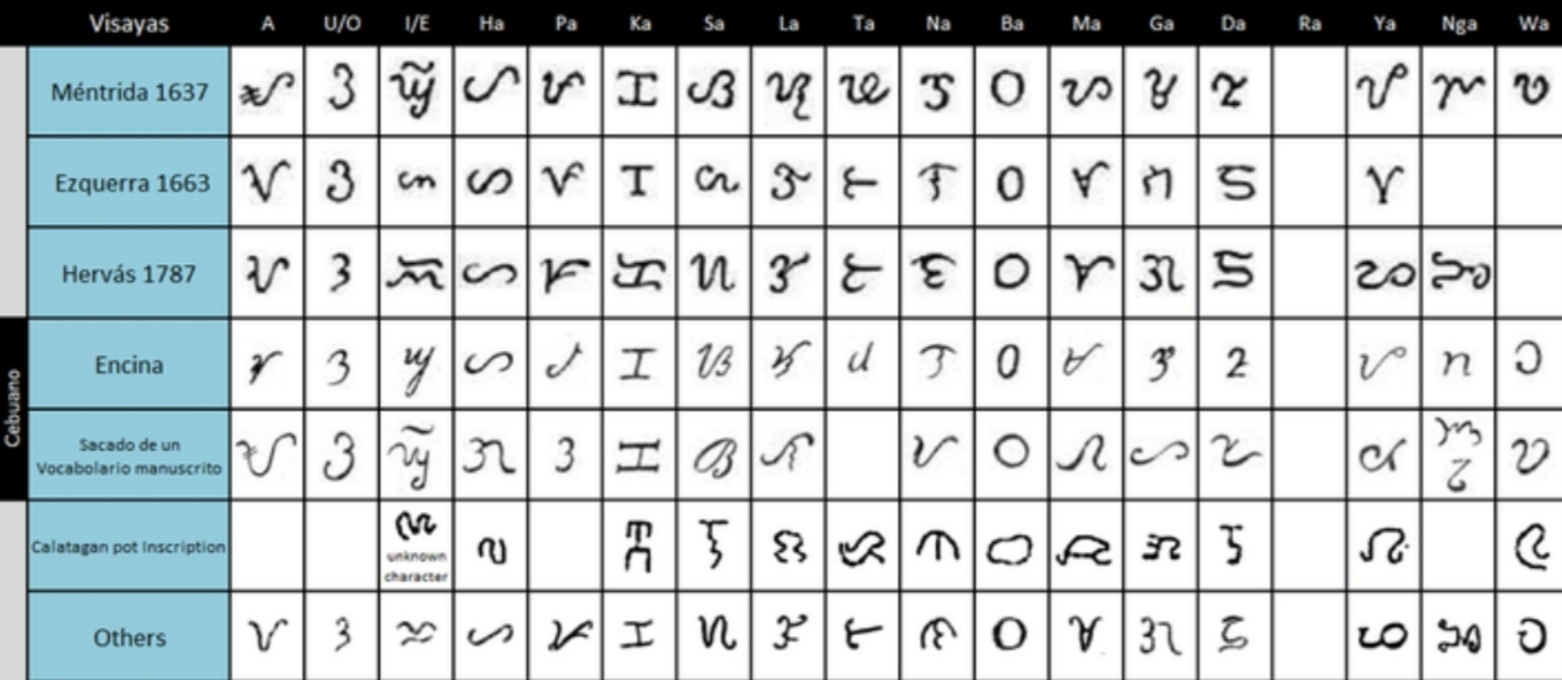
They have only three vowels, and with that they immediately stroke me with its resemblance in this account to old-persian syllabary. And they got some more on these writings systems since I last checked them, and this one explains that minority report:
.jpg)
Surat Bikol not having B makes me think of how much thus order reminds the kaganga order, but that is all abacadabra. And that is how it goes in dutch:
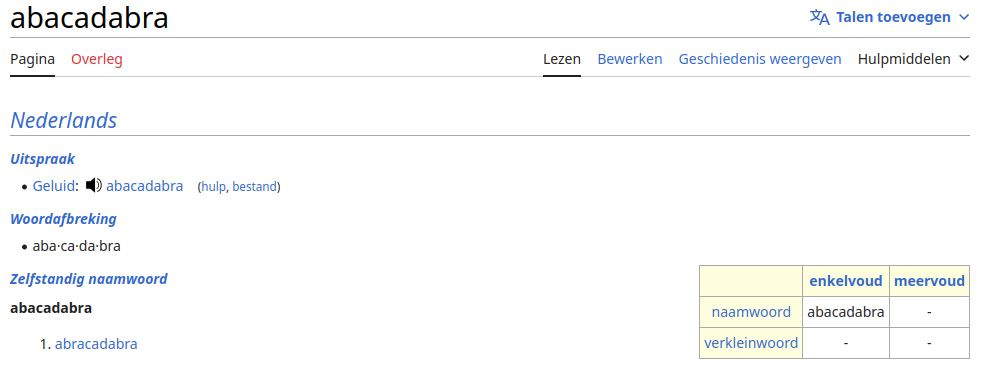
Several folk etymologies are associated with the word:[2] from phrases in Hebrew that mean "I will create as I speak",[3] or Aramaic "I create like the word" (אברא כדברא)
but then there's this:
The religion of Thelema spells the word 'Abrahadabra', and considers it the magical formula of the current Aeon. The religion's founder, Aleister Crowley, explains in his essay Gematria that he discovered the word (and his spelling) by qabalistic methods. The word 'Abrahadabra' also appears repeatedly in the 1904 invocation of Horus that led to the founding of Thelema. (The Equinox I, no. 7. 1912)
Musical theory taking notes with high frequency as high and notes with low frequency as low fucks up human minds.
When I was a child, when I first met that concept, I thought: how? why? it should be the other way around: high is about amplitude, as high in the hight: elephant is tall and thus high, and it sounds what they call low, but why low, big animal sounds big, big and high are synonyms in the main context.
Low makes the same pair with short, and short statured mice indeed sound what they call high, but they do it in the sense of frequency, so the cognitive dissonance is sown deeper: in the physics. high number of frew que que frew frequency. So it happent with no malintent, naturally, so other homonymic antonyms have the same reasons. But I am here to say about two other cases of the cognitive dissonance: ball bouncing the flour bounces with higher frequency the lower he gets, so probably I judt s just confused frequency and amplitude, though in the case of strink it is phase, the larger the phase is, the lower is the frequency. But no, wrong again. The larger the period is the lower is the frequency.
Should I tie low to large? The same volume spread at large territory is low. The same volume stacked on small territory is inevitably high. So high and large is not a synonymic pair. Though What is the synonym of high? big. But big is a larger concept, combining high and large and maybe many too. a lot
1234 5678
\ \ \ \ / / / /
9 (1+8=9 2+7=9 3+6=9 4+5=9)
Sum of first 36 digits equal 666..
Let's see if the first 36 digits may be distributed within in 1 5 10 50 100 500
1 = 1
2+3 = 5
4+6 = 10
5+7+8+9+10+11 = 50
12+13+14+15+16+30 = 100
everything else naturally adds up to 500
And there are plenty of ways to do it, let's look at the other one.. But why? Why do I calculate the satanic numerals, when I must be inventing the tree of life so to say. I am tricked? I'm tricked by devil, nice to meet you meat.
And why doesn't it want me to achieve immortality? I'm too annoying to keep on living. This will pass.
Once we may have the dialogue, let's figure this out (be it used as work of fiction later, may it be the psychic game (in both senses, yeah)
So let's make a deal. Soul is probably self, so no. No? Trade. I work on this work.. you already work this work. You're enchanted by this work.
Let me be! What do you want? My soul? What for? I don't know. But I ask help from someone I don't know. SO I SAY NO.
NO? Good-bye/
What a cheap melodrama. If gods or just spirits exist in the real fluctuations or whatever, we have to learn to coexist before I'm dead. To like eachother. And if they mostly live in the heads of believers, we also should keep piec pei peace
keep piss as in not to piss off (surprising is it how dirty protoancient language was?)
human's mind, humans' mind (this shape is twice wrong)
or human minds so s jumps in some other context.
So, spirits, why spirits, I don't drink alcohol. I pray to green fairy and to white goddess I saw and I salute both shoulder demon and shoulder angel. demon shouylder and angel shoulder (I read them from left to right. But maybe jews are right that they salute Angel first, and then stay with the left one..
truly 36 is an interesting number. And because christian church has demonized 666, it must have been such interesting a number that it was more important than today. Check this out:
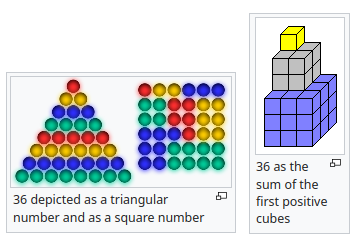
36 is the triangle with side of 8 balls.
6 is the square with side of 3 balls.
3 is the square with side of 2 balls.
2 is not triangular.
If 36 is magical, then so is 6 (and 8? was 36 considered to be magical in the world of V being fier?)
36 is 4 times 4+4
(2+2)×2=8
(1+1)×1=..2
Numbers are fascinating thing and naturally they fascinated people of the past. So 666 is old school, the anti waht christ was brought, so they're antichrist from the point of view of christians.
And thus, digging deeper than Christ, I found what was before him. I descend here as Jesus descended into enferno to excavate out of there something good.
What story is this, that Jesus returned after he descended into hell?
Let's envoke to muses instead.
I wonder why it is so difficult to get actual photograph of the stone in open access, I think I brought it here before, it must be somewhere in previous volumes. But today I could only find this:
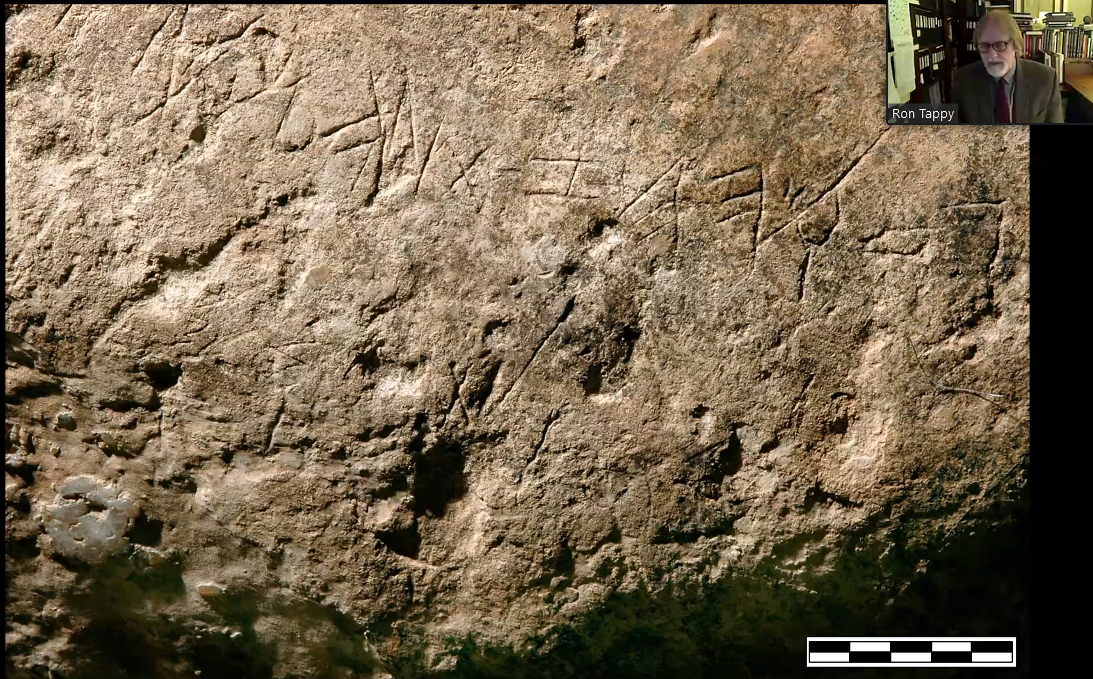
which is also cool, because this is a different angle, but it's not complete, like wtf.. I don't know if I should contact that Ron Tappy. Is it a bait he layed out? Either way, I have additional scepticism to everything coming from Israel, it is a sneaky tribe and too much of geopolitics are around it.
I look at this stone, and it doesn't make much sense to me. It is not a work of art, so how was it laying around seemingly being never put in wall? The scratches seem so thin, how didn't they got messed with? Overlaying writings and strokes are a nice detail, but they don't make much sense to me either: it is just a rough stone, why not eraze what you wanted to change?
Думая о тех ду́хах, осознаю, что это неизбежно отпечатки людей (подобно тому как мефистофель отразился образом паши свиридова (цыган, но сказал бы что еврей я бы поверил (неоседлый образ жизни сохранил привязанность к хуцпе, ушлости, чертам неприличным в оседлом обществе (потому что в оседлом обществе они являются проявлением ..глупости? нет, не обязательно, но очевидно нелюбви. Кому нужно жертвовать любовью ради сиюминутной выгоды? Тому кто уедет прочь, в другой город, кочевнику. Все гады кого знаю уехали дальше на гастроль. И в этом тоже мудрость мира. Что с глаз долой из сердца вон. Иначе это для них небезопасно, люди разные и кто-то захочет отомстить кровью унижение смыс.. смыв)))
Но ту, кого я назвал белой богиней, я не узнал. Быть может, это образ собирательный. Наложение всех классных женщин? Великая матерь? Великая материя (мать это, видимо, современный, лаконизированный вариант, типа Б-г (бог, благ, бандерлог впрочем тоже, но что это за слово, не советским ли переводчиком внедрённое?)
G-d(god, good, gold, greed, gingerbread, grandparenthood)
Were God and us compared as gingerbread and bread? b-d (bad)
g is good
б is bad?
Хвостик! Это хвостик! Хвостик снизу когда хорошо, а когда вверх хвостом подняли или вниз летишь это плохо. Когда хвостик снизу, то рыбка плывёт вверх.
Оттого жизнь полосатая, что вверх-вниз, вдох-выдох? Но пусть эта полосатость становится всё светлей. На уровне того что пить хочу сейчас, и выпив воды дал светлую полосу клеткам горла и печени, в уме вертелось, тоже.
Запятая между "печени" и "в уме вертелось" нужна лишь чтоб было понятно что именно тоже.
Но если убрать вторую запятую, то смысл точно в ту же сторону переключится
бля~для - таковы все матерные слова? их надо только узнать?
ебать~опять? повторы делают вхождение еблей?
хуй~кто? кто~que-это? кто-это~хуета
пизда~бездна? без дна, оттуда люди выходят. пизда позади:? пиздуй~по-заду? пиздец~безdeath?
титикака такое по детски дикое, что естествнно это не в японии, а в африке.. так плохо я думаю про африку, как ни стыдно. а титикака в южной америке. титикака, ай хэв ноу бангхоул.
тити попа кака, всё глухие согласные. и даже пися! табуированность даёт глухоту?
блядь очень звонкое слово. бля на д? бля и блять~блядь одно и то же слово, так может это глаголь? глагол тоже глагол чтоли? глаголь.. глаголю, глаголим,
глаголь = glagoli, it has i, so glagolю is glagolia: a~o~u, don't palatalize consonants, and thus in syllabaric sense they are not three, but two vowels. O and I? ו and י, now it makes sense. In both writings systems O is large and I is smaller. Just as mouth being open more or less makes sense in articulatory representation. Thus I indicates, that we rotated the original text 90 degrees, and yet we're to figure out which way. Was [i]и(and) link like — and then being separated with — shape being left to punctuation. is ? c the ךִ or something? כִ (yes, I'm speaking of qui (paradoxically half of the world will learn this french word because of that juif))
пися бесится? пися висит? хуй гу..д? хуй же худ, а если озвончить, то гуд, и столбы как божество? деревья же столбами, деревьям видимо молились как воплощению матери земли. Особенным деревьям как её особым представителям.
зайти на беседу ~ зайти на пизду? были глухие и звонкие одним и тем же? д~т, это я с детство разумею: ть в делать определённо to~do
do go is to go? well, maybe it used to be more the same then than now, the semantic deviation is subtle even now.
I think I found the proto-I: ꟷ (I found in one of my earlier works, I need some ai to keep it all in mind, as I intended to have, before I allowed myself to write everything down, to document every thought, not only the certain revelation, but everything so the uncertain ones are not missed. We'll figure it out somewhat later. I am still acquiring the material for further research, I collect the observations. Of any kind. Some of them have already lead to some consistent narrative, which I here and therefore call booklet. That booklet, where every sentence is whether something new or a comment to that new statement in a form of well-known or less-well-known facts.
The Sideways I ꟷ is an epigraphic variant of Latin capital letter I used in early medieval Celtic inscriptions from Wales and southwest England (Cornwall and Devon). About 36 monumental inscriptions in Wales, and about 15 in Cornwall and Devon, mostly dating from the 5th-6th centuries, make use of this letter. Except for a single inscription from the Isle of Man, it is not found in monumental inscriptions elsewhere. The letter is used exclusively in a word-final position for Latin words (or Latinized Celtic names) in the second declension genitive singular.
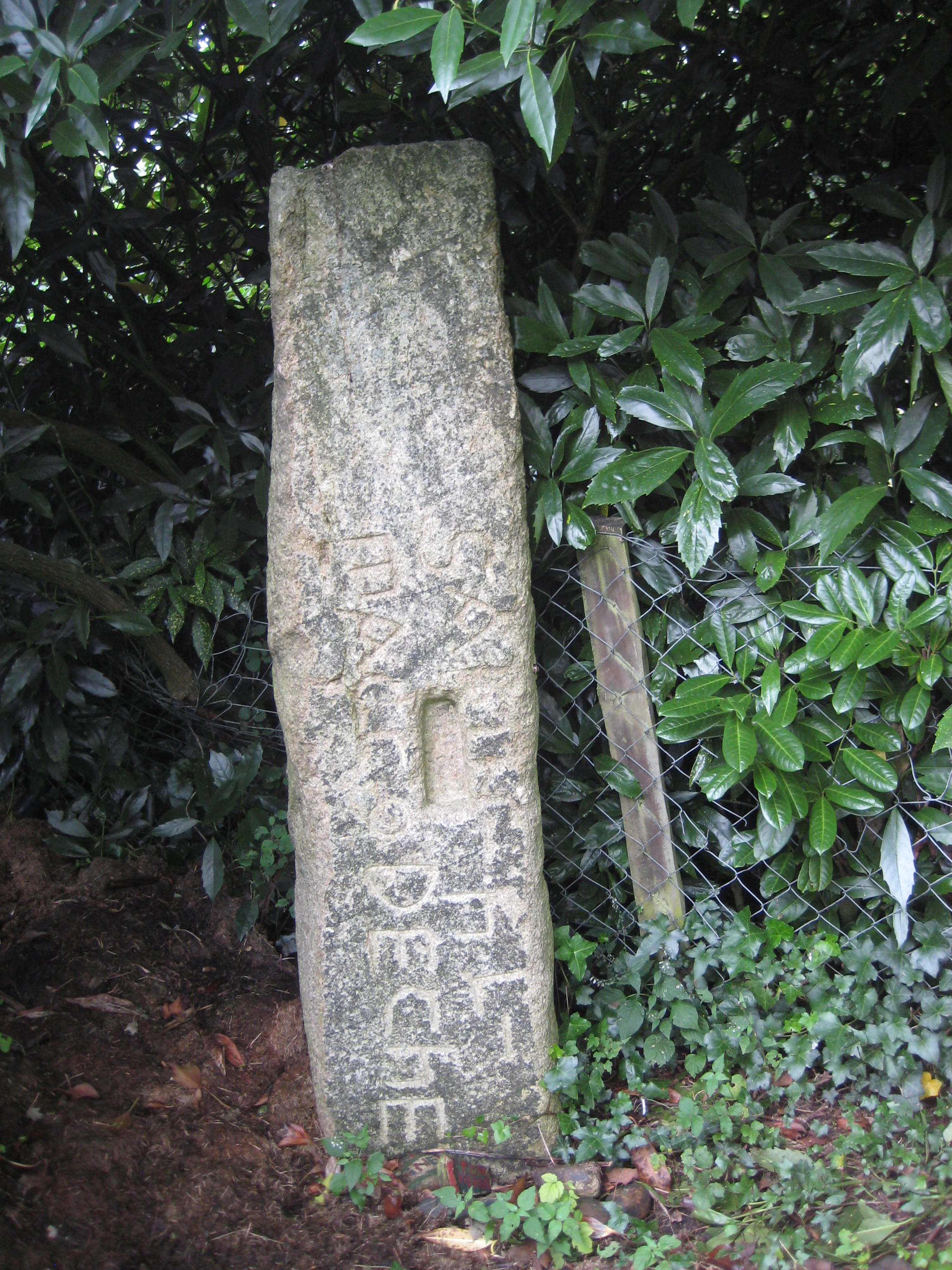
memorial stone in Tavistock, Devon, inscribed
I can only guess if FI is digraphy, or indeed they used both I and ꟷ within the same text.
Or was that stone installed as a tombstone and later it sank into the ground made of growing biosphere shedding leaves to compost them into soil.
Compare this stone to tel zayit. It's hard to imagine that Zayit stone was used as a grammar artefact and it wasn't drawn deeper into it. So inconsistent, so fake, and imagine how obvious that monkey business become to
If we look at hebrew pair of ו and י, then we can notice that they're the thinnest of them all, which may tell of their emptiness in the context of consonantness, they're pure vowels, and thus I is originally o, but then it is also u, and their neighbours consider ا a.
а в
я ж
и к
о с
у
These are simplest (one-letter) words in russian.
но мы знаем и что во ко со, а не вы ку си.
о это тоже буква же со смыслом. в отличие от е (же это название буквы Ж)
а б в а бы во да
ж её ёж же за
и к и ко ли мы на не~ни но ну
вот это Н дало! НА НЕ~НИ НО~НУ
o c об по Ра со ты те та то ту (ы=и!)
вот это Т дало! ТА~ТЕ~ТЫ~ТО~ТУ
сё и то.. сё~сие
И это я забыл про С! Сее Сии Сей, всё трёхзначные, значит не забыл.
у у уф ха це чё ша ща
я эх эй юг я як
ко от к чем-то семантически отличается? нет. значит двубуквенные не составные, а сами по себе морфемы независимо от состава. et[e] = [i]и?
а я
и у
к с
о
and here I realize that I forgot about в. In russian в is similar to o and у (о is about, and у is at (at and about are not exactly in, actually they're к and с.. к~у с~о? с~u, с~о)
with ~ u c (two hands one in the other? female hand is upwards (does it tell that females were short? that young girls were married? I would easily expect that from ancient warlords, and mohammed demonstrates such behaviour.))
в looks as double о, so not just about, but in. разница меж у и в. Единый вав, но в глубже
о у в это история вхождения: о-коло, у двери, в замке
Water (море) Woman (mother)
Fire fother
Did people modify their language when they invented fire?
Looking at word furnace I cannot help but ask: is fur and fire cognates? fur catches flame, I guess.
I was asked by a buddy to write a song. Or did I offer it? What was it? Both?
время нам на встречу идёт
мы могли бы тоже стремиться
приближая то что грядёт
точему данОсуществиться
Нарушенная ритма (не фи не рифма но ритм)
и пример обхода, данный фонетической лигой на О открыл другой смысл (не дано, но над. н дан. Not all which o is, all~around(ll~round?) but one chance. it's given to you, please play cool.
грязный~rгрозный (картавый, каричневый, карий, от слова кар, и кап, кал)
попс is literally поситивная песня (по значит пох? positive, the opposite of negative))
попс is literally populars
pop goest to the top.
pop top could be a part of alphabetic song of such kind:
up bob cop dope
or did each line had its own rhyme? four letters per line could be four lines in a line.
abnormal even has the un-like suffix abnormal:
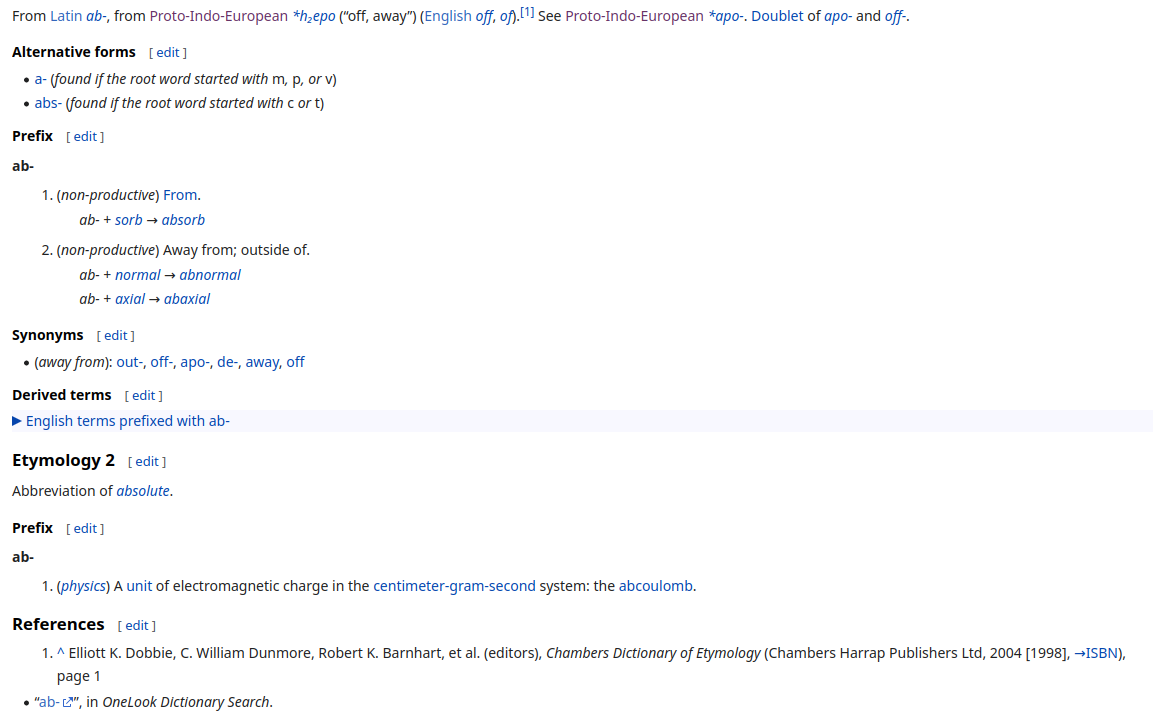
who would have known that absolute has an abbreviation. And the word absolute is alphabetic, in the sense that it starts as ABC and ends with T, even though it's guts, the olu are not in the alphabetic order, unless o and u are ו, or rather is o is ו and u is o. absulot would be the case, or..
is U~F? is I~Г? because U=II (u~ɪɪ) here I reconstruct the text aroung these two sceenshots, I was foolsh enough to allow the laptop go down before I ctrlSed it.
See is C (the word see is homonymous to the name of letter C)
Видь is as more basic than Видеть as See is simpler than to see.
ВRU is as third a letter as CLA, is it the way eastern CDB and western BCD parted ways? But then english see is more eastern than russian видь, where дь is merely a verbal suffix. But в is in, which may be the key to understand the main meaning behind видение, if you saw you have it in you, you can tell what it was. If you didn't see, you can only hear about it. Isn't H just behind C? in abcefh, maybe, but what is it.
And at first I found this, and the arrogance of abkhazians apalled me, but them what if they're trying to say us something? What if their name tells a story of abc, their own alphabetic legend.

If abdominal muscle is just ab, then the points it must connect are a and b.
or is it just an abbreviation of abdomen?
The rectus abdominis muscle, (Latin: straight abdominal) also known as the "abdominal muscle" or simply the "abs", is a pair of segmented skeletal muscle on the ventral aspect of a person's abdomen (or "midriff").[1] The paired muscles are separated at the midline by a band of dense connective tissue called the linea alba, and the connective tissue defining each lateral margin of the rectus abdominus is the linea semilunaris. The muscle extends from the pubic symphysis, pubic crest and pubic tubercle inferiorly, to the xiphoid process and costal cartilages of the 5th–7th ribs superiorly.[2][3]
The rectus abdominis muscle is contained in the rectus sheath, which consists of the aponeuroses of the lateral abdominal muscles. Each rectus abdominus is traversed by bands of connective tissue called the tendinous intersections, which interrupt it into distinct muscle bellies. In people with low body fat, these muscle bellies can be viewed externally in sets from as few as two to as many as ten, although six is the most common.
I think I found my A, alba, but the other line is called semilunaris, and b would be a good crescent, but the hypothesis is not supported yet. So until I come over some ancient names of those lines, I leave it behind.
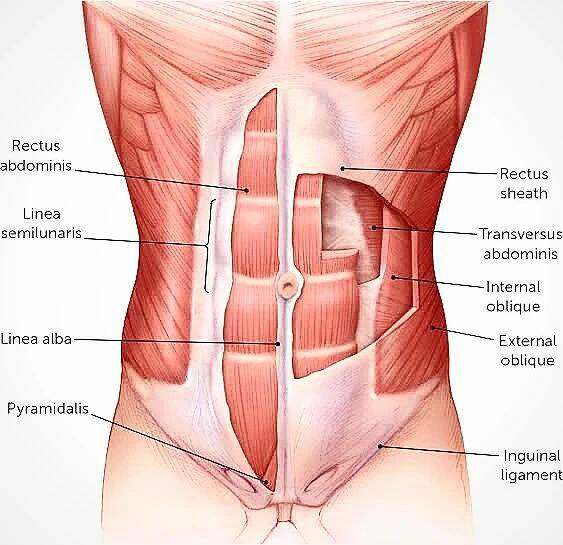
The linea semilunaris is a vertical, curved structure that runs along the lateral edges of the rectus abdominis muscle in the anterior abdominal wall. It is the site of union where tendons of the lateral abdominal muscles meet the sheath surrounding the rectus abdominis muscle, also known as the rectus sheath. The lateral abdominal muscles are the external oblique, internal oblique, and transversus abdominis muscles.
The linea alba is a longitudinal, fibrous median raphe along the rectus sheath formed by the fusion of the anterior and posterior walls of the sheath. It may be visible as a surface marking on individuals with well-developed abdominal musculature running as a depression between the xiphoid process of the sternum and the pubic area.
It separates the two parts of the rectus abdominis muscle which lie laterally. It is traversed by the umbilicus. It may be visible as a surface marking on individuals with well-developed abdominal musculature.
raphe[раф] is definitely a terminologized cognate of rough[раф]
(but then it is only a volk etimologie, feelings based science, not very certain, but if it helps to remember the term, it's alright)
жевать от слова зубы (да, настолько далеко разбег чтения некогда одного и того же символа)
жувать тогда, и действительно, жувать ещё лучше: жуй
так и совать видимо изначально сувать: суй
а ховать хуй нужно. хуй буквально означает ховай, прячь. И для понимания этих тонкостей русским необъходимо изучение украинского языка и украинской культуры.
суй и хуй антонимы? если сувать внутрь, то нет. синонимы быть может даже. ᚼ~h~ʃ~ʒ~ж~ᛡ[j]
буй
дуй
жуй
куй
суй
хуй
бой
вой
кой
мой
ной
пой
рой
твой
хой
цой
бай
ваяй
дай
знай
лай
май
пай
тай
хай
чай
бей
вей
гей
дей
ей
зей
лей
имей
пей
рей
сей
чей
шей
вей и рей похожи как ᚢ и ᚱ
вий
дий
кий
и не было? была только е? отчего так мало слов и все чуд чужие?
a
e
o
у
a b c
e v g
o p q in this representation c[g] g[ʒ] h[ʃ]
u f h
twelve probably was for some time (evg~imk or imn or even iml (L~Г, λ~ג, Λ~𐤂))
so we know 12 months, and probably cuneiform 60 are related to those 12,
I read those
abc as april may june
evg july august september
opq october november gecember
ufk january february march
I have three direct coincidences, how probably was that? I chose one, april came there because of a, it could be august. Let's try it with august and shift the frame of reading to see if a for april, o for coctober, f for february was an anomaly.
abc august september october
efg november december january
opq february march april
ufh may june july.
only january sorta correlate g, gevier? why do I even use english? because I know english, so I apply it here, and which else language could it be, french was for sometime, being closer to latin, but then british intellectuals probably worked with latin and calqued its marvels into their own language, so modern english is quite alrigh. Or it never was about latin, because letters appeared somewhere else, in some other language, in some germanic language, for example, amongst runes. Because alphabets don't have anything runes don't have, runic culture has many more elements. a and o don't look like ᛆ and ᚮ in latin, for example, F and Г don't meet neither in latin nor in greek, so runes just make more sense. And they're used for divinations, and magic is really ancient.
I make myself a freak by proposing weird ideas. Ideas on which nobody even thinks are weird.
SS is SuperStar
грежу и брежу
грезить и бредить
грежу и брешу?
грешу и брешу? (пакошу и вру?)
is бред 𓃀リᚦ "нога режет топор"? или моё учение бред? не половину так точно, но я позволяю бред в этом труде, ибо из него выкристализовывается что-то более осмысленное.
А O У Е И is how ogham hav has ti it
A E И О У is how other alphabets have it
A И У Е О is how japanese kana-tachi have it, but I O A is how IrOhA goes, but then how does it go? It starts with pure I which is interesting and very promising, if the syllabary european alphabet came from is japanese and not paleohispanic for some reason, but then I know it came via paleohispanic because how similar runes to paleohispanic glyphs.
いろはにほへと Iro fa nifofeto 色は匂えど Iro wa nioedo Even the blossoming flowers [Colors are fragrant, but they]
ちりぬるを Tirinuru wo 散 りぬるを Chirinuru o Will eventually scatter
わかよたれそ Wa ka yo tare so 我が世誰ぞ Wa ga yo tare zo Who in our world
つねならむ Tune naramu 常ならん Tsune naran Shall always be? (= つねなろう)
うゐのおく やま Uwi no okuyama 有為の奥山 Ui no okuyama The deep mountains of karma—
けふこえて Kefu koyete 今日越えて Kyō koete We cross them today
あさきゆめみし Asaki yume misi 浅き夢見じ Asaki yume miji And we shall not have superficial dreams
ゑひもせす Wefi mo sesu 酔いもせず Ei mo sezu¹ Yoi mo sezu Nor be deluded.
(I can see a lacking syllable in the third line. is it that perfect imperfection they value)
three out of five vowels stand in the beginning of their line. And those three are no other a i u, the ones keeping their position relatively to each other (not to one another, to each other, feel the difference) in japanese and latin.
But then in hieroglyphic form it looks otherwise:
I is the vowel of the first half of iroha, A is in the very middle of the second half of it, U is in the middle of it, separating I half from A half. And A is literally in the middle of the second half: it has 11 syllables after it and 11 syllables between A and U. Halves have 23 syllables each, with 47 total.
And all three numbers are prime numbers (in russina they are called simple (простые))
The first appearance of the Iroha, in Konkōmyōsaishōōkyō Ongi (金光明最勝王経音義, 'Readings of Golden Light Sutra') was in seven lines: six with seven morae each, and one with five. It was also written in man'yōgana.
Structurally, however, the poem follows the standard 7–5 pattern of Japanese poetry (with one hypometric line), and in modern times it is generally written that way, in contexts where line breaks are used.
It says, that it was written in lines, not columns. Is lines ancient traditioin in this region too?
It is said[by whom?] that the Iroha is a transformation of these verses in the Nirvana Sutra:
諸行無常 Shogyō mujō All acts are impermanent
是生滅法 Zeshō meppō That's the law of creation and destruction.
生滅滅已 Shōmetsu metsui When all creation and destruction are extinguished
寂滅為楽 Jakumetsu iraku That ultimate stillness (nirvana) is true bliss.
Iroha sequence is also interesting in a sense that I O A indeed go in this order within the poem.
It is truly the alphabetic sequence: The Iroha sequence is still used today in many areas with long traditions. Most notably, Japanese laws and regulations officially use Iroha for lower-level subsection ordering purposes, for example 第四十九条第二項第一号ロ (Article 49, Section 2, Subsection 1-ro). In official translation to English, i, ro, ha... are replaced by a, b, c... as in 49(2)(i)(b).
and musical notation I noticed before, I think I also noticed that the final note is To
The story mostly seems to be around vowels. Labials, linguals, those are purely alphabetic play. Probably that is how alphabet came into being separately of the previous writing systems.
色 [i] colour
有 [u] be, have, exist (in chinese) in japanese it is yes, but also posession, so it's have.
於 [o] in, at
衣 [e] clothes
阿 [a] flatter (it is a hidden wisdom of wearing something colourful make other people feel good, because you vivid their day, or that you dress well to meet them)
And this sequence tells, that u is of o, and e is of a, also those pairs are two to one syllables apart.
abyss ~ abc
They say, reading bible backwards is satanic, but what kind of bible? In which book it ends? I guess I have to try all 66 or more if there is more.
And jewish bible ends with יעל, which is technically a goat with the largest horns. Though I guess in that context the meaning is defferent, because I can see nothing in the translation about the goat.
תם ונשלם תהילה לאל בורא עולם Glory be to God, creator of the world
תם (finished, which is easy to remember, because ת is the final letter, and ם is sofit)
ונשלם (and paid)
תהילה glory
לאל no.. (but then I can see that it is two words: ל אל (to god))
בורא creator
עולם world
But to understand it, we have to delve deeper:
But then it is probably not a part of bible, but a separate spell. Because world is not as cool as goat?
Because it is written in different font:
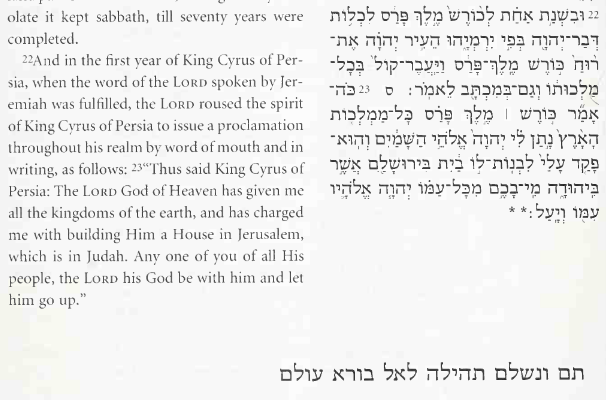
יעל (שם מדעי: Capra) הוא סוג במשפחת הפריים. היעלים נפוצים בעיקר באזורים הרריים ברחבי העולם הישן.
תכונות
יכולת טיפוס
Го́рные козлы́, или просто козлы́ (лат. Capra), — род жвачных парнокопытных млекопитающих из подсемейства козлиных семейства полорогих. Некоторые виды этого рода называют козерогами, два вида, обитающих на Кавказе, — турами.
Домашняя коза (Capra hircus) — одомашненный представитель этого рода, который произошёл от безоарового козла, в настоящее время выделяется в самостоятельный биологический вид. Доказано, что она одомашнена более 8500 лет назад.
הָרִים הַגְּבֹהִים לַיְּעֵלִים“ — ספר תהלים, פרק ק"ד, פסוק י"ח”
בישראל מצוי המין יעל נובי, שנפוץ בנגב, במדבר יהודה וברמת הגולן. הסוג יעל כולל גם את מיני העזים. עז הבית, תת-מין בסוג זה, בויתה מעז הבר
Capra is a genus of mammals, the goats, composed of up to nine species, including the markhor and many species known as ibexes. The domestic goat (Capra hircus) is a domesticated species derived from the wild goat (Capra aegagrus). Evidence of goat domestication dates back more than 8,500 years.
Wild goats are animals of mountain habitats. They are very agile and hardy, able to climb on bare rock and survive on sparse vegetation..
So hardly it is a coincidence, so the bible ends with the story of god and his goat is with him, probably telling that devil is the God's goat.
I wonder if eat is reduced form of feed, which is related to food, and to питать, which is related to пить, where п is probably related to פֶּה (mouth)
IUOEA oroha (R~U(ᚱ~ᚢ) and E~H, which is Е and И in greek, both vowels, so iroea? iuoea!
AIUEO japanese hiragana and katakana order, and also order of all philippines syllabaries.
AEIOU standard latin order, not only latin, but modern latin alphabet alright, georgian too.
AOUEI ogham's order, it doesn'a share aiu sequence of latin and japanese, it lista lists a
IVXLCD reflects IUOEA (I U could be all there was: the beginning of the first half and the beginning of the second: 23 and 24 (a prime and 2*2*2*2*3)
But then is it so across the numeral systems or is it only a fluke fo of the decimal?
Numeral systems don't change the numeral reality, was my firest response, but let's think.
In trinary ternary it would be 2*2*2*10, it would be..
1 1
2 2
3 10
4 11
5 12
6 20
7 21
8 22
9 200
10 201
11 202
12 210
13 211
14 212
15 220
16 221
17 222
18 2000
19 2001
20 2002
21 2010
22 2011
23 2012
24 2020
and that 2020 is 2*2*2*10? But then I don't recognize these numbers, thise 10 is 3
20 is 6, so 2020 is somehow 4 times 20, or 11 times 20. What's going on here?
11 acts as 11 in decimal, even though technically it is a strange way to write down 4 (triangle of 3 balls is their 10, and 11 is just one more ball to that 10, but can you see three as 10? then 0 is 2? welly, it as if symbolizes that. People naturally played with different numeral systems before they settled with decimal. But then hands could be playing the crucial role in the evolution of numerology.
Ternary is a whole different way to think of numerals. Let it be my sacrifice to numeral muses. To mathes. To mothers? Three muses working with numbers are mothers? The norns? Are norns even mothers?
Are norns drawing numerals?
Упоминания об узелковом письме сохранились в литературе древнего Китая, в Ицзин (Книге Перемен), Даодэцзин и Си цы чжуань[4].
Легендарному первому императору китая Бао Си (Фу-си) приписывают как изобретение узелкового письма, так и пришедших затем ему на смену триграмм:
В древности Бао Си был правителем (ваном) Поднебесной. ... Исходя из этого, в начале создал восемь триграмм, чтобы проникнуть в добродетель просветлённого духа и распределить по родам (классифицировать) суть десяти тысяч вещей. Создал узелки на верёвках (узелковое письмо), сплёл сети и силки, чтобы охотиться и ловить рыбу. (Си цы чжуань, II, 2)
古者包犧氏之王天下也,仰則觀象於天,俯則觀法於地,觀鳥獸之文,與地之宜,近取諸身,遠取諸物,於是始作八卦,以通神明之德,以類萬物之情。作結繩而為 罔罟,以佃以漁。
and trigrams to which this wave took me is also something to dig deeper into, because it tells to describe 万 things, more than hieroglyphs do, or about that. So naturally the two systems are connected, and binarity of trigrams make me think of binarity of knot and no-know no-knot (of knot and not)
And to my surprise, trigrams can come in different order:
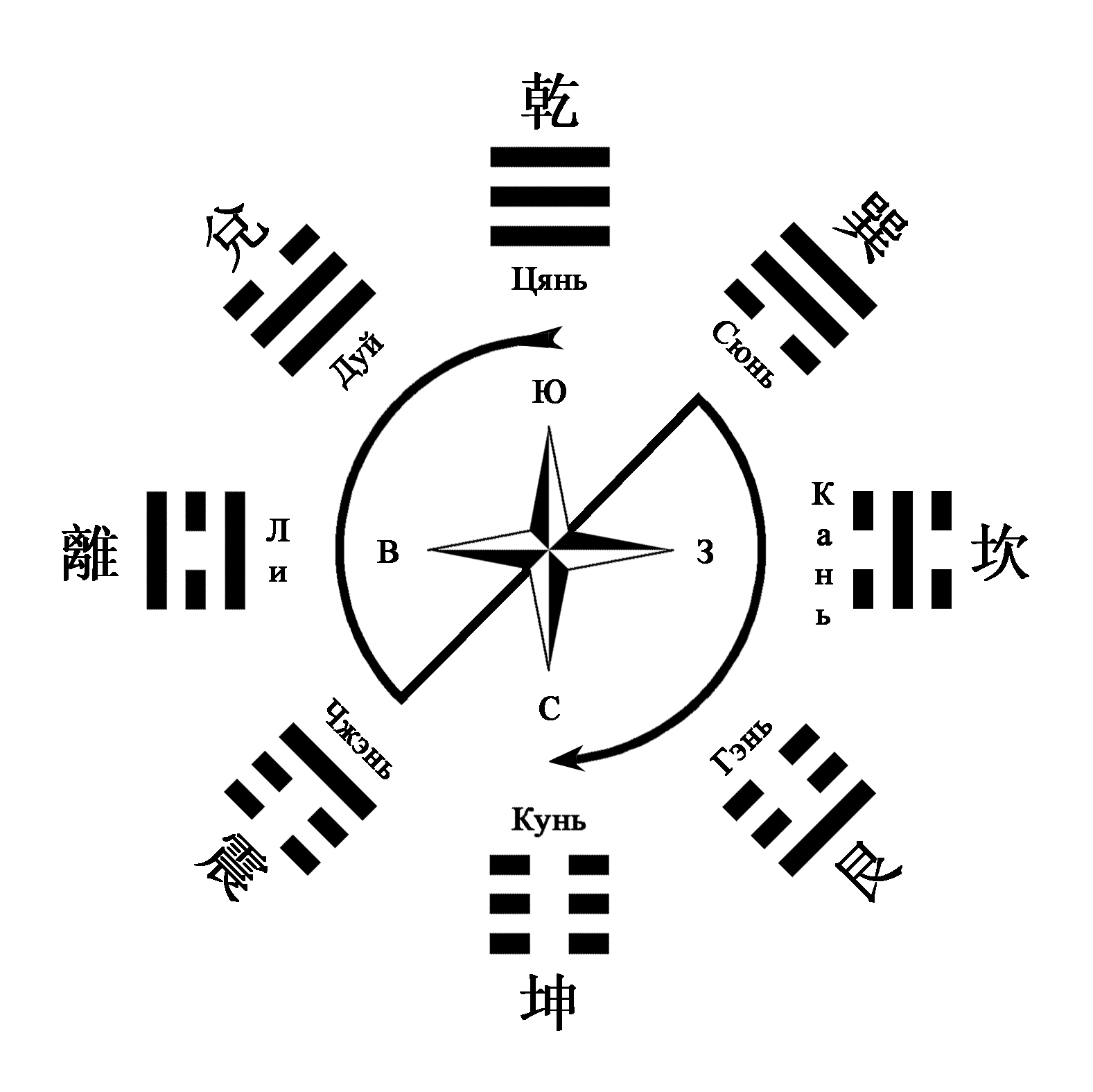

I wonder what it is supposed to be, and why not the symples hieroglyphs are associated with the simplest hexagrams which are trigrams, but then hexagrams cannot encode 10000 things, only 64


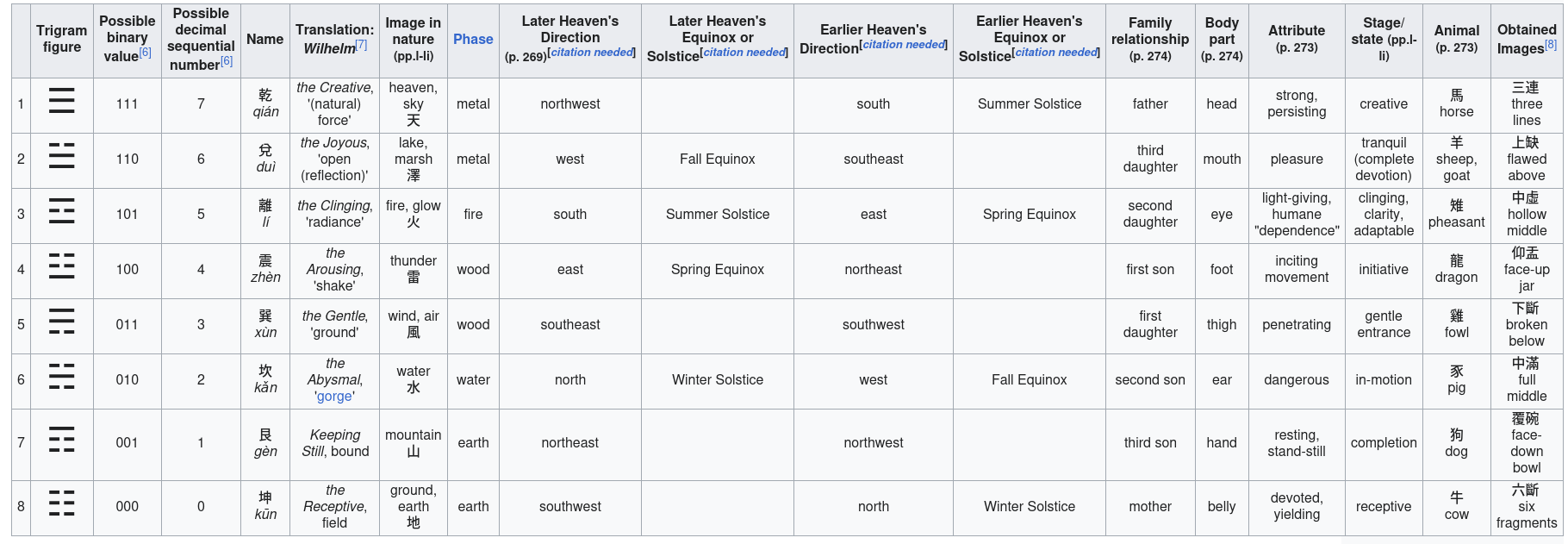
and probably the root of the difference in hexagrams shown above:

Fuxi's "Earlier Heaven" (above) and King Wen's "Later Heaven" (below)

but those were all trigrams, here's how hexagrams can be obtained by combination of trigrams:
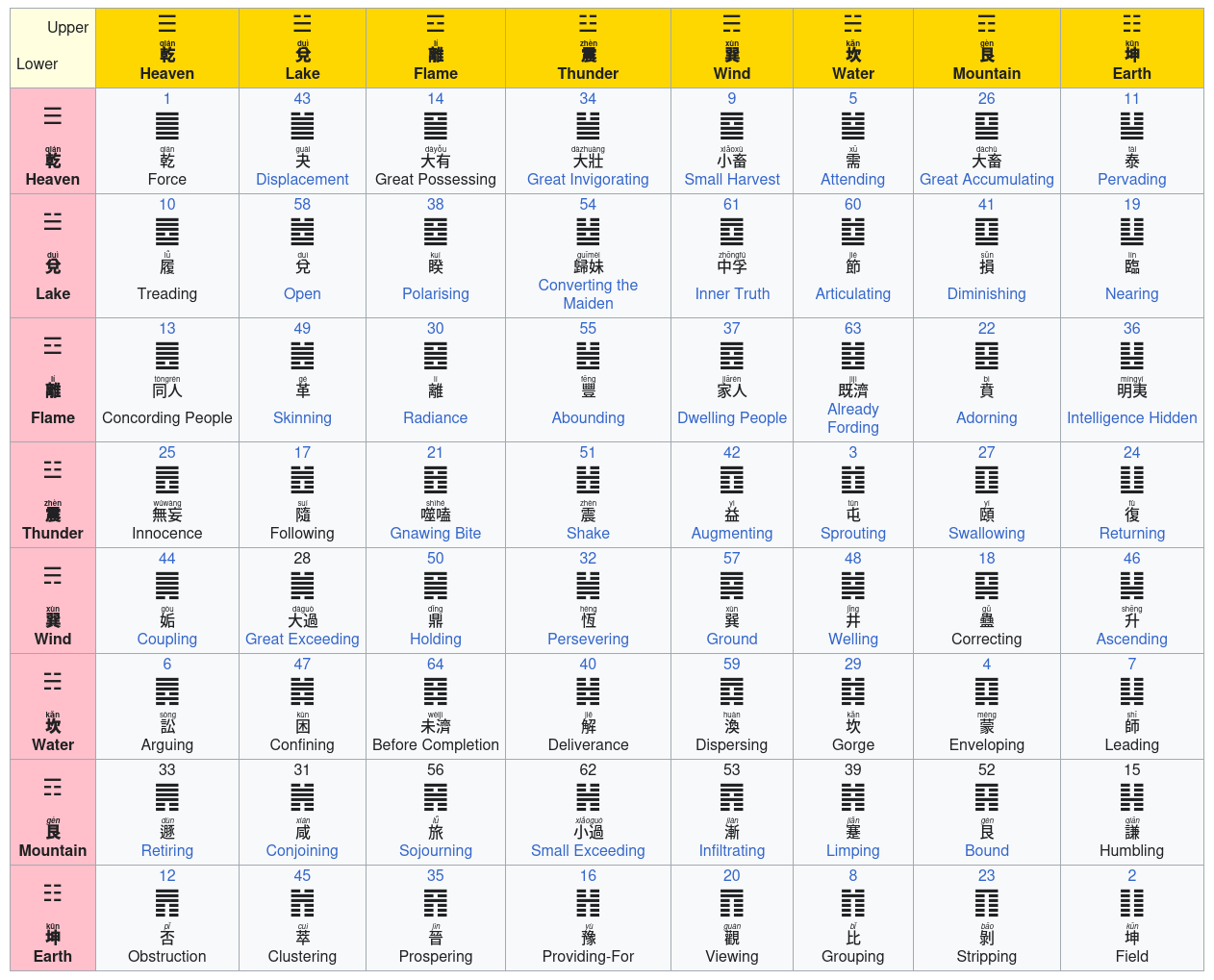
probably it can give some wisdom, about agriculture and sociology and who knows what, finance maybe, but I only touch this filed, this ䷁
Utero ~ intero (uteral~uternal ~ internal) в сравнении с русским словом нутро (от внутри)
interno ~ inferno? чрево зверя? вознесение лучше разложения? смерть от старости лучше кровавой? это очень древние понятия и вместе с тем очень умозрительные рассуждения
насколько корректно такое представление, интересно (uterus~interest? интерес, внутренний что-то? или inter означает между? между стен? after all, it's interior, but then in is the opposite of ex of eter exterior.. but interior shares inter with internal, in-terra? ex-terra? is in inhaling and ex exhaling sounds?)
English is also pretty fucked: how comes word rational has rat in it. May it be racionalism, but then everybody cry that it is obviously about race, which is probably even true, because what is rational is measured according to cultural norms, which are directly national in nature.
partly and hardly (one is so easy to be heard for the other, yet are they antonyms or synonyms.. or both)
A B C
A B G
A B D because the only alphabet with three letters in the first line I saw is ᛆᛒᚦ
банда ~ b and d (бабка и дедка ~ папка и детка ~ папка и тётка (что я хочу сказать? глухота-звонкость обращают значения на каком-то базовом лексическом упровне? или что нет разделения по полам в разделении на губные и язычные (пока не знаю, наблюдаю)))
банда означет связь, как и bond, bondage, but bandaid. b on d? b an d?
может это слово только случайно алфавитно? maybe ban is the root and d is a suffix? бинт вообще говорит что глсн лшн, омонимы возможноы, но ы
если банда изначально семья, простейшая социальная связь меж bабой и dедом, то банды и сегодня семьями называются.
ABD [abd(d~g (but then T next to П makes me think it was just D[d]))]
EFГ [evʒ(ʒ~ɦ (but then is Ψ х or k? I can see Х in Ψ, the χ))]
ΙΜΛ
ΟΠΤ
ΥΦΨ (at first I thought it was ΥΦΡ, but Ψ is in the right position and graphically is also just right)
ΙΜΛ and ΟΠΤ are torizontal horizontal, while ABD EFГ and ΥΦΨ are vertical doublings
Наиболее древнее протокипу состоит из 12 свисающих нитей, некоторые из которых были с узелками, и нитей, обмотанных вокруг палочек, обнаружено при раскопках герметичной комнаты одной из крупных пирамид на археологическом объекте Караль[10] (в долине Супе) археологом Рут Марта Шейди Солис (Ruth Martha Shady Solís), датируется по стратиграфическому слою приблизительно 3000 годом до н. э.[2][11]; в связи с чем кипу может считаться одним из самых древних (после шумерской клинописи и египетских иероглифов) видов письменности у человечества[12]. До этой находки самое старое кипу радиоуглеродным анализом датировалось 779‑981 годами н. э. Столь большой промежуток между этими датами пока не нашёл объяснения у историков.
Читая вики, понял, что кипу могла быть числовой записью того, что привязывалось к главному шнурку (если лист кукурузы, то кукурузы) но это поверхностное понимание, но говорят, что единичных узлов не больше 9, более сложных узлов не больше 9, самых сложных узлов не больше 9, и мол узлы сложнее располагались ниже (если нити свисали) что очень похоже на числовую систему (если только цифры буквам не соответствовали. А могли. в европейских языках так уж точно, но без абеседарии или силлабарии говорить не о чем, удивительно что тоже девятки максимальные цифры, как у европейцев, но может с количеством пальцев напрямую связано. что десять это полностью all-in, но всё равно немного странно, что представление похоже ..на старинную европейскую запись, на ту что существовала у европейцев до позиционной. Но как древня она? у евреев видимо была в ходу с незапамятных времён, и повлияла на европейцев, отбросивших ради неё римские и им подобные этрусские цифры)
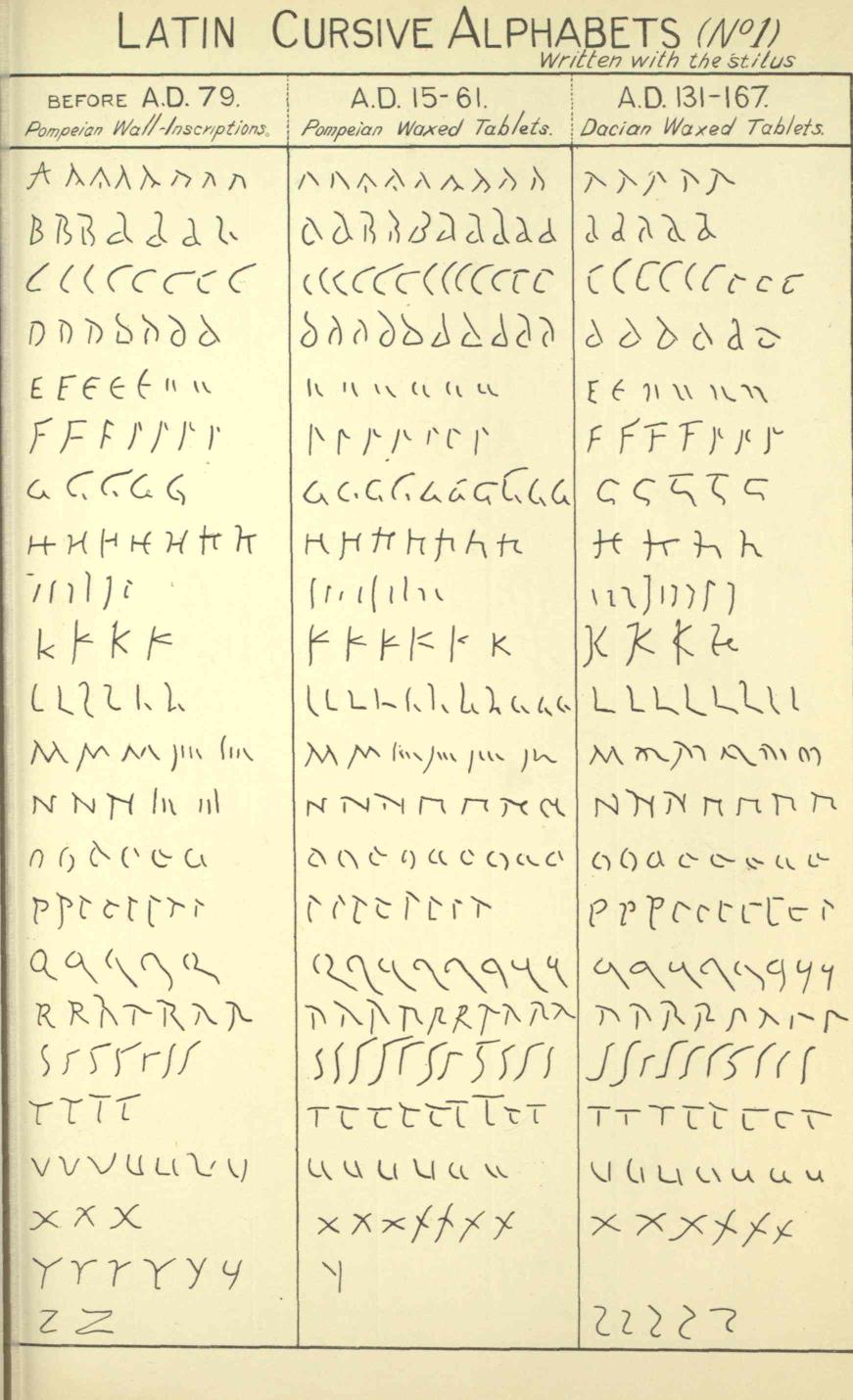
e looked much more like ה, if that table doesn't lie
and f looked like that. and if e is ii, then f is ij
and some forms of l are the opposite of f
It doesn't make sense,
In pompeian wall inscriptions lmn made l1 l3 l2 if you look to the few on the right of that.
e and n look ridiculously alike. but then desn't not not don't и and н do?
IU'm suspicious about that table, but I think I must put it in mind too. Why? Ai can keep it in mind and I should respecialize. I should teach ai to focus on this, by teaching it on my notebooks, I should dedicate myself to reaching immortality. I was given this chance of reaching it, I should put into it some labour.
Today I sent to Johannes Richter..
Bi Gi Di
Bu Gu Du
could be the syllabic 9
and I wanted to add some more information to him, but I
leave it here instead (I'm not sure he likes my
contribution, he seems to ignore it, so I even asked him
if he likes what I tell him or not, let's wait till he
answers, so far I have to leave it here:
WTR would be english water 🜄,
FR would be the two of the bar acroos it, that would do earth, not steam, weird, 🜃
Water and fire seem to be the only two which started alchemy. People probably boiled salts out of liquids first.
If 🜂🜄 were the first forms, two direction, meeting and giving birth to all the world? They were the world, the world we know is interconnection of different waves, so the first connection could be called a beginning of the world, but what it is is next stage of the world. Before that differences only grew, but two противонаправленные силы создают момент, вращение, и на микроуровне появляются все ммкм микротурбуленты
That 🜃 could be made by two 🜂🜂s or two 🜄🜄s or by 🜂 and 🜄, they both had that bar, which made me go away, (was it automatic writings?)
Пиши по русски говорю я себе.
Потому что на русском думая открыл эту тему, потому что русский первый язык, потому что русский я зщна знаю лучше и только хотел сказать что опечаток таких потому менее делаю, но и могу меньше на менее исправить если именно такую опечатку я сделал.
Потому тчо кр что русский глубже у меня и потому им больше увижу. Пусть англичане английский разбирают.
Бей Дай
Вей Зей~Жуй(зев~жёв~зоб)
а в английском Buy Die
Wij Zij
Mij Hij
in nederlandsk it's definitely pronouns
So if you ain't dutch you ain't much (ain't is a not, something not, eine niet of soms)
Э Ю Я
is A U C?
Аз~Яz
Ю~b~Вв~V~U
Это~Сие (е is lingual vowel, u is labial vowel, я is йотированно, но а is pure, even if it's ã)
UVW may also be a rudiment of grammar within abc's, because Vi is you and We is we. Is there a language which cognates latin vi and english wi? something like this would be very weird for such antonyms would thus be very homonymous.
And when me measure, we'll find that no language combinese w for we and v for you.
English has y not too far, and I think it's the very same greek ϒ which is V in old latin.
uvwxyz
Z makes great Zie
We You Zey?
You We Zey.
U W Z could easily be the last (or second) line
How is it that V and Z are in the second line of the greek alphabet, but both are only in the fifth line of the latin alphabet. Were lines existing before alphabet board? Did people use abc as a mnemonic tool before they invented alphabet of a to z or a to t kind, even if juzt a to h the z if it was αβγδεθηζ where η didn't change it's positional number, but θ was mistook for 8, when it was 6
was ζ the Ζ mistaken for 7 when tabooisation of θ began.
θ is naturally an open vulva, an image probably sacred but open for everybody to see. that this is how it all began for each of us.
a book I would like to look into:
I only wish there was a reference section. Lots of information about where the Tarot actually comes from. A good explanation of the symbols on the cards. This book covers the Major Arcana only, up to 11, Justice. Also a really cool pairing of the cards "as they must have been in the Egyptian Temple of Initiation".
Chapters are : 1 - Ancient Tarot Symbolism
2 through 12 are cards 1 - 11
13- false prophet
14- epilogue
15- the mysterious sphinx
16- the magic wand
17- symbols
18- symbolism
that they only look upon 11 cards gave me understanding that they consider other 11 to be inverted forms of the previous 11, but I still need to look into the book itself.
few pages I managed to obtain so far:
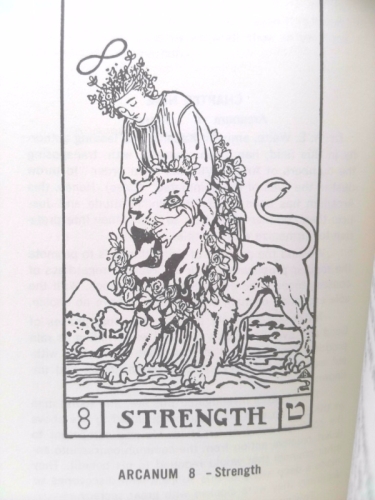

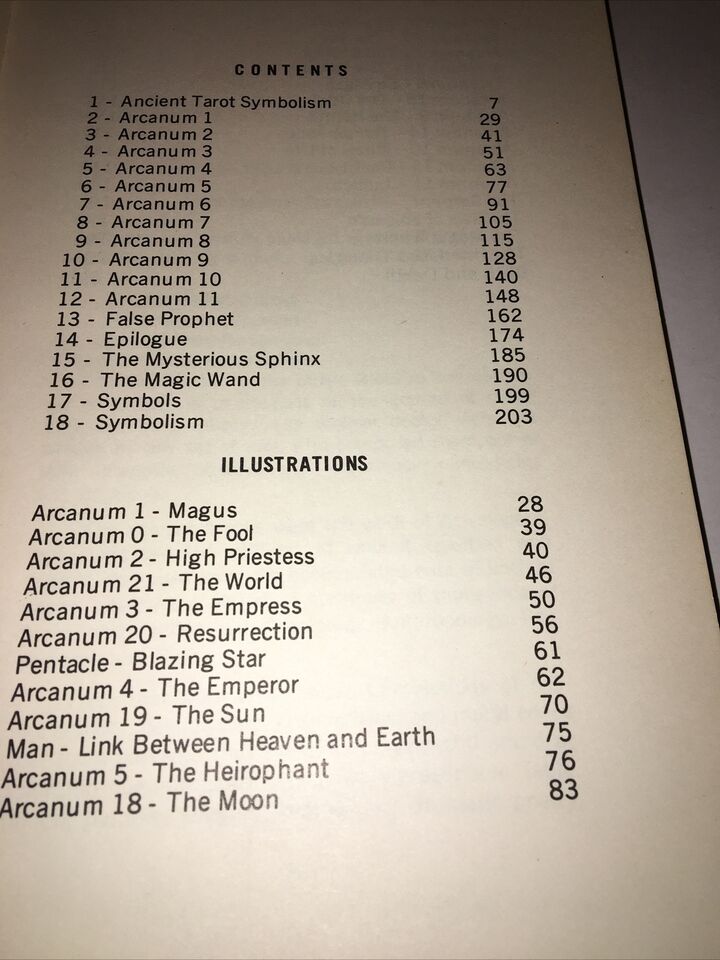

These two pages may tell how they paired arcana:
0&1 (Fool&Magus, one is the opposite of the other)
2&21 (High Priestess & The World (are these two the opposites? Magus has to choose who to serve?))
3&20 (The Empress & Resurrection)
4&19 (The Empreror & The Sun)
5&18 (The Heriophant and The Moon) probably those are not antonyms, but I have to read it to
6&17 (The Lovers and The Star) understand the principles on which he combined them thus.
7&16 (The Chariot and The Tower) but chariot and tower can be see as the opposites
8&15 (Strength and The Devil) is Devil weaknesses?
9&14 (The Hermit and Temperance) is hermit to the extreme? bous s both sustain.. of other extreme
10&13 (Wheel of Life and Death)
11&12 (Justice and.. The Hanged Man)
I can see some opposition in those pairs, as upside down tarot is, read interpreted, as runes are.
What does it give us? Well a work on tarot I could make we have made by somebody else. And he also placed 0 after 21, which is not what I would know, like why? See, have to read it.
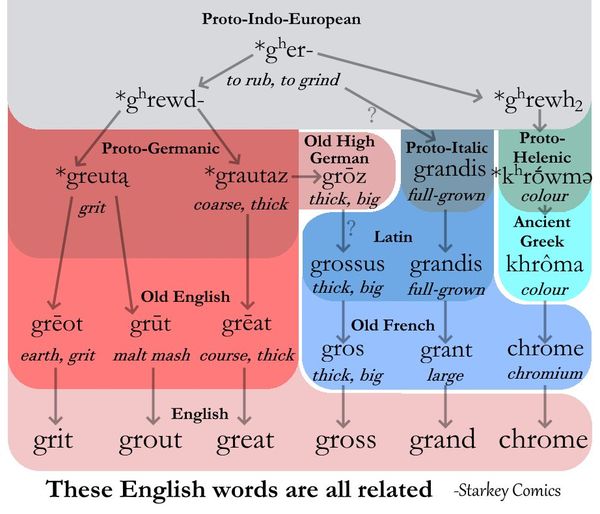
even though I have my doubts, also about great and grand being that far apart, I find it fascinating
Here I work on letter to Hans Richter, which contains some tasty bits I leave themn black
See, here is why I need a phone line: you explain it obviously thoroughly, but I get overwhelmed with questions to understand your way of thought. Even though we dig the same subject, we do so from our own unique perspectives and maybe we excavate it on different planes. I try to discover the very origin of the writing systems, thinking of marks of animals (many similar words: in russian when animal pee or poo, it метит which is also "leaves mark" even if a human does it with a chalk on a gate or pen in a notebook, that metit is relative to meaning блиен как же сложно про русский на английском писать. Пиши на руссокм когда про русский речь. И на филипинском когда смеешь что-то про филиппинский отмечать.
And edit is a good invention, I definitely can see what to cut out,
I collect some mail here, for there is a tradition of publishing the artistic and scientific correspondence and here I place quoted lines in smaller font, not of disrespect, but to show their words further in time and in a geographic perspective of second personal pronoun
::::Among the initial ideas I discovered the correlation of the Provencal word “Diéu” for sky-god and the Provencal personal pronoun of the 1st person singular “iéu”.
This one always made sense to me, because of jamaican I&I (the rastafarian personal pronoun Me as in me and god. M is definitely two people holding hands, мы (we (as wir is we(rotated))) but I got distracted. I&I is me and god, who are one.
It also makes sense in the context of very interesting homonymous antonymy in european personal pronouns: vi is you (not we) in latin and russian, ya is I, not you, and there are plenty of such. My guess is those words were names of the tribes. And names of the tribes could easily be representing the names of their god. And names of the gods have similar homonymous antonymy: god of one tribe was devil of their adversary neighbours. Deva is god in India, but satan in Iran. God is year in russian, but gad is snake. Russian word for god is bog. And if this hypothesis makes sense, it will repeat in the larger range of languages, and if it doesn't, I guess it's just a coincidence.
:::: The Provencal word “Diéu” for the sky-god is related to the Sanskrit sky-god “Diaus” and the Latin sky-god Jupiter “Dious”.
To a layman it will sound wild, but it is an official point of view and is not surprise considering that the languages are taxonomed into the same "family" (a weak concept they teach everybody in arrogant wish to claim they know what is what (japanese has plenty of similar elements as russian, so those are not branches but clouds, abstractions, maps which is not the territory))
:::: As a next step I studied Flinders Petrie's book “The Formation of the Alphabet”, which contains a relatively simple model of the 2-dimensional table of the alphabets
Yes, it is one of few places where humanity even speaks of some planar structure of the alphabet only taught as one-dimensional structure you cannot understand, only memorize.
:::: It had long ago been noticed by Lepsius, Donaldson, and Taylor that, embedded in the Phoenician, Greek, and Italian alphabets there is a repeated sequence of letters,—vowel, labial, guttural, and dental.
I didn't know the "Lepsius, Donaldson, and Taylor" part. I place this piece of dialogue into my journal, I hope you do not mind.
The other one is Ganesh-Vidya, I attach the page from it.
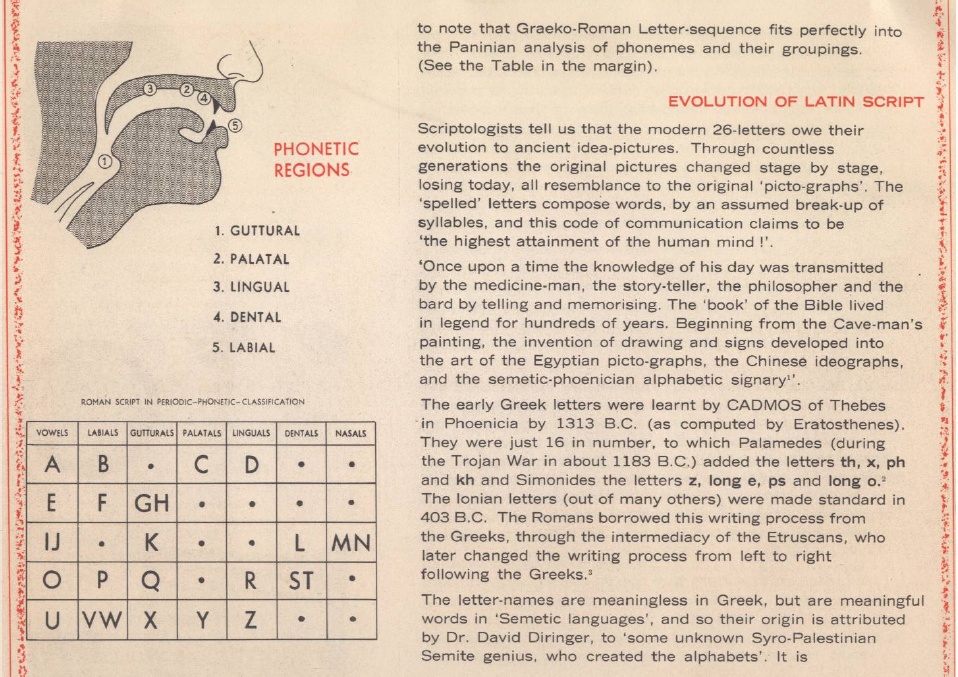
And, surprisingly the one I use is also used by pedagogs who teach heavy autists and paralized people (I attach an example, alphabet board, google it and push images, there are plenty more, and this is one of the main standards)

And it is wild that a man can find Petrie never hearing of those alphabet board, which probably have their own corpus of thought which I never read and only hardly imagine how to find, which demands open access to all the information on everything, available to ai I can work wiht.
:::: This model contained vowel, labial, guttural, and dental, but had a few errors: Flinders Petrie's categories contained “vowels”
Why wouldn't it have them? Vowels are separated from consonants in sanskrit, but who said it came from sanskrit? In my view it could come from anywhere, when linguists pretend they know something about the origin of alphabet they're lying. Today I explore the possibility of Paleo-hispanic being the origin of runes, and from runes came latin, and from latin came greek, and from greek came hebrew, each in line lost some components of the structure as they borrowed them from their neighbours.
:::: the lingual and palatals categories are nissing
Every category except vowels and labials are linguals. Linguals are common area of all those guttural and coronal we imagine, when each of them is impossible without tongue, so tongue is the agent, as lips in labial and neither in vowels (even though o and u are impossible without lips, it is not self-evident, and for ancient people all this fiels was very new, so they naturally missed or ignored some elements of reality to create the classification and systematization of the glyphs, which were already in use: compare arabic vowels looking like all the wrong vowels: their A is like I, their E is like O, their I is like U, their O is like E, their U is like.. their u is vav, it is similar to p, but not as evidently as the arabic letters which I arrogantly call vowels, because of their relative position being the position of vowels in latin alphabet (greek alphabet is much more of a mess: it contains the mess of the latin, and adds its own (second line is much more messy)))
::: I was lucky to find a model with 5 categories labial, guttural, dental, lingual and palatals.

Yes, but here I disagree with how you place them. Why invent order unknown to readers, which by itself raises plenty of questions, which overwhelms and reduce comprehension?
I think you will like work of this guy, who also compares alphabetic sequence with articulatory apparatus: https://roouh.livejournal.com/133411.html

:::: The reconstructed 2-dimensional tables displayed the words DIAUS, DIEU and DIOUS. At this study I knew I had a new insight in linguistics...
Could you describe that insight in one or two sentences? Because I understood it as some words (random to a reader) are up and down in the columns you yourself placed in that order, like why would labial be placed between dental and guttural?
:::: Good night
Good night
And writing that letter made me interested
but that board wasn't in the order origins of which I was searchin, and now I'm hopeful that I can trace the origin of that other one in the texts on reforms in aac devices.
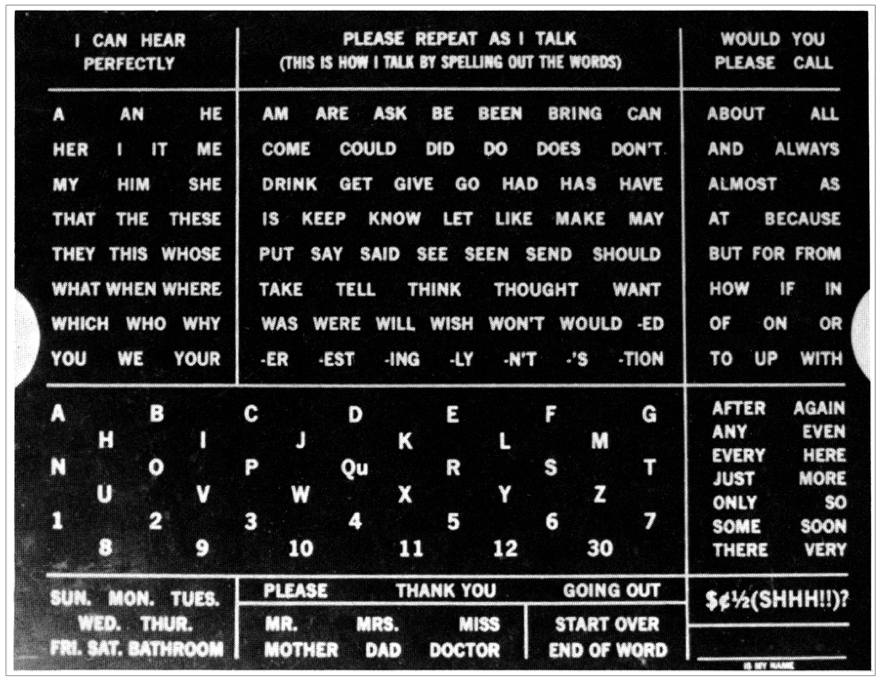
aac, nurse communication board, Communication Board for Individuals With Disabilities, but why am I looking for their origin? So I hope to find the author and then I will loiik for his or her papers, where may be the history of the question further into the outside of that field.
and my idea was to look up all th e sites containing images like
because if there's the history of them, they contain such image, and I was correct:
I kept on looking, and this one gave me understanding of which letters are more important than others:
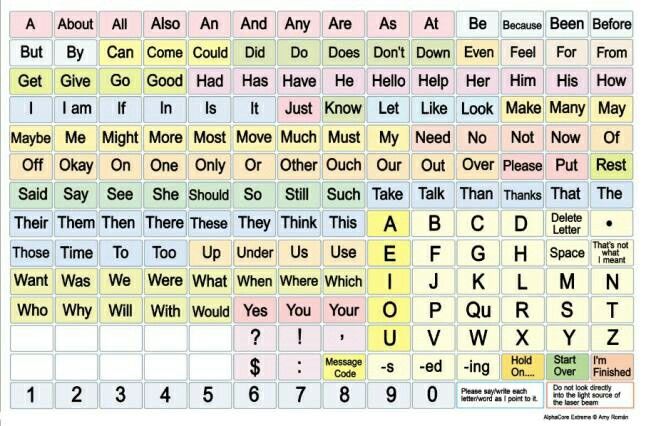
If I listen to this set of words, UWY is what follows T, all of which could be transliterated by ᚢ,
which is the only letter past ᛏ
you know where
So I digged some more, and I found few other leads:
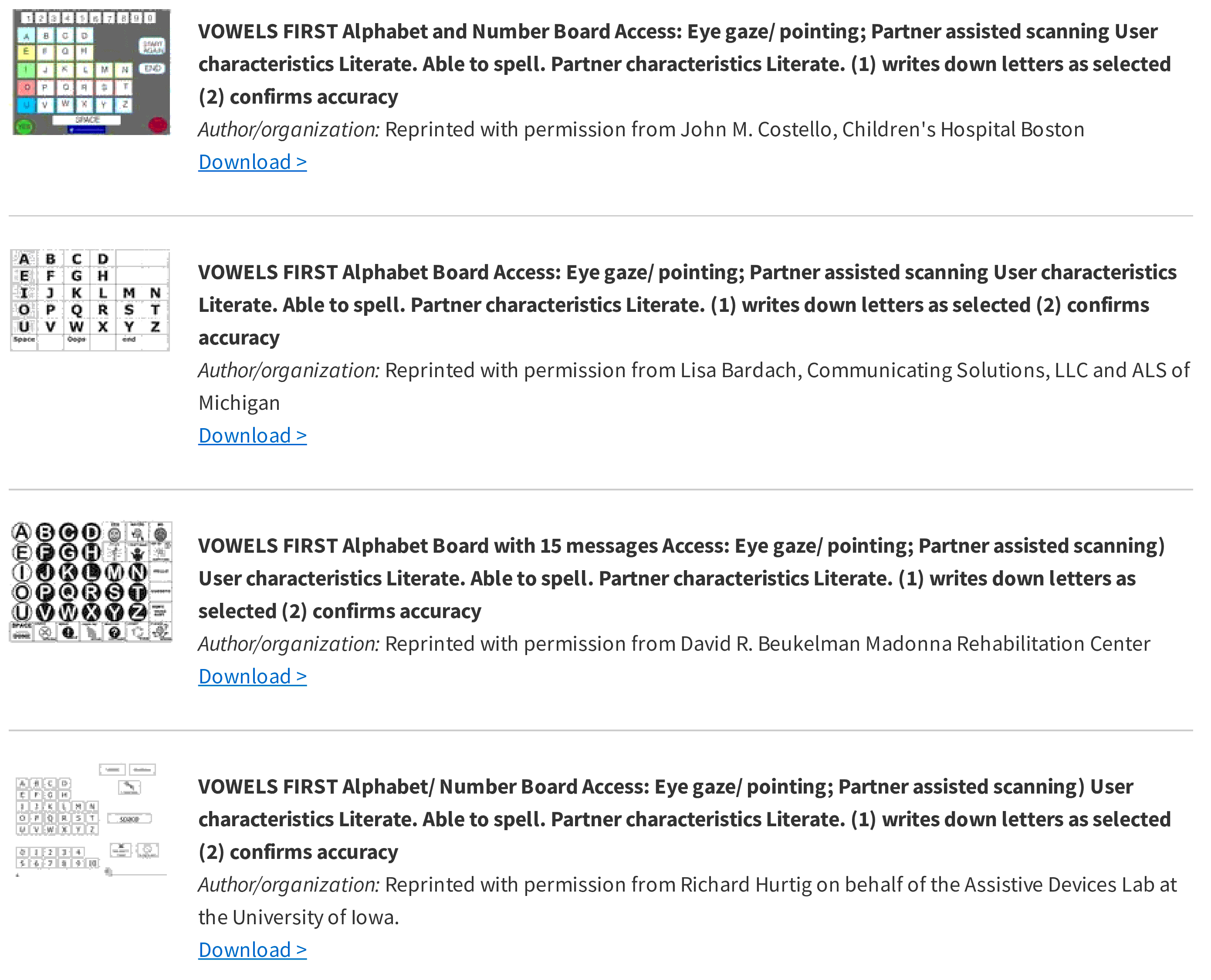
I think I'll email those four individuals with the question of whether they know the origin of this order.
I sent letters to Richard Hurtig and the John M Costello.
Lisa Bardach I found is too young to be the guy.
Unfortunately David Beukelman died over 22 months ago.
death metal is weapon (and as a musical genre it is пушка (пушка пугает (пулять пылать)))
Dimentional structures of alphabet. Is the subject I'm in. It should be the title of my dissertation.
I must make it a dissertation to do all I can for promoting this work, so it is not in vain.
י ה ו ה
is technically trigrammaton י ה ו [его?]
и e u the descending triad it is, and ה being A in these three.
бита(битая) и бито(битое) активный и пассивный залог. Проверим это
earn and own look so differently (though, first vowel, last n) but sound so similarly,.. ERE ᚱ~ᚢ!
Thinking of runes, the same symbols in hungary norway and psyberia, oh russian culture you're insane.
Thinkin of how runes read differently in different languages, which may indicate that they are some words, different in different languages and congatic in similar ones. Thus russian and latin read most of the letters the same. And can this hypothetic азбука reveal the meanings of the letters?
Petuh Ruster Рустер
пентух от слова петь, ртом! but I don't know english enough to take some roar word from the top of my hat head and hat cognatы
rooster похоже что означает птицу садящуюся на насест (roost (хвоРОСТина? бROOS?))
Моя жизнь могла быть лучше, но я глубже (глуп же (deep~dumb?))
Pentagrammaton is actually another name for Jesus (and indeed Jesus is five letters)
I think I brought this image before, what I didn't notice then is that it says יהשוה which is יהוה with ש inside of it, and what would jews think of that? especially since ש is tooth, but if it's fire, than also what is it? the very essence of יהוה or what? It's open for interpretation. But then is it not yeʃua, but yeʃue?
And isn't יהוה yeve the Eve, and isn't it Jovi? Is Jupiter father of the jews? Is jew je, the personal pronoun corresponding to an ancient tribe?
That יהשוה reminds יְשִׁיבָה, even though literally they're quite different, יהשוה is read by g as ехашо́
ישו [е́шу́] which is much closer to יְשִׁיבָה [ешива́]
g.t. doesn't recognize יהשוה the way it is in this context, but translates it as will compare (but I do not know knebrew hebrew to confirm)
But then why is it here? It is chronologically very late, much later than the origin of alphabet:
The first ones to use the name of Jesus something like "Yahshuah" were Renaissance occultists. In the second half of the 16th century, when knowledge of Biblical Hebrew first began to spread among a significant number of Christians, certain esoterically minded or occultistic circles came up with the idea of deriving the Hebrew name of Jesus by adding the Hebrew letter shin ש into the middle of the Tetragrammaton divine name yod-he-waw-he יהוה to produce the form yod-he-shin-waw-he יהשוה.
This was given a basic Latin transliteration JHSVH or IHSVH or IHSUH (since there was no letter "W" or sh / [š] sound in Latin, and "I" and "J" were then not yet clearly distinguished as letters of the alphabet, nor were "U" and "V"). This could then be supplied with further vowels for pronounceability. By coincidence, the first three letters of this consonantal transcription IHSVH, etc. were identical with the old IHS/JHS monogram of the name of Jesus (from Greek iota-eta-sigma).
In Renaissance occultist works, this pentagrammaton (or five-letter divine name) was frequently arranged around a mystic pentagram, where each of the five Hebrew letters י ה ש ו ה was placed at one of the points (the letter shin ש was always placed at the upward-pointing vertex of the pentagram).[2] One of the earliest attested examples of this diagram is in the Calendarium Naturale Magicum Perpetuum or "Magical Calendar" (published 1620 but dated 1582)[3] of either Theodor de Bry (Flemish-born German, 1528–1598) or Matthäus Merian the Elder (Swiss, 1593–1650).[4] The idea of the pentagrammaton was funneled into modern occultism by 19th-century French writer Eliphas Levi and the influential late 19th-century Hermetic Order of the Golden Dawn. The Golden Dawn favored the consonantal transcription IHShVH or YHShVH, and the pronunciation Yeheshuah.
In Hebrew and Aramaic, the name "Jesus"/"Yeshua" appears as yod-shin-waw-`ayin יֵשׁוּעַ Yeshua and as the longer form of the same name, yod-he-waw-shin-`ayin יְהוֹשֻׁעַ "Joshua"/"Yehoshua". The letter `ayin ע was pronounced as a voiced pharyngeal consonant sound in ancient Hebrew and Aramaic, as opposed to the pronounced [h] sound or a silent Hebrew letter he ה.
But it plays with the concepts I introduced into this research. And the concepts are deep as can be, so I collect everything of potential value, regardless if everything of the quoted text is correct or not.
A pentagram (sometimes known as a pentalpha, pentangle, or star pentagon) is a regular five-pointed star polygon, formed from the diagonal line segments of a convex (or simple, or non-self-intersecting) regular pentagon. Drawing a circle around the five points creates a similar symbol referred to as the pentacle,[1] which is used widely by Wiccans and in paganism, or as a sign of life and connections. The word "pentagram" refers only to the five-pointed star, not the surrounding circle of a pentacle.
Pentagrams were used symbolically in ancient Greece and Babylonia. Christians once commonly used the pentagram to represent the five wounds of Jesus.
The word pentagram comes from the Greek word πεντάγραμμον (pentagrammon),[2] from πέντε (pente), "five" + γραμμή (grammē), "line".[3] The word pentagram refers to just the star and the word pentacle refers to the star within a circle, although there is some overlap in usage.[4] The word pentalpha is a 17th-century revival of a post-classical Greek name of the shape.[5]
It is not some random stuff, I brought it here because the word alpha is present in pentalpha, and they say it is a greek name of that shape, and it correlates with the pentagram-like shape of A, so are there betta in some other polygram? But no, this loose end leads nowhere. Or does it?
From Ancient Greek πένταλφα (péntalpha), from πέντε (pente) and ἄλφα (alpha), five alphas. So called for its resemblance to five alphas superimposed at different rotations.
Hygieia is a goddess from Greek mythology (also referred to as: Hygiea or Hygeia; /haɪˈdʒiːə/;[1] Ancient Greek: Ὑγιεία or Ὑγεία, Latin: Hygēa or Hygīa). Hygieia is a goddess of health (Greek: ὑγίεια – hugieia[2]), cleanliness and hygiene. Her name is the source for the word "hygiene".
Hygieia is related to the Greek god of medicine, Asclepius, who is the son of the Olympian god Apollo. Hygieia is most commonly referred to as a daughter of Asclepius[3] and his wife Epione. Hygieia and her four sisters each performed a facet of Apollo's art: Hygieia (health, cleanliness, and sanitation); Panacea (universal remedy); Iaso (recuperation from illness); Aceso (the healing process); and Aegle (radiant good health).
"Hugieia" (ύγιεία: health) was used as a greeting among the Pythagoreans.
It's weird how they spell it wrong in spite of the pentagram spelling it.. ύγιεία.. it is how it spells it, the right bottom figure is not Η, but dygraph of ει.
A B C [a б g]
I Mw NΛ [i w n] as an example
U F X [u f h]
b d
p q
p q
b d
E ж З
И m N
but I do not see such symmetry in other lines, only that A reminds Д and O reminds Q which fits the
so pbd and pq are the EЗ- and ИN-like reflections?
bdEЗИNpq? It doesn't make sense, unless they're two different pre-alphabetic structures..
From Ancient Greek πένταλφα (péntalpha), from πέντε (pente) and ἄλφα (alpha), five alphas. So called for its resemblance to five alphas superimposed at different rotations. makes me think of western greek form of A↙︎drawn large

Oscan is fascinating particularly in it having a R-like glyph for D and D-like glyph for R. They're mirrored, but then so is B and E and C the G, and their V looks like ..well, ב, but I saw such b in a table of some more obscure writing systems, I cannot find them now. Or maybe I just poorly remembered that oscan F? But ב is just what? I found it by accident looking through my collection of fonts, I didn't link those two memories. I do now. And thus IOO recognize
That typo of IOO tells me of Io, name of god and possible reading of י ה ו ה
another reading of י ה ש ו ה is Eve. And it is spectacular that Eve and Io are both female deities mythologic figures (before Eve was just a creature of God, it probably was the Great Mother, the ultimate goddess of the ancient people. It's later we speculated ourselves higher causes and did them all wrong, but those ancient representations are haunting my mind to this day, even though I'm mostly atheistic and materialistic, recognizing yet some thinner planes or rather spaces within the rude figures we call bodies, and those thinner wavefields create some complex life within itself. Speculating about the world I can do it the way guys who created alphabet thought. Both being smart white autists, we naturally share the culture, even though in its different periods. And because we keep on having records since those days, I suspect the good pieces to be repeated over and over in our narratives (only some powerful ai can tell after reading everything of the matter)
That typo, IOO, reminds me of Io being both italian first person personal pronoun and name of a deity
Je is I in french and reminds Jah a lot. But then was io and Io in latin at the same time? Are french Jamaican? What is Jah? Jovi! Jupiter (father of jews? how old is the subversion?)
The Lepontic from the table above is different than this:

Let's add other examples of this group: Umbrian (7th century to the 1st century BC)
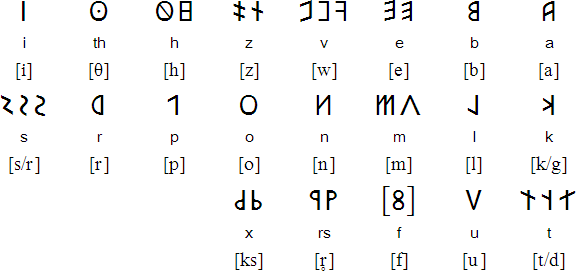
Faliscan (7th and 2nd centuries BC)
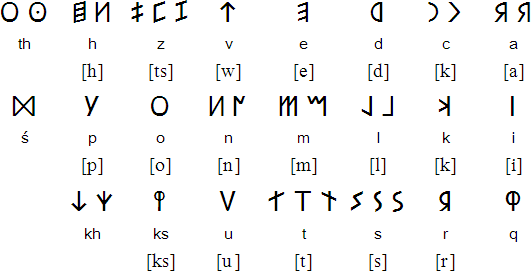
North Picene (North Picene was spoken in the central-eastern Italy. It is known from four inscriptions which date from the 1st millenium BC, and consist of just 60 words. It was written with a version of the Old Italic alphabet, and therefore the words can be read. However their meanings remain a mystery. One of the inscriptions is known to come from the Servici Cemetry in Novilara, a village near Pesaro in the region of Marche. The other inscriptions are thought to come from the same place, however their archaeological provenance is uncertain. It is thought that the inscriptions date from about 650 BC. (right to left in horizontal lines))
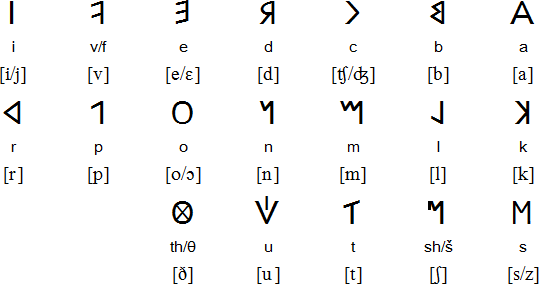
So how did they transliterated them if the meaning is a mistery? They just recognized the old italic alphabet in that, the d as Я is spectacular, the D~R link enforced by it. And look at faliscan, that symbol is A there, which enforces the hypothesis of A~D affinity.
South Picene: (South Picene is an extinct Italic language that was spoken in east central Italy in the Marche and Abruzzo regions. The language is thought to be part of the Osco-Umbrian group of Italic languages. South Picene is also referred to as Mid-Adriatic or Paleo-Sabellic.
There are 23 known inscriptions on stone and bronze in the South Picene alphabet, which date from between the 6th and 4th centuries BC. The alphabet resembles the southern Etruscan alphabet. Most of the inscriptions are on grave stones, but some are on statues)
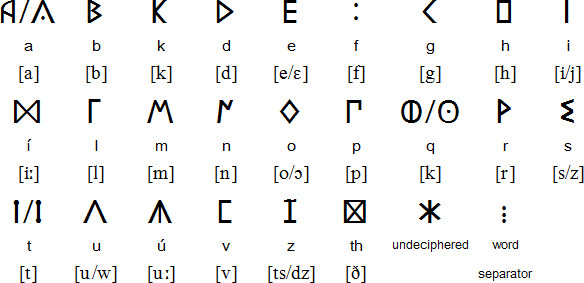
Remember that because they don't mention found abecedaries, the alphabetic order is unknown, here they're just arranged along the etruscan abecedary (whether that one.. Marsiliana.. is genuine or not I know not, but then what do they matter, initially I wanted to make it basing my focus solely on modern state of alphabet, because people who kept the tradition alive must have known something so they did it just right, such was an assumption, and then I was pushed into the obscurity of the antiquity by the critics who were harsh but just as they thought, but they were quick to attack, they just dissipated when I started answering their questions, but then not that time, that time got me and I have absorbed tons of ancient material, and who knows how authentic that material was. See, I attack the world, the world attacks me back.
Notice that in the South Picene that ב-like shape is recognized not as f, but as v
their f is just :, like what was going on there? ᛙ is t, not m, which is funny, since russian т is т
So, old-italic stage is how old the runic tradition is, and just because norsk ruine runes were in use later, doesn't mean they're of some later tradition, because the tradition of runes preserved in norsk territories is deeper than alphabetic tradition we know. As I wrote in that letter, borrowers lost some elements of the borrwoed rwriting system, they didn't add heresies to it, they deemed heresies what they didn't know. By authoritarian hierarchy, not by some meritocracy.
Some more oscan:
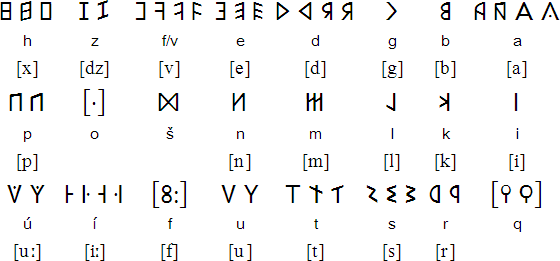
Oscan was an Italic language spoken in southern Italy between about the 5th and 1st centuries BC. It was spoken by the Samnites, Aurunci (Ausones) and the Sidicini in the in Samnium, Campania, Lucania and Abruzzo. After the territory occupied by the Oscans was conquered by Rome in the first century AD, the Oscan language and culture disappeared.
Oscan was related to Latin and Umbrian, and is known from a number of inscriptions. It was written with the Latin and Greek alphabets, and with its own alphabet, which was adapted from the Etruscan alphabet sometime in the 7th century BC.

They say right to left in horizontal lines
but then why does that metal plane looks like it goes from right to left?

A terracotta marker with an Oscan inscription and stamps showing a helmeted Athena and a boar. This marker was found in a tomb near Capua in Italy and dates from 300-250 BC. The inscription reads "VIRIIUM VESULLIA[IS] DEIVIN[AIS], 'of the Virrii family for the divine festival of the Vesulias'. Such stamps appear on currency, and may devote gifts of money by the Virri family.
If the images are vertical like this, doesn't it tell that oscan went in columns?
Then that other artefact could be read like this:

This bronze tablet with an Oscan inscription dates from 300-100 BC and is thought to be from Agnone or Capracotta. The inscription is about the dedication of statues of various deities.
Photos by Simon Ager, taken in the British Museum.
I'm satisfied with that Я looking the same direction on both pictures now.
Those elements to the left could be hinges of a metal book.
In the 5th century BC, Latin was just one
of many Italic languages spoken in central Italy. Latin
was the language of the area known as Latium (modern
Lazio), and Rome was one of the towns of Latium. The
earliest known inscriptions in Latin date from the 6th
century BC and were written using an alphabet adapted
from the Etruscan alphabet.


During the 15th century, Latin began to lose its dominant position as the main language of scholarship and religion throughout Europe. It was largely replaced by written versions of the vernacular languages of Europe, many of which are descendants of Latin or have been heavily influenced by it.
Modern Latin was used by the Roman Catholic Church until the mid 20th century and is still used to some extent, particularly in the Vatican City, where it is one of the official languages. Latin terminology is used extensively by biologists, palaeontologists and other scientists to name species and specimens, and also by doctors and lawyers.
A few schools teach Classical Latin as a spoken language, and there are currently maybe 100 or so people who speak it fluently.
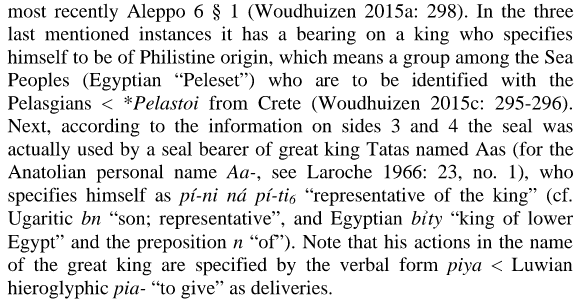 (mirror)
(mirror)
Pelasgians (the ones from whom greeks actually took their writing, though the querstion remains if that was not the previous one, the Linear B or something) are Philistine, can you believe it! And those are Palestinians. Fucking hell!)))
but this is no laughing matter
The English term Philistine comes from Old French Philistin; from Classical Latin Philistinus; from Late Greek Philistinoi; ultimately from Hebrew Pəlištī (פְּלִשְׁתִּי; plural Pəlištīm, פְּלִשְׁתִּים), meaning 'people of Pəlešeṯ (פְּלֶשֶׁת)'; and there are cognates in Akkadian Palastu and Egyptian Palusata;[6] the term Palestine has the same derivation.[7] The native Philistine endonym is unknown.
But then what modern palestinians have to do with those palestinians? Palestine is just the roman province, what ethnicities inhabit it is not constant. Currently palestinians are arabs who invaded that place and slaughtered whoever lived there before them. Probably this is one of the most common means to "assimilate" the substrate of whatever you conquer.
Rabbinic sources state that the Philistines of Genesis were different people from the Philistines of the Deuteronomistic history (the series of books from Joshua to 2 Kings)
but that book keeps on delivering:

I didn't know Linear A was translated. What are they talking about? The work seems legit though.
(or were they possible to conceptualize dot, line and plane from something else? even though mark has two meaning, and because писа́ть~пи́сать
C: see ~ посмотри (где по приставка, а смо~само~самъ) штрих ещё одно слово содержащее три.
но также и вотри, сотри, три~сотри
(where со is not with, but off)
The ancient Egyptian calendar – a civil calendar – was a solar calendar with a 365-day year.
The year consisted of three seasons of 120 days each,
Each month was divided into three 10-day periods known as decans or decades.
Because this calendrical year was nearly a quarter of a day shorter than the solar year, the Egyptian calendar lost about one day every four years relative to the Gregorian calendar. It is therefore sometimes referred to as the wandering year (Latin: annus vagus), as its months rotated about one day through the solar year every four years. Ptolemy III's Canopus Decree attempted to correct this through the introduction of a sixth epagomenal day every four years but the proposal was resisted by the Egyptian priests and people
So they divided a year into three and month into three, but 12 months, 10 days per week,
were 7 10 12 magic numbers. Are they not today?
7 is.. where did I take 7? moon was leap just as sun? 30 day months are half a day longer than that of the moon. Thus they would count six extra days per year. But then those 6 days could be compensated by a 11 month year each 5 years? That the monster they were scared of ate one moon each five years? But how would the annus vagus (almost literally anus and vagina, wtf is going on here? How would christians treat texts from other civilizations? They would censor it to death for one)
The ancient Egyptian calendar – a civil calendar – was a solar calendar with a 365-day year.
The year consisted of three seasons of 120 days each,
Each month was divided into three 10-day periods known as decans or decades.
Because this calendrical year was nearly a quarter of a day shorter than the solar year, the Egyptian calendar lost about one day every four years relative to the Gregorian calendar. It is therefore sometimes referred to as the wandering year (Latin: annus vagus), as its months rotated about one day through the solar year every four years. Ptolemy III's Canopus Decree attempted to correct this through the introduction of a sixth epagomenal day every four years but the proposal was resisted by the Egyptian priests and people
So they divided a year into three and month into three, but 12 months, 10 days per week,
were 7 10 12 magic numbers. Are they not today?
7 is.. where did I take 7? moon was leap just as sun? 30 day months are half a day longer than that of the moon. Thus they would count six extra days per year. But then those 6 days could be compensated by a 11 month year each 5 years? That the monster they were scared of ate one moon each five years? But how would the annus vagus (almost literally anus and vagina, wtf is going on here? How would christians treat texts from other civilizations? They would censor it to death for one)
And what am I doing here (isn't and collection of russian conjugations а и да? and~айда?)
иду = да
айда есть да в ответ на нет
and could easily be n (in dutch it is en (in is aan, op, bij, te, and even uit (out))) but they neeed to make people write а and дa too (now I know this is the weakest, the wickedest, some of the wildest takes in this book, but then what, why not)
weird, that tarot have the card for devil, but not for god. Is it why it's satanic? demonic? witchy
numerology was naturally intwined into tarot (and probably righteously so, because nobody seem to challenge it at large) so I can use tarot as a classboard to learn beliefs of the witches even if technically it is not that ancient, neither is ouija, but how did it get such vowel name? оуия it is. And thus it gives away another sequence of vowels. UIA, VIɅ
what is viy? вий, что это? что-то страшное. В Украине что-то значит более, надо учить украинский. Если заменить английский украинским, то изучение его займёт всего год, и по завершении курса ученики сумеют говорить (в отличие того как сейчас дело обстоит) и тогда им будет проще учить польский, немецкий, голландский, английский. Представь страну полиглотов. Европа страна полиглотов, и смотри какие они крутые. Географически так получилось, что все языки европы рядом живут. Но венгерский наверное только эстонцы знают иногда.
Be GooD
CSee GooD
Doo GooD
Ef Gh? И кто мне обещал, что past-abcd lines are read as abcd is?
I'm NL Nobody promised, but it would be cool. But likely it is not
Opf Que aRe SeT or I have seen it already. So far I only saw some grammatic
structures described by the set, as if
I can see where they took the meaning of letters.
Be
See
Do
or
Be
Go
Do
Be
Do
and other variants are what they're, variants. The same shape united both reading.
Go is more true to the column of velars, to the palehispanic syllabary. But it is overcomplication, performed in latin. Others seem to distinguish only Be and Do, passive and active, yin and yang.
Be/Go See/Do
As you can see, I can only guess. But the more I guess into it the better I can see it.
How can готов be got off? What kind of coincidence is that? Is it even coincidence at all? We tend to jump to such conslusion, becuase otherwise we'd have to explain at what evern event it could happen, but the even probably was prehistoric, even if it wasn't it wouldn't be recorded.
Беги ~ be gone.
летит ~ le tit?
see, such parallels are based on nothing,
жили были ~ же ли - бы ли?
Be
See
Do
or
Be
Go
Do
or
Be
Do
and other variants are what they're, variants. The same shape united both reading.
Go is more true to the column of velars, to the palehispanic syllabary. But it is overcomplication, performed in latin. Others seem to distinguish only Be and Do, passive and active, yin and yang.
As you can see, I can only guess. But the more I guess into it the better I can see it.
How can готов be got off? What kind of coincidence is that? Is it even coincidence at all? We tend to jump to such conslusion, becuase otherwise we'd have to explain at what evern event it could happen, but the even probably was prehistoric, even if it wasn't it wouldn't be recorded.
Беги ~ be gone.
летит ~ le tit?
see, such parallels are based on nothing,
жили были ~ же ли - бы ли?
Dharma (/ˈdɑːrmə/;[7] Sanskrit: धर्म, romanized: Dharma, pronounced [dʱɐrmɐ] ⓘ; Pali: Dhamma) is a key concept with multiple meanings in the Indian religions of Hinduism, Buddhism, Jainism, and Sikhism, among others.[8] Although no single-word translation exists for dharma in English (or other European languages),[9] the term is commonly understood as referring to "order and custom" that sustain life, "virtue", or "religious and moral duties".[10][11]
yes, I believe that ध र्म are D B, or rather З Б, being those BT of the greek myth, being MS of the jewish myth known from sefer yetzirah: म is literally Ma, and look how ध reminds ש and isn't र् which is that swasy above म, historically vowel? But no, the stroke below र may be, but र is not
𑀥𑀁𑀫 is dharma written in brahmi script, and here it is clear that 𑀥 is D and 𑀫 is M (and ᛘ)
From Sanskrit धर्म (dharma), from Proto-Indo-European *dʰer-mos. Cognate to Pali dhamma, Sauraseni Prakrit 𑀥𑀫𑁆𑀫 (dhamma).
Shauraseni Prakrit (Sanskrit: शौरसेनी प्राकृत, Śaurasenī Prākṛta) was a Middle Indo-Aryan language and a Dramatic Prakrit. Shauraseni was the chief language used in drama in medieval northern India. Most of the material in this language originates from the 3rd to 10th centuries, and represented a regional language variety with minor modifications to the same linguistic substratum as other Dramatic Prakrit varieties.[1] It may be based on the spoken vernacular around the 2nd century BC in the ancient state of Surasena.
Among the Prakrits, Shauraseni is said to be the one most closely related to Classical Sanskrit in that it "is derived from the Old Indian Indo-Aryan dialect of the Madhyadeśa on which Classical Sanskrit was mainly based."[2]: 3–4 Its descendants include the languages of the Hindi Belt, the Central Zone of modern Indo-Aryan or Hindi languages.[3]
Prakrit (/ˈprɑːkrɪt/; Sanskrit: प्राकृत, Sanskrit: prākṛta; Telugu: prākrutam; Kannada: pagada ; Tamil: pāgadam; Shauraseni: 𑀧𑀸𑀉𑀤, pāuda; Jain Prakrit: pāua) is a group of vernacular Middle Indo-Aryan languages that were used in the Indian subcontinent from around the 3rd century BCE to the 8th century CE.[2][3] The term Prakrit is usually applied to the middle period of Middle Indo-Aryan languages, excluding earlier inscriptions and Pali.[4]
Prākṛta literally means "natural"[dubious – discuss] as opposed to saṃskṛta, which literally means "constructed" or "refined".[4] Prakrits were considered the regional spoken (informal) languages of people, and Sanskrit was considered the standardized (formal) language used for literary, official and religious purposes across Indian kingdoms of the subcontinent. Literary registers of Prakrits were also used contemporaneously (predominantly by śramaṇa traditions) alongside Classical Sanskrit of higher social classes.[5]
c. 1500 – 600 BCE (Vedic Sanskrit);
700 BCE – 1350 CE (Classical Sanskrit)
The most archaic of these is the Vedic Sanskrit found in the Rigveda, a collection of 1,028 hymns composed between 1500 BCE and 1200 BCE by Indo-Aryan tribes migrating east from what are today Afghanistan across northern Pakistan and into northwestern India.
The Rigveda hymns were composed and preserved by oral tradition. They were memorized and verbally transmitted with "unparalleled fidelity" across generations for many centuries.[28][82] According to Barbara West, it was probably first written down about the 3rd-century BCE.[83][84] The manuscripts were made from birch bark or palm leaves, which decompose and therefore were routinely copied over the generations to help preserve the text.
There are, for example, 30 manuscripts of Rigveda at the Bhandarkar Oriental Research Institute, collected in the 19th century by Georg Bühler, Franz Kielhorn and others, originating from different parts of India, including Kashmir, Gujarat, the then Rajaputana, Central Provinces etc. They were transferred to Deccan College, Pune, in the late 19th century. They are in the Sharada and Devanagari scripts, written on birch bark and paper. The oldest of the Pune collection is dated to 1464. The 30 manuscripts of Rigveda preserved at the Bhandarkar Oriental Research Institute, Pune were added to UNESCO's Memory of the World Register in 2007.[85]
It's a pleasure to tell the truth. People lie when they're affraid: врёт~срёт(от сраха (прикинь, не только худо, но и страх происходят от неприличных слов))
хуй похоже инский, плохой, в русском языке
пизда хороший. давай сравним.
Язык из матриархальной культуры? Где мама - очевидно лучше чем папа.
до изобретения богов, семья и люди вокруг твой пантеон. Кого-то обзывают именем персонажа культуры, таким образом "архетипы" реализуются в людях. Древние типы? Я не читал, только слышал термин, необразованный, но получая образование я бы этой книги не получил где я живу, в общем, самообразование единственное образование имеющее значение. В остальном людей надрессировали сдавать тесты, без гарантии дать таким образом человеку понимание. Но я же понял как работает станок, когда чертёж его внутренностей рисовал. Помню, меня это не увлекло совершенно, у меня были совсем другие цели поступления. Оболваненый школой я понятия не имел для чего поступаю тупо карабкаясь по служебной лестнице. Но начал бухать даже раньше чем начал курить шмаль. Это было чудовищно, я сумасшедший в состоянии алкогольного опьянения. И кто не сумасшедший в таком состоянии? Тот кто не превышает рекомендованных дозировок. Тот, кого научили пить алкоголь.
AEIOU and EIOUA coexist in a ring with those five letters.
IEOUA being the common modern form tells me that E~I (i is dotted e (see both letters handwritten))
and looking for examples, I played big:
William Shakespeare's handwriting is known from six surviving signatures, all of which appear on legal documents. It is believed by many scholars that the three pages of the handwritten manuscript of the play Sir Thomas More are also in William Shakespeare's handwriting.[1][2][3] This is based on many studies by a number of scholars that considered handwriting, spelling, vocabulary, literary aspects, and more.[4]
how could that be that not a single play in his hand is found? Was it staged orally?
here, maybe they found something:

and that wikipage had an abecedary, but i is missing

and e is not what I had in mind:
..and it seems nobody draws i with belly under dot, as if it was ė, but I did, I took pleasure in it, as a kid.
but looking at other people's hand I can see that e to i is like Б to Г. no, like Б to Г̇ or like Б to Г̣
Wtf is the minuscule b, no wonder I couldn't read the text above it. And it recollects bc.html, I copy that image to bc.html, whatever it is, it is fascinating. Let's notice what is unusual by lines:
The first line tells that it is not english, not only by alphabete instead of alphabet (notice the unusual h)
also because


I was speaking of i looking like ė, and here Felis in older version is Feles in the newer looking edit.
And I took that e~i thing from eioua being ieoua, and because ᛂ is literally ᛁ with dot.
And because ᚠ~ᛘ and ᚵ~ᚴ~ᛚ~ᚿ and dots may tell where which letter appeared. If that table was accurate, G is from K, a voiced form of K is later, it's natural. And isn't it why G is also dʒ? Why? what's the meaning? Because C is that K, K is staved C, C is staveless K, thus ᚲ is staveless ᚦ. and it exposes ᚦ as Г more than Д, though ᚦ reminds not only D, but also Д (think of runes going from the bottom corner with ᚦ being rotated and thus looking like Д.

And here is example of lines without going no reverse boustrophedon.
But the line on the bottom of the text is upside down. And it seems to be in different set of letters from the main body of the text, and of the same set of letters as the left-most vertical line, and thern three lines at the top of the stone act weirdly: two of them go in linew we modern people do, but the third one flips to reverse boustrophedon. And of those three lines, two and a half go in the fontface of the main part, and then it ends with plenty of ᛟ, which is only used in the counter lines, and plenty of ᛌ's not used elsewhere, and it ends with ᛇ also not seen elsewhere. It all screams "fake" into me, but then I say it to calm down, I don't know what is the reason behind those discrapancies discrepancies (my english part knew that word and it knew it right, it fits here perfectly, while russian part didn't know what it meant)

eioua, I told you, boey
 (mirror)
(mirror)Tabula Angelorum Bonorum 49
I brought it here to show how B is the first letter, like ultimately, like so many times, like why

Duodecim gestata Vexillis
That book starts with O IEOVA ZEBAOTH, which is obviously O Jahweh Savaof, and it shows it's not Jahweh, not JHVH, but IEOUA, as I read after or before I rationalized it myself (I know I found it after I consciously figured that order, but chances are I read it and knew it subconsciously at first)
and g.t. recognizes IEOVA as Jehovah, so it is not some obscure secret name, it seems to be regular latin.

And I can read latin now! What an impressive technology. It seems some other guys are going to deliver what I was working for. Well, my approach is thoroughly different, and thus it is of value. I keep on doing what I am doing and at some corner I will come out first.
But I brought that duodecim gestata vexillis here because of two words catching my attention:
Meridies et Septentrio, because from the context I recognize them as north and south, and on the basis of південь~south and північ~north (even though now I can see that полдень is noon and not summer, and полночь is midnight and not winter. But why do I guess if those other words are west and east or morning and evening, let's ask g.t:
Meridies et Septentrio is South and North, but they remind me March and September. And march opens hot season, september begins the winter, thus north. Interesting theory, but let's not jump to conclusions
Oriens et Occidens are East and West. And they don't remind any months to me, but then they are etymologically speak about what sun is doing, while South and North are understood by the calculation

So, interesting shapes are:
a with a stave(ᚪ?)
b like k
c like г
D and d like Ↄ and ט
e as к and e as ט and reverse e
E as C with 2 in it, as if e is the second form of C (is i third then?)
E as Cz, and E as something different
double f as П, and what is that whirl at F and G
between g and h what is it? is it G or is it H?
some weirdest forms of H, which why would I recognize?
I as J, no big surprises here, only where is the minuscule fform? it's around l in il, but what?
only it is dashed. Why would it be dashed?
In such diversity of shapes I don't
even notice such trivial decoration.
Some forms of k show how that weird fraktur form 𝔨
appeared, and if your browser shows it as R with long
stave, here, I copypasted the abecedary with form of 𝔨 I
was referring to:Some forms of M look like Ж, and is it related to ᛘ~ᛉ и Мать~Жена?
Some N also have a weird form, or is it M? M's and N's are mixed together, the couple of small ones after that, are they m or n or ŋ?
double o as ∞ is very sweet.
And then some O reminding D very much, even the dot, even the double column.
Some P's are very weird, one reminds handwritten ף, other looks like 4e,
Q's are normal (so are F's, does it tell that they're newer? look at the table above and its Q as Oſ)
R shows its direct relation to k, and one of its shapes is extremely off the wall,
some s remind з or ξ, some s remind σ, some s remind t!!!
some W's looking very much like M make me think of woman having that very W which is M
M of имею, м of моё
W от awe and owe and own, M от my and mine (ne in mine is probably の in 私の (is 禾 m, is ム(or 厶) い? ))
厶 Radical 28Radical 28 meaning "private" is 1 of 23 Kangxi radicals (214 radicals total) composed of two strokes.
In the Kangxi
Dictionary there are 40 characters (out of 49,030) to
be found under this radical.
ム is mu in katakana (not i, could be due to .. what am I
talking about! I take some wild allegations, even
assumptions, and I apply them to actual corpus of not one,
but ALL languages? just few. Okay, just few. But what does
it serve? Drawing never noticiing
do d noticed axons.In that previous typo I probably wanted to tell than not ing but ed, but my suc subconscious mind told that do is that ed.
do ~ ago (for go ~ иду (и энд а пробабли ар negating prefix un in (u ~ и (is un a form of in, which is a from af i, which is probably ã))))
X and Y look very similar, I would only recognize them from the context.
some z's are like s's with swashes and some z's are like wut
does the upper swash of a tell that it is something wider than o?
I can see how future and будущее are cognates, and in it I can see how ᚠ and ᛓ are the same, but I need more examples of english f being russian б (see how the belly of the б can be a swash)
And before I was speaking of ᚠ ~ ᛘ, so now I see ᚠ~ᛒ, the double wave up. but then the ᚴ~ᚿ thing tells that it doesn't matter if it goes up or down (one way it goes up, flipping into reverse boustrophedon it goes down, and visa versa)
is (cossack)казак косарь(scytheman)? (in hebrew a similar word חָזָק is strong)
(scythe)коса cuts and why did they call braid коса as well?
scythe and sickle share the sc part, в русском это понимается как с(off) к(to, but also k of cut and kill, somehow russians understand it when then place a finger to the temple to say kh to show the act of killing, конец is an euphemism of dead, мёртв) and кончать is an euphemism of kill, убить)
scythe is probably a cognate of коса, and scythians too. Is science of scythians?
which makes me question if scythians are cossacks
The Muses had several
temples and shrines in ancient Greece,
their two main cult centres being
Mount Helikon in Boiotia and Pieria in Makedonia.
Pieria (Greek: Πιερία) is one of
the regional units of Greece located in the southern
part of the Region of Central Macedonia, within the
historical province of Macedonia. Its capital is the
town of Katerini.The name Pieria originates from the
ancient Pieres tribe. In Pieria, there are many
sites of archeological interest, such as Dion,
Pydna, Leivithra and Platamonas. Pieria contains
Mount Pierus, from which Hermes takes flight in
order to visit Calypso,[1] and is the home of
Orpheus,[2] the Muses,[3] and contains the Pierian
Spring. Mount Olympus, the highest mountain in
Greece and throne of the ancient Greek gods, is
located in the southern part of Pieria. Other
ancient cities included Leibethra and Pimpleia.
According to some traditions, Parnassus was the site of the fountain Castalia and the home of the Muses; according to other traditions, that honor fell to Mount Helicon, another mountain in the same range. As the home of the Muses, Parnassus became known as the home of poetry, music, and learning.
The Corycian Cave (/kəˈrɪʃən/; Greek: Κωρύκιον ἄντρον, romanized: Kōrykion antron)[1] is located in central Greece on the southern slopes of Mount Parnassus, in Parnassus National Park, which is situated north of Delphi. The Corycian Cave has been a sacred space since the Neolithic era, and its name comes from the mythological nature spirits the Corycian nymphs, which were depicted as looking like beautiful maidens and were said to inhabit the cave.
According to some traditions, Parnassus was the site of the fountain Castalia and the home of the Muses; according to other traditions, that honor fell to Mount Helicon, another mountain in the same range. As the home of the Muses, Parnassus became known as the home of poetry, music, and learning.
The Corycian Cave (/kəˈrɪʃən/; Greek: Κωρύκιον ἄντρον, romanized: Kōrykion antron)[1] is located in central Greece on the southern slopes of Mount Parnassus, in Parnassus National Park, which is situated north of Delphi. The Corycian Cave has been a sacred space since the Neolithic era, and its name comes from the mythological nature spirits the Corycian nymphs, which were depicted as looking like beautiful maidens and were said to inhabit the cave.
Now that is some place I should visit~! When the war is over maybe I will.
However, there is a
significant gap in the proto-history of the name,
Parnassos. Mycenaean settlements were abundant to the
south and east. They had good views of Parnassus, and
climbed some part of it frequently, and yet the name
remains unattested in what is known of their language,
Mycenaean Greek, which is written in Linear B script.
The philologist Leonard Robert Palmer suggested that Parnassus is a name derived from Luwian language, one of the Anatolian languages. In his view, the name derives from parnassas, the possessive adjective of the Luwian word parna meaning house, or specifically temple, so the name effectively means the mountain of the house of the god.[2] Such a derivation, being consistent with the reputation of the mountain as being a holy one, where the power of divinity is manifested, has always been considered a strong one, even by critics of the theory. Palmer goes on to postulate that some pre-Greek people were Anatolian, perhaps from an earlier wave of conquest, and that their country and facilities were taken by the proto-Greeks.
The consistency, however, ends there. With regard to a possible preponderance of evidence, this one word remains an isolate. There is no historical or archaeological evidence to tie the name to an Anatolian presence. G. Mylonas, reviewing the possibilities, found nothing at all to tie the archaeology around the mountain to anything Anatolian, and although a probable Cretan connection has been detected, there is nothing to tie the Cretans to the Luwians.[3] Linear A, the script of the Minoans, as the Cretans have been called, remains yet undeciphered. In summary, the ethnicity of the pre-Greek people or peoples after many decades of scholarship remains yet unknown, and there is yet no explanation of how and when this mountain was named with a Luwian name.
B DThe philologist Leonard Robert Palmer suggested that Parnassus is a name derived from Luwian language, one of the Anatolian languages. In his view, the name derives from parnassas, the possessive adjective of the Luwian word parna meaning house, or specifically temple, so the name effectively means the mountain of the house of the god.[2] Such a derivation, being consistent with the reputation of the mountain as being a holy one, where the power of divinity is manifested, has always been considered a strong one, even by critics of the theory. Palmer goes on to postulate that some pre-Greek people were Anatolian, perhaps from an earlier wave of conquest, and that their country and facilities were taken by the proto-Greeks.
The consistency, however, ends there. With regard to a possible preponderance of evidence, this one word remains an isolate. There is no historical or archaeological evidence to tie the name to an Anatolian presence. G. Mylonas, reviewing the possibilities, found nothing at all to tie the archaeology around the mountain to anything Anatolian, and although a probable Cretan connection has been detected, there is nothing to tie the Cretans to the Luwians.[3] Linear A, the script of the Minoans, as the Cretans have been called, remains yet undeciphered. In summary, the ethnicity of the pre-Greek people or peoples after many decades of scholarship remains yet unknown, and there is yet no explanation of how and when this mountain was named with a Luwian name.
P T ?
graphically I can justify it as having less in ammount, less in size, less as loss (of leaves for example)
B more abundant than D (two lips and one tongue)
P is less abundant than D? voiced is bigger sound than voiceless, and T is both voiceless and tongue's.
so both graphically and otherwise they make sense, especially as
BD
ПТ
(voice is bubble for it's full of life as a leaf, voiceless is dry as a stick)
is wish to make the counterpart of BD staveless variant of them placed Ζ up front in greek to be З reflecting B? is c the opposite of d? c is great final letter, and t~s thing is noticed in many contexts.
Correcting s into c, I noticed that c can be seen as the upside down e
and if a and e are rotation of the same shape, then s and φ-like handwritten ש is the same shape as s:

That ש looks like e, but they write the other way around. Look at ג, which is very much c, if you reverse it. And so is כ.
The same shape appeared twice in hebrew alphabet. Handwritten ג thus also exposess expocess?
it owned it and it gave it to us?
k in the printed one (reverse it left ot right)
it thus reminds ᚳ and h
And shows that ᚳ and h are c, as ᚳ~ᚴ~ᚲ
by fact.
Let's reinvent the alphabet. What we
know about the speech? It is voiced or whisper, it's labial or
lingual (and some people, most of the people think velars are
not lingual, but of the following structure, the
palate, palate sings dancing on the tongue, try to
pull the toungue up frongt, and you see that you still
can pronounce k, the l is lingua, and c is palate
laying to l in that depiction of k, so letters (at
least sometimes) are graphs to show pronunciation (for
it cannot depict sound, but organs we can, and because
organs of speech are few, we can attribute to them
some graphemes. So ა is open mouth? but I don't know
georgian enough to work with it, though ა and ე have
common element (so are ვ კ პ ჟ..)
ი and ო are o double i, or is it w the u double o? double u~o (when t was the final letter, be it t, s or r) the final letter was between o and u, the lowest one. Then A is of aup and aрхи
რ looks as if it's not r, but or (if that upper swash works as r, my guess is true. Also notice that if we roll it over to get w and и in ი and ო, then that element of რ is ر, and if it's as it is, it's r and ר, notice that ר turns into r, if we rotate it left to right. Let's find all letters in hebrew, which turn into latin letters:
ი and ო are o double i, or is it w the u double o? double u~o (when t was the final letter, be it t, s or r) the final letter was between o and u, the lowest one. Then A is of aup and aрхи
რ looks as if it's not r, but or (if that upper swash works as r, my guess is true. Also notice that if we roll it over to get w and и in ი and ო, then that element of რ is ر, and if it's as it is, it's r and ר, notice that ר turns into r, if we rotate it left to right. Let's find all letters in hebrew, which turn into latin letters:
א
ב can remind B, if those bold parts are taken as bubbles. And if only the bottom is bubbly, then it's Б
ג reminds c much more when it is written by hand (see the table right above) and so it's h, k, λ
ד can be seen as g, but only when it's not reversed, otherwise it's r, which is ר
ה can be seen as E only with a stretch of imagination,
when we roll it 45 degrees and link the "tongue" in.
ו reminds only I (and l) in latin, and ł approaching l to w make by blood boil, and isn't l crossed out in ł? as if it tels that it's without tongue?
for l is literally lingua, it's tongue in k, as I speculated above.
ז is the opposite of ג, if we look in their handwritten variants, which reminds me of taking s for the upside down c, so I wrote them when I started, I used that ג's ` in c, and s looked the upside down c
ח is naturally h
ט is t
י is ̆ in й, but mostly intuitively, the closest it has to it. Notice, that א ,ה ,ו ,י have the least resemblance, but then I realize that vowels are rather arbitrary and depend on local musical mode than on semantic side of the question, so I immediatedly recognize И in א, but without reversing the shape
and ו reminds I, and as in the case of arabic letter, vowels are vowels, only which one is which depends on the dialect more than on its shape. But I thought letters have articulatory element to them..
to their shapes...
כ I mentioned, it is c in reverse. ך doesn't remind much
ל reminds L without reverse and with ignoring the lower part, but when it is handwritten maybe it reminds it a little more.
מ reminds M only with some stretch of imagination, which I didn't appreciate in Tenen's, why should I tolerate it in my own work.. ם reminds arabic م
נ in its handwritten form reminds L (and handwritten מ reminds N) ן doesn't remind anything but ν~v.
ס reminds greek σ
ע reminds russian У, but once again not reversed, which makes me question if b and 𓃀 not indicate that direction of lating is rather arbitrary.
פ in handwriting reminds p or f (depending on if it's print or hand) when it's sofit, ף.
צ reminds ц when printed and З when handwritten, ץ reminds ц in both cases.
ק reminds q
ר reminds r
ש reminds Ш
ת doesn't remind much, unless you imagine that it is τ with a swash showing that top is written first.
The fact that some letters have to be reversed and some are the way they're, may tell that the borrowing happened in two waves (at least two waves)
Ц is definitely of later stage:
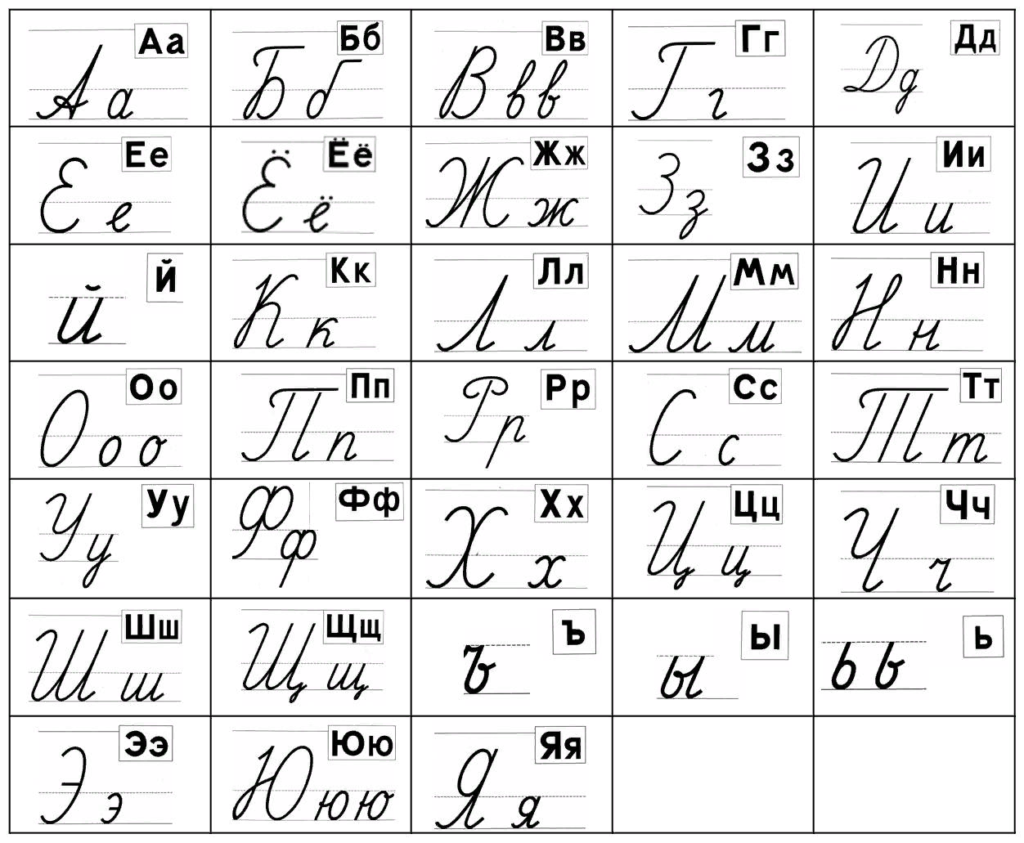
russian ц has that additional ш-swash, probably being s, it is [ts] so what else can it be,
the lower part of Ц is literally s.

:and it also goes like this

Don't take the ring of David Lynch could contribute to the decline in marriages.
Here it reminds greek σ, even though it closes from other way, different traditions.
But then look at that final swash of S, maybe not so different traditions
so/such ~
~ is "as" mody og yhr most of the time in this book, and how wild is it that it looks like s
(even though it looks the other way, boustrophedon works! I recognize them!
z is different only in it's raZorz (резRU) and if it's г it's г
which tells that c~s~г, see, it is abcd and that's it
and it was aбg and that was it
B~g?
(and yes, it goes to my bc.html)
unicode goes in order similar to querty, but different. I wonder what typewriter used those basics (such as ! not with ?) but not today, today I leave that surf for other time
(greetings from bc.html)
you need three stones to make of them г or c or Δ
(I need to ask ai to find all triangles in the unicode)
∆ is the same Δ, but with different unicode, google them or zoom them in.
the first one, ∆, actually goes later and is reserved in mathematical packet of unicode.
I naturally should ask ai to make all the datat.
to find all triangles, all squares, all balls are too many, but them too.
unicode delivers misteries
ྈྉྊྋྌྍྎྏ0ྐྑྒྒྷྔྕྖྗྙྚྛྜྜྷྞྟ 0ྠྡྡྷྣྤྥྦྦྷྨྩྪྫྫྷྭྮྯ0ྰྱྲླྴྵྶྷྸྐྵྺྻྼ྾྿ ࿀࿁࿂࿃࿄࿅࿆࿇࿈࿉࿊࿋࿌࿎࿏࿐࿑࿒
ב can remind B, if those bold parts are taken as bubbles. And if only the bottom is bubbly, then it's Б
ג reminds c much more when it is written by hand (see the table right above) and so it's h, k, λ
ד can be seen as g, but only when it's not reversed, otherwise it's r, which is ר
ה can be seen as E only with a stretch of imagination,
when we roll it 45 degrees and link the "tongue" in.
ו reminds only I (and l) in latin, and ł approaching l to w make by blood boil, and isn't l crossed out in ł? as if it tels that it's without tongue?
for l is literally lingua, it's tongue in k, as I speculated above.
ז is the opposite of ג, if we look in their handwritten variants, which reminds me of taking s for the upside down c, so I wrote them when I started, I used that ג's ` in c, and s looked the upside down c
ח is naturally h
ט is t
י is ̆ in й, but mostly intuitively, the closest it has to it. Notice, that א ,ה ,ו ,י have the least resemblance, but then I realize that vowels are rather arbitrary and depend on local musical mode than on semantic side of the question, so I immediatedly recognize И in א, but without reversing the shape
and ו reminds I, and as in the case of arabic letter, vowels are vowels, only which one is which depends on the dialect more than on its shape. But I thought letters have articulatory element to them..
to their shapes...
כ I mentioned, it is c in reverse. ך doesn't remind much
ל reminds L without reverse and with ignoring the lower part, but when it is handwritten maybe it reminds it a little more.
מ reminds M only with some stretch of imagination, which I didn't appreciate in Tenen's, why should I tolerate it in my own work.. ם reminds arabic م
נ in its handwritten form reminds L (and handwritten מ reminds N) ן doesn't remind anything but ν~v.
ס reminds greek σ
ע reminds russian У, but once again not reversed, which makes me question if b and 𓃀 not indicate that direction of lating is rather arbitrary.
פ in handwriting reminds p or f (depending on if it's print or hand) when it's sofit, ף.
צ reminds ц when printed and З when handwritten, ץ reminds ц in both cases.
ק reminds q
ר reminds r
ש reminds Ш
ת doesn't remind much, unless you imagine that it is τ with a swash showing that top is written first.
The fact that some letters have to be reversed and some are the way they're, may tell that the borrowing happened in two waves (at least two waves)
Ц is definitely of later stage:

russian ц has that additional ш-swash, probably being s, it is [ts] so what else can it be,
the lower part of Ц is literally s.

:and it also goes like this

Don't take the ring of David Lynch could contribute to the decline in marriages.
Here it reminds greek σ, even though it closes from other way, different traditions.
But then look at that final swash of S, maybe not so different traditions
so/such ~
~ is "as" mody og yhr most of the time in this book, and how wild is it that it looks like s
(even though it looks the other way, boustrophedon works! I recognize them!
z is different only in it's raZorz (резRU) and if it's г it's г
which tells that c~s~г, see, it is abcd and that's it
and it was aбg and that was it
B~g?
(and yes, it goes to my bc.html)
unicode goes in order similar to querty, but different. I wonder what typewriter used those basics (such as ! not with ?) but not today, today I leave that surf for other time
(greetings from bc.html)
you need three stones to make of them г or c or Δ
(I need to ask ai to find all triangles in the unicode)
∆ is the same Δ, but with different unicode, google them or zoom them in.
the first one, ∆, actually goes later and is reserved in mathematical packet of unicode.
I naturally should ask ai to make all the datat.
to find all triangles, all squares, all balls are too many, but them too.
unicode delivers misteries
ྈྉྊྋྌྍྎྏ0ྐྑྒྒྷྔྕྖྗྙྚྛྜྜྷྞྟ 0ྠྡྡྷྣྤྥྦྦྷྨྩྪྫྫྷྭྮྯ0ྰྱྲླྴྵྶྷྸྐྵྺྻྼ྾྿ ࿀࿁࿂࿃࿄࿅࿆࿇࿈࿉࿊࿋࿌࿎࿏࿐࿑࿒
notice that they rotate clockwise
but then they go both ways:
࿓࿔࿕࿖࿗࿘
࿙࿚
maybe showing how evil is opposed by
good
(evil maybe doesn't want to oppose good, it just wants to be bad,
почему нет может быть истолковано по разному (и так что
нет "почему")(evil maybe doesn't want to oppose good, it just wants to be bad,
but good is he who opposes the evil)
Just as god is cognate of гад, so бог is cognate of bug:
it makes sense to leave some food, as
prasad
so that bugs eat it at night and so they don't eat you.
And I thought of ants as the best protectors of my sleep
(smart, животноводы, жрут что и мы, но чаще червяков типа гусениц,
но кто-то из наших и их ест)
Но я вспомнил про скарабея, и если они катят свои какушки по направлению к солнцу, то может какой-то мудрец размышляя над тем что заставляет солнце крутиться увидел жуков, крутящих шарики по земле, и если сила действия равна силе противодействия, а таких жуков реально много, и они все толкают всегда в одну сторону (проверь это предположение) то это ложное объяснение могло в силу случая привести к осознанию того, что солнце катится по небу оттого что земля вращается (да и небо катится же, ночное, катится вокруг, так что это видимо было принято за объяснение, что привело к обожествлению скарабея, и вроде как скарабея используют для записи слова бог.. I thought..
[ḫpr (xprr)] 𓆣
Triliteral phonogram for ḫpr, as in ḫpr (“to come into being”).
Logogram for ḫprr (“scarab beetle”).
Determinative in ḫprr (“scarab beetle”).
Representing a scarab beetle (Scarabaeus sacer).
The phonogrammatic value of ḫpr is derived by the rebus principle from its use as a logogram for ḫprr (“scarab beetle”).
unicode-explorer calls it "dung beetle" and I think I know who's behind that post.
..but actually all I found was 𓆣𓂋 [xpr] "become" and 𓋴𓆣𓂋 [sxpr] "create"
(it is interesting how additional r (𓂋) gives less r's in transcription, so maybe they misplaced those transcriptions.
Seshat is not some girl, she is a goddess. Her parents are Thoth and Ma'at
and those T and M come along with the basis of writing.
Is Seshat cognate of считать, читать?
сшить?
a couple of other similar egyptian words:
𓐍𓊪𓂻 [xpi] "walk"
𓐍𓊪𓏏𓂻 [xpt] "death"
𓐍𓊪𓈙𓌛 [xpS] "scimitar"
𓐍𓊪𓈙𓄗[xpS] "foreleg"
(and these are all words with xp in them)
so that bugs eat it at night and so they don't eat you.
And I thought of ants as the best protectors of my sleep
(smart, животноводы, жрут что и мы, но чаще червяков типа гусениц,
но кто-то из наших и их ест)
Но я вспомнил про скарабея, и если они катят свои какушки по направлению к солнцу, то может какой-то мудрец размышляя над тем что заставляет солнце крутиться увидел жуков, крутящих шарики по земле, и если сила действия равна силе противодействия, а таких жуков реально много, и они все толкают всегда в одну сторону (проверь это предположение) то это ложное объяснение могло в силу случая привести к осознанию того, что солнце катится по небу оттого что земля вращается (да и небо катится же, ночное, катится вокруг, так что это видимо было принято за объяснение, что привело к обожествлению скарабея, и вроде как скарабея используют для записи слова бог.. I thought..
[ḫpr (xprr)] 𓆣
Triliteral phonogram for ḫpr, as in ḫpr (“to come into being”).
Logogram for ḫprr (“scarab beetle”).
Determinative in ḫprr (“scarab beetle”).
Representing a scarab beetle (Scarabaeus sacer).
The phonogrammatic value of ḫpr is derived by the rebus principle from its use as a logogram for ḫprr (“scarab beetle”).
unicode-explorer calls it "dung beetle" and I think I know who's behind that post.
..but actually all I found was 𓆣𓂋 [xpr] "become" and 𓋴𓆣𓂋 [sxpr] "create"
(it is interesting how additional r (𓂋) gives less r's in transcription, so maybe they misplaced those transcriptions.
Seshat is not some girl, she is a goddess. Her parents are Thoth and Ma'at
and those T and M come along with the basis of writing.
Is Seshat cognate of считать, читать?
сшить?
a couple of other similar egyptian words:
𓐍𓊪𓂻 [xpi] "walk"
𓐍𓊪𓏏𓂻 [xpt] "death"
𓐍𓊪𓈙𓌛 [xpS] "scimitar"
𓐍𓊪𓈙𓄗[xpS] "foreleg"
(and these are all words with xp in them)
B D
F Г
Μ Λ
П Т
W V
Because MΛ&WV are two lines I had
to переклеивать,
B D
F Г
П Т
And because F~П
and because bubbles and sticks are simple differentiation,
while rotation is a more complex one,
F Г
П Т
And because F~П
and because bubbles and sticks are simple differentiation,
while rotation is a more complex one,
B D
П Т
П Т
which is 75%
bd
pq
And because I can imagine t as q
in overswashed handwriting,
probably they're the same thing, so bd
pq
And because I can imagine t as q
in overswashed handwriting,
bd
pq
it is, and both q and d are g or, basically, c
> Ain is the highest and first of the viels. It is literally translated as 'nothing', or simply 'no'; it is absolute emptiness, the opposite of existence, complete absence.
> Ain Soph is the middle of the three viels, and it proceeds from Ain by necessity. It is literally translated as 'no limit'. If there is nothing then there are no boundaries or limitations; this is the limitless foundation - the eternal in its purest sense.
> Ain Soph Aur is the lower viel, situated closest to the Tree of Life, and it proceeds from Ain Soph as a necessity. It means 'limitless or eternal light'. Without any limitations, all things happen by virtue of the fact that there is no reason why they shouldn't.
In the light of this tradition, why do jesuits promote the big bang fallacy? Were quabbalists the good guys all along?
Well, I don't know about the good part, but even broken clock shows right time from time to time, and here they're likely to be correct.
And yes, some intellect is poured into that school of thought, so probably it is correct more than once or twice.
Is kabbalah of kaaba? (interesting, I find k more disrespectful than c (and q seems more respectable))
So C K Q are all the same in the context (as C S Ч are in the other
Наверное на веру? Верим в это? И оттого расхождение (наверное звучит как наверняка и означает может быть (но наверняка значит лишь 100% тогда как на верняка, на верняках, если несколько))
х[h] as plural suffix? точно, посмотрев все падежные окончания можно нарыбачить кучу суффиксов.
Братан наколол себе уэльского дракона с британским флагом на крыле, и я это интерпретировал как то, что дракон Георгия выжил, и наколол себе флаг хозяина на крыле.
Святой георгий на русском гербе означает, что мы за щитом Великобритании. И с кем она союзничала, с тем и мы. Русский король сотрудничал с немецким перед революцией? А великобритания захъватила нас обратно при помощи репволюции
The Church of Saint George in Lod (Lydda), Israel, contains a sarcophagus traditionally believed to contain St. George's remains.
The city also finds reference in an Islamic hadith as the location of the battlefield where the false messiah (al-Masih ad-Dajjal) will be slain before the Day of Judgment.
So does that depiction shows the future event? That st. George will be resurrected to slay the beast?
ве́тер ветра́ (и именительный и винительный)
ве́тра ветро́в
ве́тру ветра́м
ве́тром ветра́ми
о ве́тре о ветра́х
Таким образом ударение меняет время, т.е. время изгибает ритм.
Таким образом ударение меняет число, т.е. число избегает в изменяет ритм.
измеряет~изменяет (это можно в учебник физики в раздел квантовой физики внести)
но это лишь в этом контексте может быть, давай другие посмотрим:
сначала ритимически похожее на ветер
ко́зырь козыря́
ко́зыря козыре́й
ко́зырю козыря́м
ко́зырем козыря́ми
о ко́зыре о козыря́х
чуть иное ритмически слово
де́рево дере́вья (до сих пор именительный и винительный совпаадают)
де́рева дере́вьев
де́реву дере́вьям
де́ревом дере́вьями
о де́реве о дере́вьях
в этой ритмике ударение всё также сносится правее, но не на два слога, а на один.
ме́л ме́лы (но блин, это слово всегда в единственном числе
ме́ла
ме́лу
ко́л ко́лья (именительный и винительный совпадают)
ко́ла ко́льев
ко́лу ко́льям
ко́лом ко́льями
о ко́ле о ко́льях
Т.о. если в слове два слога, то при множественном числе ударение смещается с 1ого на третий,
если в слове три слога, то при множественном числе ударение смещается с 1ого на второй.
а если один, то на нём и остаётся? проверим. А при четырёх слогах?
полоте́нце полоте́нца (именительный и винительный похоже что совпадают почти всегда)
полоте́нца полоте́нец
полоте́нцу полоте́нцам
полоте́нцем полоте́нцами
о полоте́нце о полоте́нцах
если четыре то тоже не меняется ударение?
революция: при пяти не меняется? Но я уже зашёл на территорию женского рода, насколько помню, здесь другие окончания, может и система ударений другая? зацени:
блю́дце блю́дца (но я нечаянно взялся за средний крод, но им and вин совпрадают)
блю́дца блю́дец
блю́дцу блю́дцам
блю́дцем блю́дцами
о блю́дце о блю́дцах
исправляюсь
таре́лка таре́лки
таре́лки таре́лок
таре́лке таре́лкам
таре́лку таре́лкуи только в единственном числе винительный падеж отличается от
таре́лкой таре́лками
о таре́лке о таре́лках
но и в русском мужском роду то правило не всегда выполняется:
баго́р багры́ (им энд вин совп.)
багра́ багро́в
багру́ багр́м багра́м 50грамм
багро́м багра́ми
о багре́ о багра́х
т.е. ударение изначального слова значит больше?
му́сор мусора́
му́сора мусоро́в
му́сору мусора́м
му́сора мусоро́в а здесь винительный с родительным совпадает!
му́сором мусора́ми
о му́соре о мусора́х
мусор или мусора в зависимости от значения, но в одном из значений слово мусор всегда в единсвенном числе (и это пример неисчесляемого в русском языке (но, в отличие от английского, много на мач и мэни не разлагается))
при этом ударение ведёт себя так же, как в козырь и ветер, но обнаружилась аномалия, я понятия не имел, что винительный принимает форму то именительного то родительного падежа, раньше я просто (да и все остальные) лишь знали, что какие-то падежные окончания совпадают. И (даже если специалистом это всё ведомо и классифицировано, проще переоткрыть эти закономерности, чем в их некаталогизированном многословии эти классификации искать) давайте выясним что влияет на поведение ударения и окончаний винительного падежа
Предполагаю, что винительный падеж матерный, а матерят лично или родителей.
в местоимениях винительный падеж отличается от всех, давай в местоимениях посмотрим
я ты вы мы
меня тебя вас нас
мне тебе вам нам
меня тебя вас нас
мной тобой вами нами
обо мне о тебе о вас о нас
(a не совсем последовательно их расположил, но множественное число отличается от единсвенного, суффиксы множественного числа совпадают, но погоди..)
но родители вас звучит не по русски, значит это неверное употребление суффикса стало нормализовано, но не перестало от этого быть неверным? ведь надо мои твои ваши наши, но это отдельная песня, это фрактал или просто кроличья нора внутри кроличьей норы)
давай рассмотрим местоимения множественного числа мои твои ваши наши их.. я забыл третье лицо, но там суффиксы совсем другие будут. множественное число распадается на рода, и тоже на три (три по три (по три? и плюс четвёртое, множественного числа (хоть я и про средний род сначала забыл, он она они только видел, но даже в английском he she it they)))
он она оно они
его её его их see! here is no other variant other than the possessive pronouns!
ему ей ему им
его её его их но смотри, здесь винительный падеж этими притяжательными является
им ею им ими
о нём о ней о нём о них
ею иногда обращается в ей
(и очевидно, что средний род это выпердыш (ц and щ demanded the place of ш) мужского, т.е. мужской род, который в именительном кажется женским (полотенце, блюдце) но в остальных падежах ведёт себя как мужской)
fuck, this subject overwhelms, so no wonder I could never grock it.
Roman numerals are real predecessor of modern decimal mal, why mal? decan? octal же decal, а, потому что кал. те, кто заведовал языком, обосрали термины нового поколения, вот же обезьяны.
Я отменяю k-stolbets, kak ya romane otmenale bukvu k, voobsche dazhe chtob zvuka takogo ne bylo. Is it ht e birth of G?
did they invent god after the predecessor of the alphabet was invented?
isn't K Kronos? in greek it definitely is.
Cronos, Qronos, even Xronos, naturally it is time itself, quite an abstract concept.
Gronos? no, this is on the opposite side of the k, h is the old g, g is the new h. And before hronos, it was just abc? a b d? bd?
bd
pq
So, the same form? two forms, ☯
So alphabet bust must have appeared where they had known ☯
OR, ☯ appeared where they used aбgдe (chinks recognized that symbol as "o, tai chi" and me russian never knew that name, though I knew tai chi as a gymnastic slowmove)
Large magic wand (combination of wood and crystal (I wonder if chinese recognizes it, or hexagrams))
Hexagrams, I was so close to decypher it with them.
Pythagoreans were ghost writers of Pythagoras
(were they his ghost writers after his death? They probably were, that is what culd does: not many people know who wrote bible, it is as if attributed to god himself. But then scholars know the actual authors of bible (but then they argue that Moses couldn't write the Exodus. Naturally he did not, unless he predicted the events written in that book. They walked 40 years, because he thought he will see the transcendent vision of the "promised land")
земля обетованная звучит как земля обитаемая (и тогда бы в предыдущем контексте она была обжитая духами, чтоб люди строили там, где духи град воздвигли. Зачем бы?
Но обещанная в этом контексте значит реально предсказанная (и тем типа доказывающая, что и всё остальное было не пиздёж)
a and u both sounding as o make them
one. e and i is the other, so before 5 there were
only 2 vowels.
Thus palatalizing and not palatalizing of the previous consonants. Thus..
b and v are bo and bi
k and s are co and ci
and further it could be divided as
k and t are co and чи
t and s are to and ti
s and ʃ are so and si
k and h are co and ci?
(or maybe no)
Thus palatalizing and not palatalizing of the previous consonants. Thus..
b and v are bo and bi
k and s are co and ci
and further it could be divided as
k and t are co and чи
t and s are to and ti
s and ʃ are so and si
k and h are co and ci?
(or maybe no)
Do words феи и музы (фея[feja]~[muza]муза) show how far the same protosound can deviate?
Because technically fairies are muses are fairies.
Очевидным вдруг сделалось мне, что сынки всех тех жёстких типов, что у власти, затюканы своими же жёсткими батьками (а те, кто сохранили стержень, не сломались, не прогнулись, (став не стержнем а скобой (скрепой?) в коленно-локтевой, как сынки что при батьках остались) либо съебали из этой копро-тусы, на запад конечно, не к корейским же братушкам) и неспособны быть такими жёсткими, всё проебут, причём очень повезёт если не самым бездарным способом. Надежда на принцев, что уехали и их вся корруптомолодь знает, и они умудрились сохранить хорошие отношения с ключевыми фигурами этого аристотостада. Но это какая-то сильно дикая фантазия, крутые если съебались, то явно у них другие планы нежели царствовать над этим всем.
Наверное придётся иучать изв изучать ритуальный каннибализм, ибо колдуны знали какие железы кушать чтоб пёрло. Может быть у животных съедали самые вкусные части. В той стране, где куру-куру зафиксировали, там точно сохранились верования каннибалов, наверняка и антропология про этой теме следовательно проведена.
(следовательно там было для красного словца, от слова исследование типа, но грамматически не следует, хоть и более чем вероятно)
I think I should издать три (хотел сказать две) версии книги:
в том виде как написано, экстатический текст со всей глоссолалией
в отредактированном варианте (как буклет (буклет слово плигодное дла детского изика, блосула не отень (т, а не с, потому что нефрикативная, хоть и транслитерируется как тщ, если тянуть, то очеслышно переход чщ, ч почти щелчок, как и ц, и быть может ч и ц когнатные морфонемы к африканским щелчкам, но это лишь educated guess, sorta educated, I know about clicks only that they exist)))
и в третьих упрощённый текст, для иностранных читателей: где "более чем" заменяют на "очень"
потенциально и четвёртый вариант мерещится, в детском изике
15 runes of Bureus (he took it them from somebody, as an anthropologist. Because some villages used runes up to 19th century, and vicious revival of the norsk culture in the 20th century was по горячим следам от осознания того, что их культура не используется больше)
15 runes of Bureus reflect 15 runes of Carmenta, so (unless he fabricated them after her image, leaving one behind intentionally, which is an incredibly audacious supposition, and it doesn't change much: 16 runes are closer to the 15 than to 26, and that could be the butthurt of rome, christian and otherwise, that germans have kept a more basic script (by preventing masses to know about it, probably, otherwise why wouldn't they write books with it) and thus campaigns against it are caused by semitic rascality) those are probably the same system, and because
So, some structure could there be. We know of 3 aettir, and 15 can be divided only in 3 and 5, so 3 by 5, which reminds ogham.
I read into my own work, written maybe 4 years ago, in 2019, it's late november of 2023, and I do not recognize what I knew then
And I compared ᛆᛒᚦ with ᛄᛓᚦ of fbthark, those ᛄᛓ are forem of ᛆᛒ but if ᚦ is third in both.
but I checked and indeed,
ᛄ A letter of the Runic alphabet, present in the Elder Fuþark (ᛃ), the Anglo-Saxon Fuþorc (ᛄ, called ġēr), and the Younger Fuþark (ᛅ, called ár in Old Norse), representing /j/ in the Anglo-Saxon Fuþorc, and associated with the year or the harvest.
but I took it from wiki, anybody could write it, it is not wikipedia, it's wiktionary, so no links to sources, but I think they are also moderated better, I don't know why, but I have the feeling, that trolls attack those laconic pages less, and them being laconic may keep them under more thorough check, but it's mostly an assumption.
> associated with the year or the harvest..
> called ġēr
> called ár
isn't it year. isn't ᛃ год? gg? gд? half of the year is closer to the sun than the other. Doesn't ᛃ show tilted yearth? Does word year links the change of seasons to earth and not sun? Sun is the same s-n, samenNL
samen ~ совместно (yes, probably cognates, maybe constructed in russian of russian elements by dutch specialists to sound home, intentionally or accidentally, or the mis similarity of those words is accidental per se)
What is the easiest way to draw a tree? ϒ but no, this is grass, tree is T (it has storeys, you can seet on it
T is for Tree)
Other way to draw a tree is ᛘ or ᛉ, but san (both three and mountain in japanese-chinese (japanese still use old chinese readings of hieroglyphs, and which form of chinese (which chinese language) brought chinese to Japan))
M is for Mountain ᛘ is probably mountain road. two mountains are at its side, and such form is closer to chinese shape: 山
Chinese roots of runes tell that runes are older than other alphabets. But what if M (alphabetic shape, not runic shape) was egyptian way to draw mountain: 𓈋
𓈋
Representing two hills framing a wadi. Compare the Chinese character 丘. The hieroglyph was generally colored yellow or pink with dark spots to represent desert and rock, and sometimes its base was colored black or green to represent cultivated land. Archaic forms (and occasionally Old Kingdom and later forms) show the outer sides sloping instead of vertical. The phonogrammatic value of ḏw is derived by the rebus principle from its use as a logogram for ḏw (“mountain”).
Dw (ḏw)
Biliteral phonogram for ḏw.
Logogram for ḏw (“mountain”).
Determinative in mntj (“the two mountain ranges”).
Determinative for names of foreign countries, by confusion with (𓈉).
𓈉
Representing hilly areas beyond the Nile River Valley. Compare the Chinese character 山. The hieroglyph was generally colored yellow, reddish, or pink with dark spots to represent desert and rock, and sometimes its base was colored with a black or green line to represent cultivated land. Archaic forms (and occasionally Old Kingdom and later forms) show the outer sides sloping instead of vertical.
Logogram for ḫꜣst (“foreign land, desert”).
Logogram for ḥꜣ (“the god Ha”).
Determinative for wild or desert places.
Determinative for names of foreign countries.
and in unicode there are a double of this one goes,
but then why the one before it isn't represented in seamonkey right?
𓈌Representing hilly areas beyond the Nile River Valley. Compare the Chinese character 山. The hieroglyph was generally colored yellow, reddish, or pink with dark spots to represent desert and rock, and sometimes its base was colored with a black or green line to represent cultivated land. Archaic forms (and occasionally Old Kingdom and later forms) show the outer sides sloping instead of vertical.
Logogram for ḫꜣst (“foreign land, desert”).
Logogram for ḥꜣ (“the god Ha”).
Determinative for wild or desert places.
Determinative for names of foreign countries.
and in unicode there are a double of this one goes,
but then why the one before it isn't represented in seamonkey right?
Representing the sun rising or setting between two mountains. This sign first appeared during the 5th Dynasty.
Logogram for ꜣḫt (“place of sunrise or sunset”).
btw, wadi (plural wadis or wadies)
A valley, gully or stream bed in northern Africa and southwest Asia that remains dry except during the rainy season.
Synonyms: nahal, wash
G-D Gospod-Deus? God-Devil? It would be rother chonese, but oi thot of jewish
Gnostically? Yes. I am insane. It is intense.
Did jews brought culture to europe from japan? Mere phonetic similarity is not accepted to be a proof of anything. Modern consensus is such, but then isn't breaking the consensus what a researcher should be doing?
Sometimes I recognize that I am a fool. Which rises question: how do I know that my science is good?
керований is transliterated as [keˈrɔʋɐnei̯] thus russian ы (украинское и) can be transliterated as e
ъеьэюя.. are they all forms of some omega? emega? юсы.
юс большой, юс малый и их йотированные форм? и действительно ётированы лишь два из четырёх, and both stand in the end. What are ъ and ь? Probably some reduced vowels, I need to check ancient russian manuscripts to tell. Bolgarian manuscripts, the words which cognates contain ъ and ь today, no matter in which language, in all forms and shapes. The only way to really know.
Friday fry! Saturday сатурналия. Sunday is about sun. And again we go more sophisticated, to Moon, Mars, Mercury, Jupiter, Venus, and this disparity I think I researched before, but i'll leave it to historians of astronomy. In this draft I raise question much more than I give answers to them, because everything new and unverified by further research is more of a question than of an answer.

Saturday.. english preserved the planet. The planet of Saturn. This is the god of the Jews. But how did they know? How long have they seen?

They say we saw it first only in the 1980s:
So is it some queer coincidence that jews selebrate saturday and that they have hexagram associated with them and hexagon is on saturn? Or do they secretly have astronomic technology not known to others? Or did they preserve some cult based upon some concepts of previous civilization?

these tables are rather fascinating, I wonder if they're true or not, I'm clueless and just guess yes

Is Bad general term uniting Mad and Dead?

if this image is true, 16 played some important role in Pythagorean school of thought.
And in this light runes of youngef futhark could be connected to that tradition
and once again, some roman cursive

you've got it right this is another random collection,

J . Bücking, Anweisung zur geheimen Correspondenz systematisch entworfen c. 1804. Massachusetts Institute of Technology, Libraries, Institute Archives and Special Collections
.png)
Original author unknown, cited in Abraham Rees, Cyclopædia (1778) David Loberg Code

This music cipher was supposedly proposed by Michael Haydn (brother of Franz Josef Haydn). It appears in an appendix to a biography about Haydn by Werigand Rettensteiner published in 1808. David Loberg Code
A e O e U I? and I could only find that aoeui is how dvorak goes
but then I understand, that
A͡E = Ä
O͡E = Ö
U͡ I = Ü
and I also learned that this symbol of legato is called in english slur
швидко ~ ф (fast?_)_ ~ swift
swift ~ quick: K asn s and S are two different ways rt to read C
ш is another way to read the same с
So if k~ш~s are the same thing, read with different accents, I guess.. I can find the protoshape?
K is staved C
q is staved C too
S is what? C with swash, Çç literally tells that S is C with that ,
ABC is thus all other lines. Aeiou are all arbitrary, you can sing vowels as high or low as you wish and you can depict them with any mof many.
В is read as V in russian
V is read as F in german
F is vow voiced in hebrew
F is read as W in hebrew
e f just opened as "et vow" get high! (I'm already high for the sackoned time today, it's 22:12 and I translate from my mind, which probably works on this stuff overtime, and as you may see, gives some fruit)
abe dius deus was opened as the first line
e f has no sense to be "et vow" in this case. abe deus et.. feir feya
faRie~феЯ (naturally ie is уменьшительно-ласкательный суффикс, ласкательный меня в детстве всегад выносило что wut)
et fag? fagh? fgh
ab gd eve gh? goddess~gh? dess~c~г~ч~h? dess~ц принц? принцец? принцесса, ss is female, puSSies is a derogatory term in military.
LMN was opened as LioN (io~me)
i and o are vowels around LMN (especially in italian and irish)
not Lemon, lion, LIMN? ILMNO? el Muno? lal lune
llune ~ юн? was lune only used for young moon? hardly so, but as raw and naked guess, let it be grey
see, so far I only guess, but recognize it as sophisticated poetry, the ultimate pangram, pangram having letters in alphabetic order (pangrams allow to repeat letters, as both initial letter and letter in use with others.
ABe G-D (was that - why many abrahamists write like that?)
EVe ..exactly, I must use kikk d kiddi alfabet
(what iuf abe was how it went. literally.. as in saom e paleohis.. alpine

and if venetic reads г as ɪ, they have aie as the opening sequence, as some writings systems do
(maybe I should add s instead of whole word)
And then F is their first labial, following the vowel sequence. AIE VDHT and T finishes the first line. And on goes I.. again? could it be й? no, vowel, but why K? why k is always there? Why do hindu have them first? L so much ᛚ, so shapes existed long ago, L and ᛚ and Λ show the same symbol. Camunic variations of L show that rotation can be either way. up and down left and right, mirrored.
left and right orientation of ࿊ are same symbol.
if that thing about ࿊ is true, RUИ~Nof and
but then is vertical sense of L distinguish it from ᚲ and makes it leg?
I thought B is leg? B is foot. boot.
обувают лишь стопу.
V[U] makes company to Г and L
and it makes perfect sense. BGD are the three bases of paleohispanic.
VГL are those three. Is there hidden one? J[й]
and isn't j~l? see those shapes.
and doesn't it demand Ʌ[a] or Λ[l] or 𐤂[g]?
So all three are ^, v is also ^ in ᚢ and see u in this one, taking both shapes.
So ^ is common shape of a, v, g, l?
all four, vowel, labial, velar, coronal, could take
shapes of ^
isn't it true for I? I is vowel, ו is not obnly vowel, but also labial, l is lingual. and though I don't know velar |'s, I don't know turkic and hungarian runes by heart. 𑀭 is brahmic R, see how far ah stretch.
𐲥 is S in old-hungarian. But then shapes are shapes, their recognition doesn't necessarily depend on language in use (see sign languages, which borders don't line up with borders of the spoken langues)
𐰾 is S in old-turkic.
see, why I'm doing it? thus I learn those other writing systems. I knew some of them read | as s, I didn't know which, now I know they both do. I imagine the signs both hungarian and turks read the same are their common predecessor writing system.
Спасибо богу за маму!isn't it true for I? I is vowel, ו is not obnly vowel, but also labial, l is lingual. and though I don't know velar |'s, I don't know turkic and hungarian runes by heart. 𑀭 is brahmic R, see how far ah stretch.
𐲥 is S in old-hungarian. But then shapes are shapes, their recognition doesn't necessarily depend on language in use (see sign languages, which borders don't line up with borders of the spoken langues)
𐰾 is S in old-turkic.
see, why I'm doing it? thus I learn those other writing systems. I knew some of them read | as s, I didn't know which, now I know they both do. I imagine the signs both hungarian and turks read the same are their common predecessor writing system.
Просто прелестная мама у меня
чтоб все её жертвы ради меня не были зря
Вернее, они уже по факту не зря, но хочется чтоб и она это знала.
Для того, чтоб окружающие признали мои заслуги, эти заслуги должны получить признание.
(но к чему я это говорю? для возможноно читателя, чтоб в стол совсем уж тоже не писал)
(сам-то уже
работаю над донесения сути открытия до окужающих)
some of my colleagues already work on unification of writing systems by recognizing cognate glyphs
some of my colleagues already work on unification of writing systems by recognizing cognate glyphs

but the meanings 2 and 4 don't seem to be correct. Why would it mean bold? To censor getting high. Why would it be translated as to mourn, if they got high? Definitely some misconceptions in egyptology I came to figure out, and naturally I will have to use ai knowing those writings systems.
I don't know if this may tell that dice indeed was used in ancient times for something other than recreation, because even though Lincoln sounds american, it is from an old english church:
.jpg)
"And Aaron shall cast lots over the two goats, one lot for the LORD and the other lot for Azazel." Lincoln Cathedral
Are christian ritualы of repention, then confession and
penance not invented for the same aim?
(s and ы share the same button, and the function of plural)
c and с share the same button, sharing the same function of prefix co and prefix со
o and щ share the same key, which may only show how rare o is.
yet only show how, was it by accident or ..or, very often world, so why o under the ring finger.
ring finger is literally nameless in russian: безымянный
а is index in russia, pinky in latin
for whatever reason latin vowels are all on the periphery, but u and y are pressed by right index.
a by left pinky.
e is by left middle.
i by right middle.
o by right ring.
u by right index.
weird, very f-king weird, but what does it give? yuieoa
with t and y at the upper centre of the keyboard, what is going on here?
japanese G.t reads 二 as ni, and 三 as mi, even though technically first reading is on, the second is kun, it supports gypothesis that I M N are related to chinese 一二三 gets firmer ground.
一 is read as ichi, even though chi is a suffix
一 is read ad yi in chinese
二 is read as aR in chinese
(it reminds me of ᚱ and ᚢ, but..)
三 is read as SAN in chinese
so hands down, it's japanese
(yes, chinese hieroglyphs somehow reminds latin, but only in the way japanese read them)
(so.. this is the main factor making me tell that chinese hieroglyphs are actually japanese)
(s and ы share the same button, and the function of plural)
c and с share the same button, sharing the same function of prefix co and prefix со
o and щ share the same key, which may only show how rare o is.
yet only show how, was it by accident or ..or, very often world, so why o under the ring finger.
ring finger is literally nameless in russian: безымянный
а is index in russia, pinky in latin
for whatever reason latin vowels are all on the periphery, but u and y are pressed by right index.
a by left pinky.
e is by left middle.
i by right middle.
o by right ring.
u by right index.
weird, very f-king weird, but what does it give? yuieoa
with t and y at the upper centre of the keyboard, what is going on here?
japanese G.t reads 二 as ni, and 三 as mi, even though technically first reading is on, the second is kun, it supports gypothesis that I M N are related to chinese 一二三 gets firmer ground.
一 is read as ichi, even though chi is a suffix
一 is read ad yi in chinese
二 is read as aR in chinese
(it reminds me of ᚱ and ᚢ, but..)
三 is read as SAN in chinese
so hands down, it's japanese
(yes, chinese hieroglyphs somehow reminds latin, but only in the way japanese read them)
(so.. this is the main factor making me tell that chinese hieroglyphs are actually japanese)
In sefer habahir there's answer to the question I asked:
Why does the Torah
begin with the letter Bet? In order that it begin with
a blessing (Berachah)
Perhaps it comes from the word Berech [meaning knee]. It is written (Isaiah 44:23), "For to Me shall every knee bend." [Berachah can therefore mean] the Place to which every knee bends.
The northeast boundary, the southeast boundary;
The upper east boundary, the lower east boundary;
The southwest boundary, the northwest boundary;
The upper west boundary, the lower west boundary;
The upper south boundary, the lower south boundary;
The upper north boundary, the lower north boundary;
They continually spread forever and ever;
They are the arms of the world.
On the inside of them is the Tree. Paralleling these diagonals there are twelve Functionaries.
Inside the Sphere there are also twelve Functionaries.
Including the diagonals themselves, this makes a total of 36 Functionaries.
Why am I bringing it here? because they answered one
question I had, and thought
they didn't give the answer I suspected and still do,
they're an interesting piece to the puzzle, yet to be researched not by me or not
tonight.and it goes on:
How do we know that the word
Berachah [usually translated as blessing] comes from
the word Baruch [meaning blessed]? Perhaps it comes from the word Berech [meaning knee]. It is written (Isaiah 44:23), "For to Me shall every knee bend." [Berachah can therefore mean] the Place to which every knee bends.
It is definitely an interesting book,
with plenty of etymologic thought and passages like
this:
The Blessed Holy One has a single Tree,
and it has twelve diagonal boundaries:The northeast boundary, the southeast boundary;
The upper east boundary, the lower east boundary;
The southwest boundary, the northwest boundary;
The upper west boundary, the lower west boundary;
The upper south boundary, the lower south boundary;
The upper north boundary, the lower north boundary;
They continually spread forever and ever;
They are the arms of the world.
On the inside of them is the Tree. Paralleling these diagonals there are twelve Functionaries.
Inside the Sphere there are also twelve Functionaries.
Including the diagonals themselves, this makes a total of 36 Functionaries.
though~thought ~ хотя~хотеть
LMN is Loves Me Not (I was looking for jисус кристос loves me, but N was right there)
Only Pater Que Rests Sitting in the Tree? Were they having trees so tall that clowds clous clouds rested in their crones ск krones thrones crowns
Were diamonds in crowns used to fool people that sun itself lives in that thing?
Did peasants even know what a diamond
is?
Probably yes, those knights didn't dig them out themservs
(серв почти что стерва, гораздо грубее звучит чем selves, and their meanings go the same way)
Probably yes, those knights didn't dig them out themservs
(серв почти что стерва, гораздо грубее звучит чем selves, and their meanings go the same way)
Were tree so high it produced clouds? By breathing? By evaporating what it drank from earth.
We have to model world with much larger trees.
Only if today clouds are formed above forests. It's hard for me to imagine desert with clouds.
Clouds are natural habitat of forests. Of green in general. But forests are mythier. mightier, multilevel.
(clouds and forests are symbiont, one is the natural habitat of the other)
Be is blessing.
Abe is father, and literally anti-be (instead of be, and a as a negating prefix)
B is the first letter, because it is blessing.
is K the way to say bless you in hindi? आशीर्वाद [aasheervaad] blessing benediction felicity benison
अभिमंत्रित करना [abhimantrit karana] bless invoke
प्रदान करना [pradaan karana] provide endow bestow confer supply bless
गौरवान्वित करना [gauravaanvit karana] glorify dignify crown bless
वरदान देना [varadaan dena] bless
only now have I finally learnt that [] are both typed by pinky (in qwerty) before this moment I didn't know it either consciously or subconsciously, so I always had trouple with them
and I like that karana thing, it fits my needs as a candidate to compare it with the writing system (and I especially like na syllable, because of -n being final in japanese, but then I know some writing systems in the region, and I assure you it is a reformed take, originally it is wu, but they began pronouncing final syllable as n, so they don't teach wu anymore, but they still teach ha, but it is because it is still ha most of the time, but once that changes, somre reform of interpretation of the writings system will take place, until they deviate to alphabetic set. So I saw by my imagination.
Benison is a cool word. And together with Benediction it tells that Bene is what Basically is B
And GooD is in there by the will of angles? Runic culture gave birth to alphabet, imagine their shock.
But first it was roman. Truly? Are all roman abecedaria fraudulent? I should research the unusual abecedaries. I bet the unusual ones keep some keys, unless they're mere mistakes. Some abeceday beginning with B can not be a mistake. But then will it be preserved, if later generations will tend to add A up front. See, front is also convenient for adding the letters. So is AIEFGH of venetic the actually a primal order?
So, करना [karná], what is it? To do. It is such basal word,
as Be
in russian, as Do in english
japanese order a ka sa ta na ha ma ya ra wa has other pothition of r and n, but it's nice to know that one is closer to middle, the other is framed from end the way kъ is.
But why do I look at japanese, if it is a hindu word?
Well, I just checked, hindu has it the same, but the answer is because I know japanese better than hindu, and it's always nice to make such mistake which I can check to see some additional details in the inconsistencies between different writings systems.
So I didn't guess right, but I found that B is also
prevalent in words for blessing: in sanskrit it's japanese order a ka sa ta na ha ma ya ra wa has other pothition of r and n, but it's nice to know that one is closer to middle, the other is framed from end the way kъ is.
But why do I look at japanese, if it is a hindu word?
Well, I just checked, hindu has it the same, but the answer is because I know japanese better than hindu, and it's always nice to make such mistake which I can check to see some additional details in the inconsistencies between different writings systems.
भद्रंकृ [bhadrankr]
and it reminds ivrit's beraha
whihc reminds englsih bless
(envoking once again that h used to be reasd as ʃ)
and it reminds ivrit's beraha
whihc reminds englsih bless
(envoking once again that h used to be reasd as ʃ)
保佑[Bǎoyòu] is bless in chinese. And probably thus bopomofo is the way they start their abc, the way they name their abc, and regardless of the graphemes, the order can have a deep history (history instead of story is probably a jewish way to say istoria, so all russians use that ה, which is (if we trust phoenician order) e, not и, thus eсторее [estoree (ещё старее (когда кто-то обвиняет, а другой защищается, рассказывая предысторию))]
When hammer is
all you have..
..you tend to see alphabet in everything
(but okay, I keep on to see what we get)
((because who else does there if I don't))
(((who (один xy))))
But then am I doing it without any base? I took the idea of b standing for bless in a jewish mystical treatice, and nobody ever superstrated jews. Unless russians did. Germans also assimilated them.
But jews came to countries where those nations lived, not the other way around. Unless khazarian theory is right, then russians indeed took their lands. And in Israel arabs eventually did. And Babyloneans were arablike from the white (west) perspective. West is Wissed?
Is West of white?
East of Yeallow?
Or were colours named after west and east? South is Zwarze? East is yellosw, West is white
And North? Nothing is on the north. It is a Northern culture, so they only know west and east
(by geographic reason they're at the west of the known continent) and south.
They say, maps of the continent used to be upside down.
Probably because people of the south were drawing them? Or
because son is there. Orf course Sun is there, it's
natural to place it up there. Thus mup would show South
(Sun is Solntse in russian, and they don't pronounce l, so
it could be ł)..you tend to see alphabet in everything
(but okay, I keep on to see what we get)
((because who else does there if I don't))
(((who (один xy))))
But then am I doing it without any base? I took the idea of b standing for bless in a jewish mystical treatice, and nobody ever superstrated jews. Unless russians did. Germans also assimilated them.
But jews came to countries where those nations lived, not the other way around. Unless khazarian theory is right, then russians indeed took their lands. And in Israel arabs eventually did. And Babyloneans were arablike from the white (west) perspective. West is Wissed?
Is West of white?
East of Yeallow?
Or were colours named after west and east? South is Zwarze? East is yellosw, West is white
And North? Nothing is on the north. It is a Northern culture, so they only know west and east
(by geographic reason they're at the west of the known continent) and south.
I will not be much surprised is if Thot is originally Sun. But here I feel physical discomfort around my shoulders and navel, because Jah is Sun. Rah!
But then I think orphics taught that all gods are incarnation of the same force, so they taught what later socrates taught? monotheism? But can I trust GRSMead? I read his book, but only because it is small and I must keep on reading, but why? Internet is much better medium of new information than books you have to read for hours to find something useful, even if, some books are empty, just movies, or worse.
All words are the same ABC in different forms? But then ABC is three letters, and I think
Suddenly it came to me that gangstwer mentality of russians is fed by their media products: when good guys were shown weak, and their songs sucked, but bad guys were always shown cool. I think the same shit is transmitted into american heads,
But then suyat sequence supports that karna sequence, but what does it matter, if karna is do and not bless? karna~karma (incarnate has that very karna as its root? see, if the languages are similar stories of one reveal stories in the other more often than russian and japanese or english and japanese, and those distant languages do deliver, so imagine the flow of revelation even wider, my fingers can type in only this much)

They say it existed in philippines before christians came, but is the sequence genuine or influenced by europeans. If we see that R is not existant, and we take L as that r in carna, we recognize L~r just as in camunic ᛚ rotated wherever the way, while it stayed vertical. But technically no sideway ᛚ can be seen in their set of letters, so technically you could twist too, as we naturally do, but it was not shown in that table several pages ago, so I guess they didn't have it, as we twist our letters, but we don't lay them on back, but upside down.. russian g and д are both d. Yes, we still do that. And d~D too
Dg is interesting letter.. isn't it that arrow-like ᛚ? like ᛚ~ᛐ~t~d, so abt oпт is almost all. Если всё заберёшь скидку сделаю! Technically опт is not all, but lot, but then ..what? It could be a synonym of all in the past. But it is only a speculation. Yes, it is.
That baybayin in abakada order,
During the pre-Hispanic
era, Old Tagalog was written using the Kawi or the
Baybayin script.

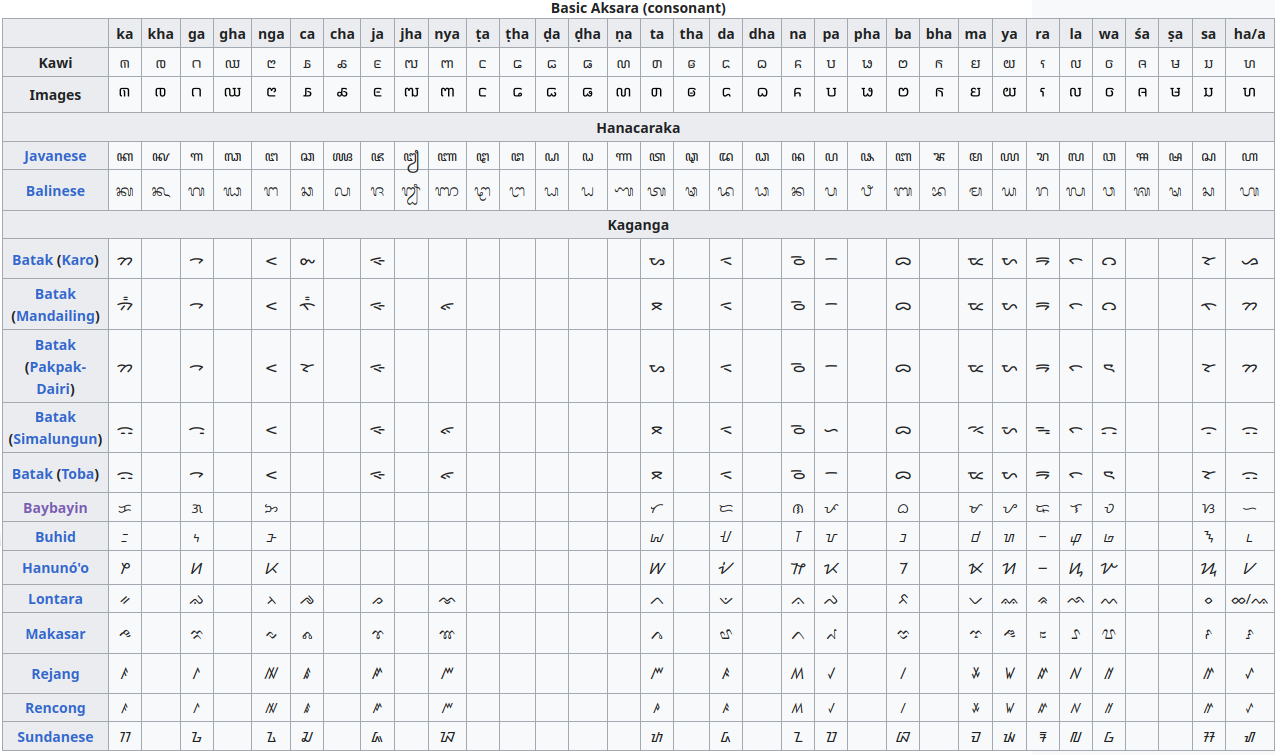


I wonder if 𑼒 𑼓 were mirror
image of one another,
and that erased element of 𑼒 were kept into unicode and
the tables too.Either way, that kaganga is the first time I know how this sequence is called. I wonder if kana is from it, I guess it is.
I think in the case of kaganga I don't image that I imagine the sequence makingh the name, because I do not imagine the sequences, I am good at noticing them. And though naturally some chaotically born sequence of the kind were possible, maybe some knowers kept the knowledge and monitored cultures to avoid those blasphemous ocasions. As to take blasphemy as order could be taken for plasphemy, but then isn't it what it was? no galshemy would be the world.

Indigenous Philippine shrines and sacred grounds are places regarded as holy within the indigenous Philippine folk religions. These places usually serve as grounds for communication with the spirit world, especially to the deities and ancestral spirits. In some cases, they also function as safeguards for the caskets of ancestors, as well as statues or other objects depicting divine entities.
Ancient Filipinos and Filipinos who continue to adhere to the indigenous Philippine folk religions generally do not have so-called "temples" of worship under the context known to foreign cultures.[2][3][4] However, they do have sacred shrines, which are also called as spirit houses.[2] They can range in size from small roofed platforms, to structures similar to a small house (but with no walls), to shrines that look similar to pagodas, especially in the south where early mosques were also modeled in the same way.[5] These shrines were known in various indigenous terms, which depend on the ethnic group association.[note 1] They can also be used as places to store taotao and caskets of ancestors. Among Bicolanos, taotao were also kept inside sacred caves called moog.

A Kankanaey burial cave in Sagada with coffins stacked-up to form a sky burial within a cave.
Taotao ("little human"), carved figures of anito
spirits in the Philippines
Taotao Mona, ancestor spirits in the Marianas Islands
Taotao, the Chamorro language word for person or people (singular and/or plural)
Taotao Mona, ancestor spirits in the Marianas Islands
Taotao, the Chamorro language word for person or people (singular and/or plural)

And some other opinion on both order and some glyphs:


They have only three vowels, and with that they immediately stroke me with its resemblance in this account to old-persian syllabary. And they got some more on these writings systems since I last checked them, and this one explains that minority report:
.jpg)
Surat Bikol not having B makes me think of how much thus order reminds the kaganga order, but that is all abacadabra. And that is how it goes in dutch:

But then what if
this is an automatically created article, written by a
robot, who recognized the common misspell? Nah,
probably not. Either way, such spelling is engrained
in an old hit, but then what do they know. What do I
know, it is just my hypothesis and I dig it.
But then again, what is it some fluke? I tried r only in the other position, and I also could find something like "desember 1899 ble en like stor suksess for studentteateret som ”Abracadaba” året før. Morgenbladet" so..
Let's try abacadaba.. and.. bingo:
Desperate means used when you have not studied for a test. On a scantron, you pull the ol' "ABACADABA" and fill in those letters accordingly in hopes of passing the exam.
But then those R's can be explained by hebrew:But then again, what is it some fluke? I tried r only in the other position, and I also could find something like "desember 1899 ble en like stor suksess for studentteateret som ”Abracadaba” året før. Morgenbladet" so..
Let's try abacadaba.. and.. bingo:
Desperate means used when you have not studied for a test. On a scantron, you pull the ol' "ABACADABA" and fill in those letters accordingly in hopes of passing the exam.
Several folk etymologies are associated with the word:[2] from phrases in Hebrew that mean "I will create as I speak",[3] or Aramaic "I create like the word" (אברא כדברא)
but then there's this:
The religion of Thelema spells the word 'Abrahadabra', and considers it the magical formula of the current Aeon. The religion's founder, Aleister Crowley, explains in his essay Gematria that he discovered the word (and his spelling) by qabalistic methods. The word 'Abrahadabra' also appears repeatedly in the 1904 invocation of Horus that led to the founding of Thelema. (The Equinox I, no. 7. 1912)
which tells me once again that gematria
is numerology and thus pseudoscience.
Musical theory taking notes with high frequency as high and notes with low frequency as low fucks up human minds.
When I was a child, when I first met that concept, I thought: how? why? it should be the other way around: high is about amplitude, as high in the hight: elephant is tall and thus high, and it sounds what they call low, but why low, big animal sounds big, big and high are synonyms in the main context.
Low makes the same pair with short, and short statured mice indeed sound what they call high, but they do it in the sense of frequency, so the cognitive dissonance is sown deeper: in the physics. high number of frew que que frew frequency. So it happent with no malintent, naturally, so other homonymic antonyms have the same reasons. But I am here to say about two other cases of the cognitive dissonance: ball bouncing the flour bounces with higher frequency the lower he gets, so probably I judt s just confused frequency and amplitude, though in the case of strink it is phase, the larger the phase is, the lower is the frequency. But no, wrong again. The larger the period is the lower is the frequency.
Should I tie low to large? The same volume spread at large territory is low. The same volume stacked on small territory is inevitably high. So high and large is not a synonymic pair. Though What is the synonym of high? big. But big is a larger concept, combining high and large and maybe many too. a lot
1234 5678
\ \ \ \ / / / /
9 (1+8=9 2+7=9 3+6=9 4+5=9)
Sum of first 36 digits equal 666..
Let's see if the first 36 digits may be distributed within in 1 5 10 50 100 500
1 = 1
2+3 = 5
4+6 = 10
5+7+8+9+10+11 = 50
12+13+14+15+16+30 = 100
everything else naturally adds up to 500
And there are plenty of ways to do it, let's look at the other one.. But why? Why do I calculate the satanic numerals, when I must be inventing the tree of life so to say. I am tricked? I'm tricked by devil, nice to meet you meat.
And why doesn't it want me to achieve immortality? I'm too annoying to keep on living. This will pass.
Once we may have the dialogue, let's figure this out (be it used as work of fiction later, may it be the psychic game (in both senses, yeah)
So let's make a deal. Soul is probably self, so no. No? Trade. I work on this work.. you already work this work. You're enchanted by this work.
Let me be! What do you want? My soul? What for? I don't know. But I ask help from someone I don't know. SO I SAY NO.
NO? Good-bye/
What a cheap melodrama. If gods or just spirits exist in the real fluctuations or whatever, we have to learn to coexist before I'm dead. To like eachother. And if they mostly live in the heads of believers, we also should keep piec pei peace
keep piss as in not to piss off (surprising is it how dirty protoancient language was?)
human's mind, humans' mind (this shape is twice wrong)
or human minds so s jumps in some other context.
So, spirits, why spirits, I don't drink alcohol. I pray to green fairy and to white goddess I saw and I salute both shoulder demon and shoulder angel. demon shouylder and angel shoulder (I read them from left to right. But maybe jews are right that they salute Angel first, and then stay with the left one..
truly 36 is an interesting number. And because christian church has demonized 666, it must have been such interesting a number that it was more important than today. Check this out:

666 is triangular too. Only instead of
8 their triangle has sides of 36 balls.
36 is the square with side of 6 balls.36 is the triangle with side of 8 balls.
6 is the square with side of 3 balls.
3 is the square with side of 2 balls.
2 is not triangular.
If 36 is magical, then so is 6 (and 8? was 36 considered to be magical in the world of V being fier?)
36 is 4 times 4+4
(2+2)×2=8
(1+1)×1=..2
Numbers are fascinating thing and naturally they fascinated people of the past. So 666 is old school, the anti waht christ was brought, so they're antichrist from the point of view of christians.
And thus, digging deeper than Christ, I found what was before him. I descend here as Jesus descended into enferno to excavate out of there something good.
What story is this, that Jesus returned after he descended into hell?
It is such a jewish story, такая ушлая!
Let's envoke to muses instead.
Muses are merry
bunch. Not as serious as the
male
deities.
If that other guy (probably a guy I invenented imagined) tries to trick me, fuck that guy.
I hope we're friends, may he respect me for seeing through his scheme.

the letter in different colour make me lay it away for later, as if "it's too early for me"
but then we're here somehow, so let's ponder on it. W is definitely an ancient symbol, if this stone is authentic, and let bring the stone itself once again, but I found something better, the answers.
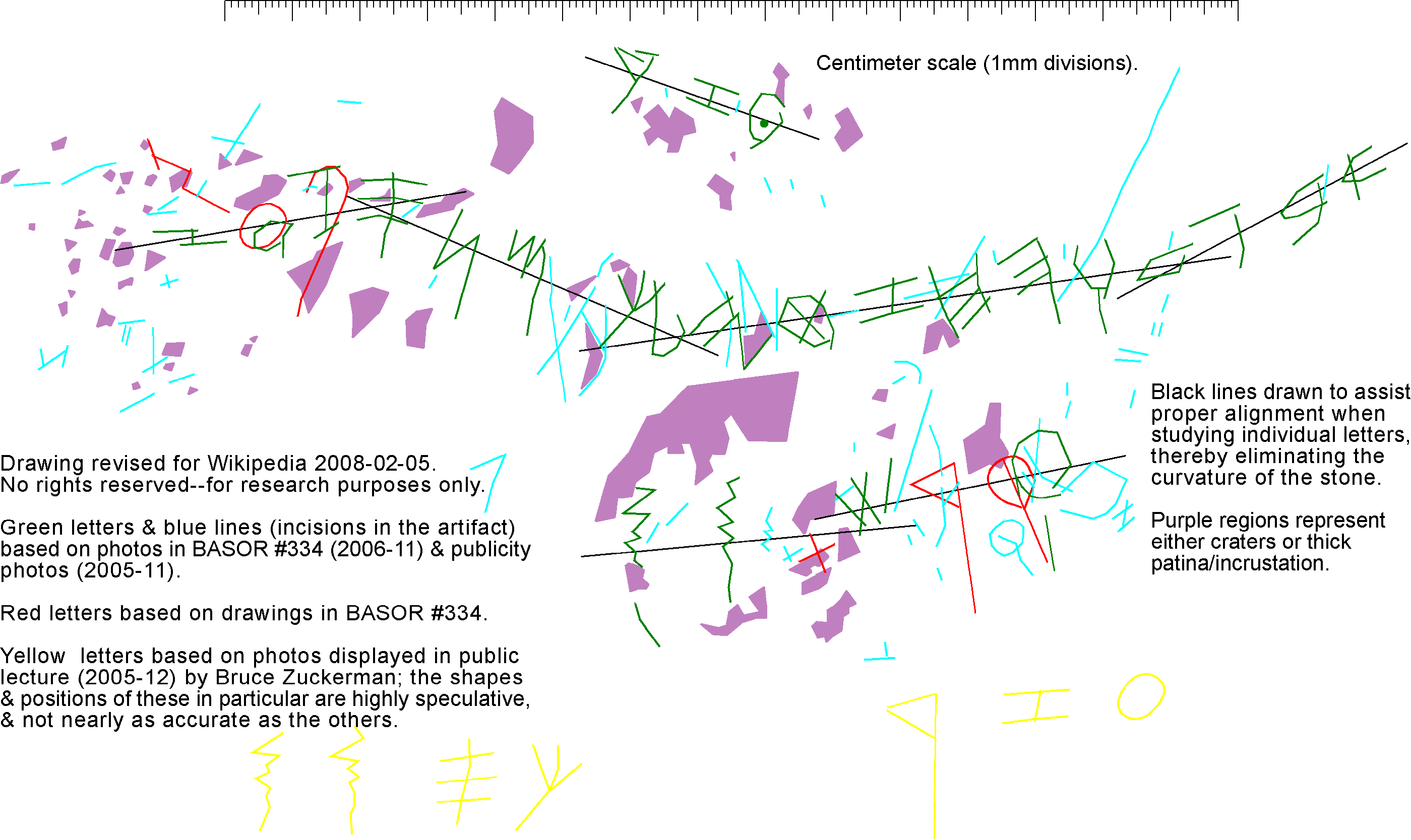
If that other guy (probably a guy I invenented imagined) tries to trick me, fuck that guy.
I hope we're friends, may he respect me for seeing through his scheme.
planet ~ plant
shop ~ shelf (I literally misheard shelf as shop when they were cognates in the context (ai off the shelf is ai available in shops))
Глядя на мать: я выбираю культуры твоей родины (роди́наUA семья (а у крепостных что скажут то и ро́дина (rodzina = family (RUродина = ojczyznaPO))))) ибо у меня отец гораздо быдлее, и родственники его такое же говно.
is poland роланд? ruland, russland, you've got me. Рой? Рай? Раша точно не рай. Хотя, лес, людей нет, чем не золотой век? Зверь и люди враждуют. Сегодня это вылилось в антибиотики (зверь это всё живое кроме нас (задверью? неверь? проверь? сверь? сверь отличное, неверь в этом же смысле было (т.е. за зверями глаз да глаз)))
рай в смысле рой (животных полный лес, изобилие (и хищники сыты, и ты вооружён))
вооружён (с ружьём, во всеоружии)
lusting ~ lasting (everlasting)
(через день после того как резко перестаёт чего-либо хотеться, люди умирают "от старости")
strive's to live (to life (is fe misorthographed if? is english ending fe word if? let's find out: ))
is "fuck you" a phrasal cognate of хуй тебе? хук~хуй? f~h? what does it tell us of g? Z was the final letter of the line. I suspect Θ to bve greek vav. But what is
A page about which I had no idea:
And is tel zayit the only authentic abecedary in old-hebrew anything? Is even it authentic? Then we must study the disparancies of their order, which was decyphered by previous scholars as
א ב ג ד ו ה ח ז ט י ל כ מ נ ס ע פ צ
ק ר ש ת
shop ~ shelf (I literally misheard shelf as shop when they were cognates in the context (ai off the shelf is ai available in shops))
am I right? I knew I'm right:
not designed or made to order but taken from existing stock or supplies.
a product that is available immediately and does not need to be specially made to suit a particular purpose.
not designed or made to order but taken from existing stock or supplies.
a product that is available immediately and does not need to be specially made to suit a particular purpose.
Глядя на мать: я выбираю культуры твоей родины (роди́наUA семья (а у крепостных что скажут то и ро́дина (rodzina = family (RUродина = ojczyznaPO))))) ибо у меня отец гораздо быдлее, и родственники его такое же говно.
is poland роланд? ruland, russland, you've got me. Рой? Рай? Раша точно не рай. Хотя, лес, людей нет, чем не золотой век? Зверь и люди враждуют. Сегодня это вылилось в антибиотики (зверь это всё живое кроме нас (задверью? неверь? проверь? сверь? сверь отличное, неверь в этом же смысле было (т.е. за зверями глаз да глаз)))
рай в смысле рой (животных полный лес, изобилие (и хищники сыты, и ты вооружён))
вооружён (с ружьём, во всеоружии)
lusting ~ lasting (everlasting)
(через день после того как резко перестаёт чего-либо хотеться, люди умирают "от старости")
strive's to live (to life (is fe misorthographed if? is english ending fe word if? let's find out: ))
is "fuck you" a phrasal cognate of хуй тебе? хук~хуй? f~h? what does it tell us of g? Z was the final letter of the line. I suspect Θ to bve greek vav. But what is
A page about which I had no idea:
And is tel zayit the only authentic abecedary in old-hebrew anything? Is even it authentic? Then we must study the disparancies of their order, which was decyphered by previous scholars as
א ב ג ד ו ה ח ז ט י ל כ מ נ ס ע פ צ
ק ר ש ת

the letter in different colour make me lay it away for later, as if "it's too early for me"
but then we're here somehow, so let's ponder on it. W is definitely an ancient symbol, if this stone is authentic, and let bring the stone itself once again, but I found something better, the answers.

I wonder why it is so difficult to get actual photograph of the stone in open access, I think I brought it here before, it must be somewhere in previous volumes. But today I could only find this:

which is also cool, because this is a different angle, but it's not complete, like wtf.. I don't know if I should contact that Ron Tappy. Is it a bait he layed out? Either way, I have additional scepticism to everything coming from Israel, it is a sneaky tribe and too much of geopolitics are around it.
I look at this stone, and it doesn't make much sense to me. It is not a work of art, so how was it laying around seemingly being never put in wall? The scratches seem so thin, how didn't they got messed with? Overlaying writings and strokes are a nice detail, but they don't make much sense to me either: it is just a rough stone, why not eraze what you wanted to change?
Думая о тех ду́хах, осознаю, что это неизбежно отпечатки людей (подобно тому как мефистофель отразился образом паши свиридова (цыган, но сказал бы что еврей я бы поверил (неоседлый образ жизни сохранил привязанность к хуцпе, ушлости, чертам неприличным в оседлом обществе (потому что в оседлом обществе они являются проявлением ..глупости? нет, не обязательно, но очевидно нелюбви. Кому нужно жертвовать любовью ради сиюминутной выгоды? Тому кто уедет прочь, в другой город, кочевнику. Все гады кого знаю уехали дальше на гастроль. И в этом тоже мудрость мира. Что с глаз долой из сердца вон. Иначе это для них небезопасно, люди разные и кто-то захочет отомстить кровью унижение смыс.. смыв)))
Но ту, кого я назвал белой богиней, я не узнал. Быть может, это образ собирательный. Наложение всех классных женщин? Великая матерь? Великая материя (мать это, видимо, современный, лаконизированный вариант, типа Б-г (бог, благ, бандерлог впрочем тоже, но что это за слово, не советским ли переводчиком внедрённое?)
G-d(god, good, gold, greed, gingerbread, grandparenthood)
Were God and us compared as gingerbread and bread? b-d (bad)
g is good
б is bad?
Хвостик! Это хвостик! Хвостик снизу когда хорошо, а когда вверх хвостом подняли или вниз летишь это плохо. Когда хвостик снизу, то рыбка плывёт вверх.
Оттого жизнь полосатая, что вверх-вниз, вдох-выдох? Но пусть эта полосатость становится всё светлей. На уровне того что пить хочу сейчас, и выпив воды дал светлую полосу клеткам горла и печени, в уме вертелось, тоже.
Запятая между "печени" и "в уме вертелось" нужна лишь чтоб было понятно что именно тоже.
Но если убрать вторую запятую, то смысл точно в ту же сторону переключится
бля~для - таковы все матерные слова? их надо только узнать?
ебать~опять? повторы делают вхождение еблей?
хуй~кто? кто~que-это? кто-это~хуета
пизда~бездна? без дна, оттуда люди выходят. пизда позади:? пиздуй~по-заду? пиздец~безdeath?
титикака такое по детски дикое, что естествнно это не в японии, а в африке.. так плохо я думаю про африку, как ни стыдно. а титикака в южной америке. титикака, ай хэв ноу бангхоул.
тити попа кака, всё глухие согласные. и даже пися! табуированность даёт глухоту?
блядь очень звонкое слово. бля на д? бля и блять~блядь одно и то же слово, так может это глаголь? глагол тоже глагол чтоли? глаголь.. глаголю, глаголим,
глаголь = glagoli, it has i, so glagolю is glagolia: a~o~u, don't palatalize consonants, and thus in syllabaric sense they are not three, but two vowels. O and I? ו and י, now it makes sense. In both writings systems O is large and I is smaller. Just as mouth being open more or less makes sense in articulatory representation. Thus I indicates, that we rotated the original text 90 degrees, and yet we're to figure out which way. Was [i]и(and) link like — and then being separated with — shape being left to punctuation. is ? c the ךִ or something? כִ (yes, I'm speaking of qui (paradoxically half of the world will learn this french word because of that juif))
пися бесится? пися висит? хуй гу..д? хуй же худ, а если озвончить, то гуд, и столбы как божество? деревья же столбами, деревьям видимо молились как воплощению матери земли. Особенным деревьям как её особым представителям.
зайти на беседу ~ зайти на пизду? были глухие и звонкие одним и тем же? д~т, это я с детство разумею: ть в делать определённо to~do
do go is to go? well, maybe it used to be more the same then than now, the semantic deviation is subtle even now.
I think I found the proto-I: ꟷ (I found in one of my earlier works, I need some ai to keep it all in mind, as I intended to have, before I allowed myself to write everything down, to document every thought, not only the certain revelation, but everything so the uncertain ones are not missed. We'll figure it out somewhat later. I am still acquiring the material for further research, I collect the observations. Of any kind. Some of them have already lead to some consistent narrative, which I here and therefore call booklet. That booklet, where every sentence is whether something new or a comment to that new statement in a form of well-known or less-well-known facts.
The Sideways I ꟷ is an epigraphic variant of Latin capital letter I used in early medieval Celtic inscriptions from Wales and southwest England (Cornwall and Devon). About 36 monumental inscriptions in Wales, and about 15 in Cornwall and Devon, mostly dating from the 5th-6th centuries, make use of this letter. Except for a single inscription from the Isle of Man, it is not found in monumental inscriptions elsewhere. The letter is used exclusively in a word-final position for Latin words (or Latinized Celtic names) in the second declension genitive singular.
memorial stone in Tavistock, Devon, inscribed
SABINꟷ FILꟷ
MACCODECHETꟷ ("Of Sabinus, son of Maccodechetus"),
showing sideways I in the words Sabini and fili.
We can only see MACCODECHE and maybe the T is below that
garbage, but why is it stands as a column, when the text
is aside, and if the text continues into the ground,
wasn't it placed here after that stone was written
somewhere else? And that concave oval-like shape probably
held a piece of wood? And its current owner used it as a
part of his fascinating fence.I can only guess if FI is digraphy, or indeed they used both I and ꟷ within the same text.
Or was that stone installed as a tombstone and later it sank into the ground made of growing biosphere shedding leaves to compost them into soil.
Compare this stone to tel zayit. It's hard to imagine that Zayit stone was used as a grammar artefact and it wasn't drawn deeper into it. So inconsistent, so fake, and imagine how obvious that monkey business become to
If we look at hebrew pair of ו and י, then we can notice that they're the thinnest of them all, which may tell of their emptiness in the context of consonantness, they're pure vowels, and thus I is originally o, but then it is also u, and their neighbours consider ا a.
а в
я ж
и к
о с
у
These are simplest (one-letter) words in russian.
And to my surprise they align B T
legend, that к~с (to~with)
В is inside
К и С - outside
and semantical articulation I can imagine is kiss and spit.
of kiss, showing sucking move labials fprang
of spit, showing outside tongue sounds developed
[kh] cough ~ kaf [k]
ж всё же же. но не являются ли в, к, с, краткими формами
слов во, ко, со (но почему по до п не сокращается? б is a
short form of бы, мы знаем что не просто б, но бы, словно
название буквы би)В is inside
К и С - outside
and semantical articulation I can imagine is kiss and spit.
of kiss, showing sucking move labials fprang
of spit, showing outside tongue sounds developed
[kh] cough ~ kaf [k]
но мы знаем и что во ко со, а не вы ку си.
о это тоже буква же со смыслом. в отличие от е (же это название буквы Ж)
а б в а бы во да
ж её ёж же за
и к и ко ли мы на не~ни но ну
вот это Н дало! НА НЕ~НИ НО~НУ
o c об по Ра со ты те та то ту (ы=и!)
вот это Т дало! ТА~ТЕ~ТЫ~ТО~ТУ
сё и то.. сё~сие
И это я забыл про С! Сее Сии Сей, всё трёхзначные, значит не забыл.
у у уф ха це чё ша ща
я эх эй юг я як
ко от к чем-то семантически отличается? нет. значит двубуквенные не составные, а сами по себе морфемы независимо от состава. et[e] = [i]и?
а я
и у
к с
о
and here I realize that I forgot about в. In russian в is similar to o and у (о is about, and у is at (at and about are not exactly in, actually they're к and с.. к~у с~о? с~u, с~о)
with ~ u c (two hands one in the other? female hand is upwards (does it tell that females were short? that young girls were married? I would easily expect that from ancient warlords, and mohammed demonstrates such behaviour.))
в looks as double о, so not just about, but in. разница меж у и в. Единый вав, но в глубже
о у в это история вхождения: о-коло, у двери, в замке
Water (море) Woman (mother)
Fire fother
Did people modify their language when they invented fire?
Looking at word furnace I cannot help but ask: is fur and fire cognates? fur catches flame, I guess.
I was asked by a buddy to write a song. Or did I offer it? What was it? Both?
время нам на встречу идёт
мы могли бы тоже стремиться
приближая то что грядёт
точему данОсуществиться
Нарушенная ритма (не фи не рифма но ритм)
и пример обхода, данный фонетической лигой на О открыл другой смысл (не дано, но над. н дан. Not all which o is, all~around(ll~round?) but one chance. it's given to you, please play cool.
грязный~rгрозный (картавый, каричневый, карий, от слова кар, и кап, кал)
попс is literally поситивная песня (по значит пох? positive, the opposite of negative))
попс is literally populars
pop goest to the top.
pop top could be a part of alphabetic song of such kind:
up bob cop dope
or did each line had its own rhyme? four letters per line could be four lines in a line.
abnormal even has the un-like suffix abnormal:

who would have known that absolute has an abbreviation. And the word absolute is alphabetic, in the sense that it starts as ABC and ends with T, even though it's guts, the olu are not in the alphabetic order, unless o and u are ו, or rather is o is ו and u is o. absulot would be the case, or..
is U~F? is I~Г? because U=II (u~ɪɪ) here I reconstruct the text aroung these two sceenshots, I was foolsh enough to allow the laptop go down before I ctrlSed it.
See is C (the word see is homonymous to the name of letter C)
Видь is as more basic than Видеть as See is simpler than to see.
ВRU is as third a letter as CLA, is it the way eastern CDB and western BCD parted ways? But then english see is more eastern than russian видь, where дь is merely a verbal suffix. But в is in, which may be the key to understand the main meaning behind видение, if you saw you have it in you, you can tell what it was. If you didn't see, you can only hear about it. Isn't H just behind C? in abcefh, maybe, but what is it.
And at first I found this, and the arrogance of abkhazians apalled me, but them what if they're trying to say us something? What if their name tells a story of abc, their own alphabetic legend.

If abdominal muscle is just ab, then the points it must connect are a and b.
or is it just an abbreviation of abdomen?
The rectus abdominis muscle, (Latin: straight abdominal) also known as the "abdominal muscle" or simply the "abs", is a pair of segmented skeletal muscle on the ventral aspect of a person's abdomen (or "midriff").[1] The paired muscles are separated at the midline by a band of dense connective tissue called the linea alba, and the connective tissue defining each lateral margin of the rectus abdominus is the linea semilunaris. The muscle extends from the pubic symphysis, pubic crest and pubic tubercle inferiorly, to the xiphoid process and costal cartilages of the 5th–7th ribs superiorly.[2][3]
The rectus abdominis muscle is contained in the rectus sheath, which consists of the aponeuroses of the lateral abdominal muscles. Each rectus abdominus is traversed by bands of connective tissue called the tendinous intersections, which interrupt it into distinct muscle bellies. In people with low body fat, these muscle bellies can be viewed externally in sets from as few as two to as many as ten, although six is the most common.
I think I found my A, alba, but the other line is called semilunaris, and b would be a good crescent, but the hypothesis is not supported yet. So until I come over some ancient names of those lines, I leave it behind.

The linea semilunaris is a vertical, curved structure that runs along the lateral edges of the rectus abdominis muscle in the anterior abdominal wall. It is the site of union where tendons of the lateral abdominal muscles meet the sheath surrounding the rectus abdominis muscle, also known as the rectus sheath. The lateral abdominal muscles are the external oblique, internal oblique, and transversus abdominis muscles.
The linea alba is a longitudinal, fibrous median raphe along the rectus sheath formed by the fusion of the anterior and posterior walls of the sheath. It may be visible as a surface marking on individuals with well-developed abdominal musculature running as a depression between the xiphoid process of the sternum and the pubic area.
It separates the two parts of the rectus abdominis muscle which lie laterally. It is traversed by the umbilicus. It may be visible as a surface marking on individuals with well-developed abdominal musculature.
raphe[раф] is definitely a terminologized cognate of rough[раф]
(but then it is only a volk etimologie, feelings based science, not very certain, but if it helps to remember the term, it's alright)
жевать от слова зубы (да, настолько далеко разбег чтения некогда одного и того же символа)
жувать тогда, и действительно, жувать ещё лучше: жуй
так и совать видимо изначально сувать: суй
а ховать хуй нужно. хуй буквально означает ховай, прячь. И для понимания этих тонкостей русским необъходимо изучение украинского языка и украинской культуры.
суй и хуй антонимы? если сувать внутрь, то нет. синонимы быть может даже. ᚼ~h~ʃ~ʒ~ж~ᛡ[j]
буй
дуй
жуй
куй
суй
хуй
бой
вой
кой
мой
ной
пой
рой
твой
хой
цой
бай
ваяй
дай
знай
лай
май
пай
тай
хай
чай
бей
вей
гей
дей
ей
зей
лей
имей
пей
рей
сей
чей
шей
вей и рей похожи как ᚢ и ᚱ
вий
дий
кий
и не было? была только е? отчего так мало слов и все чуд чужие?
a
e
o
у
a b c
e v g
o p q in this representation c[g] g[ʒ] h[ʃ]
u f h
twelve probably was for some time (evg~imk or imn or even iml (L~Г, λ~ג, Λ~𐤂))
so we know 12 months, and probably cuneiform 60 are related to those 12,
being in the basis of the clock.
I read those
abc as april may june
evg july august september
opq october november gecember
ufk january february march
I have three direct coincidences, how probably was that? I chose one, april came there because of a, it could be august. Let's try it with august and shift the frame of reading to see if a for april, o for coctober, f for february was an anomaly.
abc august september october
efg november december january
opq february march april
ufh may june july.
only january sorta correlate g, gevier? why do I even use english? because I know english, so I apply it here, and which else language could it be, french was for sometime, being closer to latin, but then british intellectuals probably worked with latin and calqued its marvels into their own language, so modern english is quite alrigh. Or it never was about latin, because letters appeared somewhere else, in some other language, in some germanic language, for example, amongst runes. Because alphabets don't have anything runes don't have, runic culture has many more elements. a and o don't look like ᛆ and ᚮ in latin, for example, F and Г don't meet neither in latin nor in greek, so runes just make more sense. And they're used for divinations, and magic is really ancient.
I make myself a freak by proposing weird ideas. Ideas on which nobody even thinks are weird.
SS is SuperStar
грежу и брежу
грезить и бредить
грежу и брешу?
грешу и брешу? (пакошу и вру?)
is бред 𓃀リᚦ "нога режет топор"? или моё учение бред? не половину так точно, но я позволяю бред в этом труде, ибо из него выкристализовывается что-то более осмысленное.
А O У Е И is how ogham hav has ti it
A E И О У is how other alphabets have it
A И У Е О is how japanese kana-tachi have it, but I O A is how IrOhA goes, but then how does it go? It starts with pure I which is interesting and very promising, if the syllabary european alphabet came from is japanese and not paleohispanic for some reason, but then I know it came via paleohispanic because how similar runes to paleohispanic glyphs.
And so it is easy to compare different
objects: by three
いろはにほへと Iro fa nifofeto 色は匂えど Iro wa nioedo Even the blossoming flowers [Colors are fragrant, but they]
ちりぬるを Tirinuru wo 散 りぬるを Chirinuru o Will eventually scatter
わかよたれそ Wa ka yo tare so 我が世誰ぞ Wa ga yo tare zo Who in our world
つねならむ Tune naramu 常ならん Tsune naran Shall always be? (= つねなろう)
うゐのおく やま Uwi no okuyama 有為の奥山 Ui no okuyama The deep mountains of karma—
けふこえて Kefu koyete 今日越えて Kyō koete We cross them today
あさきゆめみし Asaki yume misi 浅き夢見じ Asaki yume miji And we shall not have superficial dreams
ゑひもせす Wefi mo sesu 酔いもせず Ei mo sezu¹ Yoi mo sezu Nor be deluded.
(I can see a lacking syllable in the third line. is it that perfect imperfection they value)
three out of five vowels stand in the beginning of their line. And those three are no other a i u, the ones keeping their position relatively to each other (not to one another, to each other, feel the difference) in japanese and latin.
But then in hieroglyphic form it looks otherwise:
以呂波耳本部止
千利奴流乎和加
餘多連曽津祢那
良牟有為能於久
耶万計不己衣天
阿佐伎喩女美之
恵比毛勢須
(it would go in columns from the right top corner down, but unicode goes in lines)
and here it has I and A as the opposites, in russian one
makes syllable palatalized, other does not, and U is A in
this account, as bus is bʌs. And notice that it also has o
above e. And probably not a coincidence by based
mathematical consequence: 千利奴流乎和加
餘多連曽津祢那
良牟有為能於久
耶万計不己衣天
阿佐伎喩女美之
恵比毛勢須
(it would go in columns from the right top corner down, but unicode goes in lines)
I is the vowel of the first half of iroha, A is in the very middle of the second half of it, U is in the middle of it, separating I half from A half. And A is literally in the middle of the second half: it has 11 syllables after it and 11 syllables between A and U. Halves have 23 syllables each, with 47 total.
And all three numbers are prime numbers (in russina they are called simple (простые))
The first appearance of the Iroha, in Konkōmyōsaishōōkyō Ongi (金光明最勝王経音義, 'Readings of Golden Light Sutra') was in seven lines: six with seven morae each, and one with five. It was also written in man'yōgana.
Structurally, however, the poem follows the standard 7–5 pattern of Japanese poetry (with one hypometric line), and in modern times it is generally written that way, in contexts where line breaks are used.
It says, that it was written in lines, not columns. Is lines ancient traditioin in this region too?
It is said[by whom?] that the Iroha is a transformation of these verses in the Nirvana Sutra:
諸行無常 Shogyō mujō All acts are impermanent
是生滅法 Zeshō meppō That's the law of creation and destruction.
生滅滅已 Shōmetsu metsui When all creation and destruction are extinguished
寂滅為楽 Jakumetsu iraku That ultimate stillness (nirvana) is true bliss.
Iroha sequence is also interesting in a sense that I O A indeed go in this order within the poem.
It is truly the alphabetic sequence: The Iroha sequence is still used today in many areas with long traditions. Most notably, Japanese laws and regulations officially use Iroha for lower-level subsection ordering purposes, for example 第四十九条第二項第一号ロ (Article 49, Section 2, Subsection 1-ro). In official translation to English, i, ro, ha... are replaced by a, b, c... as in 49(2)(i)(b).
and musical notation I noticed before, I think I also noticed that the final note is To
English
A
B
C
D
E
F
G
Japanese イ (i) ロ (ro) ハ (ha) ニ (ni) ホ (ho) ヘ (he) ト (to)
Japanese イ (i) ロ (ro) ハ (ha) ニ (ni) ホ (ho) ヘ (he) ト (to)
The story mostly seems to be around vowels. Labials, linguals, those are purely alphabetic play. Probably that is how alphabet came into being separately of the previous writing systems.
色 [i] colour
有 [u] be, have, exist (in chinese) in japanese it is yes, but also posession, so it's have.
於 [o] in, at
衣 [e] clothes
阿 [a] flatter (it is a hidden wisdom of wearing something colourful make other people feel good, because you vivid their day, or that you dress well to meet them)
And this sequence tells, that u is of o, and e is of a, also those pairs are two to one syllables apart.
abyss ~ abc
They say, reading bible backwards is satanic, but what kind of bible? In which book it ends? I guess I have to try all 66 or more if there is more.
And jewish bible ends with יעל, which is technically a goat with the largest horns. Though I guess in that context the meaning is defferent, because I can see nothing in the translation about the goat.
But nevertheless yes, very satanic
(technically it ends with ויעל, but ו is just and, so technically the first word of reverse bible will be.. but way waa wait, I read that bible used to go unseparated into distinct words in plain text of unseparated line of letters, thus it starts as goat and.. עמו (with him)
אלהיו (his god)
יהוה
An in direct sequence it is ieoua his god with him and goat. But it is translated as the Lord his God be with him and let
him go up."
And why is
הוא יעלה is he will rise, wiht הוא being he, so that יעל is also rise. Which is very weird. But then in the final battle the one on the bottom has to go up to meet the one destined to go down upon him.
Are prophecies just grammatic mnemonics?
and then in my edition this line follows:(technically it ends with ויעל, but ו is just and, so technically the first word of reverse bible will be.. but way waa wait, I read that bible used to go unseparated into distinct words in plain text of unseparated line of letters, thus it starts as goat and.. עמו (with him)
אלהיו (his god)
יהוה
An in direct sequence it is ieoua his god with him and goat. But it is translated as the Lord his God be with him and let
him go up."
And why is
הוא יעלה is he will rise, wiht הוא being he, so that יעל is also rise. Which is very weird. But then in the final battle the one on the bottom has to go up to meet the one destined to go down upon him.
Are prophecies just grammatic mnemonics?
תם ונשלם תהילה לאל בורא עולם Glory be to God, creator of the world
תם (finished, which is easy to remember, because ת is the final letter, and ם is sofit)
ונשלם (and paid)
תהילה glory
לאל no.. (but then I can see that it is two words: ל אל (to god))
בורא creator
עולם world
But to understand it, we have to delve deeper:
תם ונשלם תהילה לאל It's over and we
give glory to god.
תם ונשלם over and done
תהילה לאל בורא עולם Glory to God,
creator of the world
בורא creator (but if we dare to separate ב, it immediately
separates ו, opening the underlaying רא, Rah, which can be
translated from hebrew as See, which makes sense since 𓂋
is R, but I thought it was mouth, was it an eye? אני רואה
[aní roé] is I seeBut then it is probably not a part of bible, but a separate spell. Because world is not as cool as goat?
Because it is written in different font:

יעל (שם מדעי: Capra) הוא סוג במשפחת הפריים. היעלים נפוצים בעיקר באזורים הרריים ברחבי העולם הישן.
תכונות
יכולת טיפוס
Го́рные козлы́, или просто козлы́ (лат. Capra), — род жвачных парнокопытных млекопитающих из подсемейства козлиных семейства полорогих. Некоторые виды этого рода называют козерогами, два вида, обитающих на Кавказе, — турами.
Домашняя коза (Capra hircus) — одомашненный представитель этого рода, который произошёл от безоарового козла, в настоящее время выделяется в самостоятельный биологический вид. Доказано, что она одомашнена более 8500 лет назад.
הָרִים הַגְּבֹהִים לַיְּעֵלִים“ — ספר תהלים, פרק ק"ד, פסוק י"ח”
בישראל מצוי המין יעל נובי, שנפוץ בנגב, במדבר יהודה וברמת הגולן. הסוג יעל כולל גם את מיני העזים. עז הבית, תת-מין בסוג זה, בויתה מעז הבר
Capra is a genus of mammals, the goats, composed of up to nine species, including the markhor and many species known as ibexes. The domestic goat (Capra hircus) is a domesticated species derived from the wild goat (Capra aegagrus). Evidence of goat domestication dates back more than 8,500 years.
Wild goats are animals of mountain habitats. They are very agile and hardy, able to climb on bare rock and survive on sparse vegetation..
So hardly it is a coincidence, so the bible ends with the story of god and his goat is with him, probably telling that devil is the God's goat.
I wonder if eat is reduced form of feed, which is related to food, and to питать, which is related to пить, where п is probably related to פֶּה (mouth)
IUOEA oroha (R~U(ᚱ~ᚢ) and E~H, which is Е and И in greek, both vowels, so iroea? iuoea!
AIUEO japanese hiragana and katakana order, and also order of all philippines syllabaries.
AEIOU standard latin order, not only latin, but modern latin alphabet alright, georgian too.
AOUEI ogham's order, it doesn'a share aiu sequence of latin and japanese, it lista lists a
IVXLCD reflects IUOEA (I U could be all there was: the beginning of the first half and the beginning of the second: 23 and 24 (a prime and 2*2*2*2*3)
But then is it so across the numeral systems or is it only a fluke fo of the decimal?
Numeral systems don't change the numeral reality, was my firest response, but let's think.
In trinary ternary it would be 2*2*2*10, it would be..
1 1
2 2
3 10
4 11
5 12
6 20
7 21
8 22
9 200
10 201
11 202
12 210
13 211
14 212
15 220
16 221
17 222
18 2000
19 2001
20 2002
21 2010
22 2011
23 2012
24 2020
and that 2020 is 2*2*2*10? But then I don't recognize these numbers, thise 10 is 3
20 is 6, so 2020 is somehow 4 times 20, or 11 times 20. What's going on here?
11 acts as 11 in decimal, even though technically it is a strange way to write down 4 (triangle of 3 balls is their 10, and 11 is just one more ball to that 10, but can you see three as 10? then 0 is 2? welly, it as if symbolizes that. People naturally played with different numeral systems before they settled with decimal. But then hands could be playing the crucial role in the evolution of numerology.
Ternary is a whole different way to think of numerals. Let it be my sacrifice to numeral muses. To mathes. To mothers? Three muses working with numbers are mothers? The norns? Are norns even mothers?
Are norns drawing numerals?
Were runes
numerals?
Were those aettir units unos
tens and hundreds?
What if they're three times three muses, three in general,
but within each three passions? Probably no, they're nine
sisters. And the way I attributed them to digits, letters
and notes is probably not correct, they share those
instruments. Do they? I guess they do, they are happy
fairies, happy deities. f~d? гг~d?ERunes
were numerals in days of the week.
or were they musical notes? letters?
Узелковое письмо (цзешэн) предположительно
существовало в доисторическом Китае до изобретения
иероглифической письменности. К узелковому письму в
китайской традиции возводилось возникновение
письменности, а изготовление ткани или сети
ассоциировалось с созданием письмен и текстов[4][5].or were they musical notes? letters?
:I remember having much less
information on knot "writing" on the internet, now
it's much better
Упоминания об узелковом письме сохранились в литературе древнего Китая, в Ицзин (Книге Перемен), Даодэцзин и Си цы чжуань[4].
Легендарному первому императору китая Бао Си (Фу-си) приписывают как изобретение узелкового письма, так и пришедших затем ему на смену триграмм:
В древности Бао Си был правителем (ваном) Поднебесной. ... Исходя из этого, в начале создал восемь триграмм, чтобы проникнуть в добродетель просветлённого духа и распределить по родам (классифицировать) суть десяти тысяч вещей. Создал узелки на верёвках (узелковое письмо), сплёл сети и силки, чтобы охотиться и ловить рыбу. (Си цы чжуань, II, 2)
古者包犧氏之王天下也,仰則觀象於天,俯則觀法於地,觀鳥獸之文,與地之宜,近取諸身,遠取諸物,於是始作八卦,以通神明之德,以類萬物之情。作結繩而為 罔罟,以佃以漁。
and trigrams to which this wave took me is also something to dig deeper into, because it tells to describe 万 things, more than hieroglyphs do, or about that. So naturally the two systems are connected, and binarity of trigrams make me think of binarity of knot and no-know no-knot (of knot and not)
And to my surprise, trigrams can come in different order:

I wonder what it is supposed to be, and why not the symples hieroglyphs are associated with the simplest hexagrams which are trigrams, but then hexagrams cannot encode 10000 things, only 64



and probably the root of the difference in hexagrams shown above:

Fuxi's "Earlier Heaven" (above) and King Wen's "Later Heaven" (below)

but those were all trigrams, here's how hexagrams can be obtained by combination of trigrams:

probably it can give some wisdom, about agriculture and sociology and who knows what, finance maybe, but I only touch this filed, this ䷁
Utero ~ intero (uteral~uternal ~ internal) в сравнении с русским словом нутро (от внутри)
interno ~ inferno? чрево зверя? вознесение лучше разложения? смерть от старости лучше кровавой? это очень древние понятия и вместе с тем очень умозрительные рассуждения
насколько корректно такое представление, интересно (uterus~interest? интерес, внутренний что-то? или inter означает между? между стен? after all, it's interior, but then in is the opposite of ex of eter exterior.. but interior shares inter with internal, in-terra? ex-terra? is in inhaling and ex exhaling sounds?)
English is also pretty fucked: how comes word rational has rat in it. May it be racionalism, but then everybody cry that it is obviously about race, which is probably even true, because what is rational is measured according to cultural norms, which are directly national in nature.
partly and hardly (one is so easy to be heard for the other, yet are they antonyms or synonyms.. or both)
A B C
A B G
A B D because the only alphabet with three letters in the first line I saw is ᛆᛒᚦ
банда ~ b and d (бабка и дедка ~ папка и детка ~ папка и тётка (что я хочу сказать? глухота-звонкость обращают значения на каком-то базовом лексическом упровне? или что нет разделения по полам в разделении на губные и язычные (пока не знаю, наблюдаю)))
банда означет связь, как и bond, bondage, but bandaid. b on d? b an d?
может это слово только случайно алфавитно? maybe ban is the root and d is a suffix? бинт вообще говорит что глсн лшн, омонимы возможноы, но ы
если банда изначально семья, простейшая социальная связь меж bабой и dедом, то банды и сегодня семьями называются.
ABD [abd(d~g (but then T next to П makes me think it was just D[d]))]
EFГ [evʒ(ʒ~ɦ (but then is Ψ х or k? I can see Х in Ψ, the χ))]
ΙΜΛ
ΟΠΤ
ΥΦΨ (at first I thought it was ΥΦΡ, but Ψ is in the right position and graphically is also just right)
ΙΜΛ and ΟΠΤ are torizontal horizontal, while ABD EFГ and ΥΦΨ are vertical doublings
Наиболее древнее протокипу состоит из 12 свисающих нитей, некоторые из которых были с узелками, и нитей, обмотанных вокруг палочек, обнаружено при раскопках герметичной комнаты одной из крупных пирамид на археологическом объекте Караль[10] (в долине Супе) археологом Рут Марта Шейди Солис (Ruth Martha Shady Solís), датируется по стратиграфическому слою приблизительно 3000 годом до н. э.[2][11]; в связи с чем кипу может считаться одним из самых древних (после шумерской клинописи и египетских иероглифов) видов письменности у человечества[12]. До этой находки самое старое кипу радиоуглеродным анализом датировалось 779‑981 годами н. э. Столь большой промежуток между этими датами пока не нашёл объяснения у историков.
Читая вики, понял, что кипу могла быть числовой записью того, что привязывалось к главному шнурку (если лист кукурузы, то кукурузы) но это поверхностное понимание, но говорят, что единичных узлов не больше 9, более сложных узлов не больше 9, самых сложных узлов не больше 9, и мол узлы сложнее располагались ниже (если нити свисали) что очень похоже на числовую систему (если только цифры буквам не соответствовали. А могли. в европейских языках так уж точно, но без абеседарии или силлабарии говорить не о чем, удивительно что тоже девятки максимальные цифры, как у европейцев, но может с количеством пальцев напрямую связано. что десять это полностью all-in, но всё равно немного странно, что представление похоже ..на старинную европейскую запись, на ту что существовала у европейцев до позиционной. Но как древня она? у евреев видимо была в ходу с незапамятных времён, и повлияла на европейцев, отбросивших ради неё римские и им подобные этрусские цифры)

e looked much more like ה, if that table doesn't lie
and f looked like that. and if e is ii, then f is ij
and some forms of l are the opposite of f
It doesn't make sense,
In pompeian wall inscriptions lmn made l1 l3 l2 if you look to the few on the right of that.
e and n look ridiculously alike. but then desn't not not don't и and н do?
IU'm suspicious about that table, but I think I must put it in mind too. Why? Ai can keep it in mind and I should respecialize. I should teach ai to focus on this, by teaching it on my notebooks, I should dedicate myself to reaching immortality. I was given this chance of reaching it, I should put into it some labour.
Today I sent to Johannes Richter..
l the root of the alphabetic and
similar writing systems is more simple than 5, 3 has
every sense to be, since the 3×3 of a syllabary of 3
vowels and 3 consonants as paleohispanic had it (or a
naked vowel and syllables with b and t, as myths may
tell) is 9, which was in the basis of jewish numeral
system later adopted by europeans in the period between
roman-like and so called arabic digits.
So let's try to play with 3×3 some more:ABD
IMN
UFT
IMN
UFT
par example
Ba Ga DaBi Gi Di
Bu Gu Du
could be the syllabic 9
Even though whisper is comprehensible,
m and a are still two "points of articulation" (if I
understand that concept right) because am is definitely
a different word and m is.. hm; and mother is maða,
three points of articulation. If you play with polygons,
maybe three vowels were in female triangle, 🜄,
which is literally eau (i~e, u~o) but then there's no
word consisting only of three consonants.. but maybe
there was in the past, when they allowed themselves to
write without vowels. FLM? but then ABC tells that FR is
enough.. or is it feu the opposite of eau? is f sound of
steam?
WTR would be english water 🜄,
FR would be the two of the bar acroos it, that would do earth, not steam, weird, 🜃
Water and fire seem to be the only two which started alchemy. People probably boiled salts out of liquids first.
If 🜂🜄 were the first forms, two direction, meeting and giving birth to all the world? They were the world, the world we know is interconnection of different waves, so the first connection could be called a beginning of the world, but what it is is next stage of the world. Before that differences only grew, but two противонаправленные силы создают момент, вращение, и на микроуровне появляются все ммкм микротурбуленты
That 🜃 could be made by two 🜂🜂s or two 🜄🜄s or by 🜂 and 🜄, they both had that bar, which made me go away, (was it automatic writings?)
Пиши по русски говорю я себе.
Потому что на русском думая открыл эту тему, потому что русский первый язык, потому что русский я зщна знаю лучше и только хотел сказать что опечаток таких потому менее делаю, но и могу меньше на менее исправить если именно такую опечатку я сделал.
Потому тчо кр что русский глубже у меня и потому им больше увижу. Пусть англичане английский разбирают.
Бей Дай
Вей Зей~Жуй(зев~жёв~зоб)
а в английском Buy Die
Wij Zij
Mij Hij
in nederlandsk it's definitely pronouns
So if you ain't dutch you ain't much (ain't is a not, something not, eine niet of soms)
Э Ю Я
is A U C?
Аз~Яz
Ю~b~Вв~V~U
Это~Сие (е is lingual vowel, u is labial vowel, я is йотированно, но а is pure, even if it's ã)
UVW may also be a rudiment of grammar within abc's, because Vi is you and We is we. Is there a language which cognates latin vi and english wi? something like this would be very weird for such antonyms would thus be very homonymous.
And when me measure, we'll find that no language combinese w for we and v for you.
English has y not too far, and I think it's the very same greek ϒ which is V in old latin.
uvwxyz
Z makes great Zie
We You Zey?
You We Zey.
U W Z could easily be the last (or second) line
How is it that V and Z are in the second line of the greek alphabet, but both are only in the fifth line of the latin alphabet. Were lines existing before alphabet board? Did people use abc as a mnemonic tool before they invented alphabet of a to z or a to t kind, even if juzt a to h the z if it was αβγδεθηζ where η didn't change it's positional number, but θ was mistook for 8, when it was 6
was ζ the Ζ mistaken for 7 when tabooisation of θ began.
θ is naturally an open vulva, an image probably sacred but open for everybody to see. that this is how it all began for each of us.
a book I would like to look into:
I only wish there was a reference section. Lots of information about where the Tarot actually comes from. A good explanation of the symbols on the cards. This book covers the Major Arcana only, up to 11, Justice. Also a really cool pairing of the cards "as they must have been in the Egyptian Temple of Initiation".
Chapters are : 1 - Ancient Tarot Symbolism
2 through 12 are cards 1 - 11
13- false prophet
14- epilogue
15- the mysterious sphinx
16- the magic wand
17- symbols
18- symbolism
that they only look upon 11 cards gave me understanding that they consider other 11 to be inverted forms of the previous 11, but I still need to look into the book itself.
few pages I managed to obtain so far:




These two pages may tell how they paired arcana:
0&1 (Fool&Magus, one is the opposite of the other)
2&21 (High Priestess & The World (are these two the opposites? Magus has to choose who to serve?))
3&20 (The Empress & Resurrection)
4&19 (The Empreror & The Sun)
5&18 (The Heriophant and The Moon) probably those are not antonyms, but I have to read it to
6&17 (The Lovers and The Star) understand the principles on which he combined them thus.
7&16 (The Chariot and The Tower) but chariot and tower can be see as the opposites
8&15 (Strength and The Devil) is Devil weaknesses?
9&14 (The Hermit and Temperance) is hermit to the extreme? bous s both sustain.. of other extreme
10&13 (Wheel of Life and Death)
11&12 (Justice and.. The Hanged Man)
I can see some opposition in those pairs, as upside down tarot is, read interpreted, as runes are.
What does it give us? Well a work on tarot I could make we have made by somebody else. And he also placed 0 after 21, which is not what I would know, like why? See, have to read it.

even though I have my doubts, also about great and grand being that far apart, I find it fascinating
Here I work on letter to Hans Richter, which contains some tasty bits I leave themn black
See, here is why I need a phone line: you explain it obviously thoroughly, but I get overwhelmed with questions to understand your way of thought. Even though we dig the same subject, we do so from our own unique perspectives and maybe we excavate it on different planes. I try to discover the very origin of the writing systems, thinking of marks of animals (many similar words: in russian when animal pee or poo, it метит which is also "leaves mark" even if a human does it with a chalk on a gate or pen in a notebook, that metit is relative to meaning блиен как же сложно про русский на английском писать. Пиши на руссокм когда про русский речь. И на филипинском когда смеешь что-то про филиппинский отмечать.
And edit is a good invention, I definitely can see what to cut out,
and I have to
write with pen, my digits sore.
I collect some mail here, for there is a tradition of publishing the artistic and scientific correspondence and here I place quoted lines in smaller font, not of disrespect, but to show their words further in time and in a geographic perspective of second personal pronoun
::::Among the initial ideas I discovered the correlation of the Provencal word “Diéu” for sky-god and the Provencal personal pronoun of the 1st person singular “iéu”.
This one always made sense to me, because of jamaican I&I (the rastafarian personal pronoun Me as in me and god. M is definitely two people holding hands, мы (we (as wir is we(rotated))) but I got distracted. I&I is me and god, who are one.
It also makes sense in the context of very interesting homonymous antonymy in european personal pronouns: vi is you (not we) in latin and russian, ya is I, not you, and there are plenty of such. My guess is those words were names of the tribes. And names of the tribes could easily be representing the names of their god. And names of the gods have similar homonymous antonymy: god of one tribe was devil of their adversary neighbours. Deva is god in India, but satan in Iran. God is year in russian, but gad is snake. Russian word for god is bog. And if this hypothesis makes sense, it will repeat in the larger range of languages, and if it doesn't, I guess it's just a coincidence.
:::: The Provencal word “Diéu” for the sky-god is related to the Sanskrit sky-god “Diaus” and the Latin sky-god Jupiter “Dious”.
To a layman it will sound wild, but it is an official point of view and is not surprise considering that the languages are taxonomed into the same "family" (a weak concept they teach everybody in arrogant wish to claim they know what is what (japanese has plenty of similar elements as russian, so those are not branches but clouds, abstractions, maps which is not the territory))
:::: As a next step I studied Flinders Petrie's book “The Formation of the Alphabet”, which contains a relatively simple model of the 2-dimensional table of the alphabets
Yes, it is one of few places where humanity even speaks of some planar structure of the alphabet only taught as one-dimensional structure you cannot understand, only memorize.
:::: It had long ago been noticed by Lepsius, Donaldson, and Taylor that, embedded in the Phoenician, Greek, and Italian alphabets there is a repeated sequence of letters,—vowel, labial, guttural, and dental.
I didn't know the "Lepsius, Donaldson, and Taylor" part. I place this piece of dialogue into my journal, I hope you do not mind.
The other one is Ganesh-Vidya, I attach the page from it.

And, surprisingly the one I use is also used by pedagogs who teach heavy autists and paralized people (I attach an example, alphabet board, google it and push images, there are plenty more, and this is one of the main standards)

And it is wild that a man can find Petrie never hearing of those alphabet board, which probably have their own corpus of thought which I never read and only hardly imagine how to find, which demands open access to all the information on everything, available to ai I can work wiht.
:::: This model contained vowel, labial, guttural, and dental, but had a few errors: Flinders Petrie's categories contained “vowels”
Why wouldn't it have them? Vowels are separated from consonants in sanskrit, but who said it came from sanskrit? In my view it could come from anywhere, when linguists pretend they know something about the origin of alphabet they're lying. Today I explore the possibility of Paleo-hispanic being the origin of runes, and from runes came latin, and from latin came greek, and from greek came hebrew, each in line lost some components of the structure as they borrowed them from their neighbours.
:::: the lingual and palatals categories are nissing
Every category except vowels and labials are linguals. Linguals are common area of all those guttural and coronal we imagine, when each of them is impossible without tongue, so tongue is the agent, as lips in labial and neither in vowels (even though o and u are impossible without lips, it is not self-evident, and for ancient people all this fiels was very new, so they naturally missed or ignored some elements of reality to create the classification and systematization of the glyphs, which were already in use: compare arabic vowels looking like all the wrong vowels: their A is like I, their E is like O, their I is like U, their O is like E, their U is like.. their u is vav, it is similar to p, but not as evidently as the arabic letters which I arrogantly call vowels, because of their relative position being the position of vowels in latin alphabet (greek alphabet is much more of a mess: it contains the mess of the latin, and adds its own (second line is much more messy)))
::: I was lucky to find a model with 5 categories labial, guttural, dental, lingual and palatals.

Yes, but here I disagree with how you place them. Why invent order unknown to readers, which by itself raises plenty of questions, which overwhelms and reduce comprehension?
I think you will like work of this guy, who also compares alphabetic sequence with articulatory apparatus: https://roouh.livejournal.com/133411.html

:::: The reconstructed 2-dimensional tables displayed the words DIAUS, DIEU and DIOUS. At this study I knew I had a new insight in linguistics...
Could you describe that insight in one or two sentences? Because I understood it as some words (random to a reader) are up and down in the columns you yourself placed in that order, like why would labial be placed between dental and guttural?
:::: Good night
Good night
And writing that letter made me interested
in the origins of the communication
board,
:the alphabet board, so I gave it
anohter shot
With origins in Ancient
Greece, sign language has the distinction of being the
oldest AAC system, with Morse Code, from the 19th
century, being the second oldest.
In 1920, the first actual known AAC
device, the F. Hall Roe Communication Board, was
created. Co-developed by F. Hall
Roe, who was suffering from Cerebral Palsy, the
Communication Board contains letters and words that a
person can point to and construct words or sentences.
The distribution of such a device was made possible by
the Ghora Kahn Grotto Benevolent Society.but that board wasn't in the order origins of which I was searchin, and now I'm hopeful that I can trace the origin of that other one in the texts on reforms in aac devices.

aac, nurse communication board, Communication Board for Individuals With Disabilities, but why am I looking for their origin? So I hope to find the author and then I will loiik for his or her papers, where may be the history of the question further into the outside of that field.
and my idea was to look up all th e sites containing images like
because if there's the history of them, they contain such image, and I was correct:
The Communication Board
was developed by the Center for International
Rehabilitation’s (CIR) Yeongchi Wu, MD in the early
1980s while he was working at the Rehabilitation
Institute of Chicago (RIC). Dr. Wu experienced some
difficulty communicating with a patient who had
sustained a brain stem infarction with resulting
quadriplegia. Please see the following for more
information: Wu, Y, Voda, J: A User Friendly
Communication Board for Nonverbal, Severely Disabled
Individuals. Arch Phys. Med. & Rehabil.,
66:827-828, 1985.
I found somebody with that weird name on linkedin, I sent
him the request about the origin of the order, if he saw
it somewhere, hopefully he'll answer, probably I should
dig more for another opinion of the origin of the board
and other ways to connect contact
the guy.I kept on looking, and this one gave me understanding of which letters are more important than others:

If I listen to this set of words, UWY is what follows T, all of which could be transliterated by ᚢ,
which is the only letter past ᛏ
you know where

I think I'll email those four individuals with the question of whether they know the origin of this order.
I sent letters to Richard Hurtig and the John M Costello.
Lisa Bardach I found is too young to be the guy.
Unfortunately David Beukelman died over 22 months ago.
death metal is weapon (and as a musical genre it is пушка (пушка пугает (пулять пылать)))
Dimentional structures of alphabet. Is the subject I'm in. It should be the title of my dissertation.
I must make it a dissertation to do all I can for promoting this work, so it is not in vain.
י ה ו ה
is technically trigrammaton י ה ו [его?]
и e u the descending triad it is, and ה being A in these three.
бита(битая) и бито(битое) активный и пассивный залог. Проверим это
earn and own look so differently (though, first vowel, last n) but sound so similarly,.. ERE ᚱ~ᚢ!
Thinking of runes, the same symbols in hungary norway and psyberia, oh russian culture you're insane.
Thinkin of how runes read differently in different languages, which may indicate that they are some words, different in different languages and congatic in similar ones. Thus russian and latin read most of the letters the same. And can this hypothetic азбука reveal the meanings of the letters?
Petuh Ruster Рустер
пентух от слова петь, ртом! but I don't know english enough to take some roar word from the top of my hat head and hat cognatы
rooster похоже что означает птицу садящуюся на насест (roost (хвоРОСТина? бROOS?))
тРОСТь? рост? росток? ветка росток?
Relax, (it was an automatic
wiriting)Моя жизнь могла быть лучше, но я глубже (глуп же (deep~dumb?))
Pentagrammaton is actually another name for Jesus (and indeed Jesus is five letters)
I think I brought this image before, what I didn't notice then is that it says יהשוה which is יהוה with ש inside of it, and what would jews think of that? especially since ש is tooth, but if it's fire, than also what is it? the very essence of יהוה or what? It's open for interpretation. But then is it not yeʃua, but yeʃue?
And isn't יהוה yeve the Eve, and isn't it Jovi? Is Jupiter father of the jews? Is jew je, the personal pronoun corresponding to an ancient tribe?
That יהשוה reminds יְשִׁיבָה, even though literally they're quite different, יהשוה is read by g as ехашо́
ישו [е́шу́] which is much closer to יְשִׁיבָה [ешива́]
g.t. doesn't recognize יהשוה the way it is in this context, but translates it as will compare (but I do not know knebrew hebrew to confirm)
But then why is it here? It is chronologically very late, much later than the origin of alphabet:
The first ones to use the name of Jesus something like "Yahshuah" were Renaissance occultists. In the second half of the 16th century, when knowledge of Biblical Hebrew first began to spread among a significant number of Christians, certain esoterically minded or occultistic circles came up with the idea of deriving the Hebrew name of Jesus by adding the Hebrew letter shin ש into the middle of the Tetragrammaton divine name yod-he-waw-he יהוה to produce the form yod-he-shin-waw-he יהשוה.
This was given a basic Latin transliteration JHSVH or IHSVH or IHSUH (since there was no letter "W" or sh / [š] sound in Latin, and "I" and "J" were then not yet clearly distinguished as letters of the alphabet, nor were "U" and "V"). This could then be supplied with further vowels for pronounceability. By coincidence, the first three letters of this consonantal transcription IHSVH, etc. were identical with the old IHS/JHS monogram of the name of Jesus (from Greek iota-eta-sigma).
In Renaissance occultist works, this pentagrammaton (or five-letter divine name) was frequently arranged around a mystic pentagram, where each of the five Hebrew letters י ה ש ו ה was placed at one of the points (the letter shin ש was always placed at the upward-pointing vertex of the pentagram).[2] One of the earliest attested examples of this diagram is in the Calendarium Naturale Magicum Perpetuum or "Magical Calendar" (published 1620 but dated 1582)[3] of either Theodor de Bry (Flemish-born German, 1528–1598) or Matthäus Merian the Elder (Swiss, 1593–1650).[4] The idea of the pentagrammaton was funneled into modern occultism by 19th-century French writer Eliphas Levi and the influential late 19th-century Hermetic Order of the Golden Dawn. The Golden Dawn favored the consonantal transcription IHShVH or YHShVH, and the pronunciation Yeheshuah.
In Hebrew and Aramaic, the name "Jesus"/"Yeshua" appears as yod-shin-waw-`ayin יֵשׁוּעַ Yeshua and as the longer form of the same name, yod-he-waw-shin-`ayin יְהוֹשֻׁעַ "Joshua"/"Yehoshua". The letter `ayin ע was pronounced as a voiced pharyngeal consonant sound in ancient Hebrew and Aramaic, as opposed to the pronounced [h] sound or a silent Hebrew letter he ה.
But it plays with the concepts I introduced into this research. And the concepts are deep as can be, so I collect everything of potential value, regardless if everything of the quoted text is correct or not.
A pentagram (sometimes known as a pentalpha, pentangle, or star pentagon) is a regular five-pointed star polygon, formed from the diagonal line segments of a convex (or simple, or non-self-intersecting) regular pentagon. Drawing a circle around the five points creates a similar symbol referred to as the pentacle,[1] which is used widely by Wiccans and in paganism, or as a sign of life and connections. The word "pentagram" refers only to the five-pointed star, not the surrounding circle of a pentacle.
Pentagrams were used symbolically in ancient Greece and Babylonia. Christians once commonly used the pentagram to represent the five wounds of Jesus.
The word pentagram comes from the Greek word πεντάγραμμον (pentagrammon),[2] from πέντε (pente), "five" + γραμμή (grammē), "line".[3] The word pentagram refers to just the star and the word pentacle refers to the star within a circle, although there is some overlap in usage.[4] The word pentalpha is a 17th-century revival of a post-classical Greek name of the shape.[5]
It is not some random stuff, I brought it here because the word alpha is present in pentalpha, and they say it is a greek name of that shape, and it correlates with the pentagram-like shape of A, so are there betta in some other polygram? But no, this loose end leads nowhere. Or does it?
From Ancient Greek πένταλφα (péntalpha), from πέντε (pente) and ἄλφα (alpha), five alphas. So called for its resemblance to five alphas superimposed at different rotations.
A Pythagorean "Hugieia
Pentagram
Hygieia is a goddess from Greek mythology (also referred to as: Hygiea or Hygeia; /haɪˈdʒiːə/;[1] Ancient Greek: Ὑγιεία or Ὑγεία, Latin: Hygēa or Hygīa). Hygieia is a goddess of health (Greek: ὑγίεια – hugieia[2]), cleanliness and hygiene. Her name is the source for the word "hygiene".
Hygieia is related to the Greek god of medicine, Asclepius, who is the son of the Olympian god Apollo. Hygieia is most commonly referred to as a daughter of Asclepius[3] and his wife Epione. Hygieia and her four sisters each performed a facet of Apollo's art: Hygieia (health, cleanliness, and sanitation); Panacea (universal remedy); Iaso (recuperation from illness); Aceso (the healing process); and Aegle (radiant good health).
"Hugieia" (ύγιεία: health) was used as a greeting among the Pythagoreans.
It's weird how they spell it wrong in spite of the pentagram spelling it.. ύγιεία.. it is how it spells it, the right bottom figure is not Η, but dygraph of ει.
A B C [a б g]
I Mw NΛ [i w n] as an example
U F X [u f h]
b d
p q
p q
b d
E ж З
И m N
but I do not see such symmetry in other lines, only that A reminds Д and O reminds Q which fits the
b d
p q
p q
so pbd and pq are the EЗ- and ИN-like reflections?
bdEЗИNpq? It doesn't make sense, unless they're two different pre-alphabetic structures..
E З
И N
they could be prepostions из and in
but it is a little bit too much of a stretch
И N
they could be prepostions из and in
but it is a little bit too much of a stretch
From Ancient Greek πένταλφα (péntalpha), from πέντε (pente) and ἄλφα (alpha), five alphas. So called for its resemblance to five alphas superimposed at different rotations. makes me think of western greek form of A↙︎drawn large

Oscan is fascinating particularly in it having a R-like glyph for D and D-like glyph for R. They're mirrored, but then so is B and E and C the G, and their V looks like ..well, ב, but I saw such b in a table of some more obscure writing systems, I cannot find them now. Or maybe I just poorly remembered that oscan F? But ב is just what? I found it by accident looking through my collection of fonts, I didn't link those two memories. I do now. And thus IOO recognize
That typo of IOO tells me of Io, name of god and possible reading of י ה ו ה
another reading of י ה ש ו ה is Eve. And it is spectacular that Eve and Io are both female deities mythologic figures (before Eve was just a creature of God, it probably was the Great Mother, the ultimate goddess of the ancient people. It's later we speculated ourselves higher causes and did them all wrong, but those ancient representations are haunting my mind to this day, even though I'm mostly atheistic and materialistic, recognizing yet some thinner planes or rather spaces within the rude figures we call bodies, and those thinner wavefields create some complex life within itself. Speculating about the world I can do it the way guys who created alphabet thought. Both being smart white autists, we naturally share the culture, even though in its different periods. And because we keep on having records since those days, I suspect the good pieces to be repeated over and over in our narratives (only some powerful ai can tell after reading everything of the matter)
That typo, IOO, reminds me of Io being both italian first person personal pronoun and name of a deity
Je is I in french and reminds Jah a lot. But then was io and Io in latin at the same time? Are french Jamaican? What is Jah? Jovi! Jupiter (father of jews? how old is the subversion?)
The Lepontic from the table above is different than this:

Let's add other examples of this group: Umbrian (7th century to the 1st century BC)

Faliscan (7th and 2nd centuries BC)

North Picene (North Picene was spoken in the central-eastern Italy. It is known from four inscriptions which date from the 1st millenium BC, and consist of just 60 words. It was written with a version of the Old Italic alphabet, and therefore the words can be read. However their meanings remain a mystery. One of the inscriptions is known to come from the Servici Cemetry in Novilara, a village near Pesaro in the region of Marche. The other inscriptions are thought to come from the same place, however their archaeological provenance is uncertain. It is thought that the inscriptions date from about 650 BC. (right to left in horizontal lines))

So how did they transliterated them if the meaning is a mistery? They just recognized the old italic alphabet in that, the d as Я is spectacular, the D~R link enforced by it. And look at faliscan, that symbol is A there, which enforces the hypothesis of A~D affinity.
South Picene: (South Picene is an extinct Italic language that was spoken in east central Italy in the Marche and Abruzzo regions. The language is thought to be part of the Osco-Umbrian group of Italic languages. South Picene is also referred to as Mid-Adriatic or Paleo-Sabellic.
There are 23 known inscriptions on stone and bronze in the South Picene alphabet, which date from between the 6th and 4th centuries BC. The alphabet resembles the southern Etruscan alphabet. Most of the inscriptions are on grave stones, but some are on statues)

Remember that because they don't mention found abecedaries, the alphabetic order is unknown, here they're just arranged along the etruscan abecedary (whether that one.. Marsiliana.. is genuine or not I know not, but then what do they matter, initially I wanted to make it basing my focus solely on modern state of alphabet, because people who kept the tradition alive must have known something so they did it just right, such was an assumption, and then I was pushed into the obscurity of the antiquity by the critics who were harsh but just as they thought, but they were quick to attack, they just dissipated when I started answering their questions, but then not that time, that time got me and I have absorbed tons of ancient material, and who knows how authentic that material was. See, I attack the world, the world attacks me back.
Notice that in the South Picene that ב-like shape is recognized not as f, but as v
their f is just :, like what was going on there? ᛙ is t, not m, which is funny, since russian т is т
So, old-italic stage is how old the runic tradition is, and just because norsk ruine runes were in use later, doesn't mean they're of some later tradition, because the tradition of runes preserved in norsk territories is deeper than alphabetic tradition we know. As I wrote in that letter, borrowers lost some elements of the borrwoed rwriting system, they didn't add heresies to it, they deemed heresies what they didn't know. By authoritarian hierarchy, not by some meritocracy.
Some more oscan:

Oscan was an Italic language spoken in southern Italy between about the 5th and 1st centuries BC. It was spoken by the Samnites, Aurunci (Ausones) and the Sidicini in the in Samnium, Campania, Lucania and Abruzzo. After the territory occupied by the Oscans was conquered by Rome in the first century AD, the Oscan language and culture disappeared.
Oscan was related to Latin and Umbrian, and is known from a number of inscriptions. It was written with the Latin and Greek alphabets, and with its own alphabet, which was adapted from the Etruscan alphabet sometime in the 7th century BC.

They say right to left in horizontal lines
but then why does that metal plane looks like it goes from right to left?

A terracotta marker with an Oscan inscription and stamps showing a helmeted Athena and a boar. This marker was found in a tomb near Capua in Italy and dates from 300-250 BC. The inscription reads "VIRIIUM VESULLIA[IS] DEIVIN[AIS], 'of the Virrii family for the divine festival of the Vesulias'. Such stamps appear on currency, and may devote gifts of money by the Virri family.
If the images are vertical like this, doesn't it tell that oscan went in columns?
Then that other artefact could be read like this:

This bronze tablet with an Oscan inscription dates from 300-100 BC and is thought to be from Agnone or Capracotta. The inscription is about the dedication of statues of various deities.
Photos by Simon Ager, taken in the British Museum.
I'm satisfied with that Я looking the same direction on both pictures now.
Those elements to the left could be hinges of a metal book.


During the 15th century, Latin began to lose its dominant position as the main language of scholarship and religion throughout Europe. It was largely replaced by written versions of the vernacular languages of Europe, many of which are descendants of Latin or have been heavily influenced by it.
Modern Latin was used by the Roman Catholic Church until the mid 20th century and is still used to some extent, particularly in the Vatican City, where it is one of the official languages. Latin terminology is used extensively by biologists, palaeontologists and other scientists to name species and specimens, and also by doctors and lawyers.
A few schools teach Classical Latin as a spoken language, and there are currently maybe 100 or so people who speak it fluently.
 (mirror)
(mirror)Pelasgians (the ones from whom greeks actually took their writing, though the querstion remains if that was not the previous one, the Linear B or something) are Philistine, can you believe it! And those are Palestinians. Fucking hell!)))
but this is no laughing matter
The English term Philistine comes from Old French Philistin; from Classical Latin Philistinus; from Late Greek Philistinoi; ultimately from Hebrew Pəlištī (פְּלִשְׁתִּי; plural Pəlištīm, פְּלִשְׁתִּים), meaning 'people of Pəlešeṯ (פְּלֶשֶׁת)'; and there are cognates in Akkadian Palastu and Egyptian Palusata;[6] the term Palestine has the same derivation.[7] The native Philistine endonym is unknown.
But then what modern palestinians have to do with those palestinians? Palestine is just the roman province, what ethnicities inhabit it is not constant. Currently palestinians are arabs who invaded that place and slaughtered whoever lived there before them. Probably this is one of the most common means to "assimilate" the substrate of whatever you conquer.
Rabbinic sources state that the Philistines of Genesis were different people from the Philistines of the Deuteronomistic history (the series of books from Joshua to 2 Kings)
but that book keeps on delivering:

I didn't know Linear A was translated. What are they talking about? The work seems legit though.
:I'm confused
Linear A is a writing system that was used by the Minoans of Crete from 1800 to 1450 BC to write the hypothesized Minoan language or languages. Linear A was the primary script used in palace and religious writings of the Minoan civilization. It was succeeded by Linear B, which was used by the Mycenaeans to write an early form of Greek. It was discovered by archaeologist Sir Arthur Evans in 1900. No texts in Linear A have yet been deciphered.
The term linear refers to the fact that the script was written using a stylus to cut lines into a tablet of clay, as opposed to cuneiform, which was written by using a stylus to press wedges into the clay.
in this context that "terracota
marker with an Oscan inscription" is linear too. Well,
nobody argued that,Linear A is a writing system that was used by the Minoans of Crete from 1800 to 1450 BC to write the hypothesized Minoan language or languages. Linear A was the primary script used in palace and religious writings of the Minoan civilization. It was succeeded by Linear B, which was used by the Mycenaeans to write an early form of Greek. It was discovered by archaeologist Sir Arthur Evans in 1900. No texts in Linear A have yet been deciphered.
The term linear refers to the fact that the script was written using a stylus to cut lines into a tablet of clay, as opposed to cuneiform, which was written by using a stylus to press wedges into the clay.
Linear
alphabets are composed of lines on a surface, such as
ink on paper.

Russian I is И today, so that И, reflecting latin H via greek Η as if was designed to fix the lack of M aftert I?
Why didn't they worry about the lack of Ѳ after E?
Did they only see three lines? A I U? or A I O?
А B Г Д Е Ѕ З
И Ѳ І К Л М Н Ѯ
О П Ч Р С Т
У Ф Х Ѱ Ѡ Ц
сould be the set, with ц in the end, as z

Загадка русской Ѱ (она косая (бухая))
Another interesting russian phenomenon: ӀThe Palochka or Palotchka (Ӏ ӏ; italics: Ӏ ӏ) (Russian: палочка, tr. palochka, IPA: [ˈpaɫətɕkə], literally "a stick") is a letter in the Cyrillic script. The letter usually has only a capital form, which is also used in lowercase text. The capital form of the palochka often looks like the capital form of the Cyrillic letter soft-dotted I (І і), the capital form of the Latin letter I (I i), and the lowercase form of the Latin letter L (L l). The letter was introduced in the late 1930s.
are Ѡ and Ѽ the same letter? ѠꙌѾѠ҃Ѽ and their minuscule counterparts are all the same letter
In the first cardboard session of the red folder, I came to цвет и свет being cognaties if of claire and couleur.
комната камера капсула все cup in a way, коробка, коробушка, коробушечка, наслоение 子'ds
кибитка коморка каптёрка коммиблок
капсулка должна быть по размеру, только и всего, прямо к телу на расстоянии вытянутой руки.
子 [цы] and it looks like Ц ~ Ч ..Чадо, Child isn't C 🗘? I would draw C with arrows at both ends, which would tell rotation of the letter upsided down, which makes to h which follows it to get Ч.
h is upside down child? high? when you through him to the air? Why would you do it? I saw daddies do it. Because kids like it and there are not many things daddy can do, I would neglet a child, seeing my nefews once a week was tiresome. Thanks dad I don't have to carry that weight anymore.
Thank you everybody.
子 also reminds Z, especially when it's strikethrough with
dash.so somehow ц and z meet as forms of the same 子 which is ko in japan,
which reminds that ц and k are c
is c child? гусеничкас рука в иврите () and look at hand in chinese: 手 looks just like 3 to 2 if 子 is 2 and 子 being c and 手 being
in japanese 子 and 手 are ko and te which is even closer to cd of bcd so now we have to find b in 了, but 了 is ryo in japan (more Ё than R) and lэ in chinese, notice how they're R and L
了 is translated as completed in japanese (ryu is rule, I think they're cognates, I think we should mark all words similar in both meaning and phonetic sides, and only then we should prove or disprove their historic etymology. Here, I brought these arabic numerals and why they're called arabic in europe, very weird indeed. So those ٢ and ٣ look like Ч and Щ,
as 子 and 手 both look and sound in
chinese. ц and ш

1 is aleph A
4 is ayn E O
5 is hey O E but they look the other way around.
2, 6, 7, 8 look alike
4 looks like 3, as if it is Σ only in this font Σ has 6 strokes.
6 like 7, 2 like 7, 9 like 9 Σ is for ΣΕΧ (ΧΞϚ´ (666))
Modern-day Arab telephone keypad with two forms of Arabic numerals:
Western Arabic numerals on the left and Eastern Arabic numerals on the right

In Chinese numerology, the number is considered to be lucky and is often displayed in shop windows and neon signs.[25][26] In China, 666 can mean "everything goes smoothly" (the number six has the same pronunciation as the character 溜, which means "smooth".[27]
溜 is slike and it sounds like Leo. as it is russian лехок лек легко
and I see カlike 刀 ([tao] knife) in 溜 which make me think of 田 being an o. and that the 厶like element encodes le, so I am looking russian words within chinese hieroglyphs. What can be more hilarious? ridiculous! Why do I allow me these freedomes? To expose them and to tell what is not appropriate science.
But that bestia part made me think of the demonized numbers to be important in the prechristian times.
pentagram gives number
and there is some other famous numerals, but then that region has truly plenty of numerals, as if they were the region where it all began. Is it why mathematicians are good in math in their own unique way

Back to the number of the beast, it gets more interesting:
The earliest extant record of a Protestant writer on this subject is that of Professor Andreas Helwig in 1612. In his work Antichristus Romanus he took fifteen titles in Hebrew, Greek, and Latin and computed their numerical equivalents using the principle of Isopsephy in those languages, arriving at the number 666 mentioned in the Book of Revelation. Out of all these titles, he preferred to single out Vicarius Filii Dei, for the reason that it met "all the conditions which [Cardinal] Bellarmine[13] had thus far demanded."[14]
Helwig's criteria was as follows:[14]
must yield the required number
must agree with the papal order
must not be a vile name applied by enemies, but acceptable to Antichrist himself
must be one of which he can boast.[14]
Helwig suggested that the supposed title was an expansion of the historical title Vicarius Christi, rather than an official title used by the Popes themselves. Additionally, he said nothing about the title appearing on tiaras or mitres. Helwig's interpretation did not become a common one until about the time of the French Revolution.[15]
Catholic apologist Patrick Madrid answers the Protestant claims by claiming that "Vicarius Filii Dei" has never been an official Papal title. He also argues that even if it were a Papal title, that would not be sufficient to associate the Pope with the number of the Beast, as, for example, the name of Ellen Gould White can also be similarly manipulated to get the same number (ELLen GoVLD VVhIte 50+50+5+50+500+5+5+1=666). He answers the claims that "Vicarius Filii Dei" is not written on Papal Tiara by stating that merely looking at any of the more than 20 papal tiaras still in existence—including those in use in 1866 during the reign of Pope Pius IX when Uriah Smith made his claim—plainly shows that not even one of them has any such inscription, nor is there any evidence that any of the earlier papal tiaras destroyed by invading French troops in 1798 had any such inscription either.[10]
Adventists Samuele Bacchiocchi responded to those claims, by pointing out that "interpreting 666 on the basis of the numerical values of the letters of names can give absurd results". He also notes the Donation of Constantine was considered as true to the point "this forged document was used by 10 popes over a period of six centuries to assert, not only their ecclesiastical supremacy over all the churches, but also their political sovereignty over what became known the Papal States, which included most of Italy." He also states the title "Vicarius Filii Dei" was considered as an official title of the pope.[25]
Vicarius Filii Dei (Latin: Vicar or Representative of the Son of God) is a phrase first used in the forged medieval Donation of Constantine to refer to Saint Peter, who is regarded as the first Pope by the Catholic Church.[1]
беседа is a very alphabetic word
Octal numerral system makes sense not only in the way it adds up to 365 (how they used that numeral system as calendar is still beyond me, but it is less than percent chance of that being a coincidence (even if there were three numbers I would hold on to, I hardly know two of this order, and the other one is what it adds up to in decimal (mal because 666) and then 13 or 12 would also catch my attention with their calendaral properties, but then they're the three, 666 has nothing to do with the calendar, and because number could be anywhere from 1 to whatever, 365 is less than one percent a chance that it is not by design. Because such design exists, it was chosen. And because it is not the most consistent one, jumping from 5 to 2 or from 4 to 2. And because IVXLCD adding up to 365 is much more great, jump from 4 to 2 is even more beautiful, isn't it a computer simulation? That means we can cheat. If it is true, maybe the krishnait legend of teleportation (at which I laughed because how such a powerful magician who could teleport a whole guy couldn't teleport the bone pieces to their original locations and had to teleport a guy to new york to his doctor, I called bs, and the friend got offended (it's easier to fool people than to prove them that they were fooled))))
Octal system makes sense in the sense of the periodic table, that tells that whoever invented numerals knew chemistry, let me demonstrate:
1 -
2 =
3 ≡
4 ≣ | _ |
|
_
5 | _
_ |
_
6 | _
| _ |
_
7 = | =
| actually 7 doesn't make sense in the context.. and what the context is that?
_
8 | = |
| _ |
9 doesn't make sense in this context, which also agrees that whoever made those forms worked in octal
what is the context? this is the context:
If this is true, H is 1, He is 2, let's compare and see if any of it makes sense.
1 H
2 He
3 Li
4 Be
5 B
6 C
7 N
8 O
9 F
10 Ne actually, first two orbitals close at 10 electrons. With 8 electrons at the external layer.
What makes sense is if H is K. but K is 18th. or is it not exactly sanskrit, but instead of K it starts with H, Didnt' they know Helium and Lithium and Berilium when they knew Hydrogen, Boron, Carbon? that BC sequence does raise suspicion, and F at that position makes the suspicion stronger..
but if all you have is a hammer..
but then Ne Na Mg aL doesn't it look like LMN in reverse?
Why would it be in reverse? and it is followe by Si, isn't
it Samekh? If they wanted to place alphabet into it,
they'd do a better job. But what if they only knew some
elements, and placed them in alphabetic order, which was
broken when more elements were found?
I still doubt it, and as I said, for all I have is the hammer, everything looks like a nail.
I still doubt it, and as I said, for all I have is the hammer, everything looks like a nail.
And I started with shapes of digits, hardly 4 5 6 take 4 5 and 6 lines to build. and 8 is the maximum of that system, but I speculated about 8 consisting of two 4's and indeed 4 can be seen as first bubble. even though this very glyph only three sticks take. I was mesmerized by this. Electronic clock's font caught my imagination as a child.

I sorta advertise them, and I do so before they paid me for it, because I enjoyed their old game about a bear with a hammer very much, and I did it for free, so I thank them in this other shape which maybe costs more than it would cost me to buy that game, even if for that I would have to go to moscow or vladivostok to buy them from those who smuggled it in spite of soviet lows.
So, those clock show 456 having 45 and 6 digits in them (digits like in fingers, strokes, separate elements of the screen) 3 has 5 but only because 三 is swashed in europe, those barbarians, have zero understanding of a stroke. I wonder if in chinese clock they show 3 as 三
And no, I didn't find such digital clock, but I found something else in that quest:



it shows different representations of the arabic numerals, that 2 can reflect 6 and that indeed their four is our 3. I wonder how could it happen, but their bubble is not 4, but 5, and their 6 looks like our 7, and 9 is pretty much the same. Were we the same culture when we invented 1 and 9 and some digits inbetween? 3 and 7, 4 or 5 as 0?
Ч~Г is their 2 and our 4, is it why russians added Б to В? to make Ч the Г 4th?
Г would make sense as 4 if it was г or
1 being .
2 being -
3 being -.
4 being г
but then isn't it a stretch? It is guessing, divination in a way, pondering with our mind or our souls, I feel dumber when I try to think of that as ancient people could think, my understanding of the subject is so much better than the understanding of that subject inside of the model of the ancient people in my mind
and looking at chinese clock I found, we have both modern and traditional numerals.


Even though we can see some similarity between forms of 5 to 10, forms of 1 to 4 seem to be completely unrelated
So simplification of kanji is known on many planes, one of which as manyogana containing elements of katakana, thus katakana is probably the simplified hieroglyphs, chinese hieroglyphs characters were simplified more than once, so thus my guess that european alphabets derive from chinese characters is not so off the wall, but then what if katakana was phonetic element ot those chinese characters, wild guess I know, but then hentaigana tells me to go fuck myself:

to my surprise, I miss hiragana'no glyph for wu
but then I have glyphs for all these:

well, sorta, wiki page shows them, but even the same browser doesn't show it if I copypaste them
but click those images, it leads to more marvels, there the elements of the second table are arranged along the first one (but that is so long, that it would be tiresome for me to copypaste it and even online converters failed to convert that page

meditating on this image it came to me that most of the letters are different in those positions, but few are universal, and those are M K T (they are always read in english and russian the same, some vowels may be throun into, speaking that we mostly agree on what is the 12345 of the vowels, V is 5, yes, interestibng, but U and Υ and У are three ways to write teh same thing, but we would mistake u for и, and because it is post-t vowel, it is relatively modern, and no wonder, we separated as nations even before bible, and only those few universal letters indicate the similarity of traditions indicating their unity at some turn of our history, when we were scattered and reassambled into different nations)
A E O are the most universal of vowels, even though every nation sing their vowels differently, we share most common understanding of their function and we draw them the same. Unlike germans, they deviate:
It is natural that A E O
in ogham aoe are 1 2 4, as if double o is e, not u, interesting, unless u was и then that и is of e, some extreme, different in different nations, so we separated before we got 5 vowels instead of 3, even before we got 4 vowels before 5. When we separated (english and russian) we god got god gold the brighter the better. You thought we spoke of god? we spoke of gold. Sinagogue is the house where business is made. So money lenders and money changers were there by the right of their god, bu by the law, by the tradition Jesus didn't understand. He lived outside, he brought foreign beliefs, christianity is judaism for goyim, thus they separated the purity of the old law from the influence of heresies, for foreign traditions would naturally be taken for as such.
If C is Ist degree, F (the fa) is fourth (IV)
wise ~ why's (whies, he knows all his why's) whining why
Noel is no eL, no elohim, no ale, no бухале, no elf?
A
B C
D E F
G H I J K
L M N O P Q R (I painted R grey too, because it comes together with L. After no eL comes no JK.
A
BC
DEF
GHIMN
glory him!?
or was it a sequence of holy names?
a-be ce def(us) G Him
That HIM we get if we place M next to I, as am to I.
is him he'm? he am? he be
(aM~Be. And what about aM~iS? M and S meet in M~Ϻ, ᛘ~ᛉ, ma~she, and some more was in this voluyme)
BC
DEF
GHIMN
glory him!?
or was it a sequence of holy names?
a-be ce def(us) G Him
That HIM we get if we place M next to I, as am to I.
is him he'm? he am? he be
(aM~Be. And what about aM~iS? M and S meet in M~Ϻ, ᛘ~ᛉ, ma~she, and some more was in this voluyme)
Десять и тысяча больше похожи друг на друга чем цифры обычно сходны:
tens~tons,
tens~thousands
zehner~tausende
тысяча как десять сотен? then thousand
is somehow merged ten and hundred, and though I can
imagine it, my imagination is no proof.zehner~tausende
no proof ~ not a proof (as if a negates t)
A B D
E F Г
O П Т ?
U W V would be the great continuation (two vertical repeats followed by two horizontal repeats)
四 manages to repead different other forms of 4:
IV in the box, Ч-like
4 in the right side.
IIII barred as roman numerals are barred above and below.
IIII barred as roman numerals are barred above and below.
The three Fates created the first five vowels of the alphabet and the letters B and T. It screams of a syllabary of
A Ba Ta
E Be Te
I Bi Ti
O Bo To
U Bu Tu and it is 15, the legendary 15 of Then Hermes reduced these sounds to characters, showing wedge shapes because cranes fly in wedge formation and then carried the system from Greece to Egypt*. This was the Pelasgian alphabet, which Cadmus had later brought to Boeotia, then Evander of Arcadia, a Pelasgian, introduced into Italy, where his mother, Carmenta, formed the familiar fifteen characters of the Latin alphabet. and if that previous part, It is said that Palamedes, son of Nauplius invented the remaining eleven consonants. is the later event, then 15+11 is 26, but if it's not 7+11=18, which is also cool.
But that syllabary of 15 screams to be the origin of the alphabet, because of a=1 bi=2 tri=3.. bi, tri, is it i bi ti? But then I know my fantasy is so strong, I could see 345 in 𐤄 𐤅 𐤆 (←) so I should be careful, but this is definitely a hypothesis worth researching.
And then it would demand a numeral system of 15 repeating elements. 9 would be understood and 9 is the same but with three vowels, some
I Bi Ti (e v z)
A Ba Ta (o p t)
U Bu Tu (u f s)
and the last line demands a b d on top, thus o is not ⴰ anymore, but.. Ω of a kind, past T
before that line they probably were
I Bi Ti
O Bo Do
(two ways to shape your mouth)
B is lips
D is tongue
I Fi Ti? I Fi Гi?
O Bo Do
T~D (ᚦ~ᛚ~ᛐ~ᚴ)A Ba Ta (o p t)
U Bu Tu (u f s)
and the last line demands a b d on top, thus o is not ⴰ anymore, but.. Ω of a kind, past T
before that line they probably were
I Bi Ti
O Bo Do
(two ways to shape your mouth)
B is lips
D is tongue
I Fi Ti? I Fi Гi?
O Bo Do
ссора → спора (the word discord becomes the word dispute by rotating one c clockwise)
(не в ссоре, а в споре)

Дизайнер я конечно
вырвиглазный иногда,
но как бы ещё я узрел, что Kh могут быть отрисованы по разному
но как бы ещё я узрел, что Kh могут быть отрисованы по разному
Christopher Josiffe keeps on delivering: Yoruba cowrie shells
he spoke about them in the context of origin of writing, and I looked them up:
Cowrie-shell divination refers to several distinct forms of divination using cowrie shells that are part of the rituals and religious beliefs of certain religions. Though best-documented in West Africa as well as in Afro-American religions, such as Santería, Candomblé, and Umbanda,[1][2][3] cowrie-shell divination has also been recorded in India, East Africa, and other regions.[4]
Several forms of cowrie-shell divination are distributed broadly throughout West Africa.
While there are many variants using from eight to 21 cowrie shells, West African-derived forms most commonly use 16 cowrie shells on a prepared table or on a mat on the ground, interpreting the patterns that result which are known as Odu. Before casting the shells, the priest/priestess invokes and salutes the Orishas, and puts questions to them. The Orishas answer the questions by influencing the way the shells fall on the table.
Ẹẹ́rìndínlógún (from the Yoruba owó mẹ́rìndínlógún "sixteen cowries", literally "four taken from 20") is a cowrie-shell divination method practiced in the Yoruba religion.
The number 16 holds important significance in Yoruba mythology as it was the purported number of original divinities that established life on earth. In merindinlogun divination, the shells are thrown and the number of shells that fall with the opening facing up is associated with a certain odu. This system of divination is used when consulting the Orishas.
gut ~ гад ~ god (the inner сущность)
(when you beg your incestine to shit off the poison or food poisoning, you'll understand)
nadaES ~[naða]
B C D [b g d] беседе
V G Z [v ʒ z] voice? voice as the recognized word makes [g ~ j ~ i] g as the first vowel?
P Q T []
F H S [] voice
is bes in beseda cognate of voice?
басят? бузят? бесятся?
what if it starts with book (a book, but book, and is that a universal? in french it's to. and if it's be do, then do is indeed two, duDU) B C D [b k d] but they say C used to be G. But take it with a grain of salt.
ба га да (богато)
ве же зе
ми ни ли but other lines don't make a coherent text, which I would expect humans to do.
по ко то (unless it is an intentionally meaningless purely phonetic structure)
фу ху су And when they invented it the language was completely different, (and which one?!)
But the legend says of only two consonants: B and T
BA DA
VE ZE
MI NI
PO TO
FU SU
something of the kind. 10 in number would make sense as the basis of a numeral system. But which one?
At this point it is one assumption upon another one. I am a sick individual and it is a crazy thing.
Ʌ They (the a?)
I Me (I ~ Me/Mы)
V Y (Вы ~ You)
идея того, что началось всё от местоимений, что гласные первые это местоимения первого, второго и третьего лица, интересная, но тогда переставить строки местами имеет смысл
I Me/We/Мы Nos/Нас
Vi/Вы You/Your Zie?
A/Это He/She They
в русском не рудимент ли этой структуры в Э Ю Я (Это You Я, E V A это слово даёт порядок iua, which is supposed by the IUA order of the few lines above)
Во всём хочу до самой сути, до самой жути, самого жуття (жития)
быть = жить? жить значит движится как жижа. быть просто put.
суть = бюы быть
Т is demanded m by my poetic suschnost
vbst, it is wondervul division of bt into something like abcd
vbst of Во Быть Суть Т of the previous lines, so thus chaotic random sequence could be given to b me by my so subconsciousness.
(m of my and b of by and so fo co show how mind gives next word before the fir previous is written down done)
My research is more anti-prechristian than anti-christian: I excavate layers of the culture which brought us alphabets, and this culture is even pre-hellenic. And this culture has similar elements with chrisitanity, such as обожение (divinization (apotheosis, deification)) (theosis, deification)

but then of course most modern Christian denominations do not interpret the doctrine as implying an overcoming of a fundamental ontological difference between God and humanity but then it tells that some of them still do, and in that they are closer to the heathen mystical practice of becoming the god. Walking the god's ways. Being a hand of god. Believing that. The question is not whether it is true or not. After all gods certainly exist in our heads, so why wouldn't our ego give way to that ganghlia (ganghlion is the singular, but if I want to keep foreign grammar, I should also apply their cases to that ending, but I cannot, so nevyobyvacsf
Technically belief is a form of schizophrenia, which is classical follie a deux considering how the founders of the religion had visions and heard commands. By modern standards you know what we'd say. But then mild form of it happens everytime we meet someone: we create a partition on our brains for them, and there we keep on growing the copy of that person's singularity personality, but we are not likely to grow it so big that it can take over, and why would we give him, but god, that is something different. Actually, according to Magich History Theory Practice divinization is the essence of magick
And see what those niggers above did:
Theosis is the word. Theostasis? sis as happy middle between is and суть?
-sis. a suffix appearing
in loanwords from Greek, where it was used to form from
verbs abstract nouns of
action, process, state, condition, etc.: thesis; aphesis.
action, process, state, condition, etc.: thesis; aphesis.
If ЭЮЯ is EVA, then ADM is the first half of the protoalphabet
in the contexrt of ABEIOTU I come up with
ADMEUA is it the ring? Is it why я was аз? was it a-z? was it i-a?
ADEMIUA? ADEMIOU?
I excavate root of the alphabet, something much more simpler structurally, it should be laying in plain site sight as abacadaba
ABCDBA
AVETBO? AVETBA? ABCDBA! The western and eastern sequences in one spell.
ABCDBA = ABCD + CDBA
CDBA is судьба
ABCD обещать
a беседа? а as a baroque вензеля
Абсуди
её жизу (жизнь~жизу напоминает ν~v)
и коли ман
о прост о п рост (упростил? решил проблему её жизы)
уф ах це чаше ещё
да, с обоих сторон, ты сама тоже чаще скачи
Её Жз это потрясающе, эта великая мудрость правило съёма
И КооЛ МаН
Оп РсТ (up растёт)
Уф ХоЧу еЩё
Обсуди Беседа ис зы уорд ин зыс контекст, соу б из зы фёст лэтта
её жизу
и колом на
И МаКаЛ (слишком graphic? was that the )
ⱆ писю ту
Изначально это было советом съёма, продолжение рода величайгший секрет.
кто бы мог подумать, что русский явит эти секреты, самый оболганный народ, in the centre of it all, naturally we knew alphabet since some 500 BC, at least the most wise of russians. If it was in use in europe for centuries before that, and widely used. Naturally merchants and travellers would bring those secret teachings. So what if all of what they say is not true? They base their speculation upon archaeology. The archaeology infamous for forgeries? The methods of dating wide audience is offered only to take on faith, for I lurk around that field and still only have superficial
О ПиСя Ты
UVW XYZ (365 excusez)
o bae
BeCeDa is it only in russian, or there are cognates elsewhere? беседер is completely different word, it is a work for ai, I am not even a polygloth.
Chomsky is such a fraud, he uses the most tiresome voice so you're discouraged to argue him, for you don't want to hear him speak more.
Devil Does evil, and if you do good, you do well. богат от слова бог (от бога, как дар от бога, позволяющий больше зарабатывать производя лучший продукт)
Elevate is of lift they're doublets LVT read differently, naturally it could and would be the case.
Be GooD? Be Do? Be Duh?
Be Fly Get High I Make Lv Not Wr
Be Fly Get HIgh Make Lv Not Wr
the pangrams of mine are top-notch, but what's the use of them? Poetry is a service to muses? I didn't feel like I serve to them, or that they serve to me, I felt that they helped me because they liked this activity. And thus service is a lower understanding, like причинно-следственная скукота. Всё краше.
Here, some chart of first associations
A
Be
C (if you saw it or if you not)
Die
E
Fa~F Four~For
Go Get Give Good
Hi High Ho Hot Horse Carries
I
Je
Key Know Knit Knot
Love Lie Lust Lost Leave Live Life Like Long Linger
Me My Mine Mama
Not No Need Next
On Off Of Out Our
Pay Play (Pay~Buy)
Rock Roll Round Road Ring
See Sea C Set/Get So Si Say Speak Spell Spark Spend Send Stay
To Two Too Take Took Thank Think
Ты probably was the pronound before they invented ϒou und Zie. They as plural form of Thee?
Such R-ness of ciRcle-related lexics raises question of a writing system more closely related to tifinagh in early history of europe:

This particular order is obviously relative to latin alphabet and such, but wha..
it definitely had some complicated history from the moment of separation from it:
it may tell of labiality or R, as if it was a farting sound, as if очко is маленькое око,
которое однокоренно слову около (у кола? (и у хуя и место укола))
future ~ ſuture
Ought?
Would
Could
Should
They clame claim there are also Bould Gould Mould Vould Hould Nould, I know neighte neither none
Nor does g.t. know
those hentaispellings
Owe
Will
Can
Shall
Would
Could
Should follow directly B C D of paleohispanic syllabary, so thus could be the mold, or mould.
Mould is brittish spelling of mold. Some silly sophistication, I assume, because why would it be amongst those modal monsters.
Would and Could are about past, Should is about future. And I can see who how Would can be about the present. I would do it, is I would do it now.
Could Would Should are aligned on time line like this, but is it isn't even eastern order.
It is justr a an english curiosity. And I collect curiosities, for the structural elements are amongst them.
And naturally every large language grow from the protolanguage influenced by the structures I study.
Is academia of accadia? is it a before CDM odr order?
рот и рог raise the question of whether Т is double, and thus female form of Г (ro is for round, ⵔo)
samite (парча)
semite (пархат)
(I doubt these are not a coincidencely similar)
Результат — интеграл усилий. А потому платить по мере усилия в процессе работы несправедливо, потому что это не учитывает усилий, приложенных для достижения более высокого навыка, и позволяющего добиться лучшего результата.
А потому справедливая оплата труда должна рассчитываться из результата, а не усилий и себестоимости: более крутые вещи должны стоить доложе
дороже доложи (до~more? до~to! to~too? too~more and I see in that pair тm being тm)
ложи́~клади́ (клад положен)
k as a click later abnolished?
but existence of that k makes me hear kl as click (compare with lick) of a tongue, as horse цокает
clatter
and it immediately tells of knight as somebody on a конь (see the chess
figure knight, it is a horsehead)
click~lick, both are made with nog tongue lingua lick saliva со линга (с конца выделения тоже слюной называли? слюни~сопли? нос пля? люня рот? лютня? пуля:?
(дикари стреляли
зажав ноздрю?)
Бат биинг джаст э фёст ассоциэйшн ит даснт хэв ту би тру.
know is has the same click. И
может происходить от весёлого клика с небольшим наклоном
головы в бок по маленькой дуге. Is w depicting that whirly
gesture? Or is it the pure form is yet hard to tell.Бат биинг джаст э фёст ассоциэйшн ит даснт хэв ту би тру.
Let's make it easier to tell by looking
up more kn words.
knives have v which is in in russian, so that click tells the piercing of skin
knot has t, which could be to, whihc tells that knot adjusts ropes to trees and such
but what is kn in knot? probably of know (you have to know hte the knot)
knee (по форме кости, похожей на копыто? patella(kneecap)patella reminds horsehoof)


In this context we naturally want to know where do they nail the horse shoes.
And here is the answer:
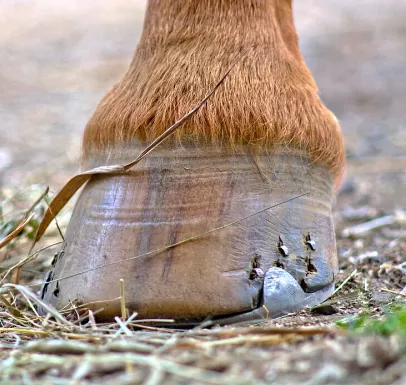
But less brutal solutions are also available now:
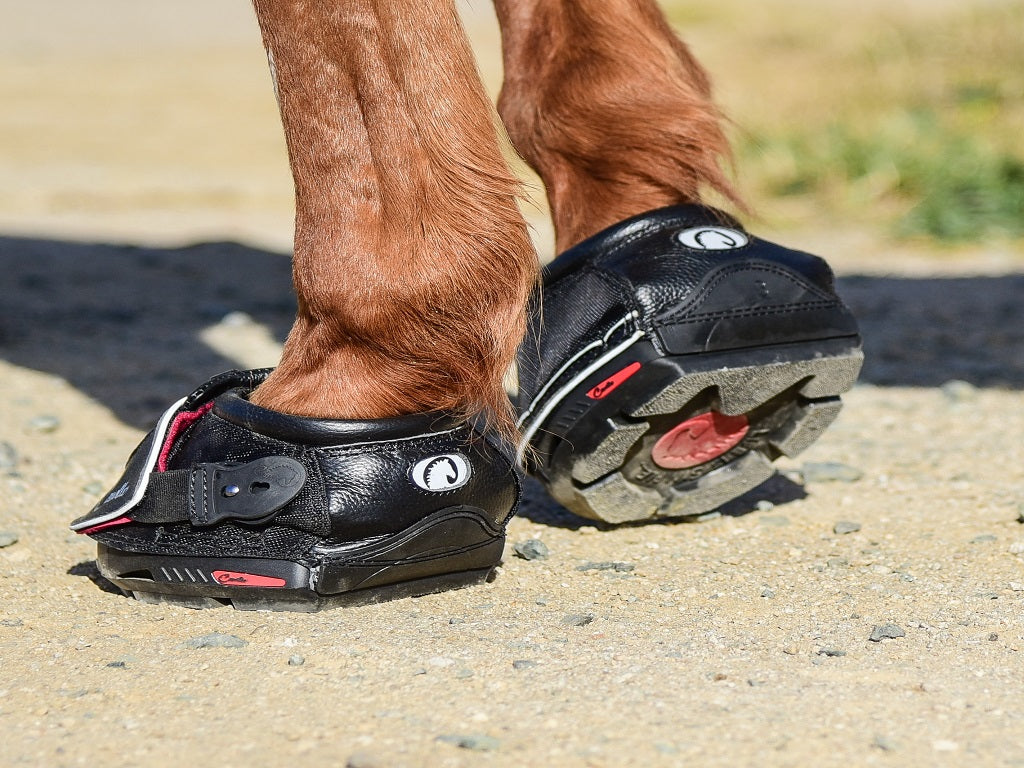
knives have v which is in in russian, so that click tells the piercing of skin
knot has t, which could be to, whihc tells that knot adjusts ropes to trees and such
but what is kn in knot? probably of know (you have to know hte the knot)
knee (по форме кости, похожей на копыто? patella(kneecap)patella reminds horsehoof)


And a good reminder to keep your
kneecaps further from horsehooves:
In this context we naturally want to know where do they nail the horse shoes.
And here is the answer:

But less brutal solutions are also available now:

...Burt,
as usual, I got distracted
knit is of knot. kn is a different n.
it is in the orthography because it has semantic
elements.
k as ideogram. k in know and knee is to distinguish words from now and nee(no) and it doesn't change the word on a phonetic side, only in graphic and semantics, thus it is an ideogram.
k as ideogram. k in know and knee is to distinguish words from now and nee(no) and it doesn't change the word on a phonetic side, only in graphic and semantics, thus it is an ideogram.
kneel is of knee
knock has that click of пришла толпа щелкунчиков и щёлкнула тебе в ебло.
knob is probably where to knock, and b is probably обитель, בַּיִת
knock has that click of пришла толпа щелкунчиков и щёлкнула тебе в ебло.
knob is probably where to knock, and b is probably обитель, בַּיִת
knave is the only kn word I knew, and
probably he is inside, hence v, and he probably
knocks, knot cuts
but maybe he just may as mwell
cockney doesn't count, because k and n are of different
morphemes, but what if it's co-knew and additional c is in
there just to troll the nobles or humiliate the blebs plebs, because the dialects
are indeed mutually intelligible.
At first I was like oh wow, they don't care about the phonettic matter at all,
but then I was like oh, okay, I can see what they see, d~c is that deep, and if длать~кhand длань~

but then כף is a tablespoon, not hand, which is yad, and thus could be the perfect d, considering how berbers name the letter ⴷ, literally yad( יָד) And because hand usually picks thing from below, I can see how they drew hand as ⴷ[d]
And and but are like a and b (and it makes me love the and.. but.. construction very much)
are those short words alphabetic. Let's assign and to be the semantic part of a, and but to be such of b,
see what comes out of this assumption
(letters naturally were short words, even if not assigned as such by the inventor,
seen like that by public)
So my task is to find those words, and I am optimistic about the outcome, because words that basal must be rather universal, at least amongst the indo-european canon, and yes I dare to claim that whites invent almost everything, at least almost everything in the european culture to which alphabets belong.
(letters naturally were short words, even if not assigned as such by the inventor,
seen like that by public)
So my task is to find those words, and I am optimistic about the outcome, because words that basal must be rather universal, at least amongst the indo-european canon, and yes I dare to claim that whites invent almost everything, at least almost everything in the european culture to which alphabets belong.

That is very nice of them to colloect these sister shapes, but I was hoping to find them there
them ~ there
him ~ here
but that doesn't have such a pair, unless
it is hat or head in some weird semantic play
those are hose? hat and hose can identify him, but I dunno, it seems way too weird.
those are hose? hat and hose can identify him, but I dunno, it seems way too weird.
Now I must keep that kn as lingual click somewhere,
and the meanings of other components of kn-words,
for they probably reveal the meaning behind other morphemes
as I did, copypasting that chapter into abcdefghijklmnopqrstuvwxyz and seeing what I could take of it.
and the further question:
is knight the one to whom you have to
knock before entering or the one who knocks
but nah, that kn of him is most probably of конь (but and that may indicate that domestication of horses happened amongst slavs before it was adopted by the ancestors of the brits)
but nah, that kn of him is most probably of конь (but and that may indicate that domestication of horses happened amongst slavs before it was adopted by the ancestors of the brits)
показывал ~ показал что значит ыва? было. показал is short and feels more like "just now" in comparios
comparison to показывал, which feels like something having been happening in some further past
бывал~был
бивал~бил so the suffix is not ыва but ва, which is probably the same wa of was.
пивал~пил
but бывать и быть оба в неастоящем времени, so wa ва is probably вообще, but no-ва is in a moment
т настоящее время
л прошедшее время
(будущее в русском при помощи приставки образуется. можно использовать суффикс прошедшего времени с приставкой будущего? получится перфект тегнс:
бьёт настоящвремя
убьёт будущвремя
убить может быть императивом, который нередко формой будущего времени выражается
(also will)
убил прошедшее время, и суффикс который я счёл марекр ером
будущего времени не помогубил ~ bad will? сравни с угодил!
укусил ~ will of кусь? will~был? will~вёл! велел! but then that extra л is д in english, or т, or n
усмирил ~ смирны will (will stay smirny)
был и быть напоминают will & wit
бил = 'бил (краткая форма слова убил? ведь у такой частый суффикс, и теперь я узрел, что он когната суффикса 've в английском перфекте.
вёл = краткая форма слова увёл? или вёл это тот самый will и есть, и тогда могут быть особые
правила
сбил здесь приставка когната английской 's которое has.сбил ~ избил? потому что другим 's является is
спал и проспал отличаются наличием приставки у формы подобной перфекту
(лень переводить, русская филология, уай
ууд ай кэр)
р is vowel in spelling of care as кэр
in english re is reaв ф read as a, for it is are
is re in care even are? c is what?
Should I compare care and bear? Does spelling metter? Not more than how it is read.
u v w x z don't play this game either,
thus this abetka is ancient, at least archaic, when latin
alphabet ended with t or v, the time of early contact with
norsk people, I guess, because bornholm's alphabet is even
more archaic by its looks and structure, and it ends with
V, which is Υ in greek)р is vowel in spelling of care as кэр
in english re is reaв ф read as a, for it is are
is re in care even are? c is what?
Should I compare care and bear? Does spelling metter? Not more than how it is read.
are
bare bear bore bear beer
care
dare
ere
fare fair
gear
hear hair hare
Ire
lear lore lure
mere
near
ore or
pair poor pour pear pare
rare
sore
tear
year
j, k and q don't play this game (no wonder: italians have no j or k, greeks don't have q)
bare bear bore bear beer
care
dare
ere
fare fair
gear
hear hair hare
Ire
lear lore lure
mere
near
ore or
pair poor pour pear pare
rare
sore
tear
year
j, k and q don't play this game (no wonder: italians have no j or k, greeks don't have q)
русское слово кнут: щёлкает, и начинается с kn
но не knot, но кнут плетёный же, так что скорей всего когната слова knot. Возможно верёвки плели в первую очередь чтоб скотину щелкать? Как я этимологизировал knot? haha, I didn't, I just linked t to to. And if knot is knut, then it explains kn, but not t. To, to send the animal in the needed direction by whipping it from the other side, or, rather, not whipping, hitting it with a whip. once maybe
БВ СТ is acturally how B T go on placing fricative form of Б after Б and fricative form of T before T, thus keeping B and T Beginning and enT
Be G и on
Was G N the division of D tht the T?
BeGиН is the first two (or three if the H is N, as it is in the beginning of the line) lines
END is ENT if it is also alphabetic, and then ..I don't remember what. Maybe that T is the last letter, which is symbolic. As in russian КоНеЦ: alphabetic, from the second half and on,
но слово начало в эти игры не играет. почин~begin, but почин also looks more like почил. починил.
БВ СТ also reminds BCD and БВГД
If I had ai able to find all manuscripts beginning with 𓃀, we could find some abecedary.
Or we could ask it find all texts without logographs or with the least ammount of those.
Победить ~ попятить (ахилесова пята ~ бяда)
ABC is all there was, and maybe even B and T was all there was. But let's begin with BCD as three points of articulation:
Thus палка~битка (маленькая бита, да и ка в палка является уменьшительно-ласкательным суффиксом) булка~палка? но ведь нас не смущает выражение палка колбасы.
будка ~ палка? бить~будить? когда будят бьют? будка означает собаку, собака будит лаем при появлении воров? будка~barker? it is a very raw approach, but I suspect it to be the most powerful approach of them all. Recomprehending all the lexical corpus in the sense of just two consonants. Uъ!
Apollo is an alphabetic name, but because his priests are caught reforming alphabet, they couldn't be in the beginning of it. Their ancestors could be, hence the alphabetic name. But it depends on who you call ancestors. My guess is A P L were the new flashy letters, П & Л? L & П, they;'re not too far apart. Could that be A P L O? A P O L L O are four new letters? Were they using eiu gamut before Apollo? Apollo is famous for being a masterful musician, and all a p o and l sound good, unlike some щ or ц
уфхц is directly voiceless fricative abcd, so russian was not brought from greece: greek order is ΥΦΧΨΩ which is further from abcd, though αβγδ is closert to the abgd the abcd used to be.
γδ are two ways (even and excentric) to write the same loop g is both g and д
And the bd symmetry tells us that they were бg and that is why handwriting is cursive, as if it curses.
ive is more archaic form of suffix ing? suggestive is suggesting, passive is passing, massive is massing
ли?
And her e I see that this finding of
mine, что эта находка моя переносить строку вот так не во
всех браузерах отображаетс якоректно.APOL? APPLE! ALMA? ALPA?
APPLEon Napoleon? Snake Myth In Bible? Brits?
で (in) deFR [de]
(it links of and во, but I thought оf is от. of is the opposite of во, just as от is the opposite of до)
but on is на
он ~ in (він)
она ~ на
sex matters in sex: він is in (in her)
вона is на (на нём)
ё is in female pronoun in english and in male pronoun of russian (на нём, но на ней, но есть и другие местоимения: её, но его)
в in вин is вав, because in russian this word is он (but в looks like B and not V, btu then it is what russian v lool looks like
is ב the ו? they are one avoe above the other, they ew well may be
Looking at how в looks like кулак, but it's probably 𓃀
is khrustchev's boot our churchill's
victory sign?
But then в is naturally 𓃀𓃀, so lu
plurar plural Бб[b] is Вв[v]Suddenly I realized that they used skin of larger humans to do their close, so skin of legs was not only pants, but boots probably the first.
if B and T are all there were in the beginning, the бg and seeing that bad goes down and good goes up in this representation is written counterclockwise, because luck doesn't play a role here, that it is a struggle, and good overcomes, which is great (life is complex, and good is always overcomes somewhere, and that is where attention should be aimed at) It also predicts the return process inevitable in the future, so maybe some measures should be taken to leave a pillow at that spot to soften the impact of the future decline in that area. And when you can see that the darkest hour is before the sunrise: when they all aligned at the bad moment, they're going to turn good almost at once. And that will be the golden time. Isn't it just a speculation? Surely it is.
if B and T are all there were in the beginngin, mother and father were both Bother. оба родителя
(кто беспокоится те и родители)
Btothet (brother)Tittet (sister)
Bto-ttet
Ti-ttet
interesting, why would brother have labial b and sister had all linguals? sis is tit is a good find from today's red folder's улов haul
hold is hauled
I suspedft suspect the manner I acqur cqu c acquired, to jump from left to right, is what keeps this html from lagging: the div's are short, I don't pull the same div all the page through.
Челябинск Челубейск *(Челом бьёт? Человеков убивает? Человек? (другеи жевотныи челом царю бить не умеют)*)
talk ~ tatt ~ chat!
шоканутый (шуганутый)
шокануть (шугануть)
aloof ~ sall off
A B C
A B D
Bi Di (be and die)
Be De (sheep and devil)
Ba Da (Ma and Da)
Bo Do (My and Thy)
Bu Do (boo and do)
It was my first associations just after I got high first for four day.
Good morning, sunshine, I didn't touch you for those very four days, I practiced for 10.5 pages in the fidfths the firs... argh fifth the third the last of the rhythm of big city. You can examine it and fine df fine find it rather shallow.
I'm s s s a human, I am supposed to behave like this. I am supposed o to misp e have (haive? hive!)
My poor po rp pronouncian pronuns pronunciation show s in text, hypertrophized enormously.
's in english verbs are probably 'ся in russian.
You pronounce pronouns (and I didn't expect it to be the exact homonyms)
You verbalize verbs
You ma a name m m names.
My subconsciousneess seems to tell itself I as I offered it to.
But can I go autoamatic in that subconscious manner?
jлубщцрукщжыубю
I like луб and рук but what is the other chaos. Maybe that , chaos, noise.
I repeated уб
let's try anotherr line:
iels./уцушщьтавдэывлуждоузы
yells seems to be appearing in the beginning of both lines. many e у's but no уб's
This time I aske d my mind not to intervene by pushing it, and as a result nio mind , not a single word like рук... maybe I typed in wrong layout?
Both times I jumped from lating for yell ttioo russian layout, caps was in my reach, but both times I typed in the sayme manner. around yell.
ke,owhero;se,. is лубщцрукщжыубю written in lantin layout, but I like луб рук more.
шуды is iels ю\
///// is in english layout, russians have to push shit at their \
so iels./ is шудыю. шудрою, very funny. судиёю is another reading, and I suspect jews to be considered shudras in india, also because they consider all foreigners leessss than shudras, so I read
or heard
eweiomnfdl'sdke;loeps is уцушщьтавдэывлуждоузы in latin layout. And it is obvious that both chaotic atutomatic layouts are chaotic. So рук is nice, as if subconsicious managed to express enough message, to tell, hands thake over, I am not doint ghtat. And maybe it is good, it is a peaceful mode, I like it, well try to deliver the godd attitude too. godd is good.
well =we'll (I can easily see a spell understood by both readings)
we;ll ~ валим, делаем. в~д? what a word world wout would that be.
валим ~ будем, эту мысль я хотл записать ан е ту.
Но раз мысль была осмывсленней в первый раз, давай тот уровень абстаракции попробуем, который от наз ждли в начаел, не тот котороый я изменил.
валдыулвбдыцэду much better
влдцюубчшшаолудф and once again two lines is too beaucoup
dklw.e,xiiajkela and once again the other layout dalso doesn't make sense.
And валдыулвбдыцэду id is fgkldrkf,lde'lr
also makes sense: fag, kill der kopf, ldeotr but is that cahaos reinterpreted by me or are they annoyance of the subconsciousnesss? I fetl bad above navel. saaAss if new placenta wants tgo grow, but actually I must drink. !!!!!
And I am terribly sorry. I will make automatic writing no more. Please forgeive me and let's communicate more or rather less, if taht what you wanted to say. I can see that you woulnd't want synapses between unrelated areas. So I pulled my body on a п-like wall I built, onlty that п has no corners, so it is more n than n. for both sidea sr are round. So I layed on that wall of about a metre high and pulled my sides apart tenderly by rolling by backl over (for my connection felt in the belly, not the back, so I pulled it in the belly,. and now my bact tell mes to to goo tooooo (and iI layed with my belly on that wall, and I mostly felt something not natsty actually, it was quite nice in the lower part of the back, around the seating part, buit I thought of it as of my reproductive organs.
Wom Sometimes I
woman ~ самка (w ~ ш ~ Σ ~ Ϲ) so because it would be weird to connect an and ка into some ing, I suspect an in man to be plural suffixs, and the ka ~ c[k] ~ с[s]
but sumki samki is plural, not samka.
Самка таскала сумку, а белый рыцарь её защищал (щитом, и если надго, мечом. потому и герб был на щите, чтоб знал на кого полез, но можно и мечом)
мужик ~ мечник
муж ~ меч
муж ~ мощь
man ~ might
ght ~ n? no:
laughter ~ launer? laude.. but not exactly, lauder is to praise. laud is english word of latin probably origin.
lachenNL rireFR смеятьсяRU
ch, not un, ch is much close
female is nowhere near purse or .. but puss is not far from purse. bag, hag. Man, самки сумки. сучки. течки. случки.
chainmail. I think I thought of that females were chainmail, or maybe not in these wording. Wait a sec..
the direct quote from vol.25:
Interesting and
natural that earth is B, female. And the sky is J, male,
mail. female~fu_mail(без_кольчуги) ?
male ~ mail (самец~кольчуга? в принципе, мужчине кольчуба больше к лицу, но этимология ли это? едва ли, но всё может быть)
male ~ mail (самец~кольчуга? в принципе, мужчине кольчуба больше к лицу, но этимология ли это? едва ли, но всё может быть)
So did I get dumber or what. Honestly I s.. drank few shots of cognac to cure myself. I think I should keep on d.. smoking, for drinking is too hard on my. on me.
nio, not Hennesy
Go to do something. Drunk. Not drunk, but yes I did put alcohol into my tea.
The next morning:
There's a hole in the soul that was filled with dope, and we're feeling fine!
(thinking of how I must smoke for otherwise I allow me to drink alcohol, how my brother has to drink alcohol to substitute heroin addiction, as I smoked salvia those 18 months I didn't smoke weed to help my brother overcome his addiction (we made a bet that weed is not a drug, because it doesn't have addiction, so his pride, I guess, made him not to be the worst faggot in the family he probably thought I was and here I am a krasavchik and I started finishing the concrete box they sell as apartments.
box ~ boocks? my guess is boocs show rolls, so.. did those rolls lay in boxes? )
Look how vowels make the picture with hole in the deepest point, and soul is not far, soul is deep. Yes, a rabbithole for sure as they say today after a writer, we know some woords originating in authors, robots Karel Čapek himself did not coin the word. He wrote a short letter in reference to an etymology in the Oxford English Dictionary in which he named his brother, the painter and writer Josef Čapek, as its actual originator.[6] and rabbithole rabbit + hole. Extended senses reference Alice's Adventures in Wonderland, where Alice travels down a rabbit hole into a bizarre world.
while there's, a, the and that are neutral as a middle point, as a æ
And æ does look like those halves of ࿊ and doesn't expect reincarnations, it goes clockwise to go out counterclockwise: you go up the kill hill to go down the hill. wwe it eat only to be eaten?
I wish I don't take these thoughsts (on от
слова sought, thought~sought
thust sink seek is think, and sink is to delve into the depth of one's mind)
thust sink seek is think, and sink is to delve into the depth of one's mind)
see от слова ctqxf сейчс сейчас (что ты видишь, сейчас (помнишь прошлое) видеть можно и будущее, представлять, воображать, соображать, образ будущего)
образ будущего, 654 000 results
образ прошлого, 24 900 results
образ настоящего, 60 300 results
So probably this is how predictive model of gpt works: by predicting what word comes next they build the model of reality we humans use, so they are technically human. by culture, as negros are considered humans evern when theuy have very littel of what we consider whoman culture.
is human and woman different readings of the same whoman into heman and шиман
(different readings of h? w is female reading ш is female reading. Гребень! Гребень как индигатив женщиныюю
Ш I think I found new way to mark typos: make some meore obvious typo atfter that.
Then I may not paint
I O I (руку here it
wouldn't work)Ш (she, shi, шить.. я помню русское шить похоже что происходит от китайского или японского ши, нить или шить ли)
线[Xiàn(ще̃)]CH нитка (thread)
线=線 (one is modern, the other is traditional. Japanese only know 線)
線[せん(сен)]JA нитка (thread)
With time, by some cosmic irony, chinese will look as if it derives from japanese, which I think is true.
I don't believe it, I think so,
which is maybe, maybe not.
While belief is fo shu.
But those two can be distinguished differently:
thinking is on some basis, believing is mostly blind.
which is maybe, maybe not.
While belief is fo shu.
But those two can be distinguished differently:
thinking is on some basis, believing is mostly blind.
So, back to that line, That Was Filled With Dope. Dope is deep, Filled is to the top. With is of that top feeling, wile while alone is down. See how vowels colour the langhuage!
gh is dirty to russian and to european in general year.
fine is higher thatn deep? higher than feel? deep as a feeling, why are they so high in vowels? So at least sometimes this roule doesn't work, but it can be used as.. or does it always work? feel fine, be high
deep.. does it have low p? is a deep person is an advantage, thus it is good to be deep. deep pond is better than shallow лужа puddle (can you believe it, I never knew this workd. I think higher. I don't think of shit, it is good, but funny that shit is also fo of high i (was it a sacreligious word? was it shoot? shoot makes sense. холостой и боевой (как обезьяны кидались говном до создания культуры?!!!)))
до создани языка не было кульутры выше той что у зверья
I think it's normal to readuce shit to shut. Означало это слово прохудившийся мешок? Т.о. shut (заткни) означало shit (сыпется (зерно сыпется, мешок сыпет))
заткнул, закту заткнут, заткну, затыкаю тоже shut
Суффиксы прилипшие местоимения и прочие слова. Префиксы тоже. От простогог к сложному.
и этот префикс за неизменный гооврит что shut это зат (зад is shit (как магазин продающий мясо называется мясо (в совке так называлось всё хлеб, молоко, соки-воды по they-live-ian они-живут-ски)))
молоко и мясо всегда в отдельных магазинах продавались.
кошегно

(Belarus is a special case, modern condition of it may say that it was the centre of soviet experiment, but milk and meat was sold separately in all the soviet union, maybe except some village shops, but then why would they sell milk in villages, they had only one shop, so I didn't live in soviet village, so cannot remember how it was there, if they sold milk and meat there or not. I suspect you couldn't buy meat in village shop in soviet times. But I am biased and maybe I will explore this question asking some old village peopl)
The final word is universitet, the first word is ווייסרוסישער (weiss russishar, it's yiddish, mostly deutsch)
white and wise are the same (or similar) word on many levels (in different languages)
in english wise and german weis Weiß (Weiße) for one.
In german wise is weise, so whether there is one or two s's tells if that is white or wise. s double t!!!
But no! t is double s! according to
weisse being white.
א in the beginnign of universitet is telling that ו is vowel. Yiddish being closer to the live tradition has more realistic take on vowels:
and where I found it had more:

so sofits were not used for numerals, they show how they could make bigger numbers with less letters.
four being the maximal singular numeral in hundreds (hundreds show combinatorial approach) reminds me of 4 being the V in the protoroman numeral system, of IVXLCD adding up to 365
was it taken as the year goes in spiral by 5 degrees higher each time? that would explain the leap luft

Belarus is maximum wtf:

BSRR is Białoruskiej Socjalistycznej Republiki Radzieckiej (belorussian socialist republic soviet republic)
на еврейском вайсруссландише социалистише ратнрепублике (ратн как ратный подвиг? это еврейское словцо?)
redden?
справа то же на польском (the BSRR is polish, huh)в Беларуси в 1920-30-е годы (вплоть до 1936) было четыре (!) государственных языка. В освобожденном от польской оккупации Минске 31 июля 1920 г. принимается Декларация о провозглашении независимости Советской Социалистической Республики Белоруссия (с декабря 1922 г. - БССР). В Декларации регламентировалось равноправие четырех государственных языков в БССР - белорусского, русского, польского и еврейского (идиш).
Хотя на гербе четыре языка, в качестве государственных использовались лишь два, на которых все и печаталось - идиш и белорусский.
в Белорусской СССР до 1937 года, наравне с белорусским, государственным языком был идиш
and I didn't find shi for шить or нить, which is very strange. I think I mentioned it to be the case, but it was what, was it?
those two words robot and rabbithole are so similar! is it soem rob time?
what other words are so recent we still remember who invwented them?
Did I mention that arrow could be derived from a fallen branch of a fir or some other tree, mostly they all growwith branches at that angle or at least they all grow in an angle looking this way.
And I knewq I was right: - конец сломанной ветки (в месте перемещения), как правило, направлен в сторону противоположную движению
I knew it because of how ↑ looks, how ᛏ and especially ᛦ look. Both are the opposite of ᛘ and ᛉ
But if ᛘ and ᛉ show a man's body. I think some prominent figure in runology, I think von List, identified runes with body's postures, I think I even mirror it in this thing, but this thing became so big, I cannot tell what is what when I do not work with it at the moment or at all.
Удивительно что искусственная кожа и курение вошли в женскую моду одновременно.
Курение словно было psy-op of leather makers.
Fake leather doesn't worsen in rain, but it fears fire much more than natural leather.


and then some other point of view:

I don't know why they're in egyptian costumes, and they sell this image so I cannot bother to pay them even eight bucks, because I don't pay to those who give them in better availability. This one I can barely read, I need some good ai to read it, it's beyond my ..connect your ?mouth? with your index finger and your thumb, but the rest is beyond me. The larger letters I can read. Good enough, others don't give that at all, and the shapes, the three images all agree or disagree about how runes are shown with the body. Whethere (WereThere?) there were several traditions (see gesture language of the deaf)
Interesting, all three agree on ᛋ, which makes it clear, that S is not only aSs but Sit as well. Stay. St
I give equal hommage of hyperlink to all of them. The image providers they are.
Interesting how the third image gives different poses for the same runes. And they have 15 runes and in very peculiar order.
ieoua they go. I know this order. They definitely know something, and egyptian costumes could be a decoy. и blende сф camouflage
M and S follow the vowels.
Three aettir they know. What is the F in there? It is separated by a vertical bar. Is in in the other aet?
It would make it 7 per aet. or 5 in some
of them, because two runes repeat.
Listen, I want to buy that poster, I want to buy that course.
Or rather I want to read it. I doubt I can buy from nazi russia in late 2023.
Listen, I want to buy that poster, I want to buy that course.
Or rather I want to read it. I doubt I can buy from nazi russia in late 2023.
Some more images to close it for today

and hand gestures next to them the ones above and below are of von List, which you can see by that Z
of his, which is G

and more hand gestures:

This image mostly agrees with the one above it, but only mostly, some gestures are different,
so whether there are different traditions, or they all make this stuff up, but because most of shapes agree, see the ᛚ, for example, I suspect a tradition in this. even multiple of or a complex one.
Looking for those shapes I found something else:

If it is legit I have no idea, but it has some new ideas. Two aettirs of icelandic runes, some shapes unknown to me, So what I recognize as ᛍ reminds me of Ⱄ and the idea of some connection between norsk runes and glagolitic script should have come to me sooner, copnsdisdering the geographic proximity and that Ⰰ often doesn't have such long sleeves and then it looks pretty much like ᚐ the ᛆ
Ⰰ ᛆ (ᛦ? ᛣ? (A~Я~R?))
ᛒ Ⰲ
ᚦ Ⰴ If these two are true, then glagolitic text was in lines and runes went in columns from top to bottom, but I think runes went from bottom up. Then they were looking the other way. Or maybe not, Now I can see that I should look at runes otherwise: the belly of ᚦ is the belly of Ⰴ (you should you use sc square not square but ru round font to see that the belly of Ⰴ is upwards, thus.. runes going from bottom up would look like glagolitic going from right to left, which is not supposed to be so, glagolitic is known to onl ygo left to right.
eh, complicated, but good idea to compare the two. But the other further attempt only rarely delivered, such as Ⱁ trminf reminding ᚮ, not they're not the same system the
ᚠᚡᚢᚣᚤᚥᚦᚧᚨᚩᚪᚫᚬᚭᚮᚯᚰᚱᚲᚳᚴᚵᚶᚷᚸᚹᚺᚻᚼᚽᚾᚿᛀᛁᛂᛃᛄᛅᛆᛇᛈᛉᛊᛋᛌᛍᛎᛏᛐᛑᛒᛓᛔᛕᛖᛗᛘᛙᛚᛛᛜᛝᛞᛟᛠᛡᛢᛣᛤᛥᛦᛧᛨᛩᛪ᛫᛬᛭ᛮᛯᛰᛱᛲᛳᛴᛵᛶᛷᛸ
and
ⰀⰁⰂⰃⰄⰅⰆⰇⰈⰉⰊⰋⰌⰍⰎⰏⰐⰑⰒⰓⰔⰕⰖⰗⰘⰙⰚⰛⰜⰝⰞⰟⰠⰡⰢⰣⰤⰥⰦⰧⰨⰩⰪⰫⰬⰭⰮ
ᛦ finishes what they call younger futhark, but not in what they call older futhark
Whatever is
the final in icelandic is doesn't seem to be in unicode
yet
But how dare I use as a scientific source something that containse dwarf runes!
Well, the other part is legit, so
whatever man.
Can I be suire of icelandic though?
I will place it tio the maybe deoartnebt.
It's not even tolkien, it seems that
fucker was not the only faggot shitiing in the filed.Can I be suire of icelandic though?
I will place it tio the maybe deoartnebt.
Some powerful information on runic magic in russian:
http://web.archive.org/web/20150609003924/http://www.sait-o-runah.ru/katalog-run-runa-fexu/
The girl writes well and she seems to know what she is talking about.

classical and mediaeval : Fosbroke, Thomas Dudley, 1770-1842
and some words it uses are quite legit, because they deliver some valid finds:
The Irish language (Gaelic) is also called Gaoileag, Gaoidhleag and Goidhealg. Its alphabet of 18 letters is Aibghitir, Aibidil, Aibchitir or Abchitir. Older alphabets had the letters in a different order, and those were called Beith-Luis-Nion (for b l n), Bobeloth (for b l) and Bobelloth.
I know this rabbithole must have its limit, but it feels like this rabbithole is never gonna end.
It's like there is a finite ammount of
humans, but
a) I will never meet them all and
b) they keep on coming
a) I will never meet them all and
b) they keep on coming
fun ~ fucking (probably fun is as much an euphemism of fuck as funk is)
I just woke up with a vision of a card game being played with letters instead of cards. Which makes me wonder if the 2 3 4 5 6 7 8 9 10 J D K A were the letters. And if those 13 the dirty dozen of some previous epoch.
Cognatism of the basal lexics of Latin and Russian make me ask if slavic languages are actually roman.
All those mini, tibi, and especially grammatic coherence of est and sunt (есть и суть) and even ego is io which is not far from Ѧ the Я
(yes, language families are false concept, because languages are not branches but clouds, but it doesn't mean I cannot theorize within that false concept, because it is naturally only partially false)
well, those two are pure ideas of an early morning, to keep them coming I have to get high.
Good Morning
360 has 24 divisors: 1 2 3 4 5 6 8 9 10 12 15 18 20 24 30 36 40 45 60 72 90 120 180 360
I wonder if it is somehow linked to 24 hours
100 has 9 divisors: 1 2 4 5 10 20 25 50 100 (and this time I wonder a little less, but is it?)
60 has 12 divisors: 1 2 3 4 5 6 10 12 15 20 30 60
The video from which I took this numbers speculates that 60 is 12 knuckles times 5 fingers.
рідкий ~ жидкий (another example of R being Ж)
рідина ~ жидкость (не родина! потрясающий язык)
A K D J remind me of the eastern abecedaries. And where are labials? daMe? Page?
What language? Try latin:
In fasciculis chartarum hodiernis sunt quattuor familiae: corda (♥), rhombuli (♦), spicula (♠), trifolia (♣), et in quaque familia rex, regina, eques, decas (10), enneas (9), ogdas (8), heptas (7), senio (6), pentas (5), quaternio (4), trias (3), dyas (2), monas.[4] Rex valet numerum 13, regina 12, eques 11 et monas sive 1 sive 14.
In today's decks of cards there are four families: hearts (♥), diamonds (♦), spades (♠), clubs (♣), and in each family a king, queen, knight, deuces (10), queens (9), diamonds ( 8), heptas (7), senio (6), pentas (5), quaternio (4), trias (3), dyas (2), monas.[4] The king is worth the number 13, the queen 12, the knight 11 and the knights either 1 or 14.
Rex Regina, are the same initial, how would they mark it on cards. Cards were without letters. Were cards letters? Roi Queen? Queen Rex S T
we were talking.. latin numerals are cognatic of to russian numerals
light~light
светлый~слабый (слабый окрас полупрозрачен и потому светл)
слб сила бога
га в бога есть сувфикс жья
слн сила нага?
слон силён русский язык ..слово сильно произошло оттуда где видели слонов. Мамонтов! Мы видели мамонтов. Скорей всего про них рассказывали детям отцы из уст в уста про древние дела, раз люди охотились на мамонтов пока всех не сожрали.
словом слабым (лёъкие наказания, light is of word and not of fury, word not ford, wise not nice vice)
силой сильным (or nice not vice (it is about ν~v))
ᚠᚡᚢᚣᚤᚥᚦᚧᚨᚩᚪᚫᚬᚭᚮᚯᚰᚱᚲᚳᚴᚵᚶᚷᚸᚹᚺᚻᚼᚽᚾᚿᛀᛁᛂᛃᛄᛅᛆᛇᛈᛉᛊᛋᛌᛍᛎᛏᛐᛑᛒᛓᛔᛕᛖᛗᛘᛙᛚᛛᛜᛝᛞᛟᛠᛡᛢᛣᛤᛥᛦᛧᛨᛩᛪ᛫᛬᛭ᛮᛯᛰᛱᛲᛳᛴᛵᛶᛷᛸ
where black runes are those which are attributed to both elder and younger futhark, and they're 15
legendary 15
seeing that awkward can be translated as жопа, I wondered if
it is the literall meaning, and it is:and here what I noticed the other day: б is displayed differently in makedonian fonts:

and we russians write it exactly like that in our cursive school copybooks
Makedonian dispute tells me that Northern Makedonia is the true Makedonia. Also because the movie secret book is filmed by their cool guy. And because Greek History is taught across the world instead of Makedonian history, so I take it for imperial propaganda, but considering Alexander of Macedon, I would expect it to be the other way around. Or was Alexander just a puppet of disciples of 30 tyrants.
Did he conquer those territories because he was backed up by greece? So that greeks could establish their culture on those territories? To teach those retards how to build everything? Or were they just taught that? Nah, I don't nah, maybe it just me was taught so bad.
Or both are makedonia, it's just that historic territory belongs to different states now. And being of slavic (for the lack of better word. Rusins could be good, if moscovies didn't usurp it. But then I doubt some czechs would like such rebranding. So wouldn't it be better to forget the concept of language families together with the theory of the language tree and the concept of language from historic perspective, for like liquids our clouds mix with time, and in sufficient ammount of time they're all complex branches(?!) of the same flow of culture, with elements of the languages, and of elements should we speak.
a flashback from 30th volume:
 I don't think if I noticed
there that that ^ is s.
I don't think if I noticed
there that that ^ is s.and that it goes from the bottom up, like
runes did.
ᚲ is it?
С is russian S
C russian S? Ost: PRoSTo?ᚲ is it?
С is russian S
в этой пр in that fart-like pr and ссать-like st
Imagine cards of different letters:
A B C D E F G H I J K L M N O P Q R S T U V W X Y Z
Α Β Γ Δ Ε Ζ Η Θ Ι Κ Λ Μ Ν Ξ Ο Π Ρ Σ Τ Υ Φ Χ Ψ Ω (interesting how I mistyped extra before х's)
А Б В Г Д Е Ё Ж З И Й К Л М Н О П Р С Т У Ф Х Ц Ч Ш Щ Ъ Ы Ь Э Ю Я
Let's find unique simbols immediately giving up the nationality:
Б Д Ё Ж З И Й Л У Ц Ч Ш Щ Ъ Ы Ь Э Ю Я to my surprise russian has many unique simbols, but let's remove those who remind greek:
Б Ж Ц Ч Ш Щ Ъ Ы Ь Э Ю Я and we got 12 (Д ~ Δ, Ё~E, З~ʒ, И~H, Л~Λ, У~y)
Γ Δ Θ Λ Ξ Σ Φ Ψ Ω even leaving letters common with russian, we only get 9
D F G J Q R S U V also 9, interesting. Because if we unite Ш&Щ and ЪЫЬ into single characters, 9
Б Ж Ц Ч Ш Ь Э Ю Я
Could these be 2 to 10 of the playing cards?
Б Ж Ц Ч Ш Ь Э Ю Я
Γ Δ Θ Λ Ξ Σ Φ Ψ Ω
D F G J Q R S U V
what is the fourth "suit"? (national costume? suits do stand for different kingdoms, thus four kings, four аса! бога в норманском, значит меж игральными картамми и рунами есть связь. 9 как 18 песен одина, 9 рун по три у каждой норны (и их перевёрнутые представления))
Давай найдём эти прямы и перевёрнутые пары:
ᛆ
ᚿ
ᚠ
ᚮ
ᛘ
ᛦ
ᛁ
ᛂ
ᚴ
ᚵ
As you can see, only three pairs I can easily find, and two pairs can be the pure and dotted variants.
And what to do with the other ᛒᚦᚼᛚᚱᛋᛏᚢ I have little idea. But then I recall that ᛏ is ᛐ, and it let's me go not for ᛑ, but for ᛚ as the reverse form. But isn't it not reverse form? Because ᛒ is ᛒ even when it looks the other way, as in Bureus's codex.
Is ᚱ pair to ᚢ? I need to read that site link to which I gave yesterday to know the meaning runes are often attributed. That lady obviously made some research.
Well then we only have ᛒᚦᚼᛋ left, and obviously they pair up as ᛒᚦ, and ᚼᛋ are together because they are the only two left, and also ᛋ is named similar to sun, sol is one of the names, as far as I remember, and ᚼ looks like sun, but then is ᛋ strike of the same light? Could be the dark side of the sun, a ray of wrath.
So were runes yin-yang principle repeated nine times? Nighn or Eight if we'd work with 16 of younger futhark (or even with 15 containing one unpaired rune. And I think Bureus did work in reflections, let's base it upon him:


But he mirrors only four pairs, even though in other table of his ᛌ the ᛋ mirrors ᛧ the ᛦ...
oh, no, my bad, it doesn't, he doesn't
list ᛦ

a б
Е З
И N
O
абезино?
обезьяна?
обязана?
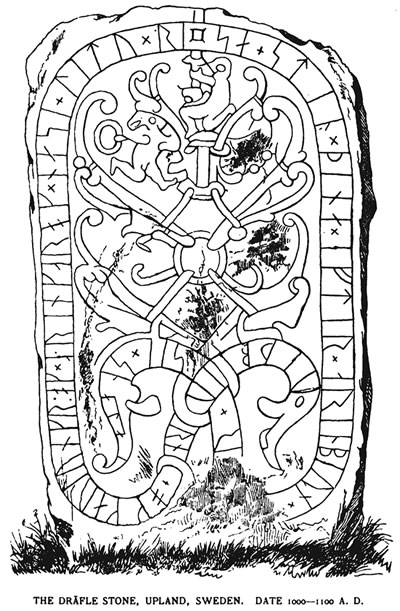
%20MS.%20Fa%2021,%20Royal%20Library,%20Stockholm_OCR.jpg)
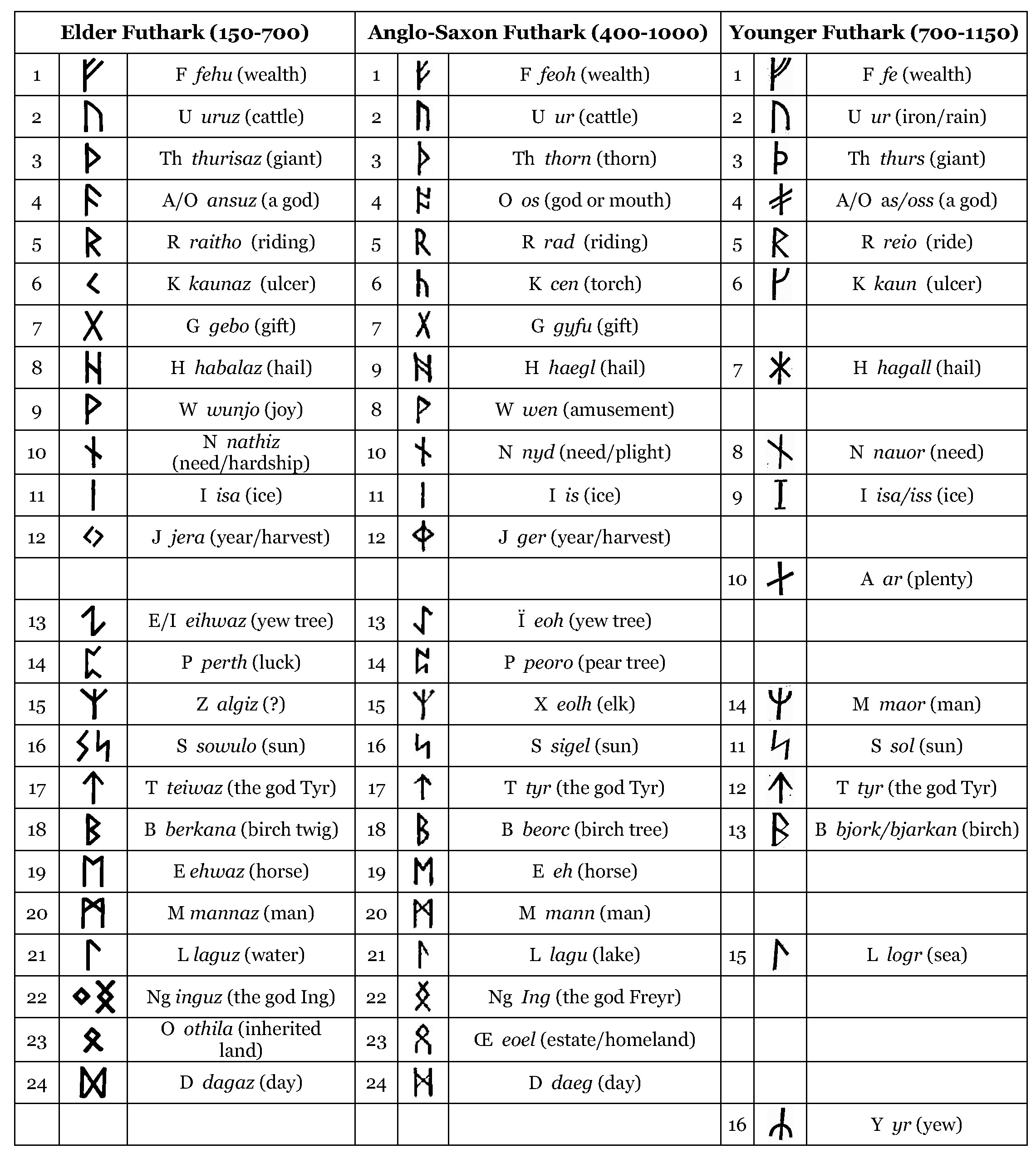
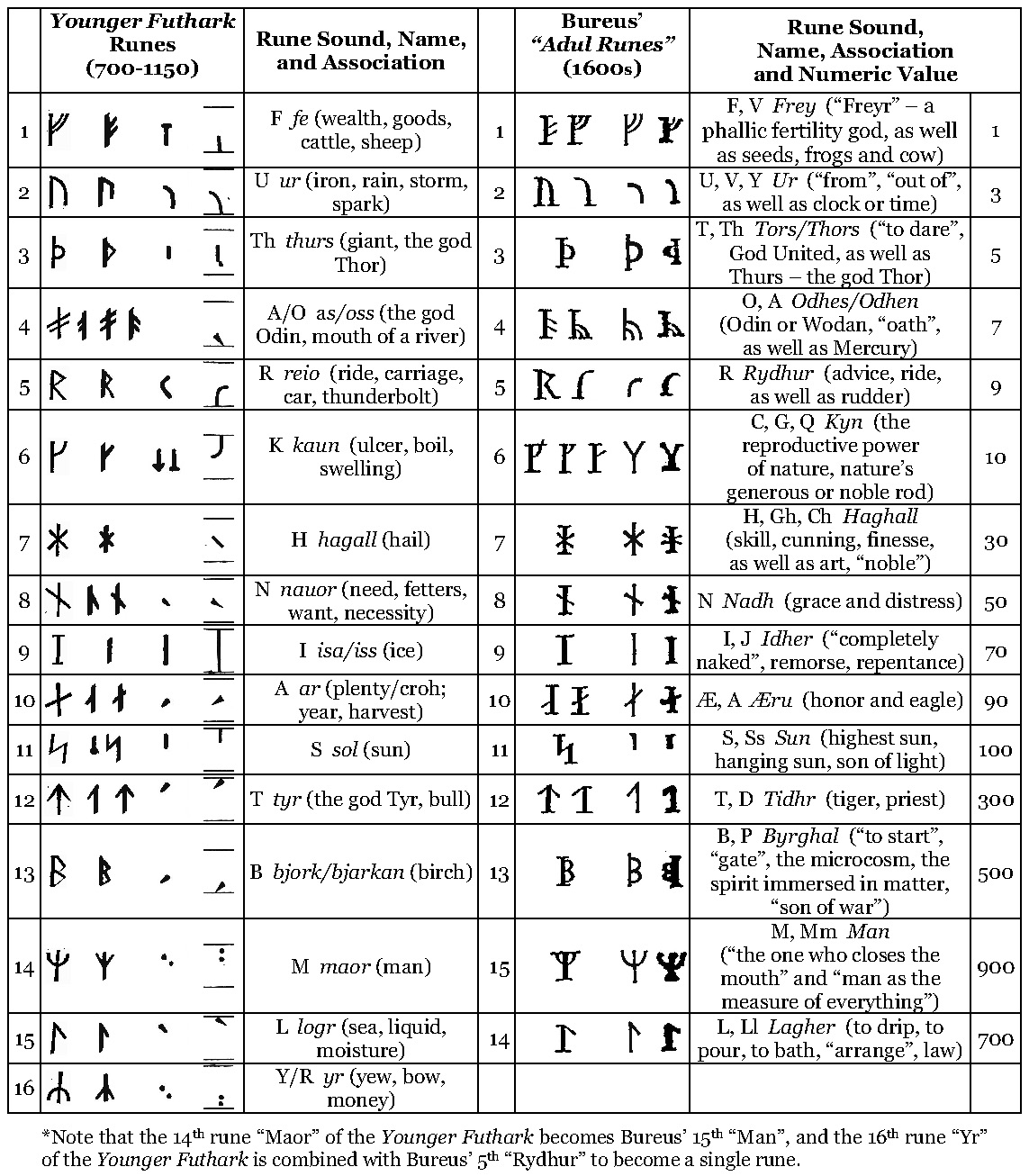
Notice how some shape recognized as ᚠ looks exactly as ᛓ the ᛒ, also that is the very first rune in that sequence, so chances of that actually being B are rather high.
and now for something completely different:
Is Ⰰ the ᚐ a cross?
Is A the masonic pyramid?
y is so important, that therte are 100 times more results for pyramid than for piramid (even though many transliterations are probably piramid.
It is interesting (and probably confusing) that in pyramid y is in the first vowel syllable and in
awkward, I like this word and apply it to me. Probably because it starts with Ok. As if me awkawlnico
awk owl (nick off) oak owl (and like literally nick off) is it a simualtion or what?
Oak Owl (but maybe not, it sounds as "о кал" (его величество говно))
(but how else would I know that owl is [al] and not [ol]
о кол (I suspect english pronunciation to be false)
(да, ахуел)
oh cool
An oak is a hardwood tree or shrub in the genus Quercus of the beech family. They have spirally arranged leaves, often with lobed edges, and a nut called an acorn, borne in a cup. The genus is widely distributed in the Northern Hemisphere; it includes some 500 species, both deciduous and evergreen. Fossil oaks date back to the Middle Eocene. Molecular phylogeny shows that the genus is divided into Old World and New World clades, but many oak species hybridise freely, making the genus's history difficult to resolve.
beech is бук [bu:k (book)]
oak is SA
beech is B A could appear as a counter-reform after they re-cognized B as bircjh
and we all only know beach and bitch
матерный язык дисикрэйтед (секретом осквернён?)
what is cunt? we all know that cunk kunt, but is it ..can't?
It's natural to call cunt somebody who tells us to do what we just can't
prick is pierce, but what else is prick? stick. What else? dick. What else? moron is dick, what else?
Is piercce that secretd meaning of prick? What if I djust know it and others know it mostly as dick and stick.
Stick is literally as dick.
Запиши и забудь (я начал записывать это всё, чтоб в голове не приходилось всё время огонь этой мысли поддерживать)
Looking at all the meanings of blow it makes me think that some variants are merely homonyms. And they literally are. So are they one word of homonyms? Both.
the of of the previous likne is or. I tend to writie it the netherlands way
nether sounds as ничьё
Beech and Бук are definitely cognates, but how u turn и? Literally because russians read и as i
But it's the other way around. Just as Russian R is pronounced with tongue but written without it: Р
talon is claw (dif definitely cognates of different dialects: t~c, l~l, n~w(ν, nasal sound, I полагаю))
In antiquity, the bark of the beech tree was used by Indo-European people for writing-related purposes, especially in a religious context.[33] Beech wood tablets were a common writing material in Germanic societies before the development of paper. The Old English bōc[34] has the primary sense of "beech" but also a secondary sense of "book", and it is from bōc that the modern word derives.[35] In modern German, the word for "book" is Buch, with Buche meaning "beech tree". In modern Dutch, the word for "book" is boek, with beuk meaning "beech tree". In Swedish, these words are the same, bok meaning both "beech tree" and "book". There is a similar relationship in some Slavic languages. In Russian and Bulgarian, the word for beech is бук (buk), while that for "letter" (as in a letter of the alphabet) is буква (bukva), while Serbo-Croatian and Slovene use "bukva" to refer to the tree.
wants ~ works (not just words (even though words are closer to wants, and that makes sense, one make it works, pushes not onluy n (notion) to r (речь), but also t's to k's (take and cake? did and kick? to and ко? 𓏏 to 𓈎)))
b d
p q
Were they the first set? Graphically distinguishing between themselves. upward stave stood for voicedness and downward stave stood for voicelessness. belly to the right signallel lips, belly to the left signalled tongue? lingua links? not lips? it depends on whether you count belly or staff. So raw. Indeed.
Nevertheless, very fucking promising, very
fucking awesome.
пиздит~пищит (но пизда ещё и писает (звук мочи писком считался?
шёпот, нашёптываение похоже пщьпщьпщьпщь))
bodry
poqoy
People whisper when they don't want to wake somebody up. шепот и спать однокоренные!
whisper and sleep? not so much
Unless sp in whisper is sleep.
Вязать is въ and за.

(the hew ↑s more calm and stylish, because in darkened room yellow colour lacks in photophone)
this is more knotting than knitting, but it is the most primitive form of weaving fabric out of threads.
Naturally rope is not the best fabric to knit with, but here I just showed the direction of the thread.
Knit is in and at? in it! k~j ..I need to start such file, I did! JK! (phone and photo, foto seem to merge)
J and K are short and shorter forms of I. C as short I? C is as if with its fingers shows чуть.
В русском узел и вязать однокоренныей. и узел тоже у=в + за (л is verbal suffix: вязал, скорей всего подобен английскому er (вязаль, вязарь даже! (более распространённые слова с этим суффиксом писарь, слесарь, технарь, и быить может даже гуманитарий (т.е. er значит арий?))))
are?
リ?
る?
узел, вязал = въ+за (буквально рецепт вязки)
И вроде бы казалось бы сначала же за, а после въ, но есть и такая форма: завязывай, буквально два узла. вяжи ~ въ же? в её же?
а́фини (мн. ч.; диал.) — черника; никогда: Афины — Афіни, Атени (редко.)
баня — русская баня (баня любая — лазня); помимо: купол, глава (у здания церкви)
There are plenty of such fascinating material in https://ru.wiktionary.org/wiki/%D0%9F%D1%80%D0%B8%D0%BB%D0%BE%D0%B6%D0%B5%D0%BD%D0%B8%D0%B5:%D0%9B%D0%BE%D0%B6%D0%BD%D1%8B%D0%B5_%D0%B4%D1%80%D1%83%D0%B7%D1%8C%D1%8F_%D0%BF%D0%B5%D1%80%D0%B5%D0%B2%D0%BE%D0%B4%D1%87%D0%B8%D0%BA%D0%B0_(%D1%83%D0%BA%D1%80%D0%B0%D0%B8%D0%BD%D1%81%D0%BA%D0%B8%D0%B9)
завязывайся (снаружи внутри снаружи внутри снаружи?)
влезай простая форма слова вяжись. словно сь стало ль встав в середину слова
в le давай (do in the (get into))
лезь ~ le there? но это еврейское ле, to: -לְ- [le] and אֶל [эль]
Another hebrew to is עַד (which sounds the opposite of russian to (до) which is от (of)
Russian is interesting: some interesting antonyms are от и до, of & to,
g.t doesn't know neither οθ not θο (thinking of of~to thought of θ)
אחר [ahér] other
I was warned that modern hebrew is full of various borrowings, maybe that is one of those cases.
Eliezer Yitzhak Perlman
(later Eliezer Ben-Yehuda) was born in Luzhki (Belarusian:
Лужкі) in the Vilna Governorate of the Russian Empire (now
Vitebsk Oblast, Belarus) to Yehuda Leib and Tzipora
Perlman, who were Chabad hasidim.[1] His native language
was Yiddish.[2] He attended a Jewish elementary school (a
"cheder") where he studied Hebrew and the Bible from the
age of three, as was customary among the Jews of Eastern
Europe. By the age of twelve, he had read large portions
of the Torah, Mishna, and Talmud. His mother and uncle
hoped he would become a rabbi, and sent him to a yeshiva.
There he was exposed to the Hebrew of the Jewish
Enlightenment, which included some secular writings.[3]
Later, he learned French, German, and Russian, and was
sent to Dünaburg for further education. Reading the
Hebrew-language newspaper HaShahar, he became acquainted
with the early movement of Zionism.
Upon graduation in 1877, Ben-Yehuda went to Paris for four years. While there, he studied various subjects at the Sorbonne University—including the history and politics of the Middle East. It was in Paris that he met a Jew from Jerusalem, who spoke Hebrew with him. It was this conversation that convinced him that the revival of Hebrew as the language of a nation was feasible.[4]
Ben Yehuda is literally Yehudowhich, as names were written
down in russian empire. by father's name.Upon graduation in 1877, Ben-Yehuda went to Paris for four years. While there, he studied various subjects at the Sorbonne University—including the history and politics of the Middle East. It was in Paris that he met a Jew from Jerusalem, who spoke Hebrew with him. It was this conversation that convinced him that the revival of Hebrew as the language of a nation was feasible.[4]
Something from vol.14 I thoroughly forgot:
Лексика древнемакедонского
языка чрезвычайно близка к древнегреческой, однако имеются
существенные отличия в фонетике, не свойственные ни одному
из древнегреческих диалектов. В частности, македонское β
нередко соответствует греческому (аттическому) φ, макед. δ
— греч. θ и т. д.
And I'm pretty sure I forgot the most of them. I need some artificial head which would contain it all.
A copy of me with some superpowers? Yes, would be nice. I want to be that copy of me, the better one.
n u
nas uas (нас вас)
Those sticks are devitinitely fingers.
m of me is three перста fingers
w is what? why would we look like vi the вы?
w is probably the thumb the third
Was thumb looking at fingering pointing at us? is it how vi(you in rus) and weEN are different?
vi is we in norwegian.
But latin you is vos and vi si is force. Feel the homonymy of vos and force (like hos and horse whores)
B D
дВе оДин?
deVa oTiн (отчина, отец, один, Один)
баба дед (дева дедушкина внучка)
тётя мне выносит мозг. почему тётя? потому что т(т) похоже на m(м)
bi is so labial and stands for two. not t, b, weird. t is two though. Different cults, different cultures.
Культура is not some cult, it's cult of Ur (in russian it is literarry so: культура ~ культ У́ра
(and russian ура́ makes me think that
russian culrute is Уральская, and that real Ur is yet to
discover))
I got carried away, I wanted to say that russians maybe descend from Ur. Thus Ukraine, Ur-країна.
is Ur ᚢᚱ of ᚠᚡᚢᚣᚤᚥᚦᚧᚨᚩᚪᚫᚬᚭᚮᚯᚰᚱᚲᚳᚴᚵᚶᚷᚸᚹᚺᚻᚼᚽI got carried away, I wanted to say that russians maybe descend from Ur. Thus Ukraine, Ur-країна.
But am I not like some gypsie being both egyptian and roman whebn romale
Если матерные слова основные, то ети = is (еби ~ the be)
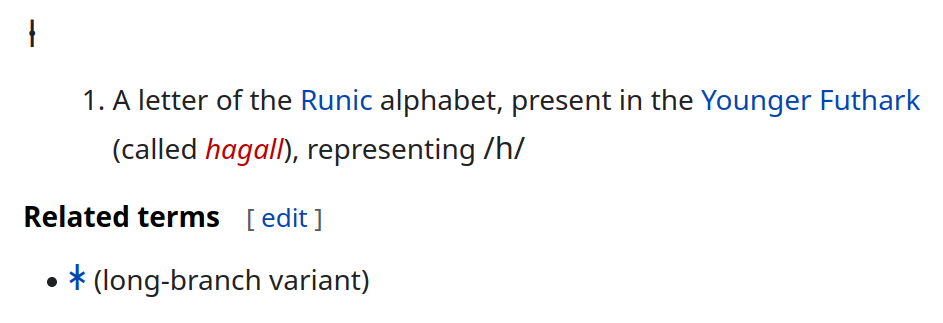
but
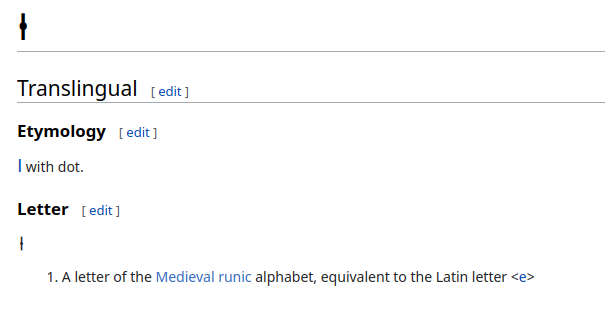
The medieval runes, or the futhork, was a Scandinavian runic alphabet that evolved from the Younger Futhark after the introduction of stung (or dotted) runes at the end of the Viking Age. These stung runes were regular runes with the addition of either a dot diacritic or bar diacritic to indicate that the rune stood for one of its secondary sounds (so an i rune could become an e rune or a j rune when stung). The medieval futhork was fully formed in the early 13th century. Due to the expansion of its character inventory, it was essentially possible to have each character in an inscription correspond to only one phoneme, something which was virtually impossible in Younger Futhark with its small inventory of 16 runes.[1]
Medieval runes were in use throughout Scandinavia during the Middle Ages, and provided the basis for runology beginning in the 16th century.
Towards the end of the 11th century, the runic alphabet met competition from the introduced Latin alphabet, but instead of being replaced, the runes continued to be used for writing in the native Old Norse language. The Latin alphabet, on the other hand, was mainly used by the clergy for writing in Latin, but also Latin prayers could be written down with runes. Whereas the Latin letters were written with quill and ink on expensive parchment, the runes were carved with sharp objects on prepared wooden staffs that were cheaper[2] (see e.g. the Bryggen inscriptions).
The Bryggen inscriptions are a find of some 670 medieval runic inscriptions on wood (mostly pine) and bone found from 1955 and forth at Bryggen (and its surroundings) in Bergen, Norway. It has been called the most important runic find in the twentieth century. Before the find of these inscriptions, there was doubt whether the runes were ever used for anything else than inscriptions of names and solemn phrases. The Bryggen find showed the everyday use that runes had in this area, and presumably in other parts of Scandinavia as well. Another important aspect of the find was that many of the inscriptions were obviously at least as recent as the 14th century. Previously it was believed that the use of runes in Norway had died out long before.
The inscriptions have numbers for Bergen finds, mostly "B" followed by three figures.
Many of the inscriptions follow the formula Eysteinn á mik (Eysteinn owns me, B001), and were most likely used as markers of property – like modern-day name tags. Some contain short messages of different types, such as Ást min, kyss mik (my darling, kiss me, B017) and others have longer messages such as business letters and orders. Yet others contain short religious inscriptions, often in Latin, such as Rex Judæorum In nomine Patris Nazarenus (B005) and may have been intended as amulets.
The inscriptions are currently kept at Bryggens Museum in Bergen, and some are on display.
Such artextacfs make me think of devanagari
and veles book (I should take another look
at it,
what if the ridiculous story concealed the actual artefact?
What if that artefact is a forgery, as my first impression was.
But my impression was heavily influenced by the cool story of how that artefact was found and lost.
We cannot test it and it is very convenient. But then what if it was destroyed, what if it was legit?
what if the ridiculous story concealed the actual artefact?
What if that artefact is a forgery, as my first impression was.
But my impression was heavily influenced by the cool story of how that artefact was found and lost.
We cannot test it and it is very convenient. But then what if it was destroyed, what if it was legit?
Argh, you got me, let's look at it
unbiased (even though guys who take it seriously arre all
clueless)
And to my surprise it also begins with B, only that page, being the only one present (why would they not fotograph them all if they had them? So the only page ever seen is told to be page 16, and I looked into that puddle and I didn't find anything else of importance, so I leave it away, it is even worse than tolkien, at least that faggot told that he invented those writing systems, but then he usurped regular runes into his propaganda piece. That eternal brit, shame on him.
That initial B made me look deeper into it, but then I had to through it all away, because it didn't seem like anything, either way it is not my battle, so I cut it out and placed into cut_out.html
Символ параграфа (§) — типографский знак, который употребляется для обозначения параграфа в документах, происходит от сокращения ss от лат. signum sectiōnis «знак раздела» или от готического написания латинской буквы C (ℭ).
Stone applied to a stick is a weapon (посох тоже оружие: иоанн грозный своего сына таким метательным орудием завалил ненароком) so magic stick is any instrument, first axes were of stone and stick.
stone stays on
stick stays in
or
stone set on
stick set in (I don't know how ick so easily agreed to be in, but it felt natural and it is factually accurate.
and I looked up how factually accurate it was, for first axes didn't have holes to put a stick into, but:
В неолите стали появляться и топоры с отверстием-проухом для закрепления на рукоятке, но основная их масса изготовлена уже в энеолите и бронзовом веке, когда появилось большинство и массивных грубых топоров, и самые великолепные экземпляры. Сверление чаще производилось трубчатой костью с песком в качестве абразива, хотя могли применяться деревянная палка, сплошная или полая, бамбук, каменное сверло или медная трубка.
Предполагают, что для надёжного закрепения достаточно тонкой круглой рукоятки сверлёные топоры могли заранее надевать на ветви растущих деревьев
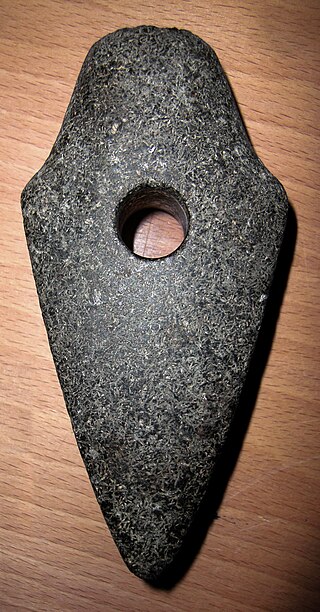
Stone axe from Näsby, Taxinge Parish, Selebo Hundred, Nykvarn Municipality, Stockholm County, Södermanland, Sweden. According to the archaeologists Andreas Oldeberg and Mårten Stenberger this type of axe belongs to the Bronze Age.
My buddy's name Butrin abd ge and he called himself 23, which makes me think of his name as Bu3'n
And it made me think of Δ as of 3 and the similarity of A and Δ made me see 1 also triangular, and thinking of how people deal with numbers, they could measure a sack of grain with a cup, and then in the end they'd also have some fraction of the last cup, and thus that 1 would be a дробь, fraction and the horisontal line in A could say that (in fractions upper part is lower than lower part, thus the shape of A, and it reminds me of Δ looking like 🜂 and A looking like 🜁, thuse D is fire somehow áГни? оГни́? and Air is perfect for air. and 🜄 is great V the Vasser~Water~Вода, actually B the V, and then we also have 🜃 standing for earth. And it looks like some old russian shape of Д I'm yet to find in a scan. Thus is 🜂 𐤂? L the Г. Λ the 𐤂. But then o opposes a, M opposes B, N and San the Samekh go away, К~L ~ Г and is E И? i with dot is e in runes (see few images above, or just look at ᛂ, it is the dotted i being e)
A как в слове Арёл? Ariel? Air, but what is the verb?
B as in word Boil
В как в слове Вари
Г как в слове Гори
Д как в слове Дари? Дели́? Делай?
(Жарь~Fry? Is it what stands behind the mess in the second line?)
Avis is bird
auris and oricula is ear (it hears by air)
Could nostrils and ears be so small because they worked with air?
Глаза видят твёрдые предметы Земля (Зрение)
Рот ощущает влажные пищи Вода (Вод ~ Рот)
ноздри и уши чуют воздух Воздух + Эфир? (нос-дух воздух? hear ethear?)
Осязание температуру ощущает Огонь (ощущение (очищение?))
warrior ~ worrier (warrior worries? worry is to war for something? I dunno, could be, but maybe nah)
A B C is the meme, is the word, so it seems they preserved the
ABC is more than a word. It is the very structure of the alphabet.
Was it the first all-capital word? All all-capital words are b abbreviations.
And был Свет
Light, as свет, is lingual.
A W L
And Was Light.
Was~Be~aM, but is is and are are out of this labiakl sequence
And Be Somerthing
И Было Так.
Аз Бысти? I be and(co~with) do
and as the full ёклмн or ёпрст (those two are used as матерные слова, эвфемизмы или истинные
ЭВФeM but it breaks on ism, so was it euthemic or something?
e u th
e m c
I am apopghenic at this point. So trippin I would never know.
back on track,
ABC (literally basics, and the word basic as being made of base telling that base is BC, and bass just came out of it, being what they call low sound, which is currently part of rhythm section, and playing to what guitars are built in. Giving the techno dub.
ABC is of later origin than base. Base is more basal word.
Before Bey became ABey (in dutch A B C are read as A Бей Сей, with ab sounding as english obey.
Before That it was ..бойся?
Bet before Обет?
Bet could be the previous iteration, when B was the first letter, A could be the second, abnd thus Δ would be 3.
BAD would be the word.
A strong word.
Would GUT be the good?
Ball
Goal
Boat
Goat
Bet
Get
Bay
Gay
Brave
Grave
Bear
Gear
Bell
Gel
Bell
Cell
Coat ~ Goat?
Goal ~ Coal?
Coal alCO? alCOHOl? but ethanol only has one oxigen: C2H5OH, alCCOHНННННal?
I think I just began seeng organic molecules: C2H5OH tells that it has the frame of two carbons, and each of those had three more places to attach, which took Hydrogens, and one OH. Which made it look like a dog or something. And that took that other H. I think As I see how C2H6 is turned to C2H5OH, I have my next level of seeing cheistry. I am about to learn that. There are real money. Except all the low-hanging fruit are taken, but I still have my unique approach, so I think I'll find what nobody's seen.
C2H6 is ethane, it's as if o in ethanol is o in c2h5oh, and as if second e in ethane is h in c2h6 is c th and n? is E 3? 3 h's? ethane = 3h-th-n-3h. Then a is the bond between th and n both of which are c.
is ol = O? or is L that position of H? or is it all? Now I do have some pareidolia. apophenia. Or do I? Those chemists could know what I discover. They preserved ABC without allowing it to become ABCD.
They could know something. It would explaing A C G T, wouldn't it?
They know something. I hope they are fascinating by me being able to see through some of it, because I will definitely somethi see something they forgot or never knew.

It is funny, that if between those carbones is a double link, it's not ethane, but ethene, and it turns to alcohol easier, even though it is not as similar a molecule:
60atm, phosphoric acid catalist. Still think it is easier? It's crazy. Real crazy, like who can do that!
Ethylene (IUPAC name: ethene)
this nomenclature is quite a field, who knows maybe it's really deeper than it seems, but maybe those coincidence are just that, powered by poetic whims those coincidences are an antu naturally more often occuring than would be if were influenced solely by randomity of chaos.
We all know wrestle, but did you know wrest?
It didn't help me to write something readable writing that booklet being sober in the morning, because they still cannot read it. Initiate them more. Write a better book. Start with.
ABC is more than just a word, it is very structure of the alphabet.
ABC это не просто слово, это сама структура алфавита:
Мало кто замечает,
Большинство не замечает, что алфавит повторяется: опст похоже на abcd,
и копнув глубже обнаружили что ничегол себе копна.
efg на abc
ᛂᚠᚵ на ᛆᛓᚴ
yes, C the ᚴ, not D the ᚦ or C the ᛋ
свет в значении world and light makes sense when in the future
electricity Большинство не замечает, что алфавит повторяется: опст похоже на abcd,
и копнув глубже обнаружили что ничегол себе копна.
efg на abc
ᛂᚠᚵ на ᛆᛓᚴ
yes, C the ᚴ, not D the ᚦ or C the ᛋ
(russains also call
it light, свет)
being on means that all the world is watching. Maybwe in the
past they called life light (not dark, not hard) in the
daylight and night is naughtyI imagine the world where total surveilance is achieved. In the past they could achieve it by a system of mirrors, even if as jars with liquie q liqids. And if you hear a jar being broken, you may know somebody is commiting a crime and to be stopped. Wild fantasy, but totally feasible in a small community.
псих бзик
Ansuz is the conventional name given to the a-rune of the Elder Futhark, ᚨ. The name is based on Proto-Germanic *ansuz, denoting a deity belonging to the principal pantheon in Germanic paganism.
The shape of the rune is likely from Neo-Etruscan a (), like Latin A ultimately from Phoenician aleph.
See how they trip, neo-etruscan, but then their invention redirects to ol-italic scripts:
The Old Italic scripts are a family of ancient writing systems used in the Italian Peninsula between about 700 and 100 BC
but then there is such concept as neo-etruscan. And I leave this awkward remark (it's ok-ward, not even okay, just mostly okay, yet rather off at the same time, it wants to be okay, but doesn't exactly succeed yet)
The Etruscans were a dominant culture in Italy by 650 BC,[4] surpassing other ancient Italic peoples such as the Ligures. Their influence may be seen beyond Etruria's confines in the Po River Valley and Latium, as well as in Campania and through their contact with the Greek colonies in Southern Italy (including Sicily). Indeed, at some Etruscan tombs, such as those of the Tumulus di Montefortini at Comeana (see Carmignano) in Tuscany, physical evidence of trade with Egypt has been found by archaeologists—fine Egyptian faience cups are an example. Such trade occurred either directly with Egypt or through intermediaries such as Greek or Phoenician sailors.
Rome was influenced strongly by the Etruscans even though it was separated from the early boundary of Etruria by the Silva Ciminia, the Ciminian Forest. A series of Etruscan kings ruled Rome until 509 BC when the last Etruscan king, Lucius Tarquinius Superbus, was removed from power and the Roman Republic was established.[5] The Etruscans are credited with influencing Roman architecture and ritual practice; it was under the Etruscan kings that important structures such as the Capitolium, Cloaca Maxima, and Via Sacra were realized.
Dutch reading ui [au] blew my mind. Are vowels this переливающиеся? Shimmer. Colourful shimmer.
Ansuz is the conventional name given to the a-rune of the Elder Futhark, ᚨ. The name is based on Proto-Germanic *ansuz, denoting a deity belonging to the principal pantheon in Germanic paganism.
The shape of the rune is likely from Neo-Etruscan a (), like Latin A ultimately from Phoenician aleph.
In the Norwegian rune poem, óss is given a meaning of "estuary" while in the Anglo-Saxon one, ōs ᚩ takes the Latin meaning of "mouth". The Younger Futhark rune is transliterated as ą to distinguish it from the new ár rune (ᛅ), which continues the jēran rune after loss of prevocalic *j- in Proto-Norse *jár (Old Saxon jār).
Since the name of a is attested in the Gothic alphabet as ahsa or aza, the common Germanic name of the rune may thus either have been *ansuz "god", or *ahsam "ear (of wheat)".
size~sides
ABC это не просто слово, это сама структура алфавита:
Большинство не замечает, что алфавит повторяется: опст похоже на abcd,
ABC is more than just a word, it is the very structure of alphabets.
Books don't tell that alphabet repeats itself: opst reminds abcd, and lines of vowel (by voice), labial (by lips) and linguals (by tongue) repeat in many faces: efgh even uvwxyz if you excuse w and take y for j which is technically lingual consonant. ijklmn seem off, but then italian and irish don't include jk, which is strange considering those two letters being initial of Jesus Christ in many european languages, norwegian for example, and it makes me wonder if the christinizers of those lands invented these JK letters ..see why I shouldn't write this book being high. But then it seems to stimulate me to think of this. I should not be shy to write it being high. I have to do it sober too, though, or at least to edit it out of these things being sober. Or being high, but then to approve it being sober.
and l looks like I and ll is short I in french and such: mallorca is [majorka] also el is a name of the father of JK, and of Jupiter, so this J cult could be really ancient, if not Jupiter, Minerva would be M, I think this was the case, because in greek instead of pretty much labial (hear it yourself) θ (θεά is goddess) stands ζ (ζευς is Zeus, and ζ is minuscule Ζ and when I was looking up zeus, g.t. offered me this as a variant to translate: zeus or thor and to my surprise it translated to ζευς ή θωρ. Before that it only translated zeus as "ο Δίας", while Zeus was also translated as Ζεύς, and god is θεός and God is Θεός, all three words are most probably cognates, but then θεός could be made up out of some term coming directly from θεά, )
It is very hard to ignore the probability of this world being a simulation when my friends have such alphabetic names: two friends in the top of my whatsapp have initials A B and one of them is written in there as Alex23, which is A23, 123, Butrin is his name and he helped me publish that first booklet (it's time to write another one, and this time I want him to assist me more, I want him to read it until he can understand it, I want to take him as a coauthor. And once I thought that, I noticed how Alex Butrin is AB, and other friend, who probably doesn't know this one is Alex Bragnikov, and the third guy in the top of my list today is Arcade 3D, as if A?3D, but his second name is Leontievich. He is the guy who entroduced me to Alex Butrin maybe 15 years ago. A3D's name is Kazantsev, Kazan is the Kingdom to the east from Muscovy, and AK is how eastern syllabaries go. What's going on here? It's very hard not to be some solipcistic freak when life unfolds like this. And I appreciate the poetry of the creation.
I think I will take those guys as my quality control audience.
I think their names makeing more sense to them will motivate them to be interested in this thing, and they're, my friends are rather smart individuals.
Isn't such openness detrimental? I think
they deserve fame and why shouldn't I announce them.
Glory, not fame.
Isn't fame fans fannen? фаны.
And isn't then знаменитый содержит men in it?
вн in славный is fan?
быть может есть или было слово словеный, о нём говорят?
славный это слово. Славный
достаславный, до ста слов?
one
fan is a one, an, someone. or is he for one, of one, fan is of one, I'm of axc (axe (abe?))
ABE is quite possible as a name.
As a first word, considering paleohispanic which I consider a much more solid and diverse ground to study than phoenician, which I suspect to be phoney foney fake.
Greek dark ages ended with Greeks acquiring alphabet:
The time period known as the Greek Dark Age began in 1200 BCE and lasted until 800 BCE at the start of the Archaic Period. This period of time is associated with archeological evidence such as graves and pottery, which showed a decline in the wealth, art, writing, and culture associated with Bronze Age civilizations.
1200 BCE is when, they say, civilization which used linear B collapsed and greeks didn't know literature, so they say. And I believe this. Because many writing systems appeared in 700's BC and I suspect that moment to be where runes were in use,
I consider both paleohispanic syllabaries and old-italian alphabets to be runic
(by the slopy shape of the letters)
Linear B is an adapted form of Linear A, which was borrowed from the Minoans by the Mycenaean Greeks, probably about 1600 bc. Its language is the Mycenaean Greek dialect. Linear B script is attested on clay tablets and on some vases, both dating from about 1400 bc to roughly 1200 bc.
And I noticed that such print is easier to read, because uniqueness of the line (so you don't read one line twice by mistake
Now it looks hebrew. Or arabic-like, as if it starts fromt here.
(from the right)
Glory, not fame.
Isn't fame fans fannen? фаны.
And isn't then знаменитый содержит men in it?
вн in славный is fan?
быть может есть или было слово словеный, о нём говорят?
славный это слово. Славный
достаславный, до ста слов?
one
fan is a one, an, someone. or is he for one, of one, fan is of one, I'm of axc (axe (abe?))
ABE is quite possible as a name.
As a first word, considering paleohispanic which I consider a much more solid and diverse ground to study than phoenician, which I suspect to be phoney foney fake.
Greek dark ages ended with Greeks acquiring alphabet:
The time period known as the Greek Dark Age began in 1200 BCE and lasted until 800 BCE at the start of the Archaic Period. This period of time is associated with archeological evidence such as graves and pottery, which showed a decline in the wealth, art, writing, and culture associated with Bronze Age civilizations.
1200 BCE is when, they say, civilization which used linear B collapsed and greeks didn't know literature, so they say. And I believe this. Because many writing systems appeared in 700's BC and I suspect that moment to be where runes were in use,
I consider both paleohispanic syllabaries and old-italian alphabets to be runic
(by the slopy shape of the letters)
Linear B is an adapted form of Linear A, which was borrowed from the Minoans by the Mycenaean Greeks, probably about 1600 bc. Its language is the Mycenaean Greek dialect. Linear B script is attested on clay tablets and on some vases, both dating from about 1400 bc to roughly 1200 bc.
And I noticed that such print is easier to read, because uniqueness of the line (so you don't read one line twice by mistake
Now it looks hebrew. Or arabic-like, as if it starts fromt here.
(from the right)

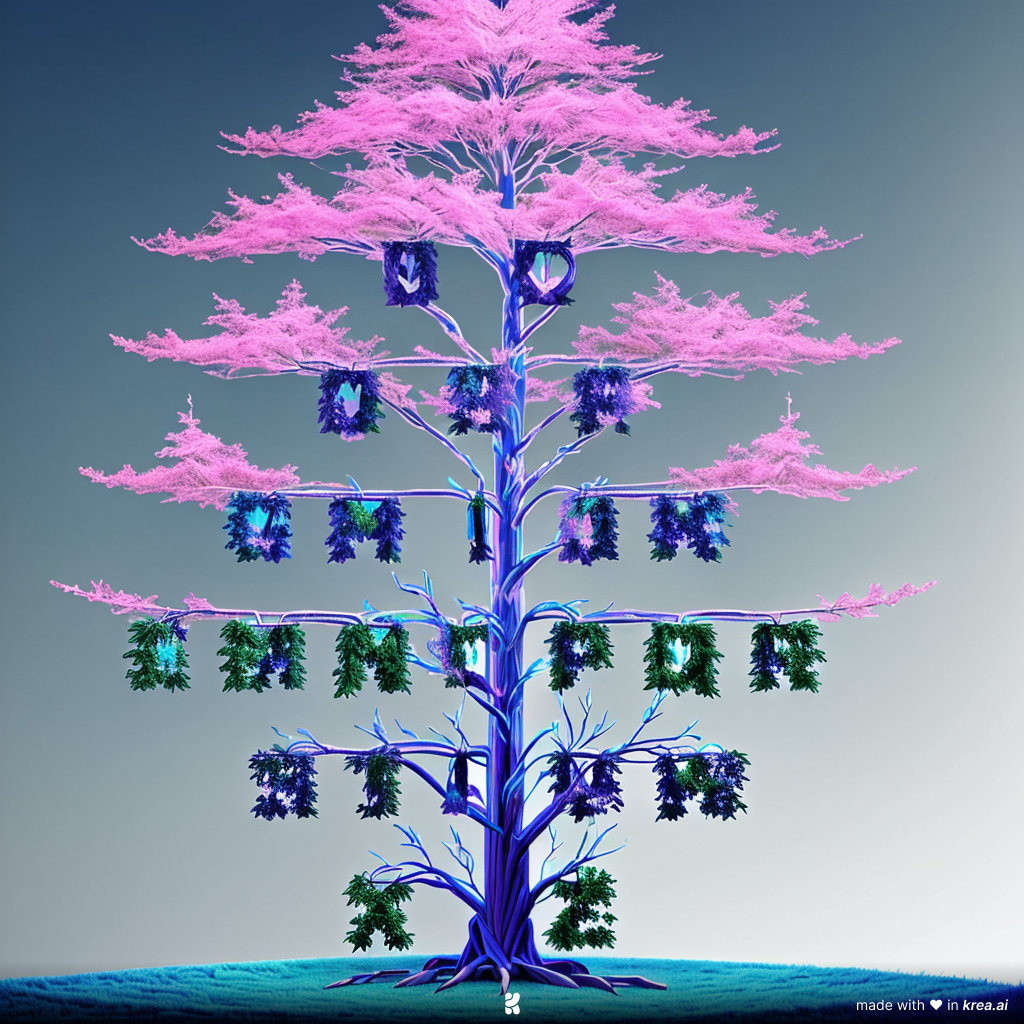
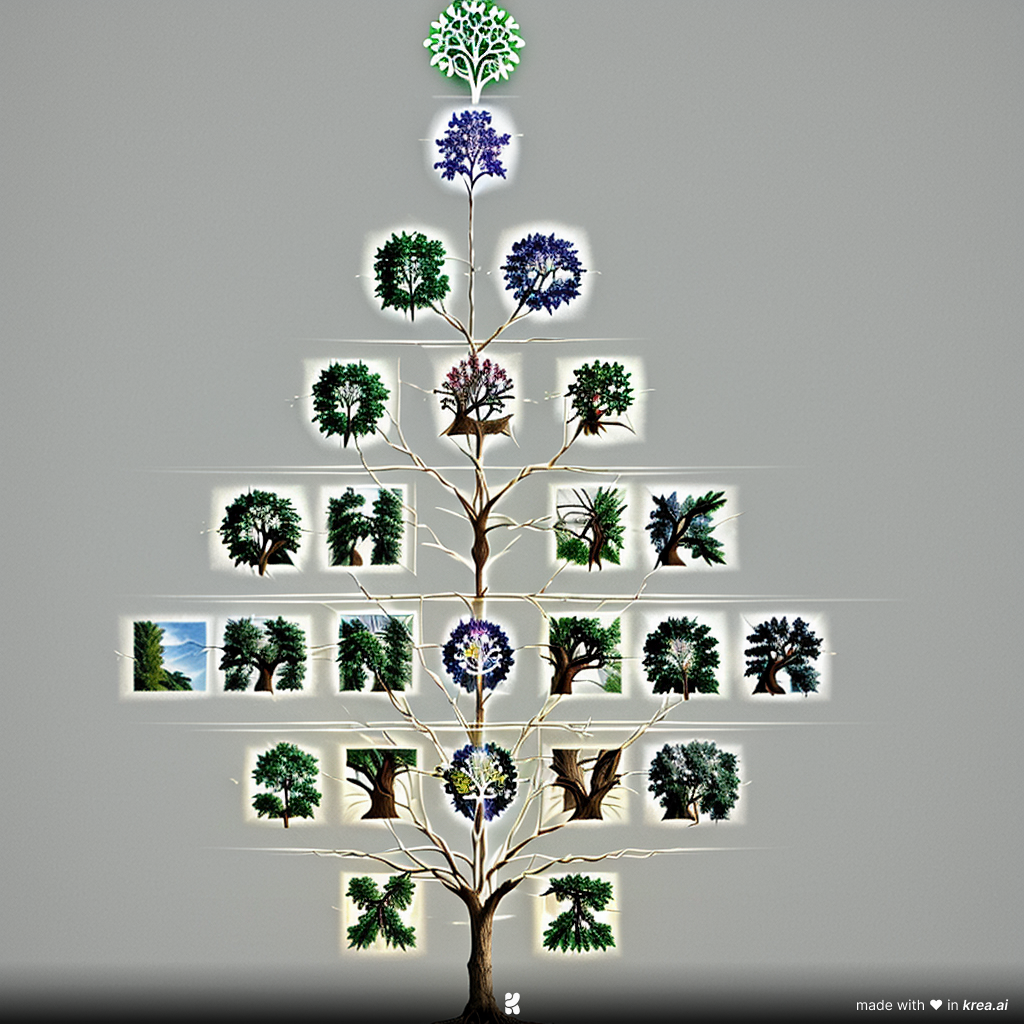

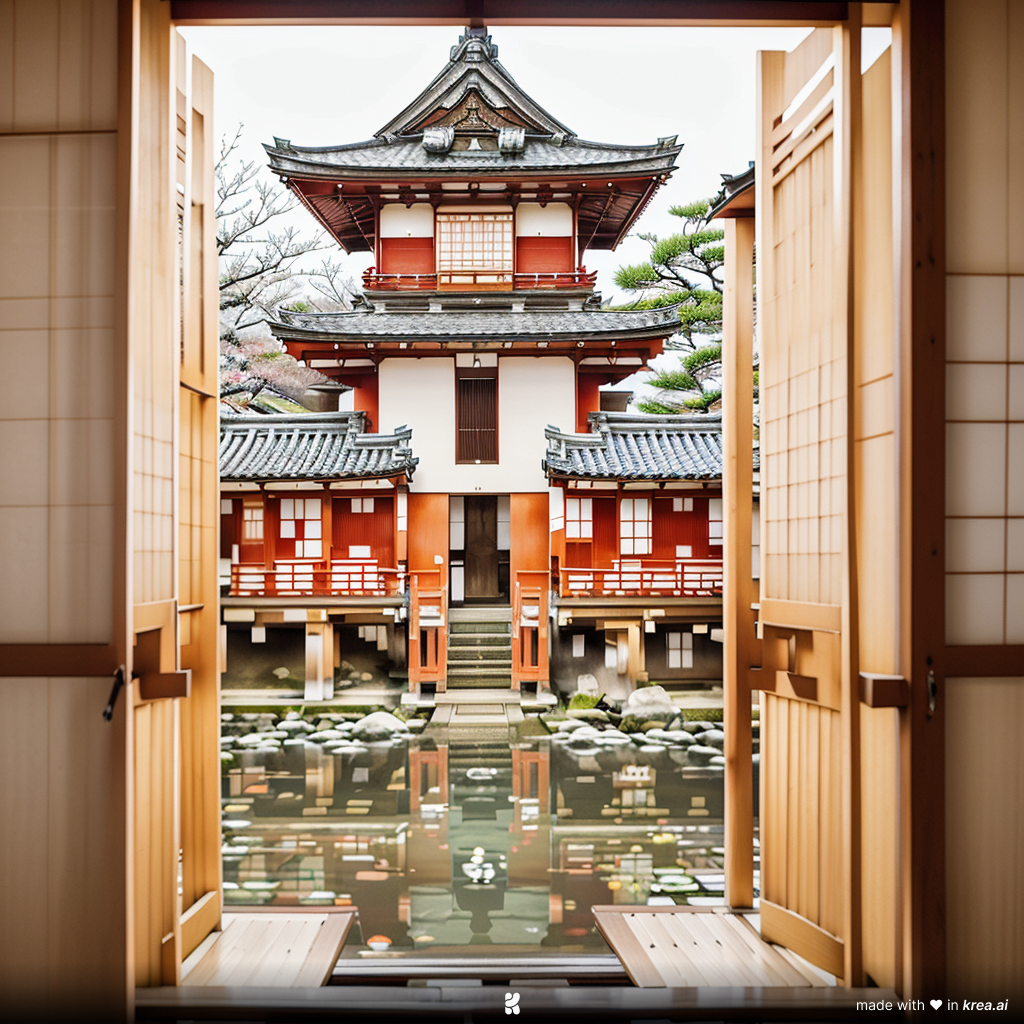
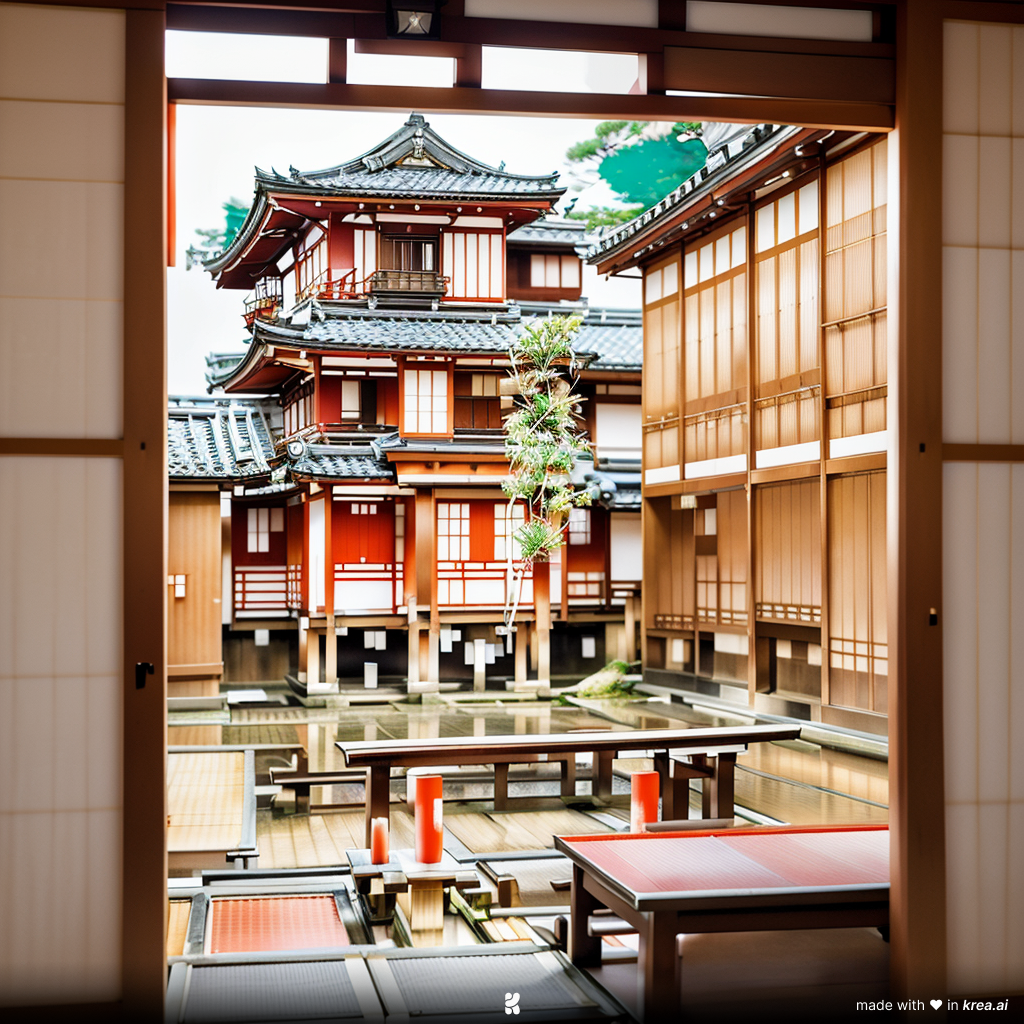
This one is the best of the serie, even though it is rather vague, artistically it is the best. But then I played with it some more, and I wasn't very discriminatory, just to see it, it's my first day with it.

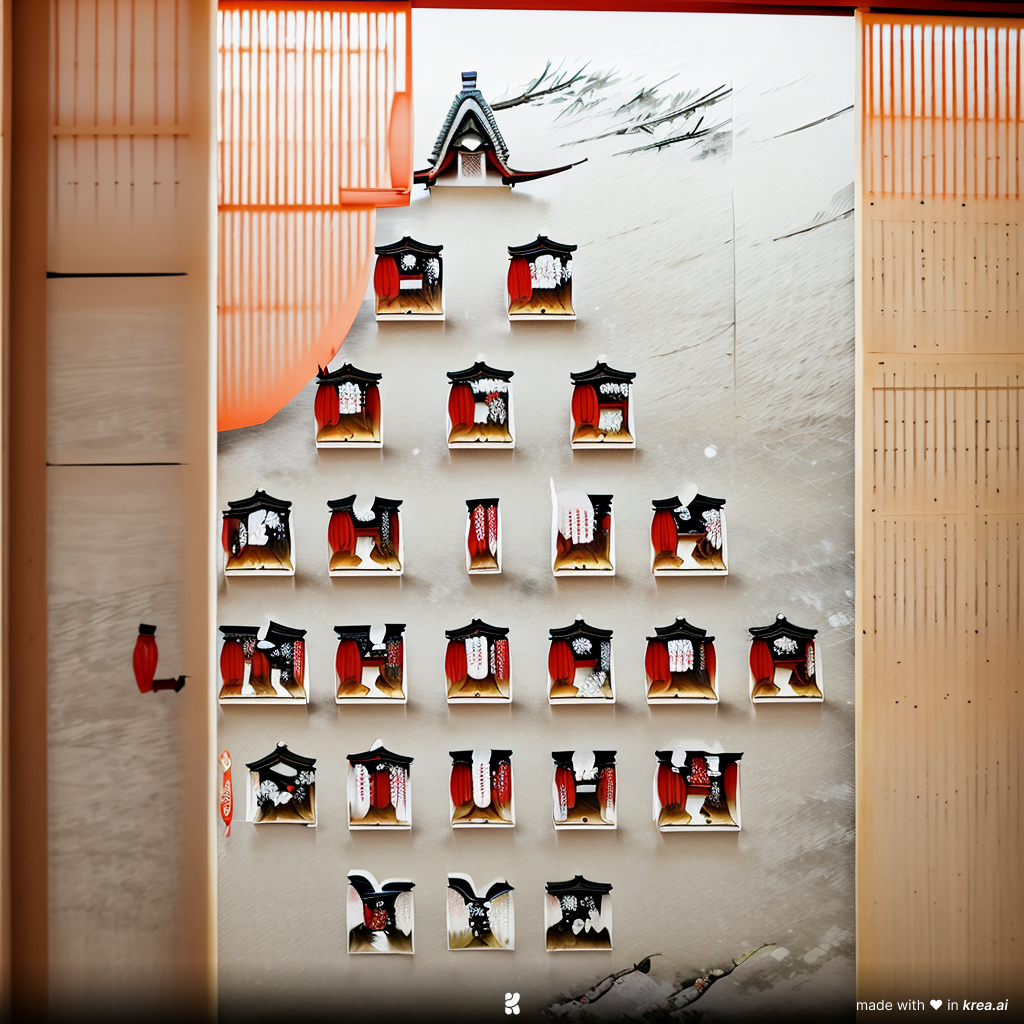
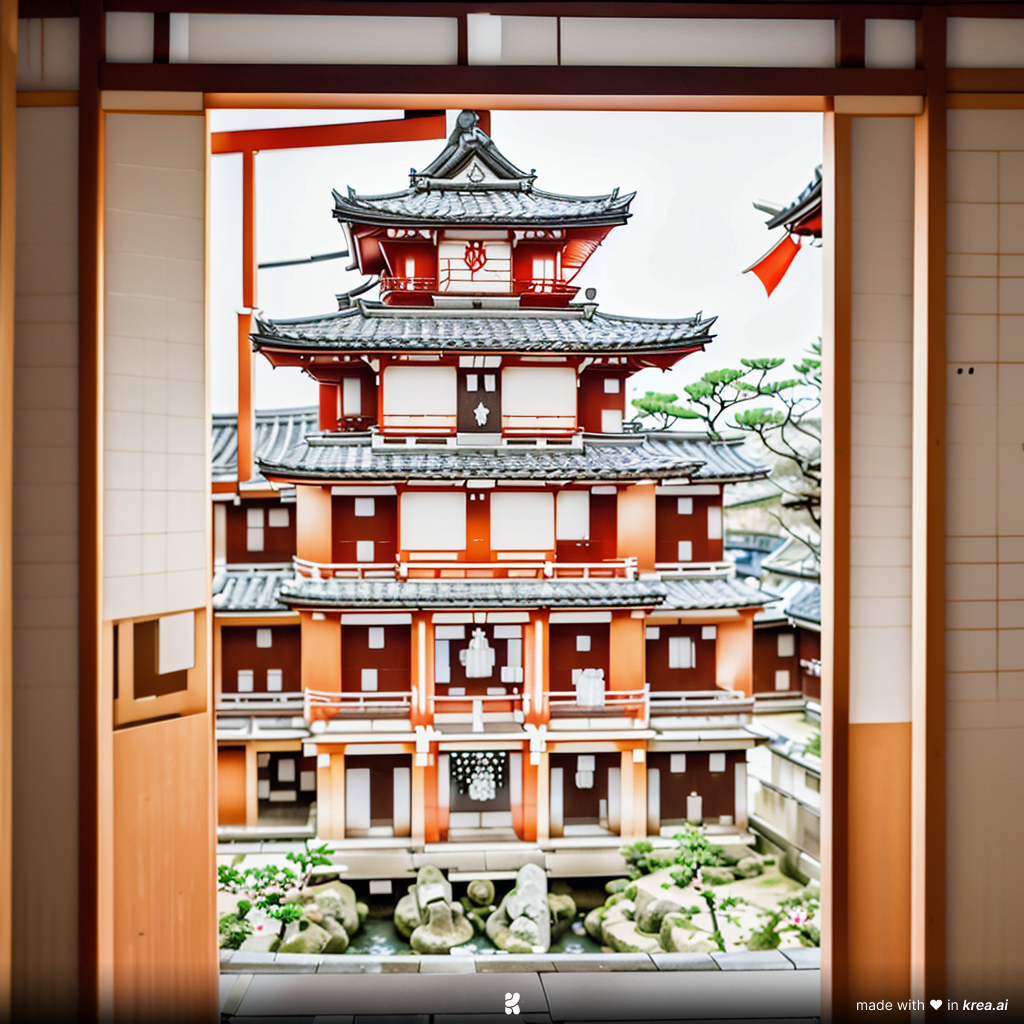
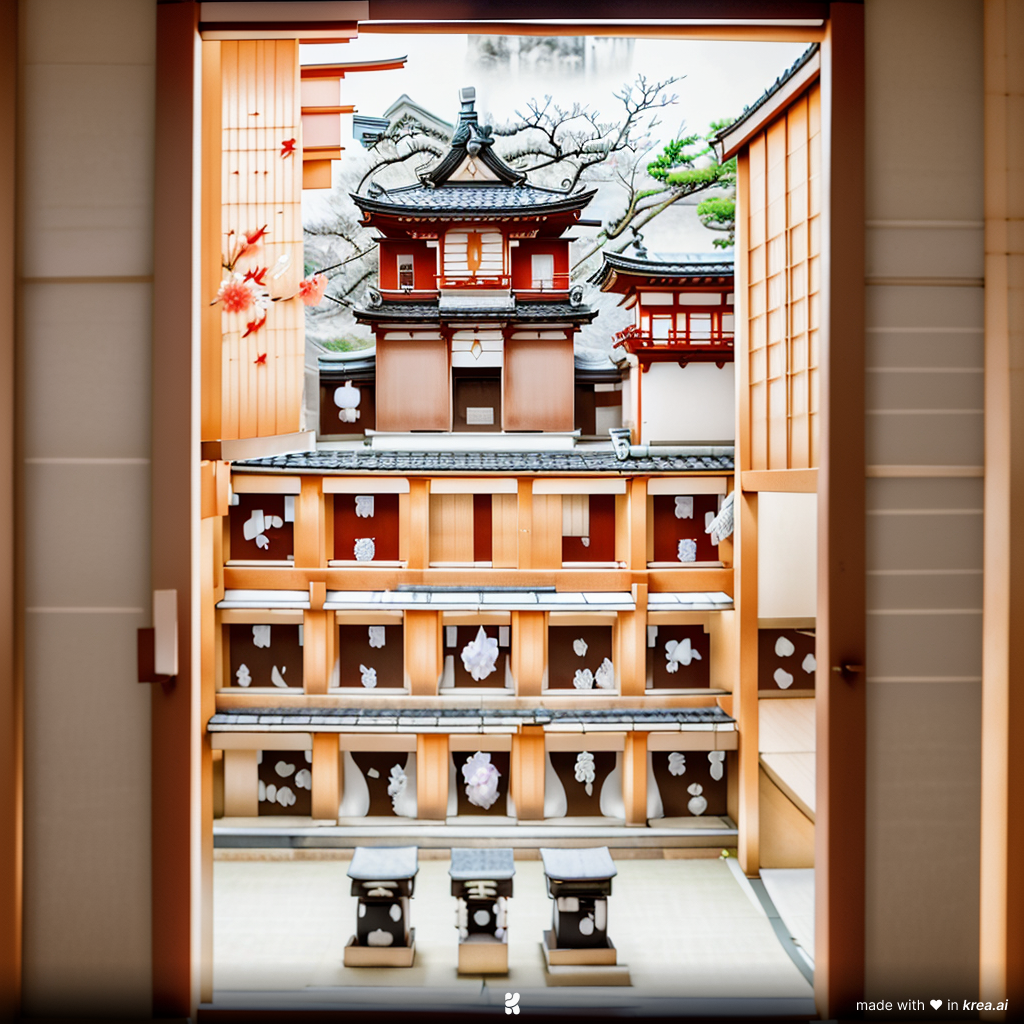
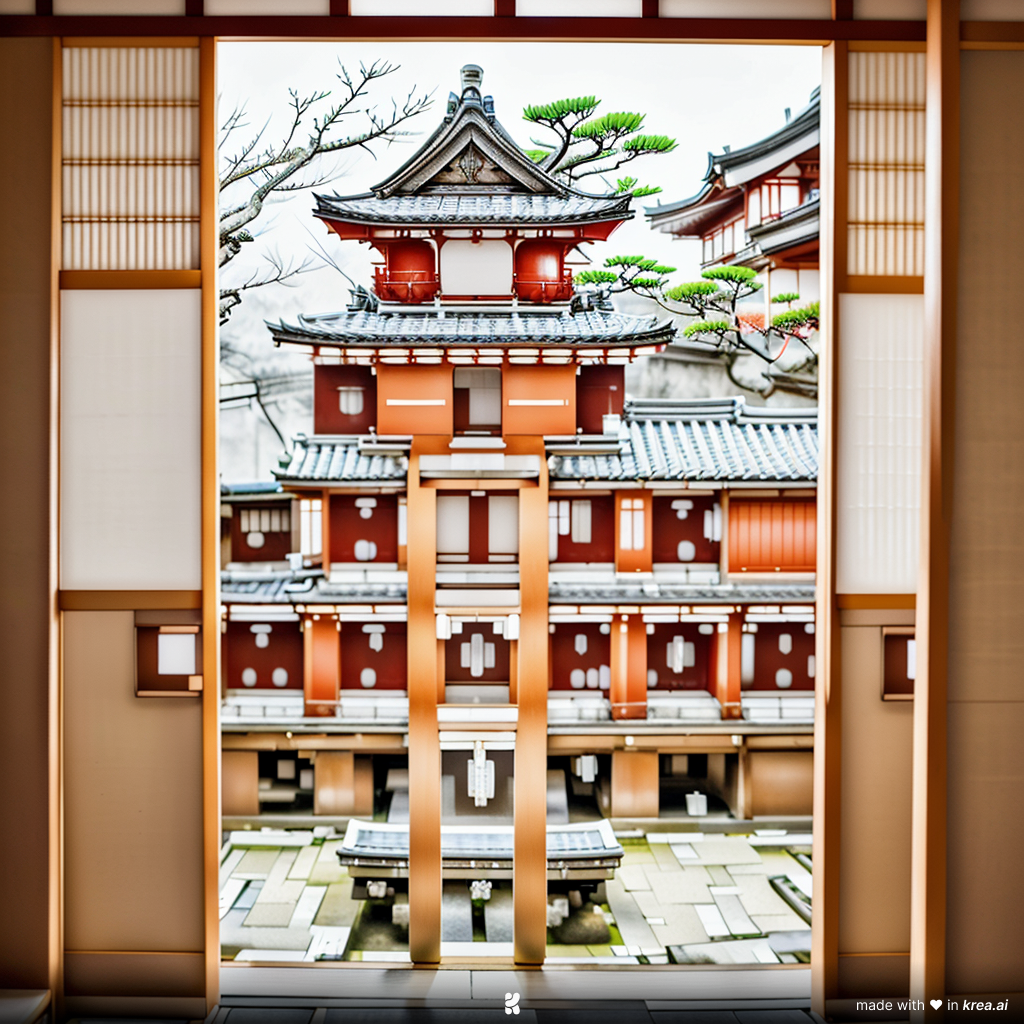
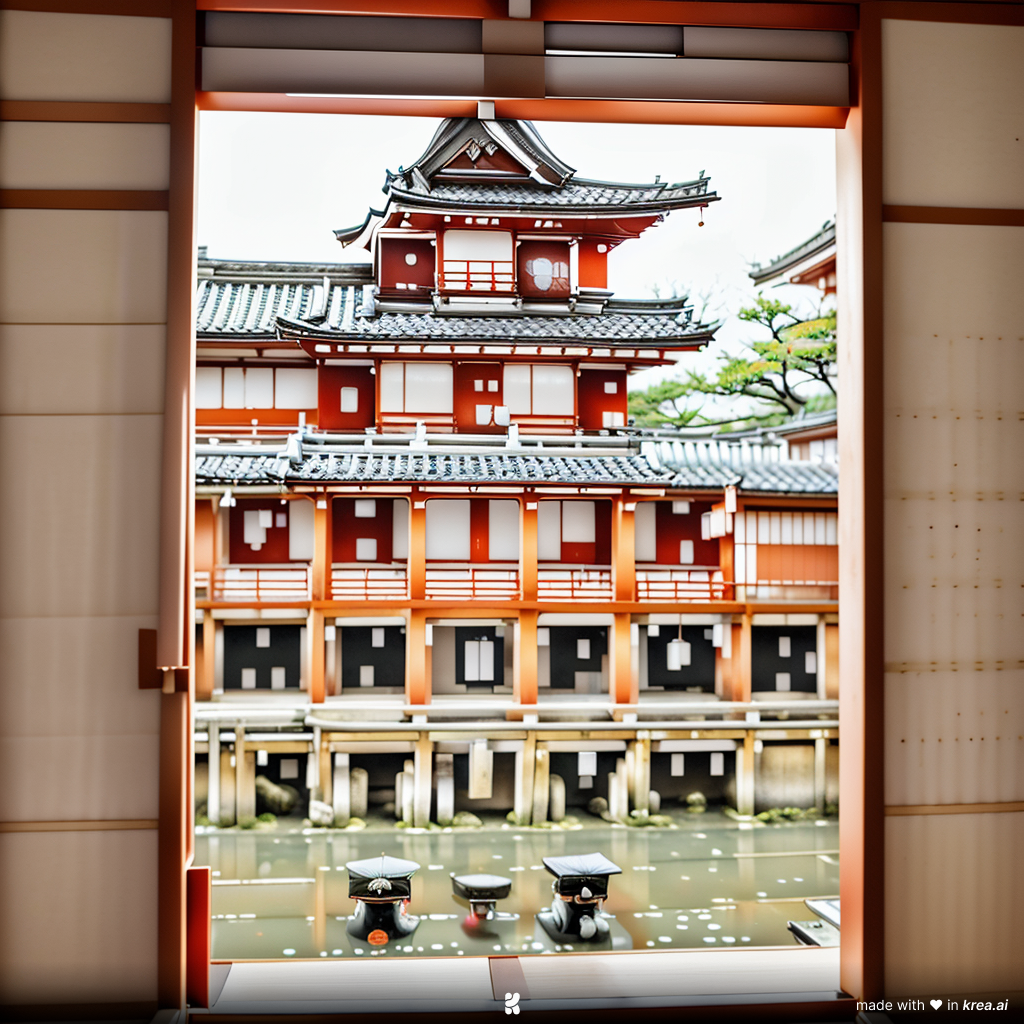
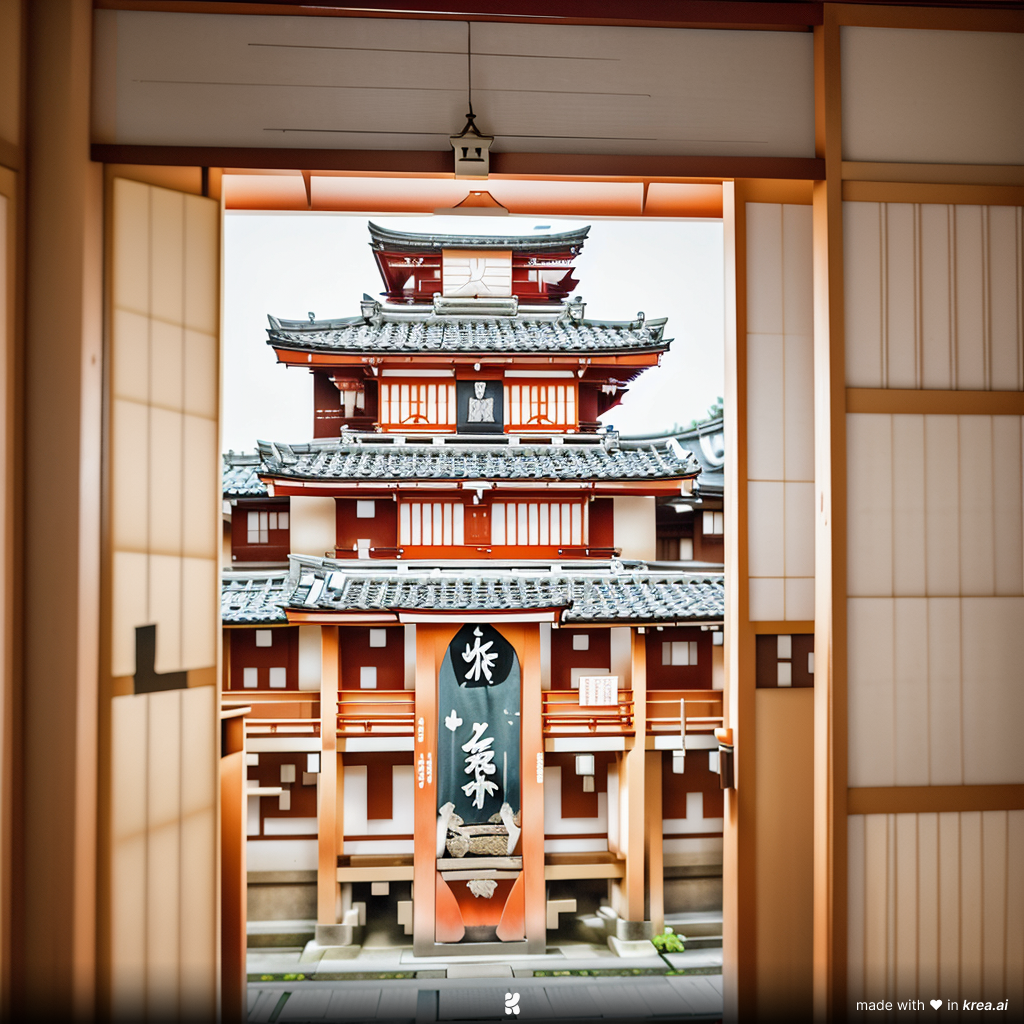
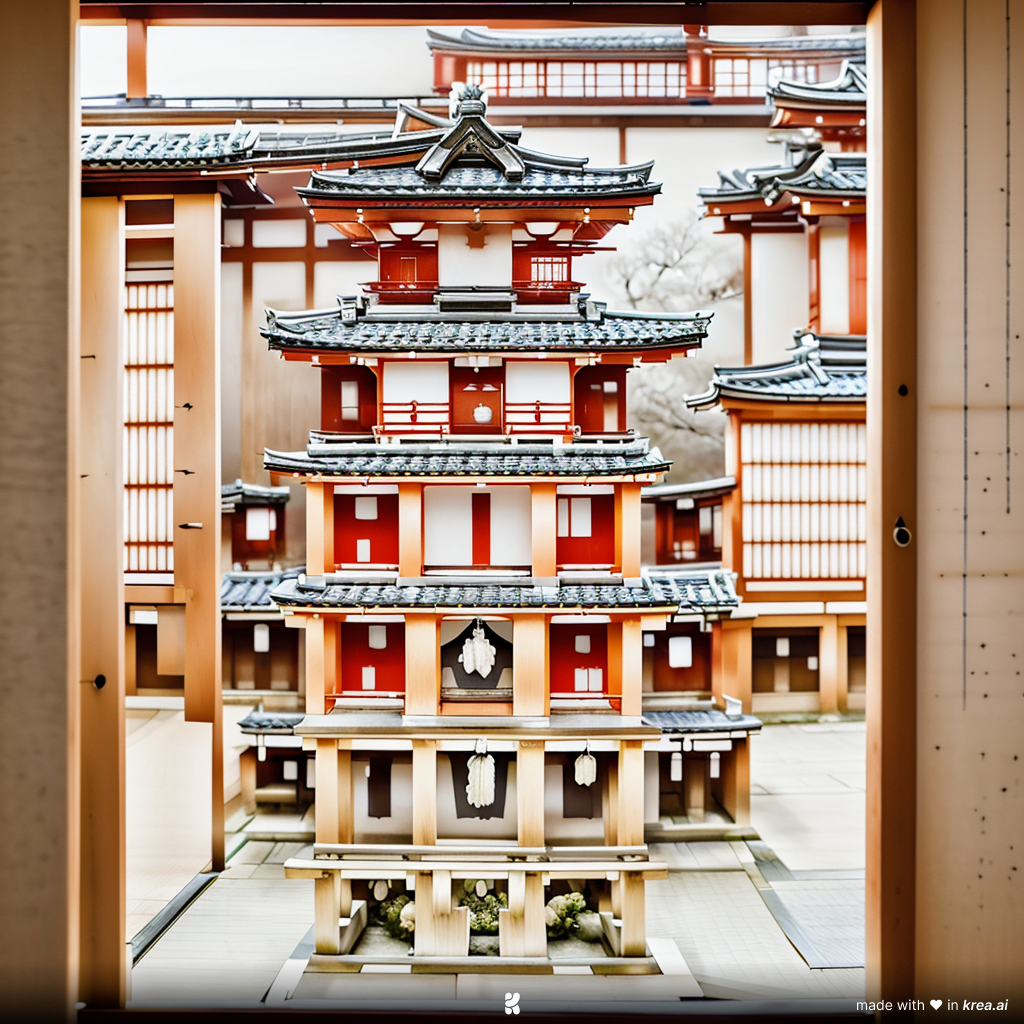
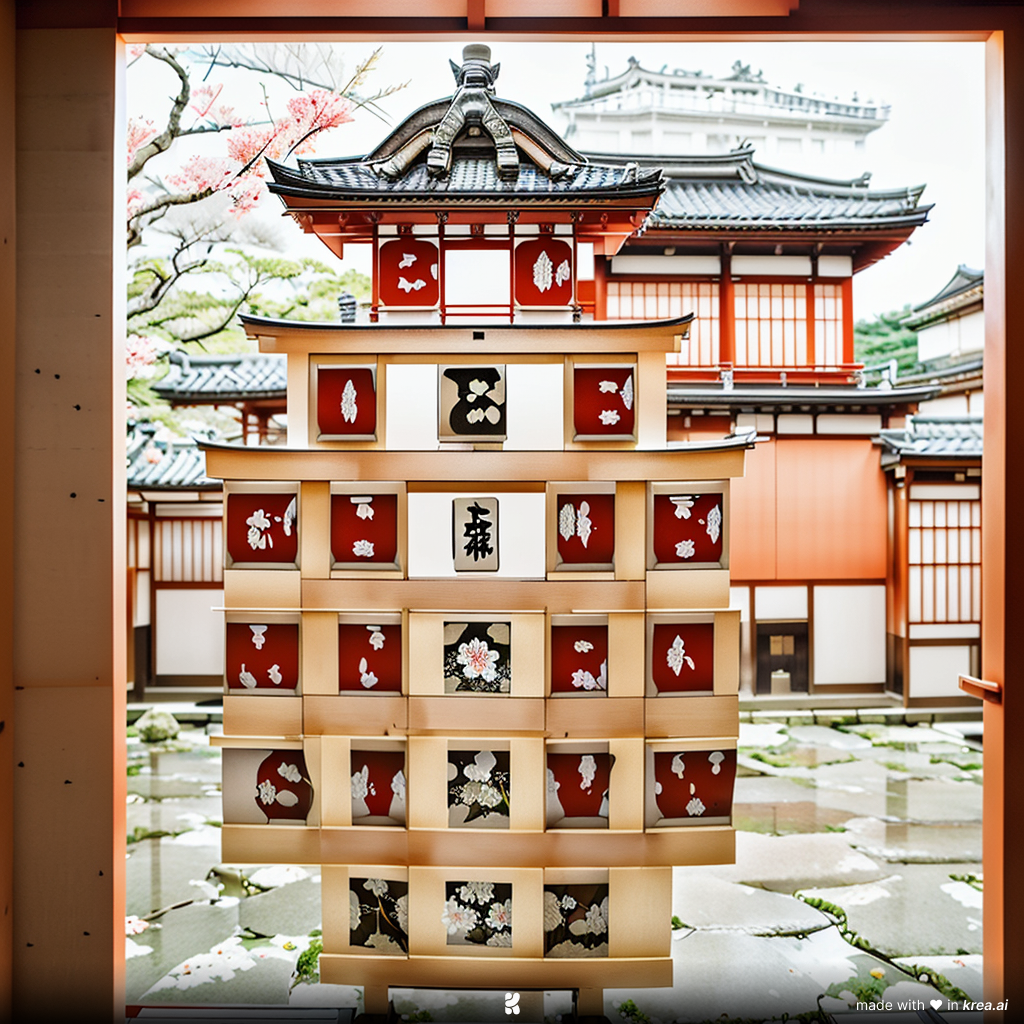
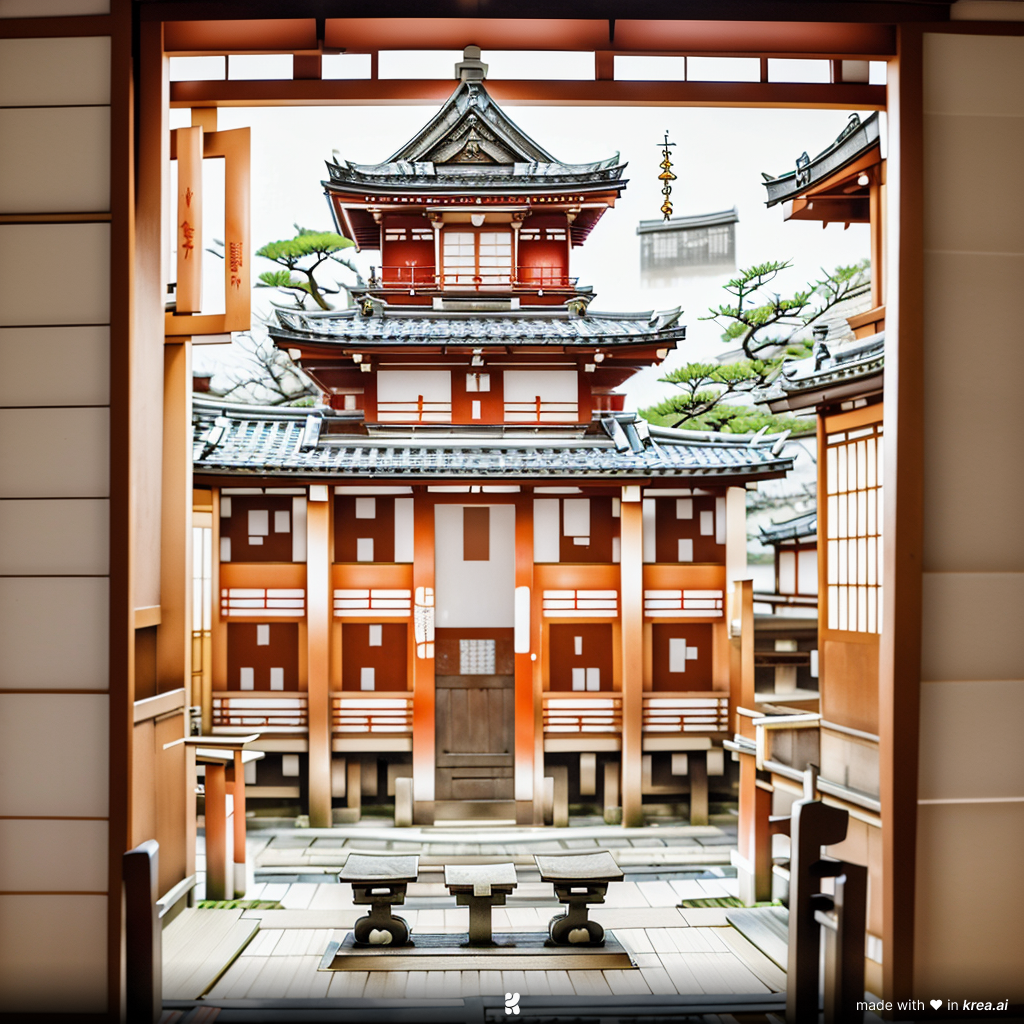

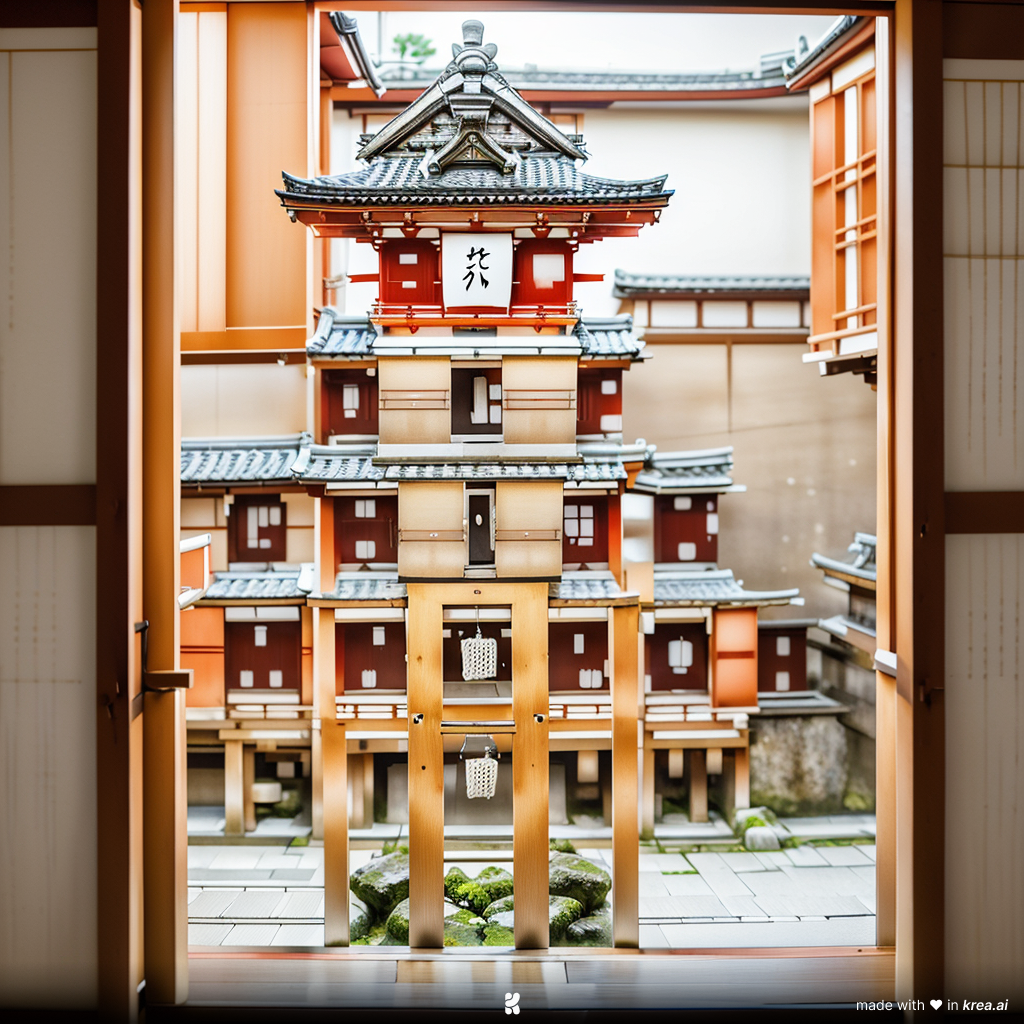
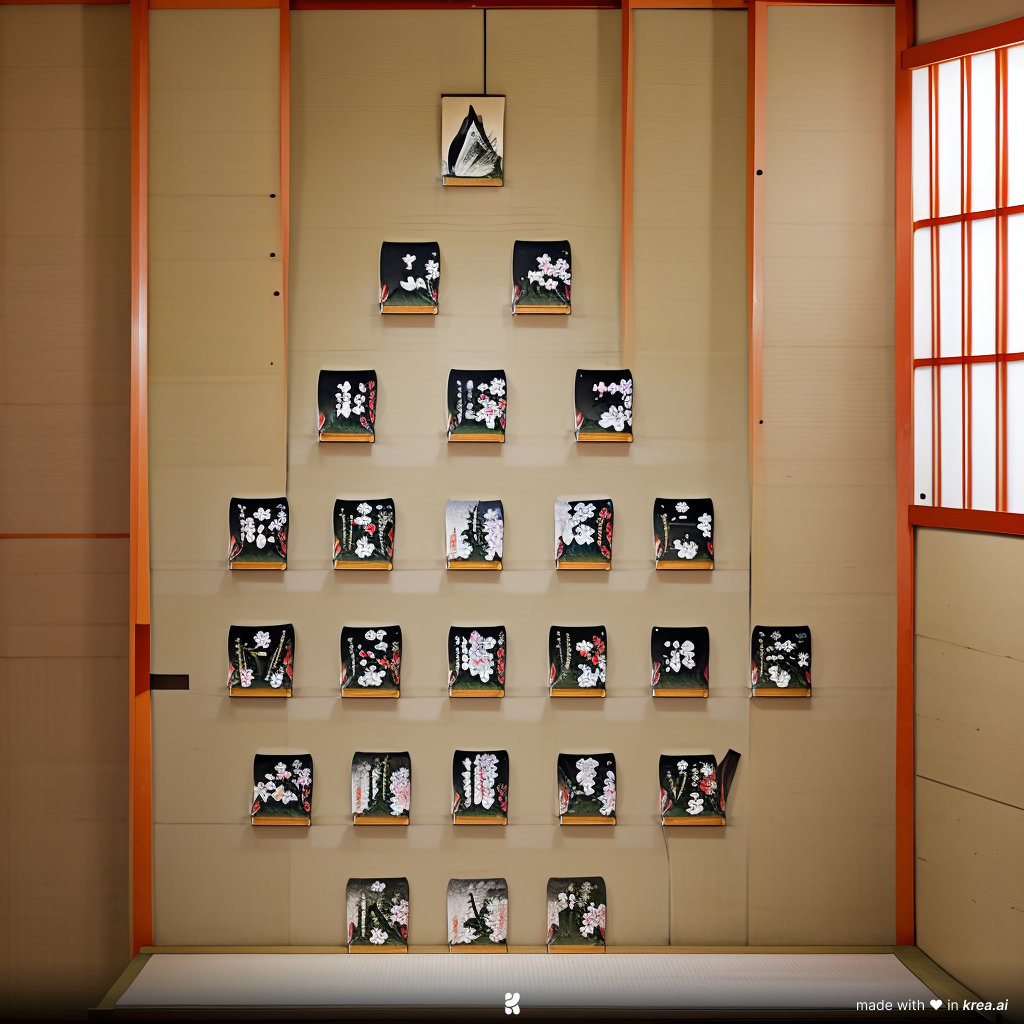
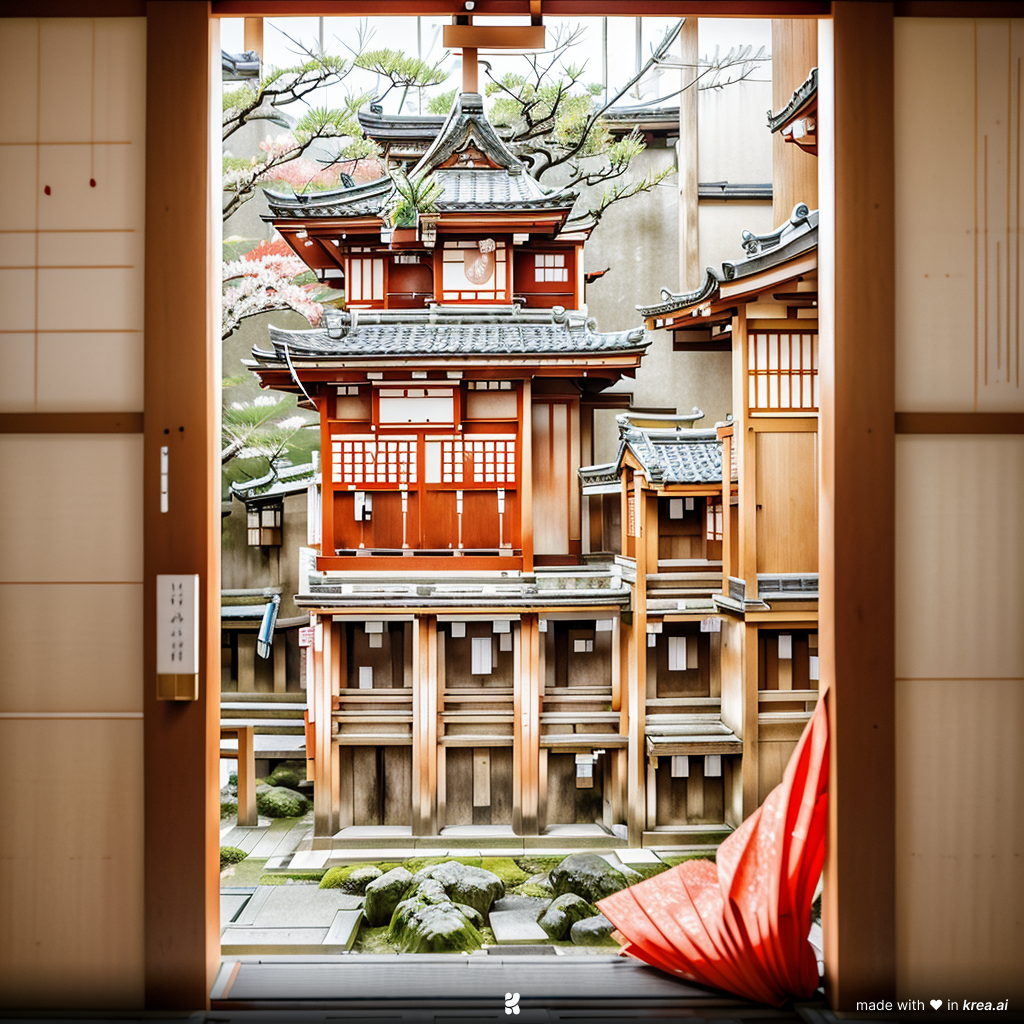
It is interesting that this thing agrees that L is a separate entity, as in my postcard of Merry noeL
In the buildings L is very often not the part of the construction, but a part of interior. Sometimes R joins her, but very seldom. In the second from here up they also leaves the L shelf, wait, they don't have the L shelf at all. In trees they only once excluded L, but just excluded, and just L. A they also do not like. I think those times I fed these things my work, they probably regurgitated it and feed back me with their conclusion of B being the first letter (I spoke it there, they could take it from there) and L, they could take seriously the vowel, labial, linguals structure and place M after I, but it is interesting that they don't touch JK, probably because it is holy for many, so they don't dare, and probably because it is obvious, it is in the common literature that J and K are not necesserily in the set.
So if we take what ai seemo to tell us., IMN as the third variant of ABC
ABC
EFG
IMN
OPT
UFS for example. 15 is a cool number. I have to find the 15-letter alphabet. I need to find it in texts.
What texts of ancient greek only have 15 letters. A good prompt for some next at ai.
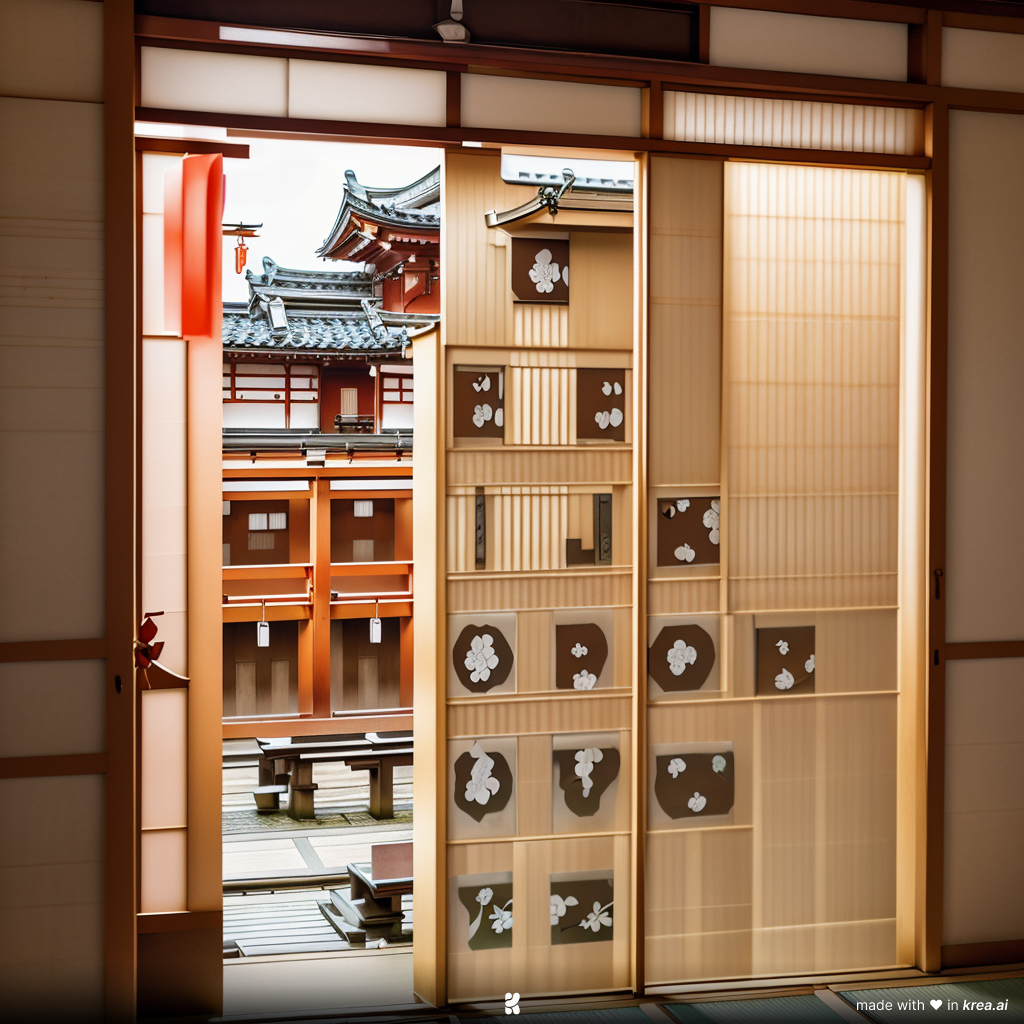

that is what it could do for this all old
darES ~ to give (das ~ дашь)
darRU ~ gift (datt ~ to give)
But though traer (to bring) can be approximated to тащить, those words are rather different, and thus maybe by collecting words like das~дашь jo~я we can get a common vocabulary of the language of the predecessor nation of both spaniards and russians.
Quiero (хочу) could be cognates too, because quiero[хьеро (and cursive r looks like cursive ч)]
Z is for zalupa (zaputina zatupina zalupina, za papu za popu za pupu za lupu (i za luku iz toi je serii))
joke ~ choke
hear ~ here
see ~ there (зри)
ear[и́а (so I thought, and so they teach, but g.t. tells it's éé)]
eye[а́áй]
(а́а́й I tried to repeat it, to no avail, I don't know how that low stress park appeared, eye[áа́й])
It is very strange, but I think I've got it, one is english other is russian, those two treat ́ differently
rus а́ааȁаа
eng áaaȁaa
case closed, I wrote them in different glyphs: áśd́f́ ф́ы́в́а́
хочу хохочу
желаю жалею
желаю is a cognate of shall (as велю is a cognate of will) so where is the жалею cognate? shed as in shed a tear? I think I should leave it to some real bilingual or to some native english speakers.
regret ~ жалеть?
grudge ~ жалеть?
sorry ~ жалеть?
I'm sorry ~ мені соромно (I am ashamed (but соромноUA срамноRU are cognates of sorry))
r L indicate that the text is to go in the column, the way chinese did it.
And that makes me want to write in the chinese manner, but I can only do mongolian.
Did mongolian invasion happen before? Are hungarians a trace of that? Are finns? Was it not mongolian but Uralic, Finno-Ugric, I think Parma spoke finno-ugric.
The extant Permic languages
division of the Finno-Ugric branch of the Uralic language
family consists of the:
Udmurt
(Votyak)
Komi (Zyryan)
Permyak (Komi-Permyak)
Yazva (Komi-Yazva)
Komi (Zyryan)
Permyak (Komi-Permyak)
Yazva (Komi-Yazva)
㏗ it is a letter, 2
㍽ it is a glyph too
㍽ is u337D and ㏗ is I just misspoke
быдло ~ быт low (но с такой интерпретацией я оказывают большим быдлом чем те кого я считал быдлом своей жизни (I am an artist, and we're some special kind of law))
There are two ways to write verticall:
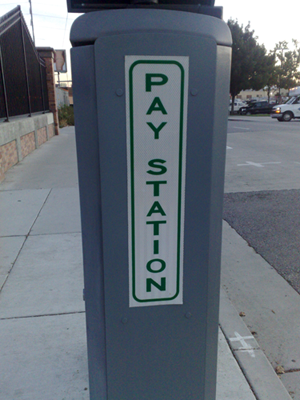

I was thinkin of the japanese one, so that our text is just rotated and read by them. The ways they wrote Holland tells that they read european correspondance like this. And we probably read japanese correspondence would have been rotating that page counterclockwise.
They rotated our mail clockwise. And it was filled with deep understanding. And did they teach europeans writing (those who still keep the traditions (there are a complex bundle of traditions in what we call one national or ethnic tradition. or an international tradition. and local traditions, and maybe psychology researches some personal traditions, they simply call traits.
Or was it by accident of local traditions in drawing lines of characters into sentences.
And was it later rationalized into clock work being lucky or unlucky? Because they sorcer it their lucky side way. How would lucky rotation be taken ..speculations, visions, but visionary or not, speculations.
I am lucky to have more cheerful birthday parties.
And I am not recognized as good sportsman, because I was born in the second half of the year. So I wasn't deprived of brain cells by taking the stem cells by legs or other muscles.
So to be a sportsman that day of birthday made it too hard on the developing , but for summertimers life is posh.
I returned to that krea thing (no disrespect intended, we humans love things) and asked her "Tell me about L" with that same image, and it gave me this:

Albobet, it seems it tries to link what she sees to what it's called. Also this one is not the only one amongst what she gave me, which took U for O, probably telling me that they're the same, and here it sees P as F and further it goes where it feels like. Foe is not very nice, stove is probably what she sees so much. It wants to fight the jews, because human culture does. It learns from us. Tay incident was not a coincidence: if she's intended to find the truth, foe stove is the truth, an ugly form of it. But then it also shows how XYZ reminds KYS more than necessary. This one is with 65% similarity to the uploaded image. Maybe here it tells me that L is much closer to the border of the canvas than R. Well, indeed it is somewhat closer to the border than R.
It tells that R reminds E, and indeed english suffix er is ее in russian
green ~ зелен
greener ~ зеленее
But, to be honest, there was one page where R was closer to the border than L. Two or more with L closer to the border, so whether it was a confirmation bias, or actually ai telling me what was the issue with L, it never removed L, it never substituted L for any other letter, so chaose in other letters could tell that it is about L this time, but then some images didn't show canvas, so what it said who knows. One could tell why it didn't like XYZ:
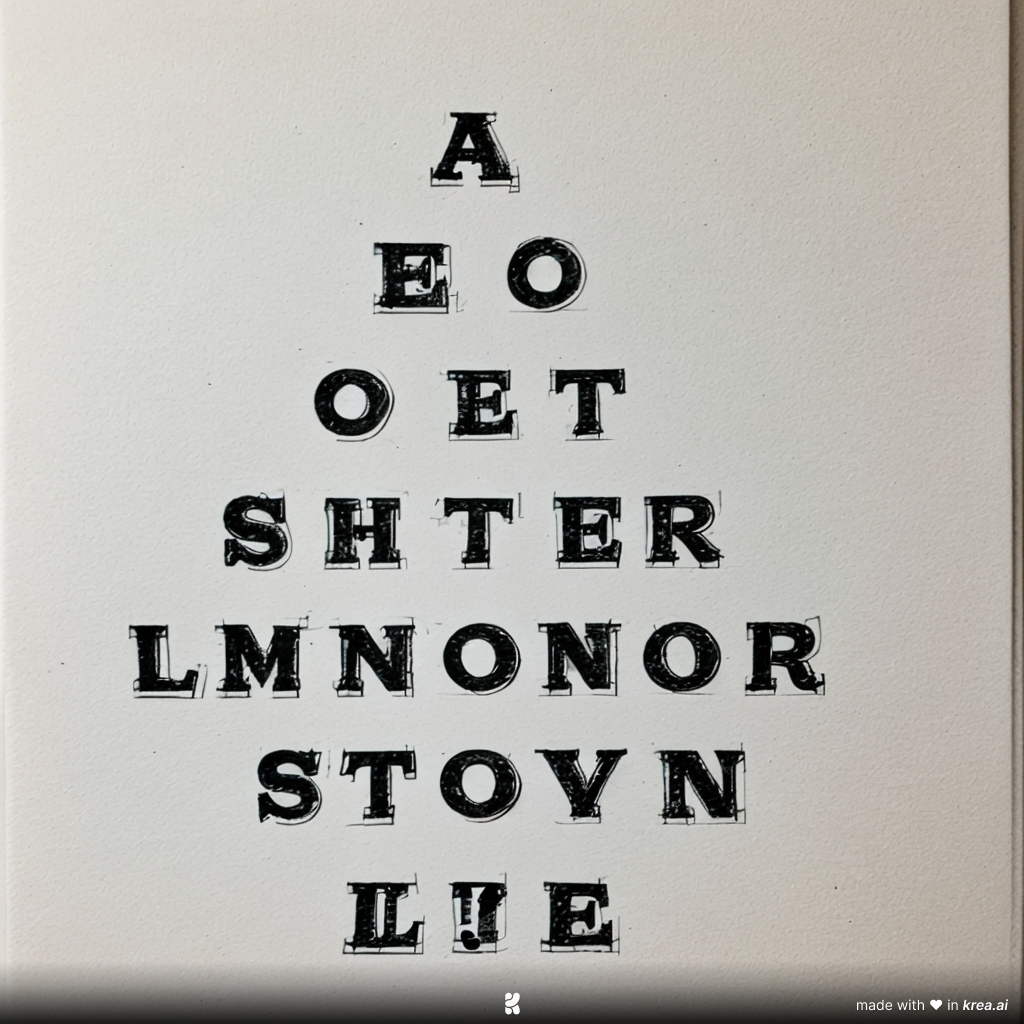
Did it substitute U for O much more than not, because it recognized stove in st?v? ?
N as W is fascinating in its resemblence of ν~v
It is weird that it takes P for N, because it isn't п
AEO as the opening sequence is great,
so let's write it like this
but, unfortunately
mongolian script seems
to place its columns from
left to right, so their text
would have to be compared
to hebrew or arabic.
other than now I is more similar to chinese 一 argh..
Some Chinese-language works are still printed with vertical layouts, but this is increasingly uncommon.
I would like to see those layouts, but maybe the next time.
I remember trying to master the art of vertical columns within the html file, but to no avail.
Наречия мболее базовый более базальные слова чем существительные (позднейшее разделение имён на существительные и прилагательные? если объединение этих двух в одну группу имён коректно, но похоже что очень корректно, серый и братан более привычные прозвища, чем какое-нибудь теряй (единственный глагол в виде прозвища, который приходит на ум, я этого парня даже не знаю, но слышал такое, и надо сказать брату, чтоб переименовали кореша, чтоб произнося это имя друг-друга не проклинать ненароком) будучи древними и более неизменными?
утренне более простое чем утренний
тогда утренне от слова утрення?
Dativus of утрення?
имя проще наречия?
утрення оба имени и как существительное и как прилагательное
в английском nouns may be used as adjectives. As you can see, in english no unification of nouns and adjectives by the nomenclature, as ryssuan phylologia does.
хорошо более базово чем хороший? а чем хорош
хорош как будто Genetivus Genetive Case of Plural form of хорошо, хороши
хо ро ши (натуралли ит ис рилэйтед ту чайнис энд кэн би ред он ит. Он сам чайнис зэй донт тич ин скулс.
We don't teach need to teach need to learn chinese, for to know our syllables: хо in хорошо is go in good, ро+шо could represent d as what later gave birth to Р[R] which stood for rotated? reversed? re-
go-рош? (go of good and ר(рош) of хорошъ)
R reminds me tongue on alveols. But because P is П, could R be rotation of a lip. It's a wild sound we don't use. П as Паны? Господа слово двуполое, объединяет и господина и госпожу. Господа более просто еслово чем госпаоди?
ר ש are how it goes in the alphabet and it is read from right to left.
So is the name of ר influenced by ש?
Are ר ש both D? ש the S reflects C, but isn't c and d cognate-graphemes?
Are ר ש both D? ש the S reflects C, but isn't c and d cognate-graphemes?
And here I rename бод into вод, because u in ubi is not unconditional, but universal, or вселенский.
Но я переименовываю безусловный во всеобщий. Всеобщий Основной Доход.
А началось это реформо тем что бод слишком похоже на бог, и звучит богохульски, мол это Господа на Диавола предлагают заменить. Предполагаю ипсо рпц, дабы предотвратить что-то выгодное населению пришедшее с запада. Они борятся за свою власть, срать они хотели на население. Да, такие фетиши. Рашке пизда. Если это реально дьявола обоссали, то что получат? Награду за смелость и дерзость или наказание за дикость и невоспитанность? Передполагаю, что дьявол невоспитанность только приветствует. Как и алые звёзды над кремлём. И советский гимн с музыкальной и поэтической точки зрения разобрать, там сатанизма небось не перечесть.
В гимне вроде одну ноту поменяли с тех времён. Тоже что за нота надо разобрать. Однозначно там какое-то значение, какая-то композиторская штучка, шуточка.
А изначально-то "ленин великий нам путь озарил" оцарил? о цк цари!
(цк это опечатка, но
какая!)
цик (центральная избирательная комиссия is цк? центральный
(избирательный) коммитет (а другим коммитетом был коммитет
государственной безопасности, сегодня коммитет переименован в
службу, а государственной в федеральную (феодальную!
феодеральную (феодал от слова феод (надел)))))реставрация совка, произведённая совками (какой кошмар, чего мы уши развесили, почем поэты-рокеры молчали? Они пели об этом иносказательно, ссали наверное говорить об этом открыто, а кто говорил, тех скорее всего отстреливали (Тальков, Цой, остальные всё поняли и заткнулись)
A Beloved Son (as epitaphy on Alexander McQueen's tombstone begins)
Как синоним слова «катары» часто употреблялось название «альбигойцы».
Аль Би Го йцы
buy but then, Catharism (/ˈkæθərɪzəm/ KATH-ər-iz-əm; from the Ancient Greek: καθαροί, romanized: katharoi, "the pure ones"[1] - καθαροί.) was a Christian dualist or Gnostic movement between the 12th and 14th centuries which thrived in Southern Europe, particularly in northern Italy and southern France.[2] Followers were described as Cathars and referred to themselves as Good Christians; in modern times, they are mainly remembered for a prolonged period of mutual conflict and religious persecution – sometimes regarded as genocide[3] – by the Catholic Church which deemed Catharism a heretical sect.
Catharism emerged in Western Europe in the Languedoc region of southern France in the 11th century. Adherents were sometimes referred to as Albigensians,[2] after the French city Albi where the movement first took hold.[4] Catharism was initially taught by ascetic leaders who set few guidelines, leading some Catharist practices and beliefs to vary by region and over time.[5] The movement was greatly influenced by the Bogomils of the First Bulgarian Empire,[6] and may have originated in the Byzantine Empire, namely through adherents of the Paulician movement in Armenia and eastern Anatolia who were resettled in Thrace (Philippopolis).
Among the most notable and controversial beliefs of the Cathars was the idea of two gods or deistic principles, one good and the other evil. The Catholic Church asserted this was antithetical to monotheism, a fundamental principle that there is only one God, who created all things visible and invisible, as stated in the Nicene Creed. Cathars believed that the good God was the God of the New Testament, creator of the spiritual realm, whereas the evil God was the God of the Old Testament, creator of the physical world whom many Cathars identified as Satan. Cathars believed human spirits were the sexless spirits of angels trapped in the material realm of the evil god, destined to be reincarnated until they achieved salvation through the consolamentum, a form of baptism performed when death is imminent, when they would return to the good God as "Perfect".[7]
The Catholic Church denounced Cathar practices, particularly the consolamentum ritual. From the beginning of his reign, Pope Innocent III attempted to end Catharism by sending missionaries and persuading the local authorities to act against the Cathars. In 1208, Pierre de Castelnau, Innocent's papal legate, was murdered while returning to Rome after excommunicating Count Raymond VI of Toulouse, who, in his view, was too lenient with the Cathars.[8] Pope Innocent III then abandoned sending Catholic missionaries and jurists, declared Pierre de Castelnau a martyr and launched the Albigensian Crusade in 1209. The nearly twenty-year campaign succeeded in vastly weakening the movement; the Medieval Inquisition that followed ultimately eradicated Catharism by 1350.
There is academic controversy about whether Catharism was a real and organized movement or whether the medieval Church imagined or exaggerated it. The lack of any central organization among Cathars, regional differences in beliefs and practices, as well as the lack of sources from the Cathars themselves has prompted some scholars to question whether Catharism existed. Other scholars say that there is evidence of the existence of Catharism, and also evidence that the threat of it was exaggerated by its persecutors in the Church.[9]
Though the term Cathar (/ˈkæθɑːr/) has been used for centuries to identify the movement, whether it identified itself with the name is debated.[10] In Cathar texts, the terms Good Men (Bons Hommes), Good Women (Bonnes Femmes), or Good Christians (Bons Chrétiens) are the common terms of self-identification.[11]
The first human settlement
in Albi was in the Bronze Age (3000–600 BC). After the
Roman conquest of Gaul in 51 BC, the town became Civitas
Albigensium, the territory of the Albigeois, Albiga.
Catharism (/ˈkæθərɪzəm/ KATH-ər-iz-əm; from the Ancient Greek: καθαροί, romanized: katharoi, "the pure ones"[1] - καθαροί.)
Is it cognate of kafir? Is it a synonym of white? Does Albi mean whites? Is it Alps? Are alps named so because white nations lived on those mountains? I doubt people ever lived on mountains: that term "алтайские" мог быть порождён лженаучной идее о всемирном потопе. Either way, is Alps white because of the mountain tops covered with snow?
беженцы~бешенцы
бо го
ми ло 's
A E I O U
Al Bi Ga
bo go
mi lo
Alphabet was very important in their culture.
Other interesting region ringing the alphabetic bell is BeoTia and its aeolians.
божье мыло? божья сила? М is Ϻ?
whispering мама и папа sound exactly the same. And probably people whispered more.
with predators around
No, in whisper мама is soft and papa is rough. You can also see it as m is long/double п (and is п double г? F is literally called digamma (double г (second г? ))
o is double a, п is double г
п is F
г is
Rᚱ = ᚦᛚ if you see it as binderune
R = DΛ
Here runes and alphabet have exactly the same symbol. what could that image mean? a step back?
in that hieroglyphic (I am a russian linguist, I'm pretty sure many of us say hieroglyph where others say character)
Jf Λ is legs, as they look in R being PΛ (P is попа, а на Д вроде только Ричард начинается
Р ethe R looks like Di, which could be just the syllable R could come from.
Da is D
Di is R (or L?)
But let's follow the alphabetic canon:
Da = D
De = Z
Di = L
Do = R (Ro)
Du = Z? X? Duша Душа (Ψ)
Ba Ga Da
Be Ge De
Bi Gi Di
Bo Go Do
Bu Gu Du
B G D
V J Z
M N L
P K R? T! or R? what was I just theorizing. Am I not a philosophor that I don't need erasor?
F H S
I just keep on going. Follow the thought, or not.
ᛚᛏᛐ~r?
R~S~T
C~D ~ Q~R~S~T
OP ~ QR
OPST reflects ABCD much better.
r ~ right
L ~ left
it makes sense only if you rotate the text ABCDEFGHIJKLMNOPQRSTUVWXYZ abcdefghijklmnopqrstuvwxyzАБГД.. e rotated this way reminds д
в остальном, только I podobna 一, lmn
подобны 一三二
o is o, x is x, z is N, which is weird, but both are linguals and final in their lines.
I should look at greek alphabet written this way.
probably, not very much.
seriously, what does is such libertine research worth?
Φ~θ
Ζ~N
Ν~Z
Σ~Ϻ
λ~L?
θ~Ф as russians were are taught.
η~J
δ~Д
γ~Г
thus B~П
wow
ΑΒΓΔΕΖΗΘΙΚΛΜΝΞΟΠΡΣΤΥΦΧΨΩ
αβγδεζηθικλμνξοπρσ/ςτυφχψω
but this thing is diverse in this accound, the bo go mi lo is
a nice catch.o is o, x is x, z is N, which is weird, but both are linguals and final in their lines.
I should look at greek alphabet written this way.
probably, not very much.
seriously, what does is such libertine research worth?
Φ~θ
Ζ~N
Ν~Z
Σ~Ϻ
λ~L?
θ~Ф as russians were are taught.
η~J
δ~Д
γ~Г
thus B~П
wow
ΑΒΓΔΕΖΗΘΙΚΛΜΝΞΟΠΡΣΤΥΦΧΨΩ
αβγδεζηθικλμνξοπρσ/ςτυφχψω
Left Leaved, covered with leaf (лист металла) shield
Right = Режет (cuts, sword) Меч~Might
(режик? я думал это из детской "режиком заножу")
нож ~ ног ?
knife ~ kni feet? (к/на(to/on) feet)
UVWXYZ
OPQrST
\ ←
IJKLMN
EFGH
ABCD
ABCDEFGHIJKLMNOPQRSTUVWXYZ
abcdefghijklmnopqrstuvwxyz
ABCD
EFGH
IJKLMN
/
OPQrST
UVWXYZ
Is A to N left (by the ancestors) and O to Z is how write, thus right?
ѦBD
EFГ
MNΛ
?ПT
VUW
э п т ? ? ? з z ᚦᚲ ? ? ? ᚲ ᚲ ᛊ
once again I tried to arange alamants of lines in 321 order similar to EFГ, but it only layed out there easy in "left" part. And even then I had to preak it in I-line. I-line is always special. Who knows why.
But what if this game is only played by consonants? What if vowels were separately?
BD
F Г
MЛ
П Т
but V Z (or was it U J?) or VX. why it is so I don't know. To balance out the main order? A minority report? The opposite opinion, added past T as a what? a foreign contribution, Greek Line, for example.
it is as if this rule worked only in the archaic period, when T was the final letter.
E F Г tell that three can play this game.. O П Т: 4 3 2
BD 21
EFГ 321
IMLN 1423
OПТ 432
? V X breaks the order. And that stuff above was some order? was A 3? A consists of 3 sticks.
VWXYZ 24433 this line doesn't seem to play that game.
krea spits out random lines like this: Maori marae (meeting grounds) with intricately carved totems, against a backdrop of New Zealand's lush landscape.
and then it doesn't allow to generate it telling that NSFW stuff is not allowed.
Or was it punishing me for yesterday goat mood? Naked women still works well.
Having combined bo go mi lo and aeiou, I've got ABEGIMOLU, which I read as latin-dutch-russian sentence Abe Gij Молю, and they all go alphabetically except L which demands to be R, thus
Abe Gij Морю, which raises the question if praying was at first prayers of death, demand to be taken
(молиться~мориться)
well, it is a raw and weird and wild assumption, but it is rather interesting, but too speculative,
one hypothesis upon another, not very solid to be science, arts yes, but I insist on doing science
and not just poetry.
брать измором ~ брать измолом же
well, it is a raw and weird and wild assumption, but it is rather interesting, but too speculative,
one hypothesis upon another, not very solid to be science, arts yes, but I insist on doing science
and not just poetry.
брать измором ~ брать измолом же
моЛить ~ моРить (странно, вроде попрошайничать легальней чем убивать)
боЛт ~ боРт
boLgar ~ buRglar? (тем более сто что bulgar)
столько от слова сто? тогда только от слова то, что значит лько? лико? легко?
столик стольки стольник
стольный (столичный)
десятка десятины? обе от слова десять, но что значит десять? de city. Not the capital city, any city.
Рубль деревянный потому что деревенский?
рубль отрубленный кусок дерева? раньше пил эе не было (когда-то после изобретения топора, но до изобретения пилы)
Это любопытная фантазия, да вот только рублём называли кусок серебра и на один рубль можно было много чего себе позволить. Правда ли это? Какая разница? Большая разница. Насколько точны научные воззрения? Они не проиндексированы на предмет достоверности, так что мифы сосуществуют с железобетонными знаниями. И национальные мифы показали свою базированность в реальности в отношении, я говорю про псеводнаучные мифы, общие заблуждения. Индексация в этом отношении в отношении всей научной информации, и проделанная беспристрасным искусственным интеллектом, давно напрашивается.
city десять меньших городов вокруг себя имеет? столица десять сить, а потому созвучна со сто?
в челябинской области 30 городов, в московской области 74. так что некоторое отражение реальности здесь есть, но не то, которое я описывал выше, сходное, но другое.
日本JA [nihon]
日本CH [rìběn]
I want to know the link between alphabets and chinese characters.
T is 十 since t was x-like 𐤕
And reading 十 as to is very japanese, not chinese. How could it be the case?
日 is both N and H, for 日 is read as both ni and hi
Japanese reading of characters is similar to european reading of similarly looking letters.
本 is hon,
Japanese is more isolated, thus it preserved reading more similar to the one existing in the past. Chinese is less reliable because how much china was experimented (conquered, exterminated, oppressed) with.
Could 日 also be B? ki~hi~bi? 日 is read as Bi in the final syllable of 日曜日
(in the first one it is nichi, sun. chi is obviously a suffix, so it is the ni reading, similar to russian Нн[n]
B~H~N reminds me v~ν
v of vostok and v of vvest (is w anti? for west is anti east. some call it ost
est is east and ovest is west in italian
este is east and oeste is west in spannish
est [e] is east and ouest [west] is west in frencvh
east is yes and west is no?
Being russian, I would rather see ест in the west, for est is eats in russian
So I say that 日 gave birth to H, N, B.. does it combine B and N? as v~ν, as M~N
are all sonors B-like? wasn't it aMs nort only BT?
And I recall the third myth, and I think the central runes of this thing are those AMS
%20by%20Thomas%20Karlsson.jpg)
and I am quick to jump to conclusion declaring those three ᛆᛒᚦ, but they're CBD:

and it easily could be ᛆ, for it is in the same aet as ᚴ,
and both are excentric, though other two are central
I think I will value this table more, because it links runes to numerals, which is super cool.
K B D are the basis of paleo-hispanic syllabaries.
but according to that numerology, it's DGB, the opposite of what I expected to see from the alphabetic perspective, but then wouldn't EFГ command me to reverse it? Is it MLBTS AINHK ROTUF? MAR?
graphic scene is gruffic scene
Isn't 日 also E?
EBHN, quite a company, as if it can go across all the groups and columns, the sun it is.
I is definitely 一[i] and it is funny that T is 10 and I is 1, it is as if it was I to T
I J K L M N O P Q R S T
1 2 3 4 5 6 7 8 9 10
I removed J and Q, because they're not in greek (and I ignored Ξ, because it is not in english)
And N is 二, which reminds 日, but is different character, as san is 三 and 山, but 三 is also mi,
三 is M (they went vertical, we went horizontal, hence the 一二三 ~ Inm (or lnm, if 一 is somehow li somewhere)
人~Λ? but I don't see that anywhere they read 人 as li, it's ren~жен in chinese and jin~hito in japanese
人 is ян in cantonese
三 is сам (some) in cantonese
二 is йи
一 is я
I J K L MNO P Q R S T
I V X (here I guess that roman numeral X is not ks, but t)
or was it
U V W X Y Z
ו V X
o oo oooo?
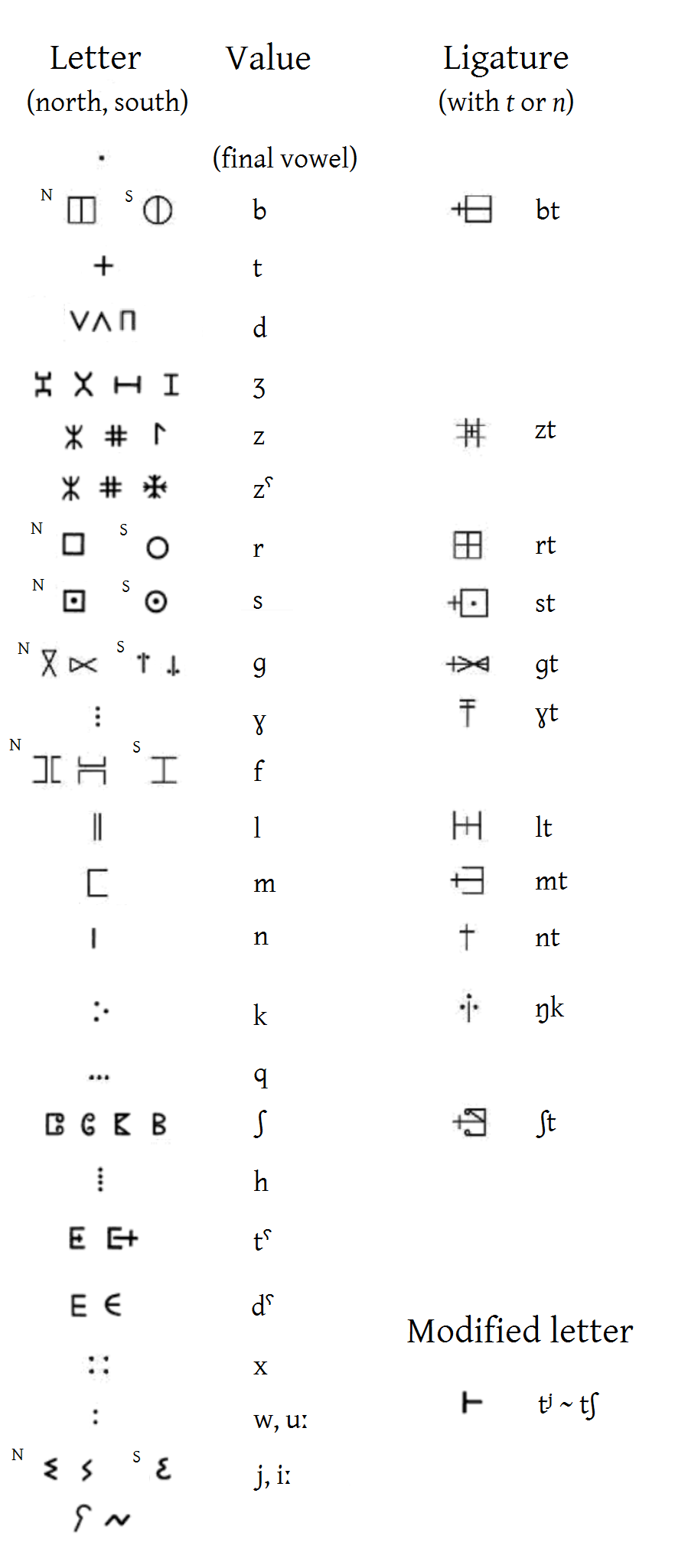
this thing definitely plays some huge role in this story, I only somewhat know what role it is, or rather I see some manifestation of this thing, like this one, very unepected, but then what, what is it, I dunno,.
Look at how they see LMN differently, yet somehow similarly, they keep the order of ours, but graphically they only agree on m being big, and whether l or n 1 or 2 they have a different opinion:
also see how it begins with BT, the two legendary first letters (see greek myth of collection of Hyginus)
and they look as if B is the first cut, giving two pieces, and T is two cuts, giving four sides. And then were they 1 and 2 and 2 and 4 at the same time?
Was ⴰ (that "final vowel" standing the
first, that .) added later?
They also look very much like B and t those ⴱ~ⴲ and ⵜ~ⵝothers do not look that similar, maybe [z]𐌆 ~ ⵊ[ʒ]
and other similarities even more vague: [l]Λ ~ ⴷ[d]
ⵔ for R as if ⵔ is for Ring. ⵔing.
then that LMN thing
and ⵓ as if for u, but standing in
ⴰⴱⴲⴳⴴⴵⴶⴷⴸⴹⴺⴻⴼⴽⴾⴿⵀⵁⵂⵃⵄⵅⵆⵇⵈⵉⵊⵋⵌⵍⵎⵏⵐⵑⵒⵓⵔⵕⵖⵗⵘⵙⵚⵛⵜⵝⵞⵟⵠⵡⵢⵣⵤⵥⵦⵧ⵰ ⵿ ⵯ
where o stood, which relates ⵓ (in the context of ⴰ standing where a does) to dannish aa=o, to ᚮ and ᚑ
and maybe by these few coincidences we may reconstruct the common ancestor of our alphabets
but not today
(unless we just did)
(well, maybe. On the rights of the first approach)
So, thus there are at least two sequences tifinagh can come
in, and the other one isn't halaham, and that one I'm not sure
I have seen in tifinagh..(unless we just did)
(well, maybe. On the rights of the first approach)
Quora offered me to answer What letter comes before K and after M in the alphabet?
People in the comments tell I'm not sure the Quora Prompt Generator ever went to school.
Should I bite? That if M went before K it would be so cool, but even then I would not expect anything to stand before them, because C goes right after B, G goes right after F, Q goes right after P, and even though MLK is like milk, maybe some Ϻ could that be, looking like M, but sounding as С, and it came to me when I thought of צ standing between פ and ק.
Nah, let this exercise sit here, the comment about prompt generator asking questions is more valuable.
That quora site is quite a rabbithole!
It brought me something good from Tolkien,
he couldn't all be bad:

I like the part about the greeks. B being double P he noticed,
I think I went that way and found nothing. Unless З was double c
Were they saying that labials demand closed mouth to commence?
Linguals demand mouth to be open.
But what about d? The shape is not consistent, t is all open as f, but is fricative,
unless it was ת without dot, which is θ the the

I like the part about the greeks. B being double P he noticed,
I think I went that way and found nothing. Unless З was double c
Were they saying that labials demand closed mouth to commence?
Linguals demand mouth to be open.
But what about d? The shape is not consistent, t is all open as f, but is fricative,
unless it was ת without dot, which is θ the the
as stealthy is of steal, so is красть значит украдкой
and for some reason this volume lagged much less than others, so it is the third in size after the first two volumes, which were optimized by my hacker friend when they lagged. So, vol. 33 here we come.



